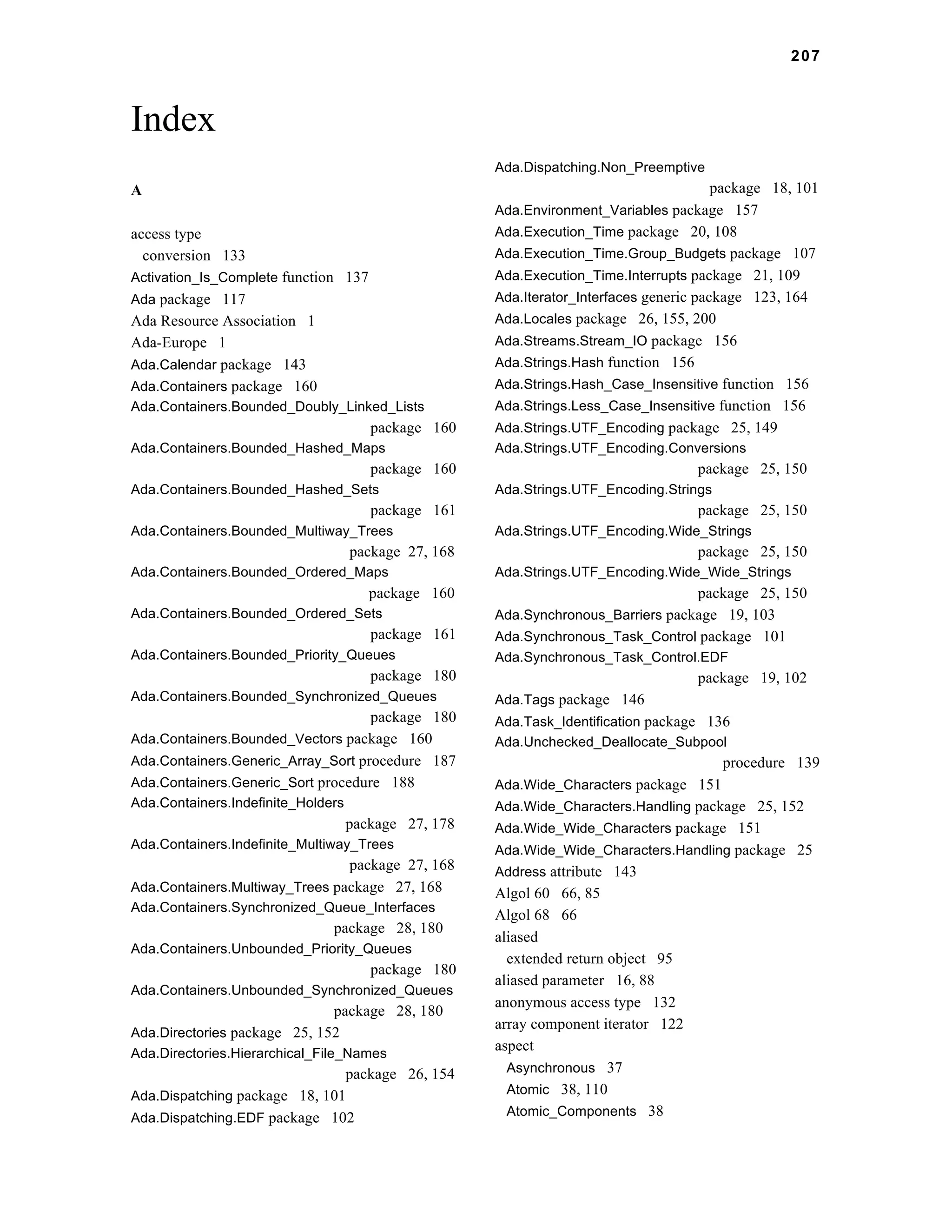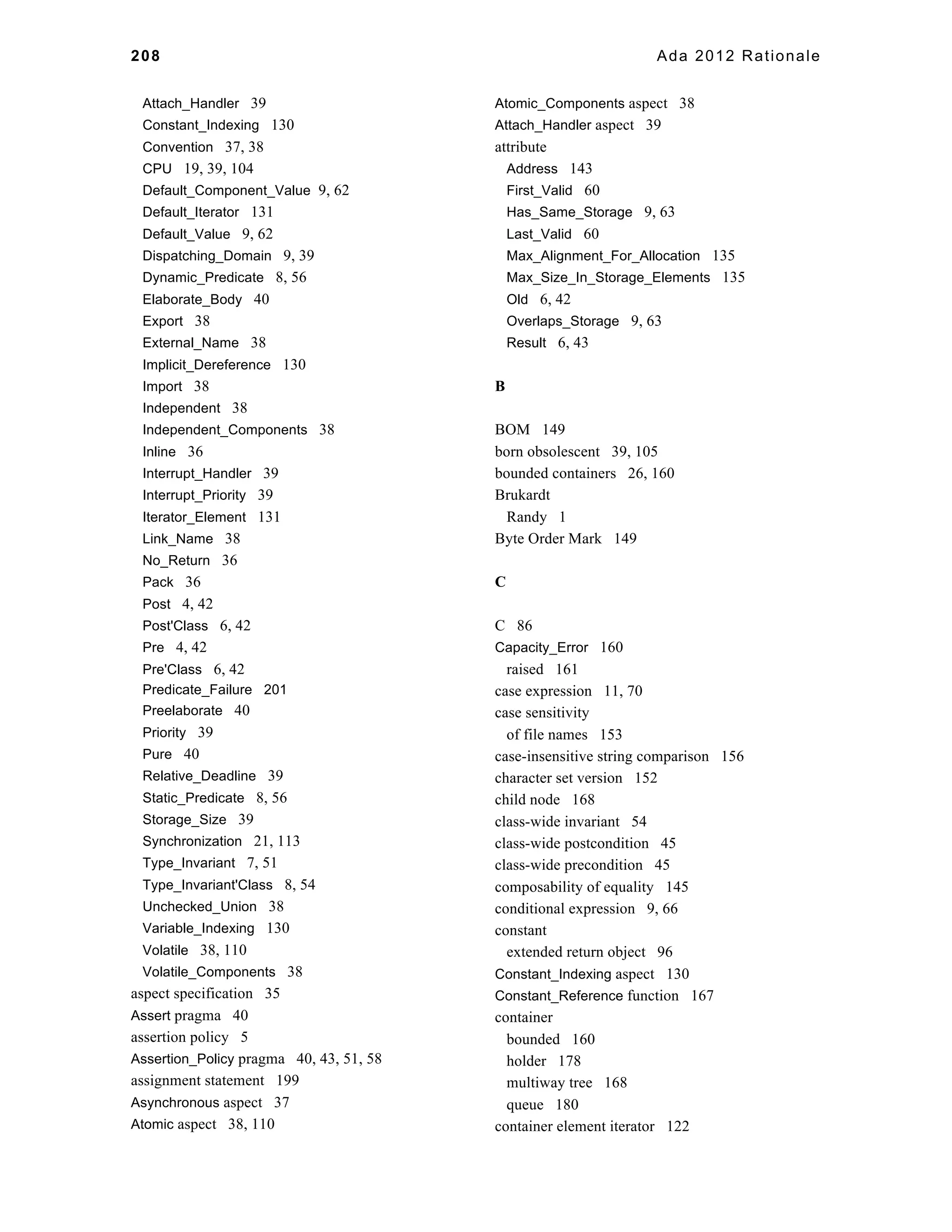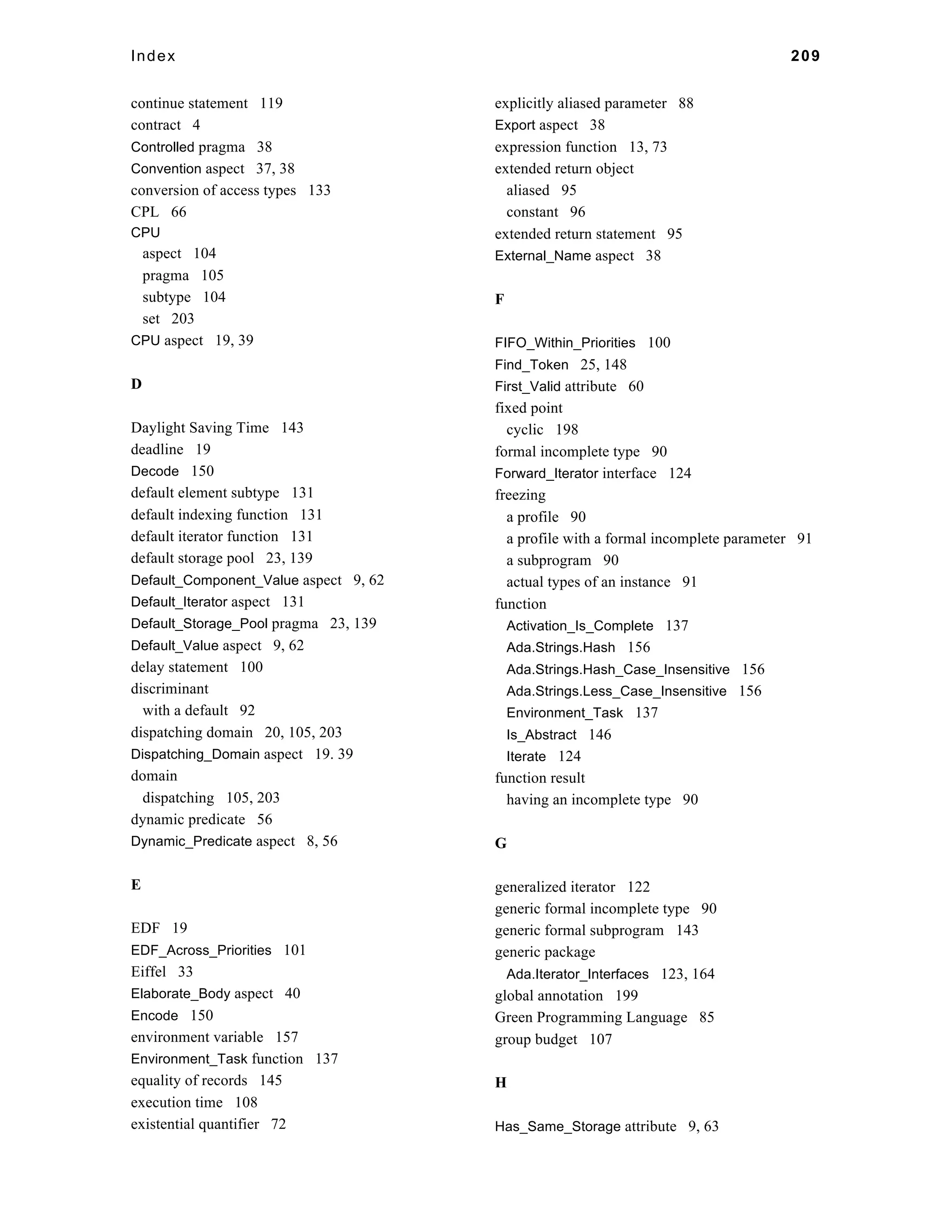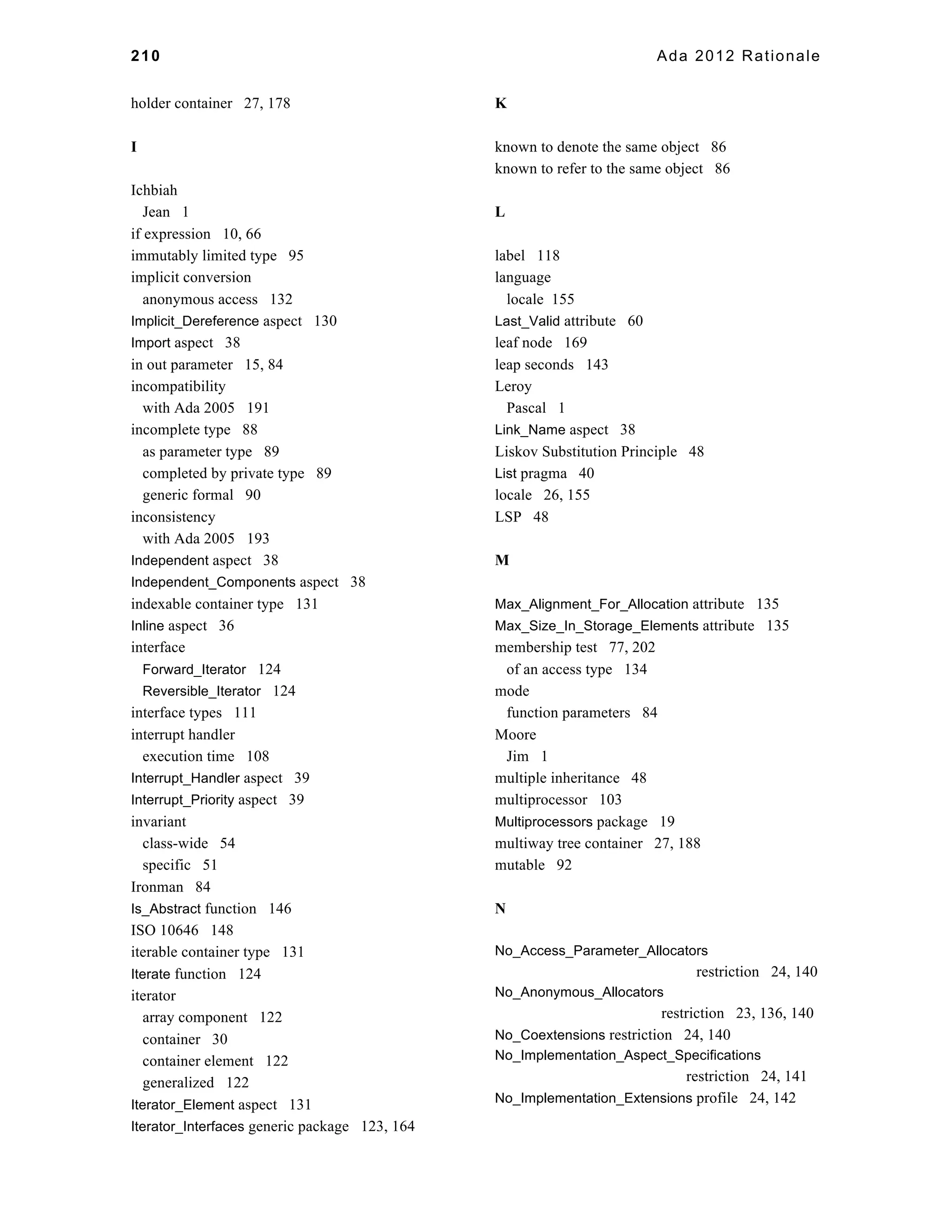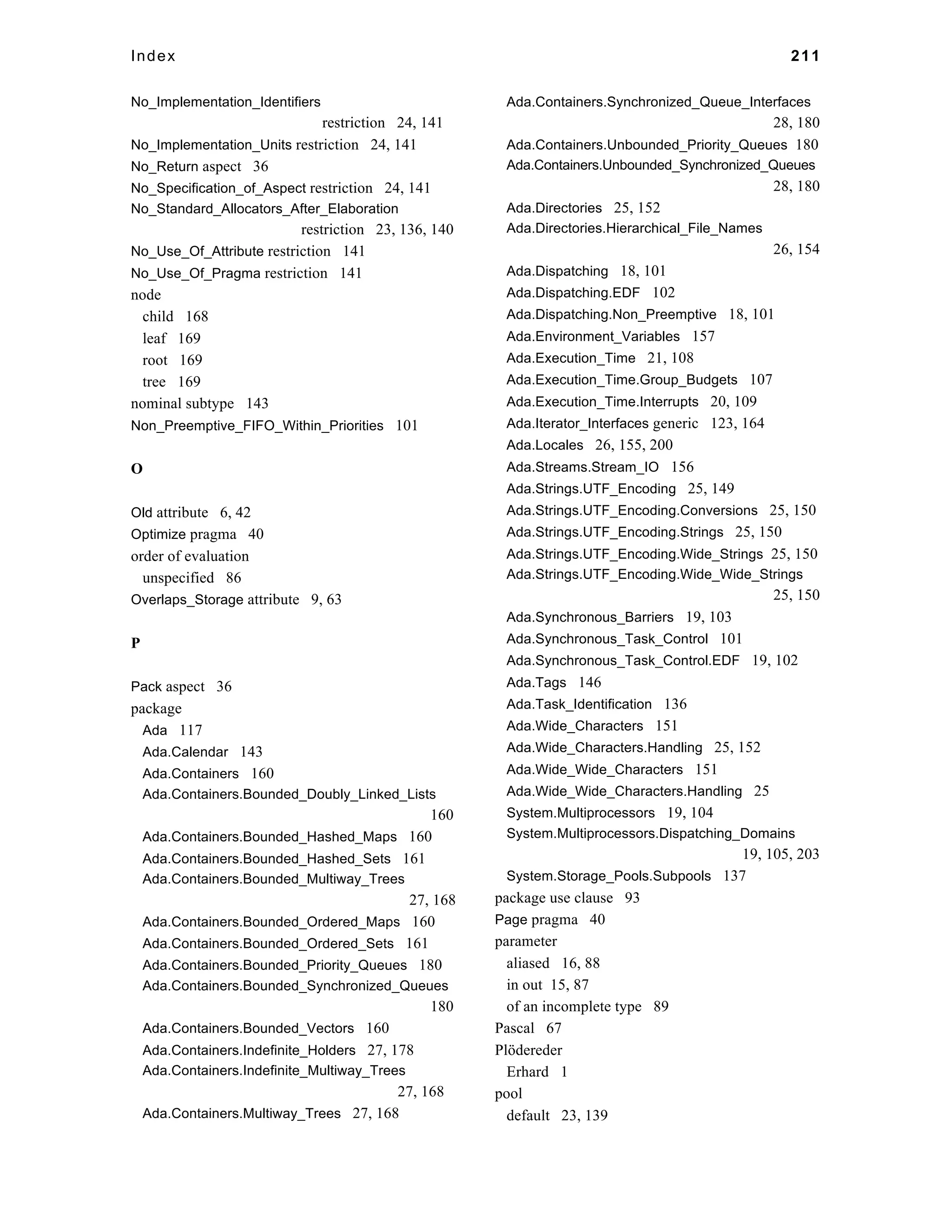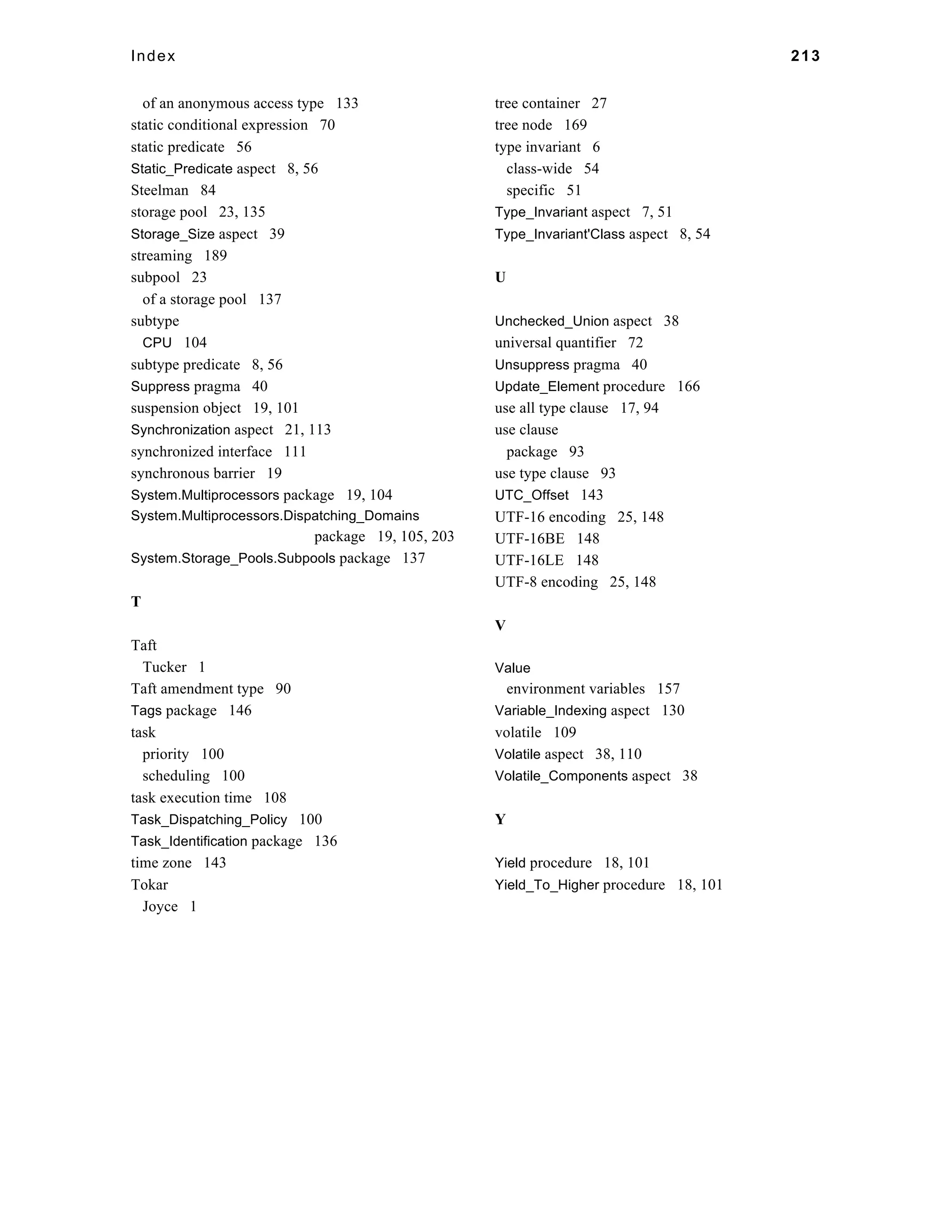The document provides an overview of the revision process for Ada 2012 and the scope of changes from Ada 2005. The revision was developed by ISO/IEC JTC1/SC22 WG9 and the ARG, following guidelines from WG9. The changes are significant but not as large as the changes from Ada 83 to Ada 95. The major additions include contracts, new expressions, changes to structure and visibility rules, improvements to tasking and real-time facilities, general improvements, and changes to the predefined library and containers.
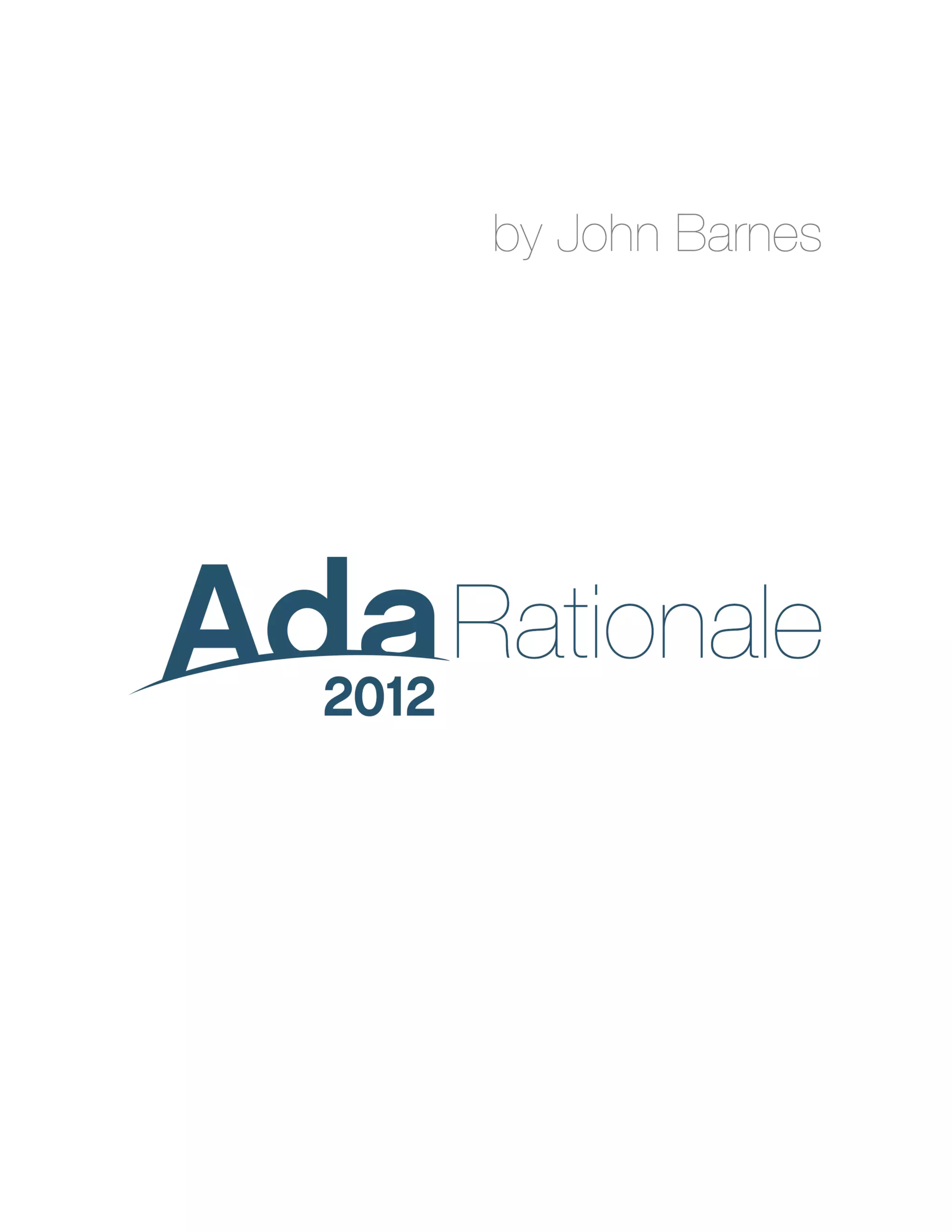
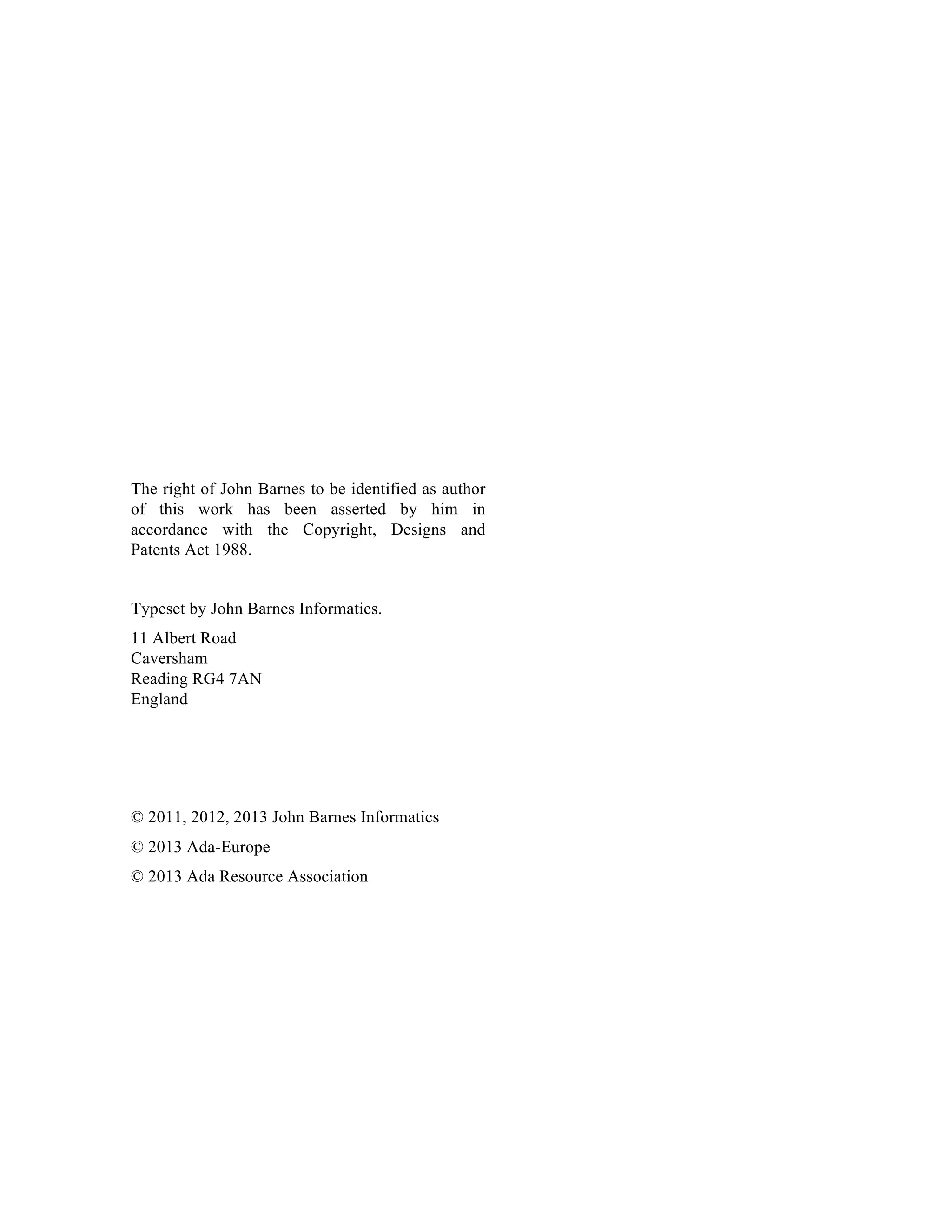
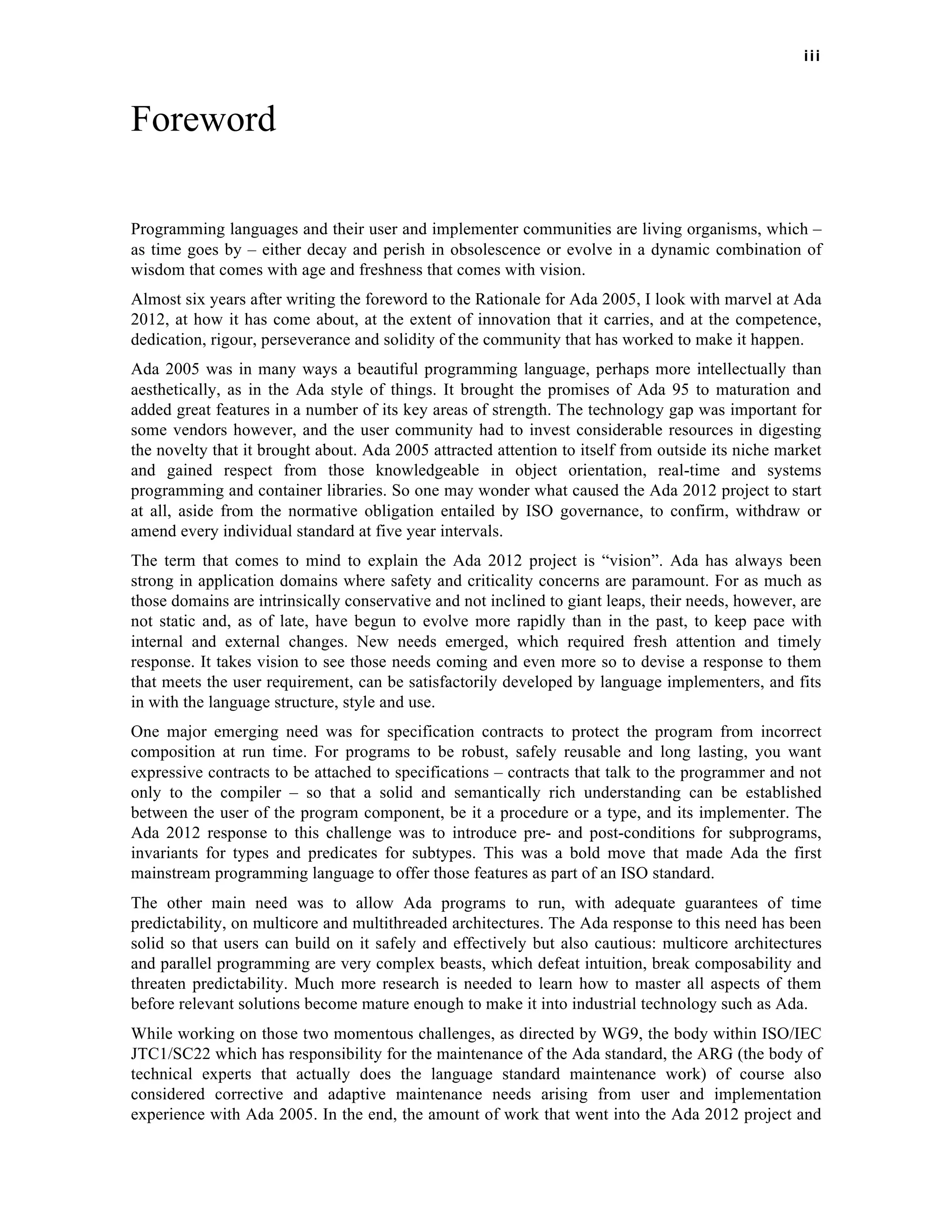
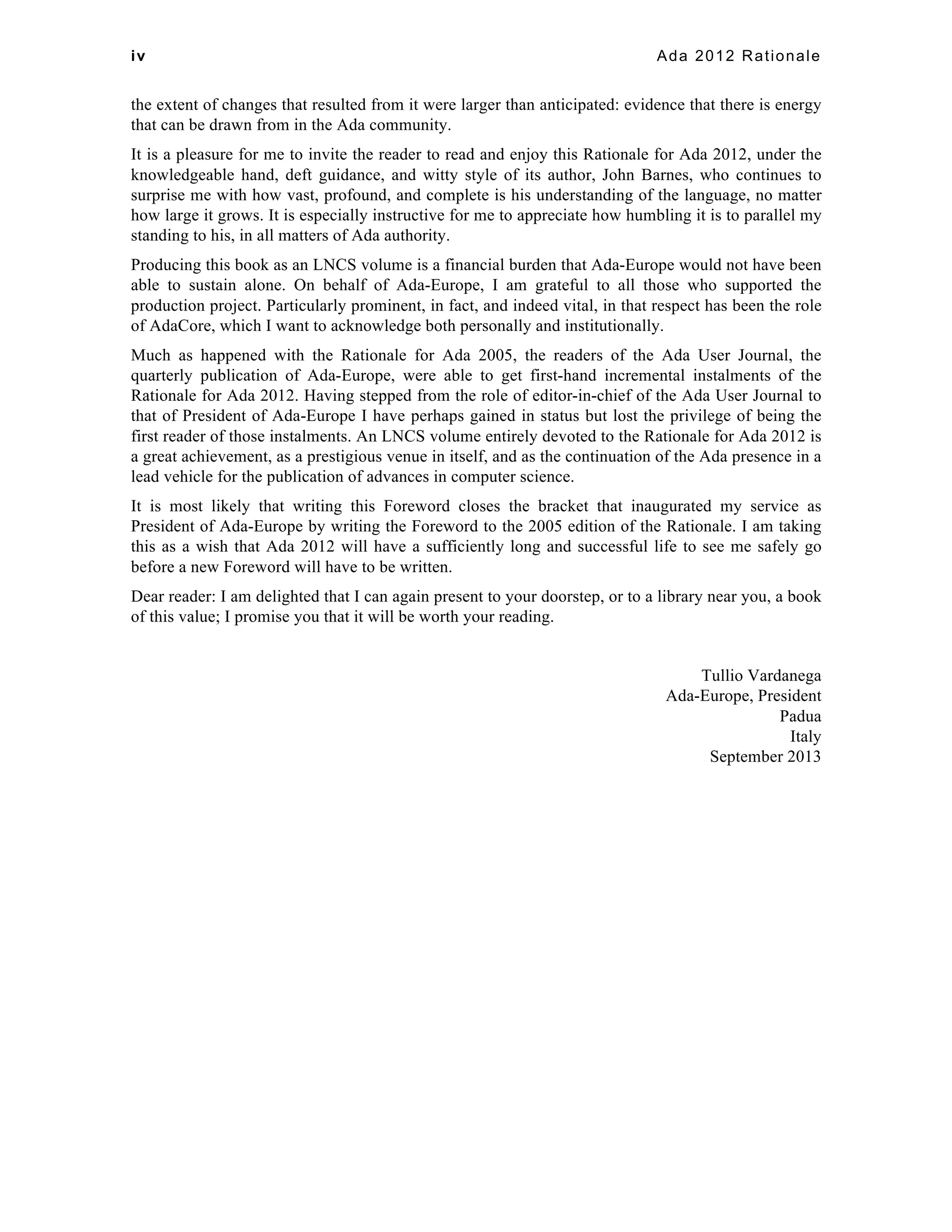


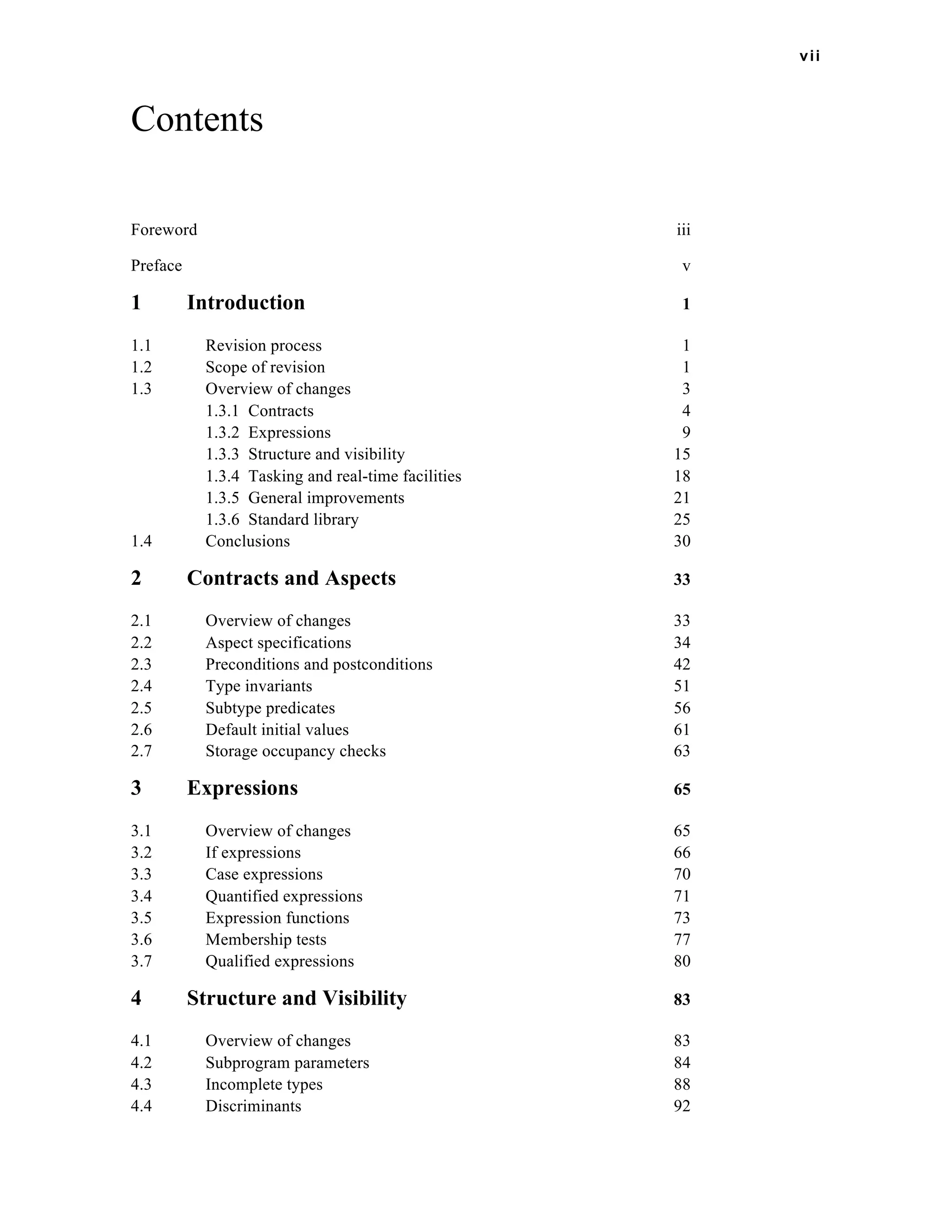
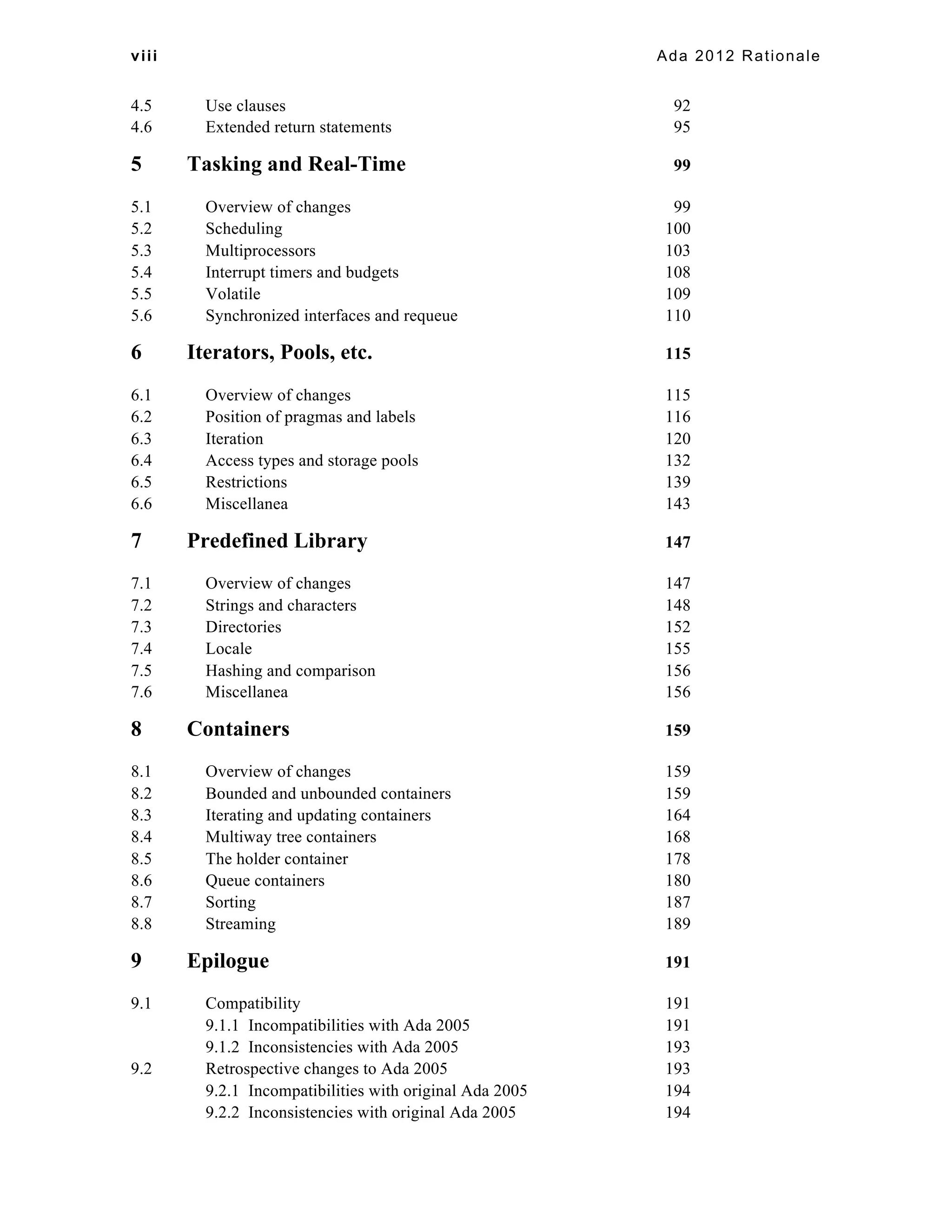


![1
1 Introduction
This first chapter covers the background to the development of Ada 2012 and gives a brief
overview of the main changes from Ada 2005. Other chapters then look at the changes in
more detail.
1.1 Revision process
Ada has evolved over a number of years and, especially for those unfamiliar with the background, it
is convenient to summarize the processes involved. The first version was Ada 83 and this was
developed by a team led by the late Jean Ichbiah and funded by the USDoD. The development of
Ada 95 from Ada 83 was an extensive process also funded by the USDoD. Formal requirements
were established after comprehensive surveys of user needs and competitive proposals were then
submitted resulting in the selection of Intermetrics as the developer under the leadership of Tucker
Taft. Then came Ada 2005 and this was developed on a more modest scale. The work was almost
entirely done by voluntary effort with support from within the industry itself through bodies such as
the Ada Resource Association and Ada-Europe.
After some experience with Ada 2005 it became clear that some further evolution was appropriate.
Adding new features as in Ada 2005 always brings some surprises regarding their use and further
polishing is almost inevitable. Accordingly, it was decided that a further revision should be made
with a goal of completion in 2012.
As in the case of Ada 2005, the development was performed under the guidance of ISO/IEC
JTC1/SC22 WG9 (hereinafter just called WG9). Previously chaired by Jim Moore, it is now under
the chairmanship of Joyce Tokar. This committee has included national representatives of many
nations including Belgium, Canada, France, Germany, Italy, Japan, Spain, Sweden, Switzerland, the
UK and the USA. WG9 developed guidelines [1] for a revision to Ada 2005 which were then used
by the Ada Rapporteur Group (the ARG) in drafting the revised standard.
The ARG is a team of experts nominated by the national bodies represented on WG9 and the two
liaison organizations, ACM SIGAda and Ada-Europe. In the case of Ada 2005, the ARG was
originally led by Erhard Plödereder and then by Pascal Leroy. For Ada 2012, it was led by Ed
Schonberg. The editor, who at the end of the day actually writes the words of the standard, continues
to be the indefatigable Randy Brukardt.
Suggestions for the revised standard have come from a number of sources such as individuals on the
ARG, national bodies on WG9, users and implementers via email discussions on Ada-Comment and
so on. Also several issues were left over from the development of Ada 2005.
The revision process was completed early in 2012 and the new standard was approved late in 2012
thanks to a revised fast track mechanism.
1.2 Scope of revision
The changes from Ada 95 to Ada 2005 were significant (although not so large as the changes from
Ada 83 to Ada 95). The main additions were
▪ in the OO area, multiple inheritance using interfaces and the ability to make calls using
prefixed notation,
▪ more flexible access types with anonymous types, more control over null and constant, and
downward closures via access to subprogram types,](https://image.slidesharecdn.com/ada2012rationale-141002094233-phpapp01/75/Ada2012-Rationale-11-2048.jpg)
![2 Introduction
▪ enhanced structure and visibility control by the introduction of limited with and private with
clauses and by an extended form of return statement,
▪ in the real-time area, the Ravenscar profile [2], various new scheduling polices, timers and
execution time budget control,
▪ some minor improvements to exception handling, numerics (especially fixed point) and some
further pragmas such as Assert,
▪ various extensions to the standard library such as the introduction of operations on vectors and
matrices, further operations on times and dates, and operations on wide wide characters; and
especially:
▪ a comprehensive library for the manipulation of containers of various kinds.
The changes from Ada 2005 to Ada 2012 were intended to be relatively modest and largely to lead
on from the experience of the additions introduced in Ada 2005. But one thing led to another and in
fact the changes are of a similar order to those from Ada 95 to Ada 2005.
From the point of view of the ISO standard, Ada 2005 is the Ada 95 standard modified by two
documents. First there was a Corrigendum issued in 2001 [3] and then an Amendment issued in
2005 [4]. In principle the poor user thus has to study these three documents in parallel to understand
Ada 2005. However, they were informally incorporated into the Ada 2005 Reference Manual [5].
In the case of Ada 2012, this process of developing a further formal amendment would then lead to
the need to consult four documents which would be madness and so this time we have simply a new
Edition based formally on a single Revision.
The scope of this Revision is guided by a document issued by WG9 to the ARG in October 2008
[1]. The essence was that the ARG was requested to pay particular attention to
A Improvements that will maintain or improve Ada's advantages, especially in those user
domains where safety and criticality are prime concerns. Within this area it cites improving the
use and functionality of containers, the ability to write and enforce contracts for Ada entities
(for instance, via preconditions) and the capabilities of Ada on multicore and multithreaded
architectures.
B Improvements that will remedy shortcomings in Ada. It cites in particular the safety, use, and
functionality of access types and dynamic storage management.
So the ARG was asked to improve both OO and real-time with a strong emphasis on real-time and
high integrity features. Moreover, "design by contract" features should be added whereas for the
previous amendment they were rejected on the grounds that they would not be static.
The ARG was also asked to consider the following factors in selecting features for inclusion:
▪ Implementability. Can the feature be implemented at reasonable cost?
▪ Need. Do users actually need it?
▪ Language stability. Would it appear disturbing to current users?
▪ Competition and popularity. Does it help to improve the perception of Ada and make it more
competitive?
▪ Interoperability. Does it ease problems of interfacing with other languages and systems?
▪ Language consistency. Is it syntactically and semantically consistent with the language's
current structure and design philosophy?](https://image.slidesharecdn.com/ada2012rationale-141002094233-phpapp01/75/Ada2012-Rationale-12-2048.jpg)
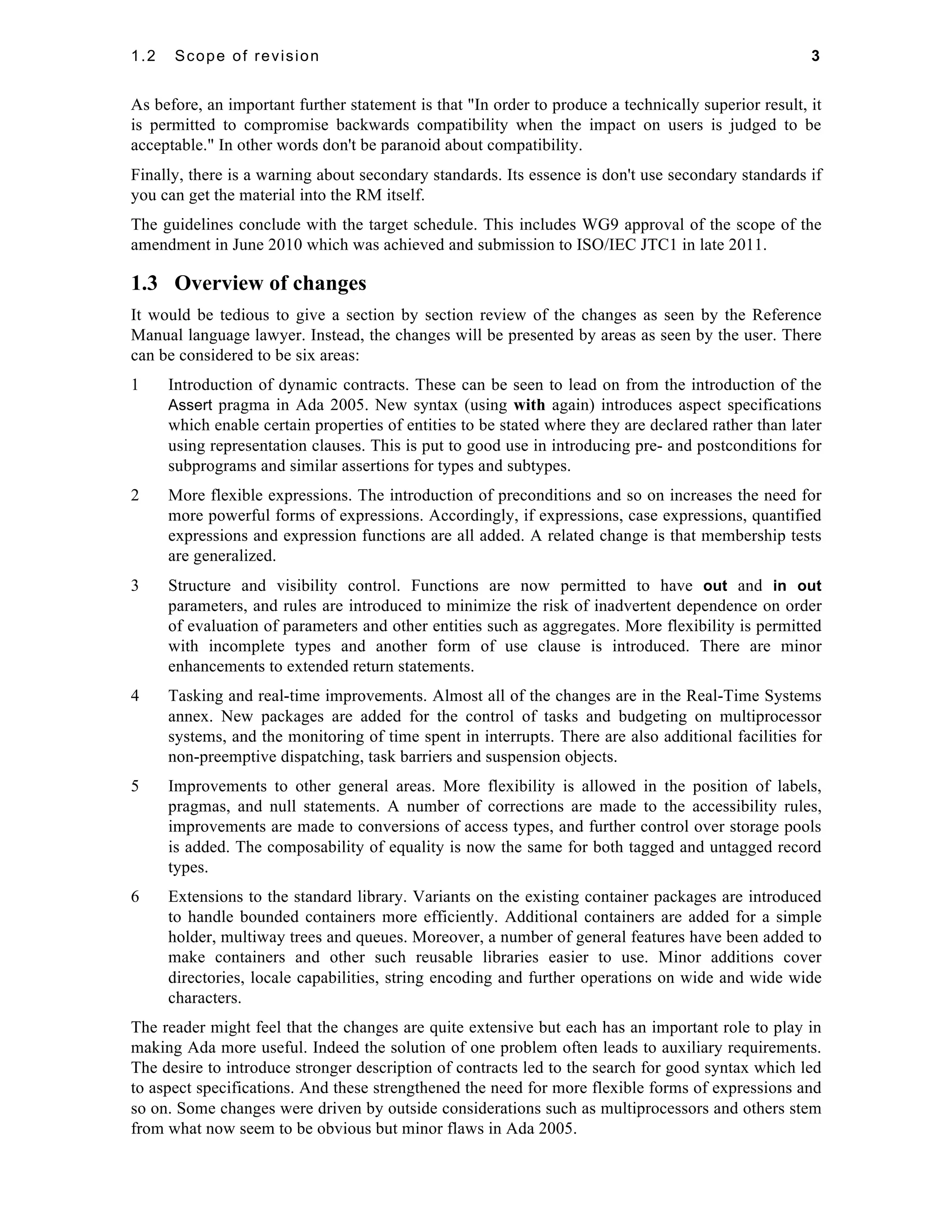

![1.3 Overview of changes 5
procedure Push(S: in out Stack; X: in Item)
with
Pre => not Is_Full(S),
Post => not Is_Empty(S);
procedure Pop(S: in out Stack; X: out Item)
with
Pre => not Is_Empty(S),
Post => not Is_Full(S);
private
...
end Stacks;
Note how the individual aspects Pre and Post take the form of
aspect_mark => expression
and that if there are several then they are separated by commas. The final semicolon is of course the
semicolon at the end of the subprogram declaration as a whole. Thus the overall syntax is now
subprogram_declaration ::=
[overriding_indicator]
subprogram_specification
[aspect_specification] ;
and in general
aspect_specification ::=
with aspect_mark [ => expression] { ,
aspect_mark [ => expression] }
Pre- and postconditions are controlled by the same mechanism as assertions using the pragma
Assert. It will be recalled that these can be switched on and off by the pragma Assertion_Policy.
Thus if we write
pragma Assertion_Policy(Check);
then assertions are enabled whereas if the parameter of the pragma is Ignore then all assertions are
ignored.
In the case of a precondition, whenever a subprogram with a precondition is called, if the policy is
Check then the precondition is evaluated and if it is False then Assertion_Error is raised and the
subprogram is not entered. Similarly, on return from a subprogram with a postcondition, if the
policy is Check then the postcondition is evaluated and if it is False then Assertion_Error is raised.
So if the policy is Check and Pop is called when the stack is empty then Assertion_Error is raised
whereas if the policy is Ignore then the predefined exception Constraint_Error would probably be
raised (depending upon how the stack had been implemented).
Note that, unlike the pragma Assert, it is not possible to associate a specific message with the raising
of Assertion_Error by a pre- or postcondition. The main reason is that it might be confusing with
multiple conditions (which can arise with inheritance) and in any event it is expected that the
implementation will give adequate information about which condition has been violated.
Note that it is not permitted to give the aspects Pre or Post for a null procedure; this is because all
null procedures are meant to be interchangeable.](https://image.slidesharecdn.com/ada2012rationale-141002094233-phpapp01/75/Ada2012-Rationale-15-2048.jpg)

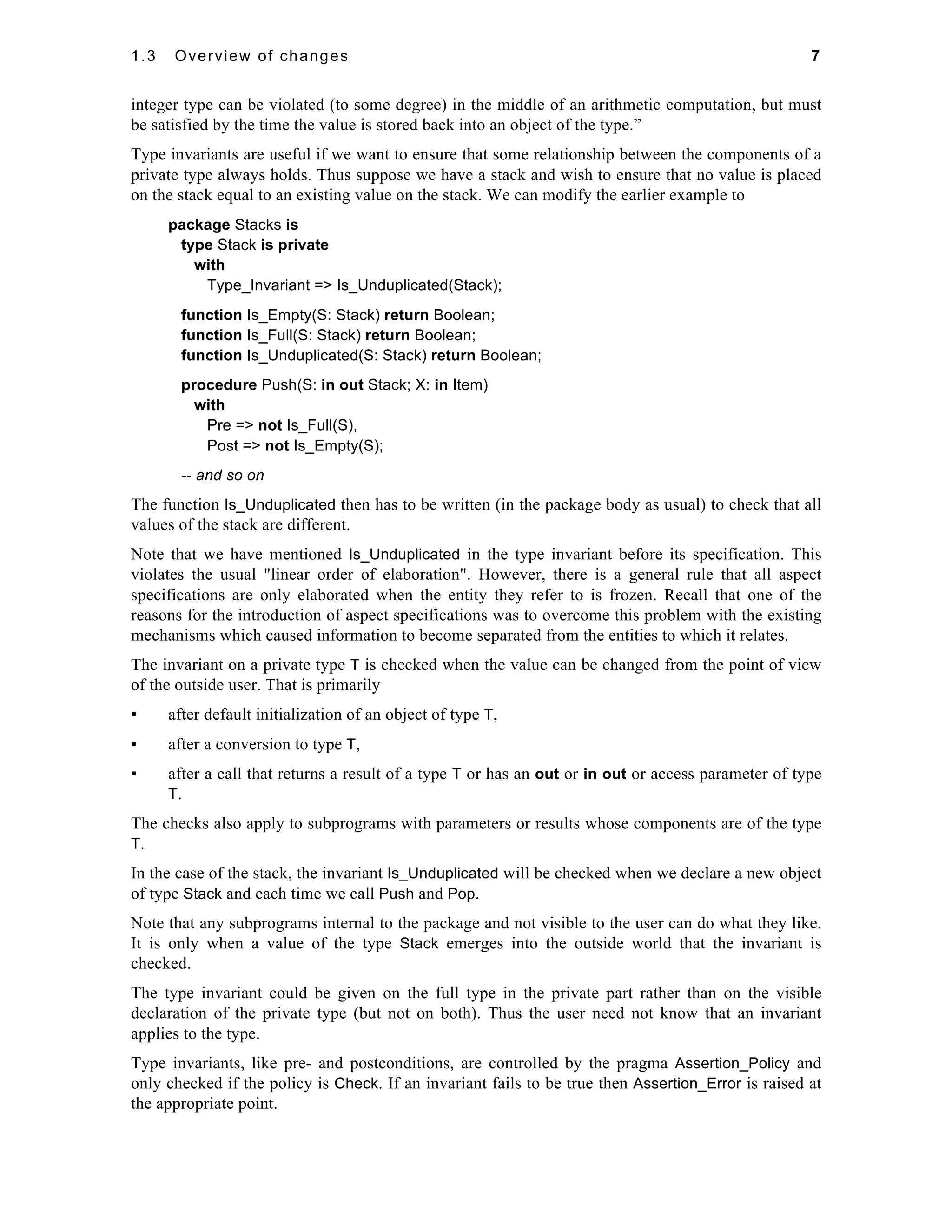
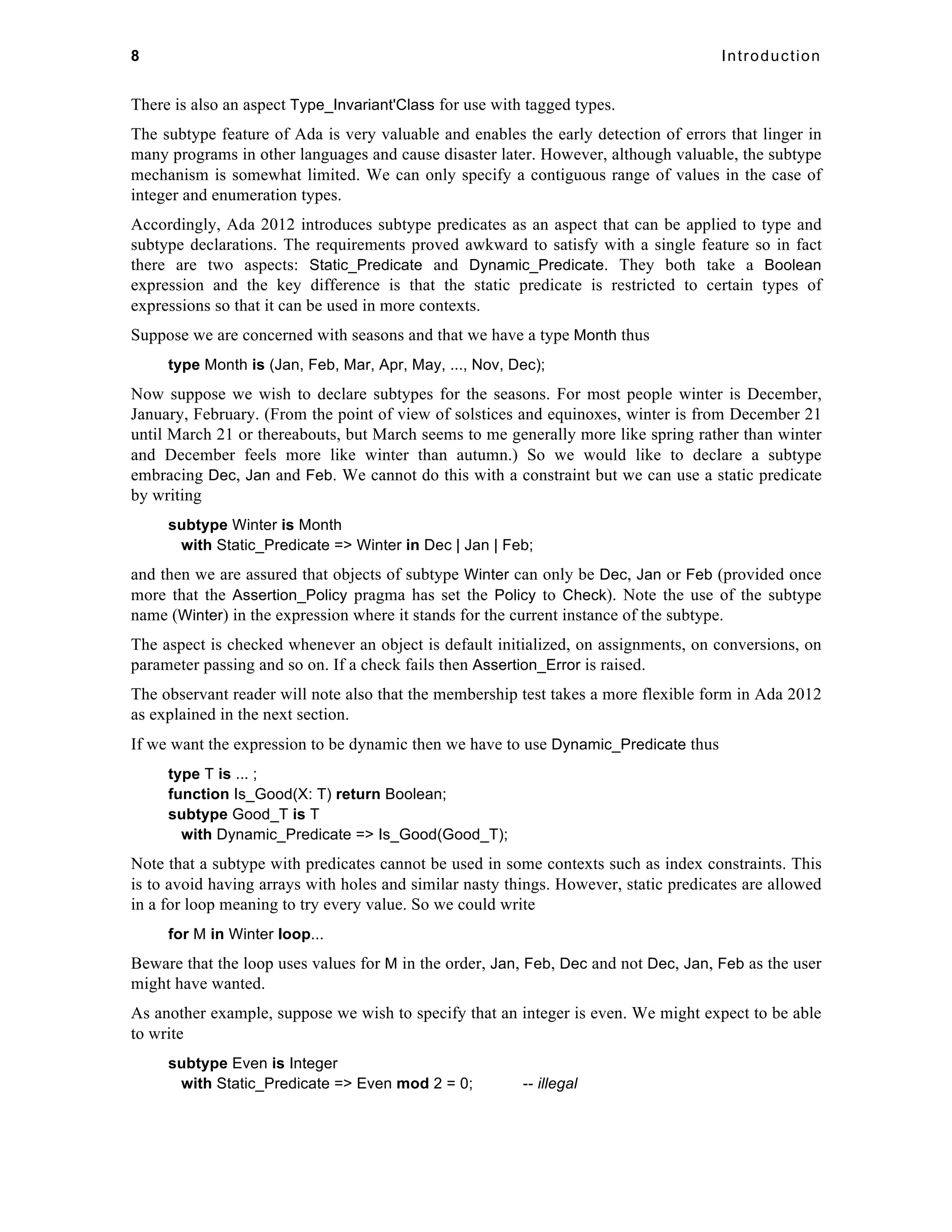
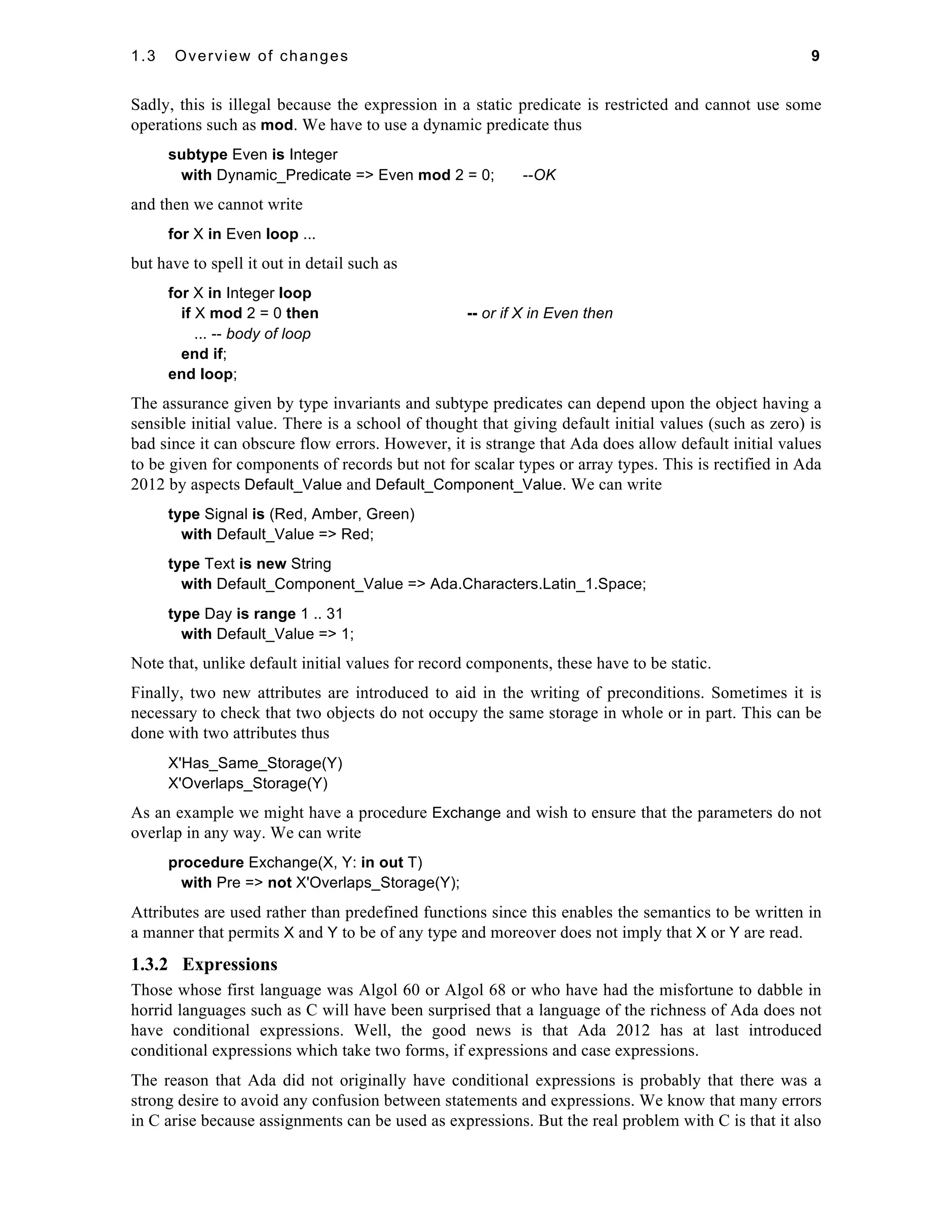
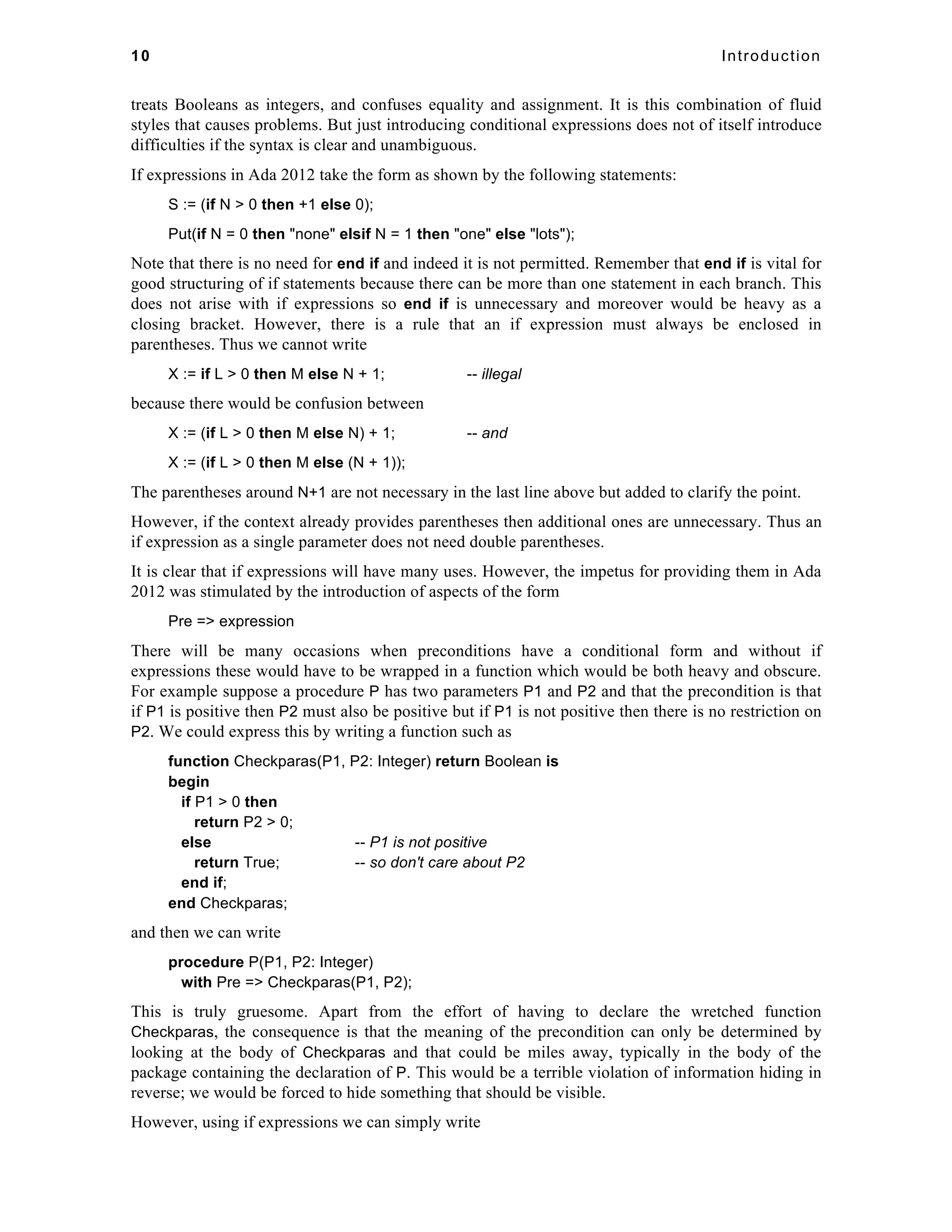
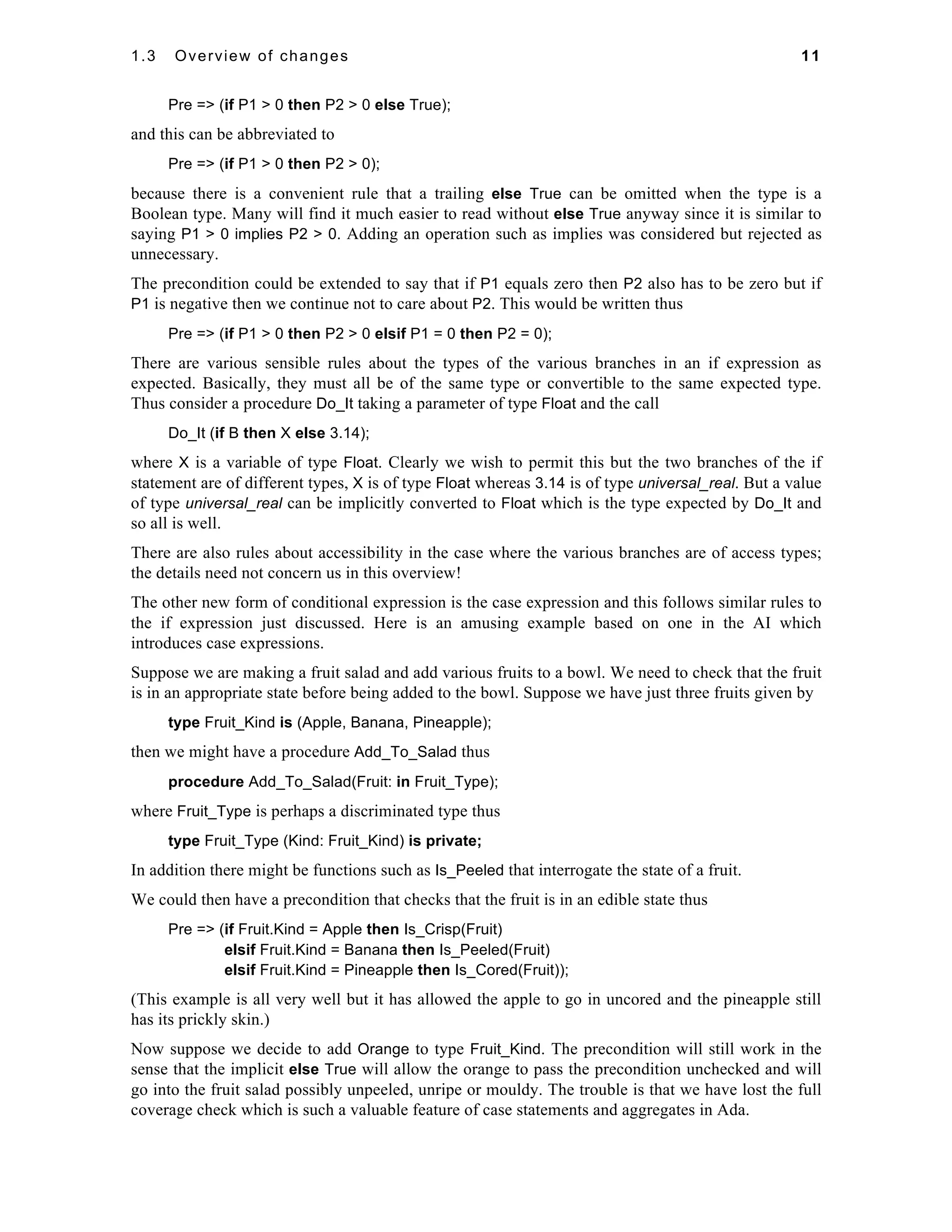
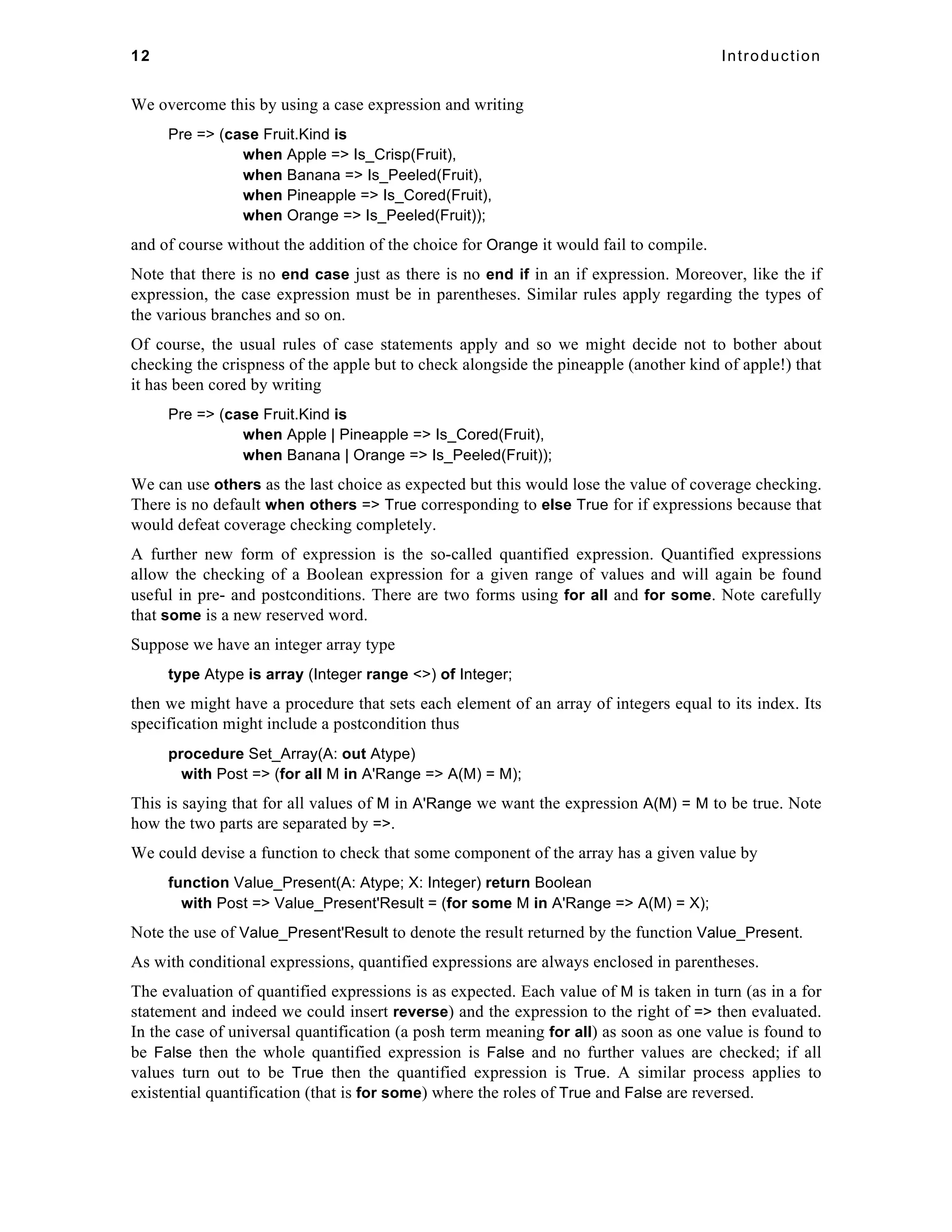
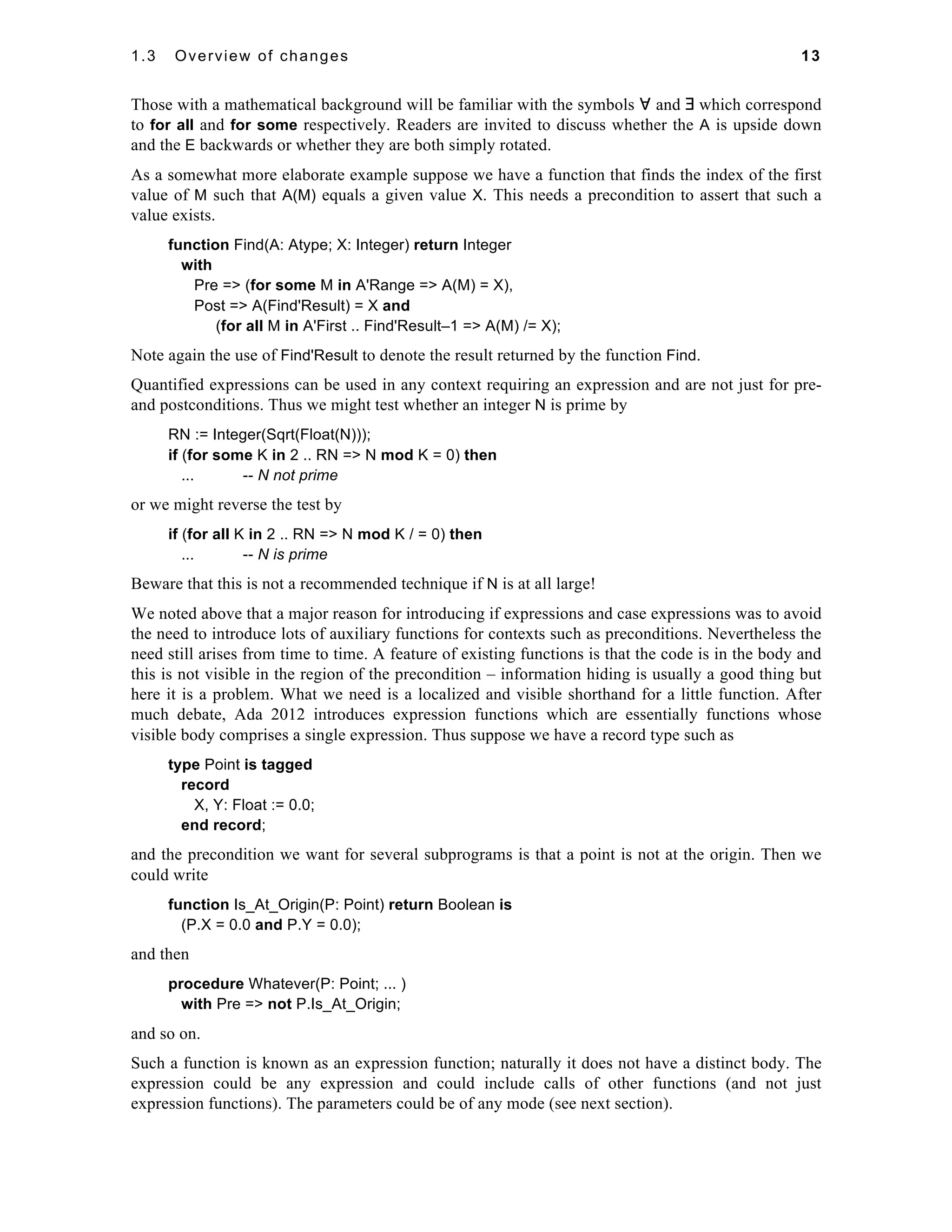
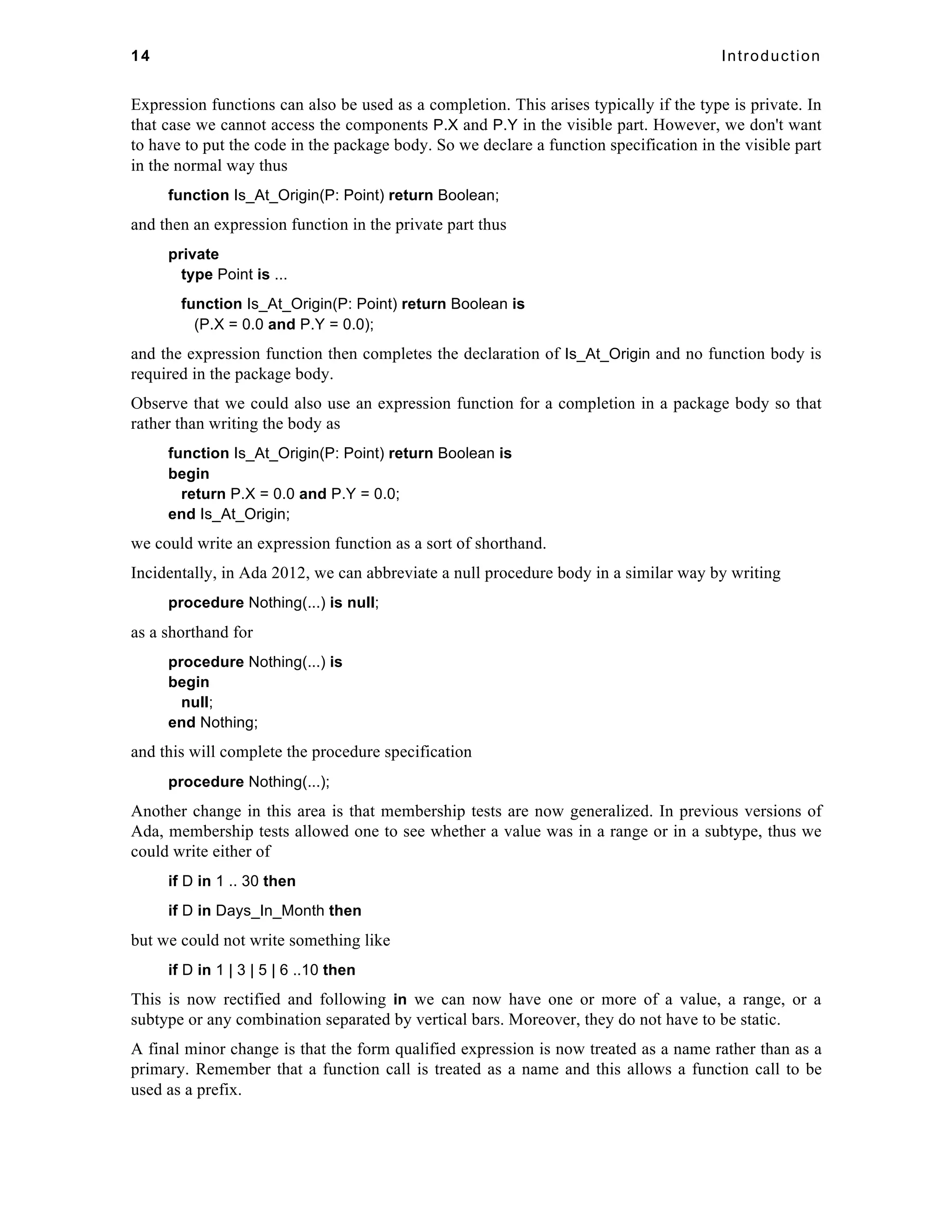

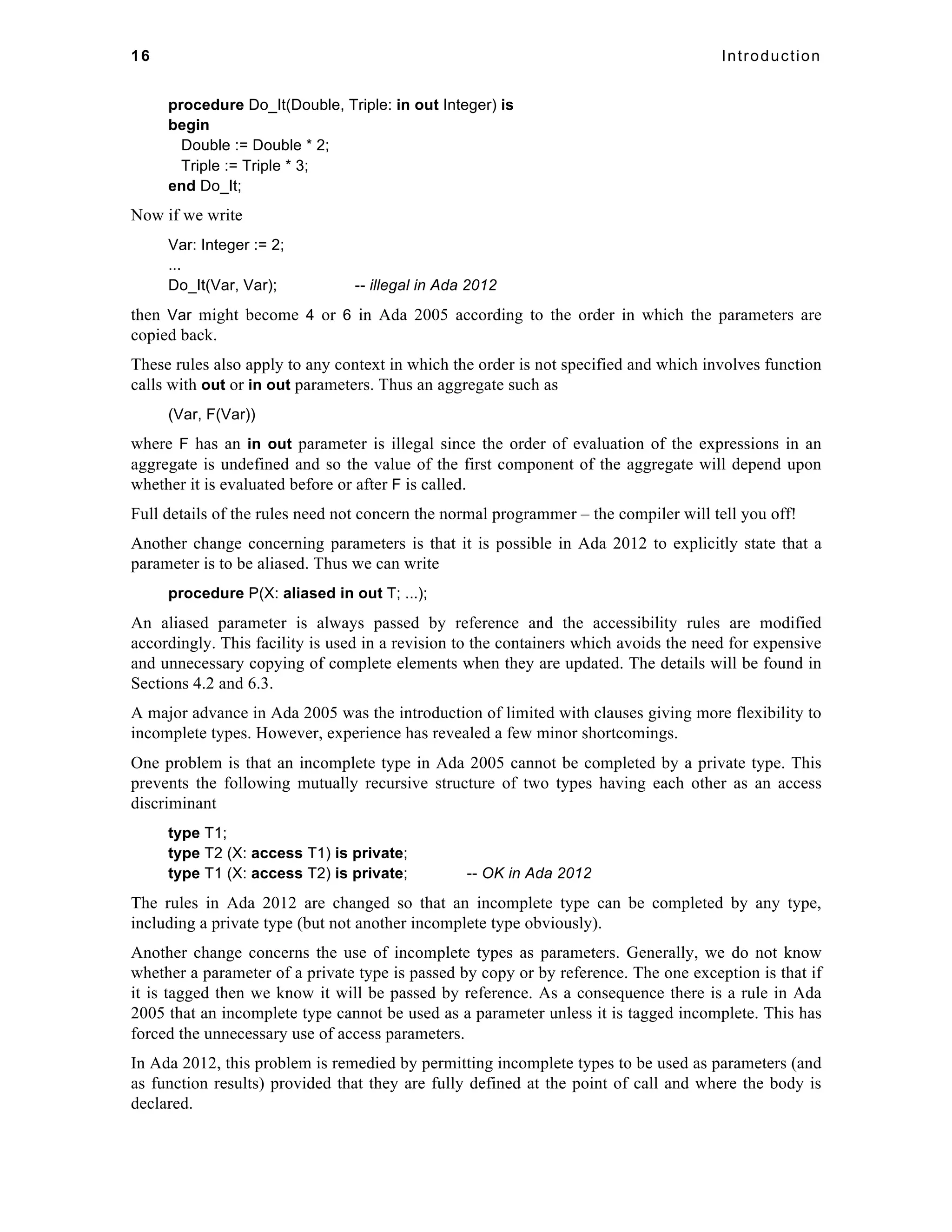
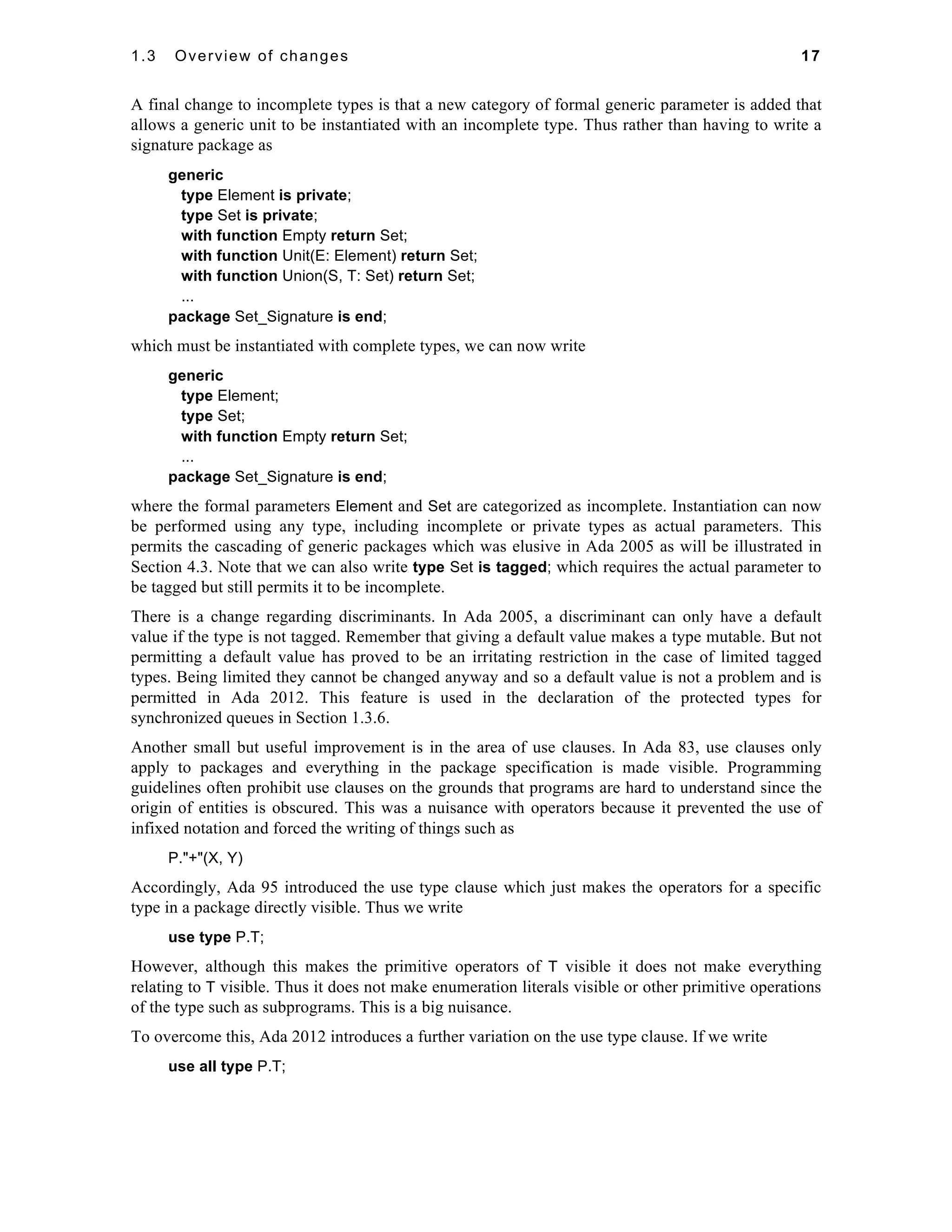
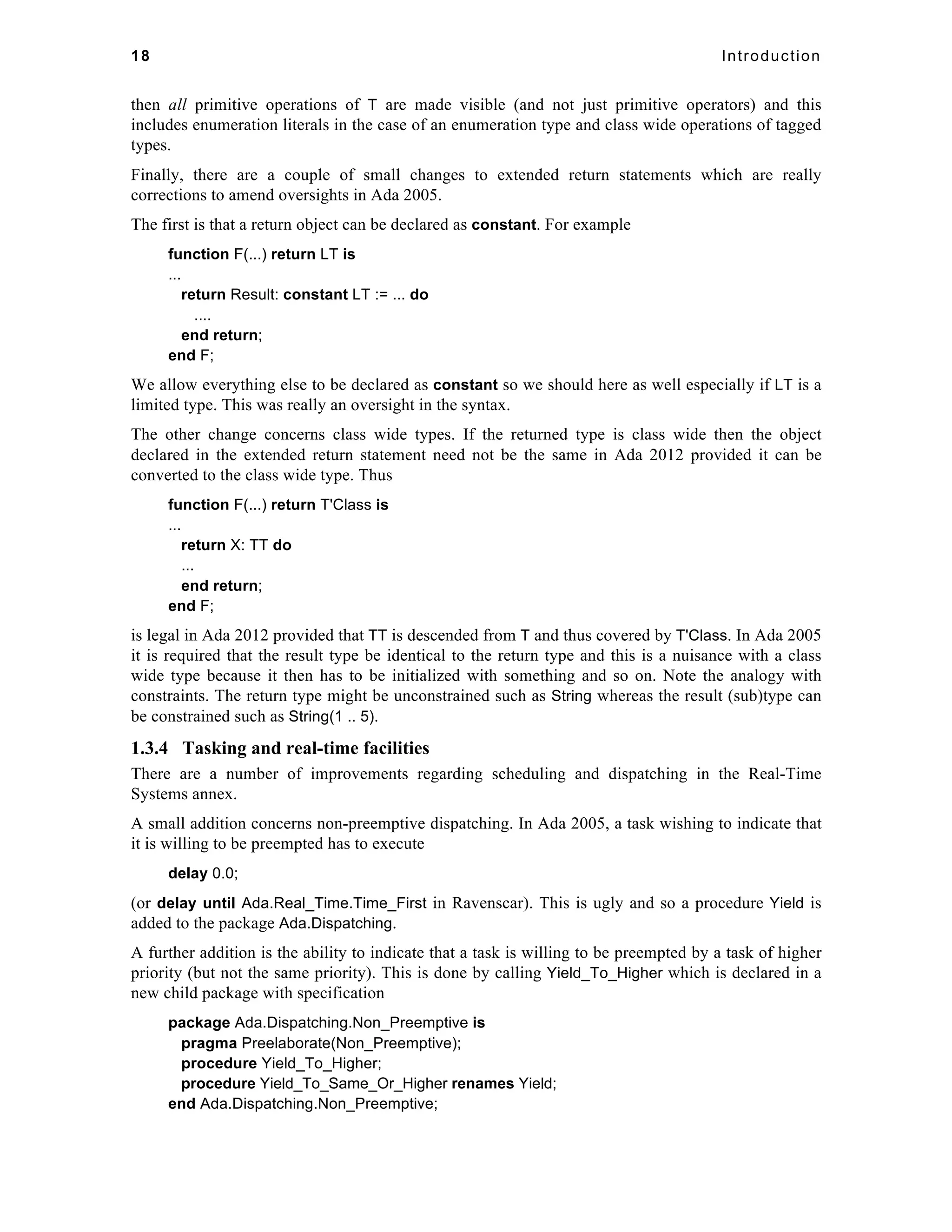
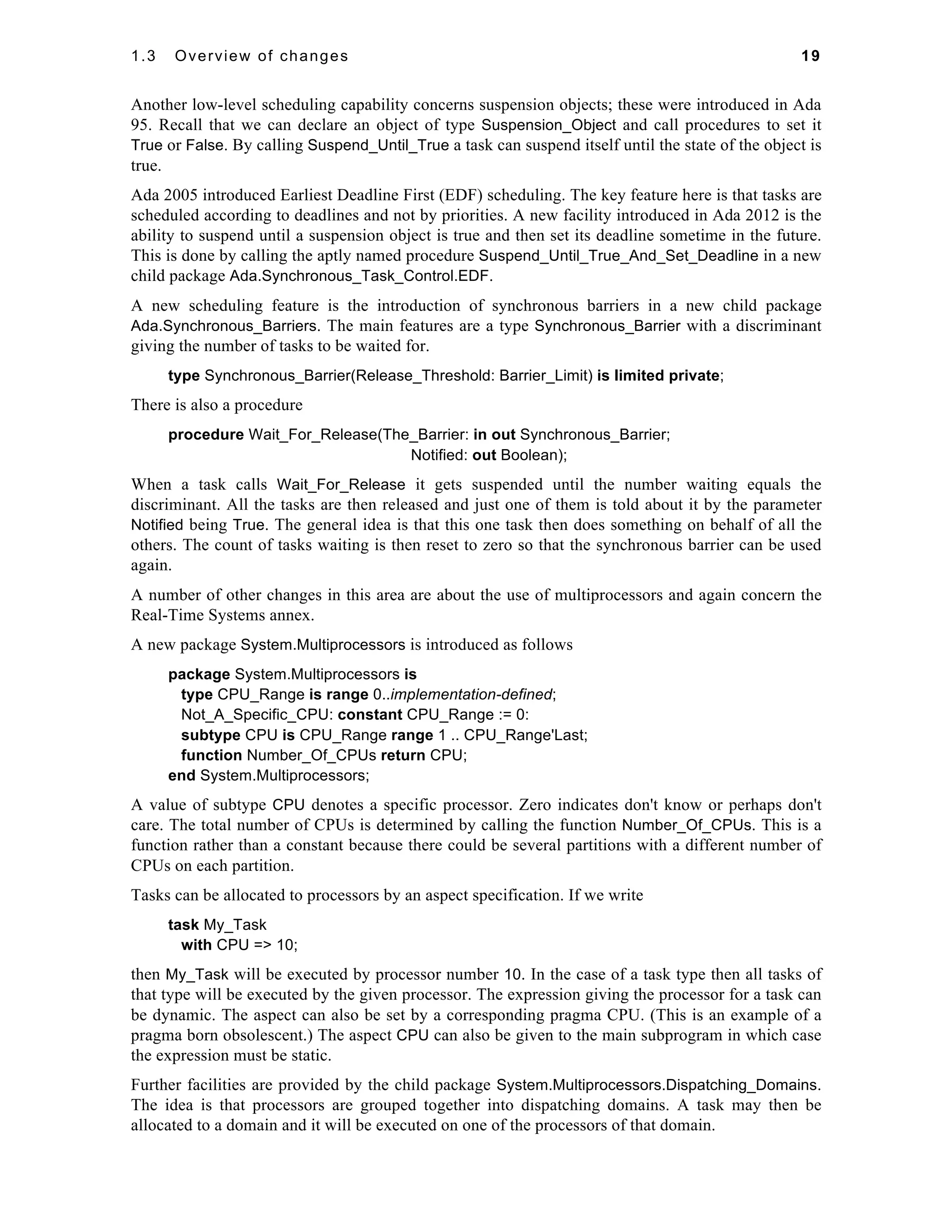
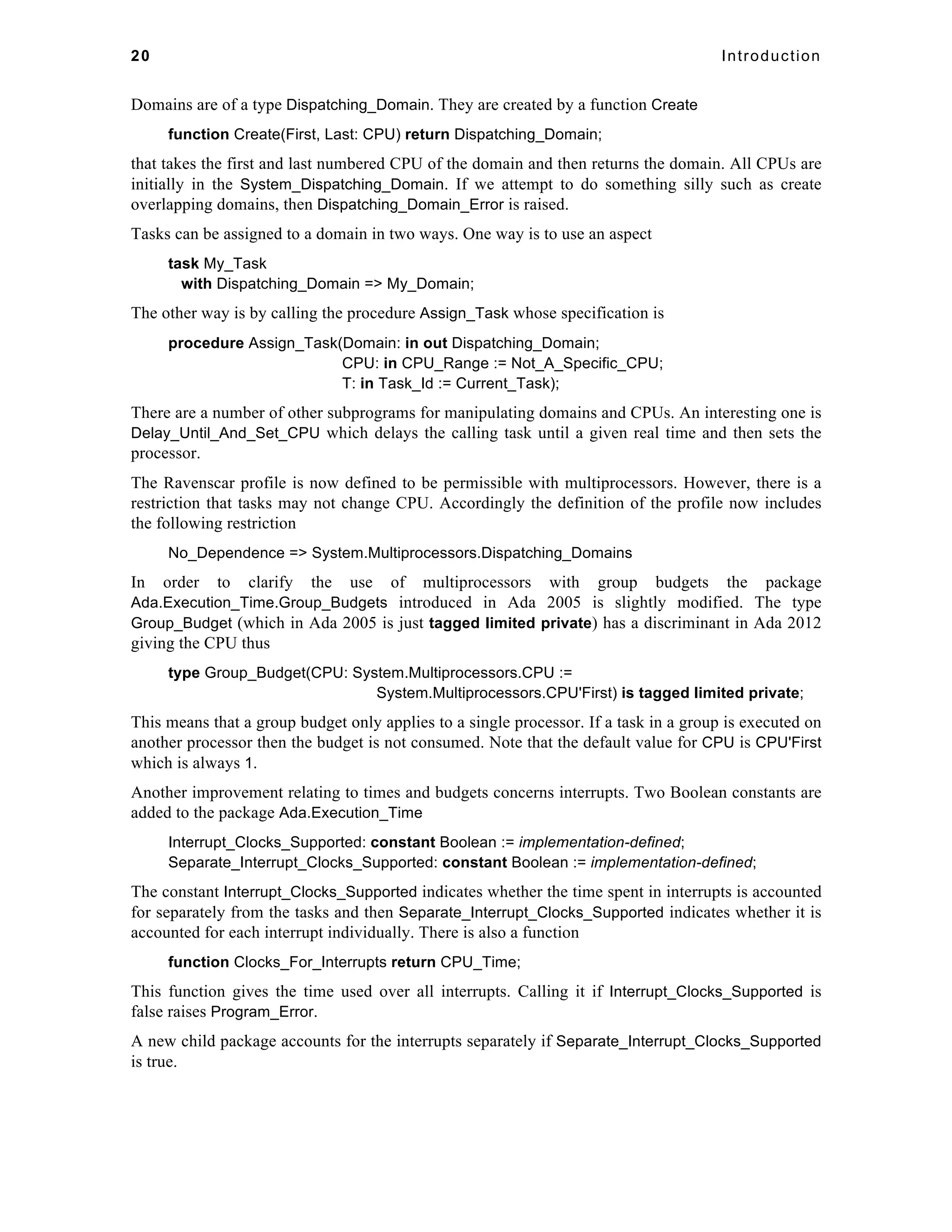
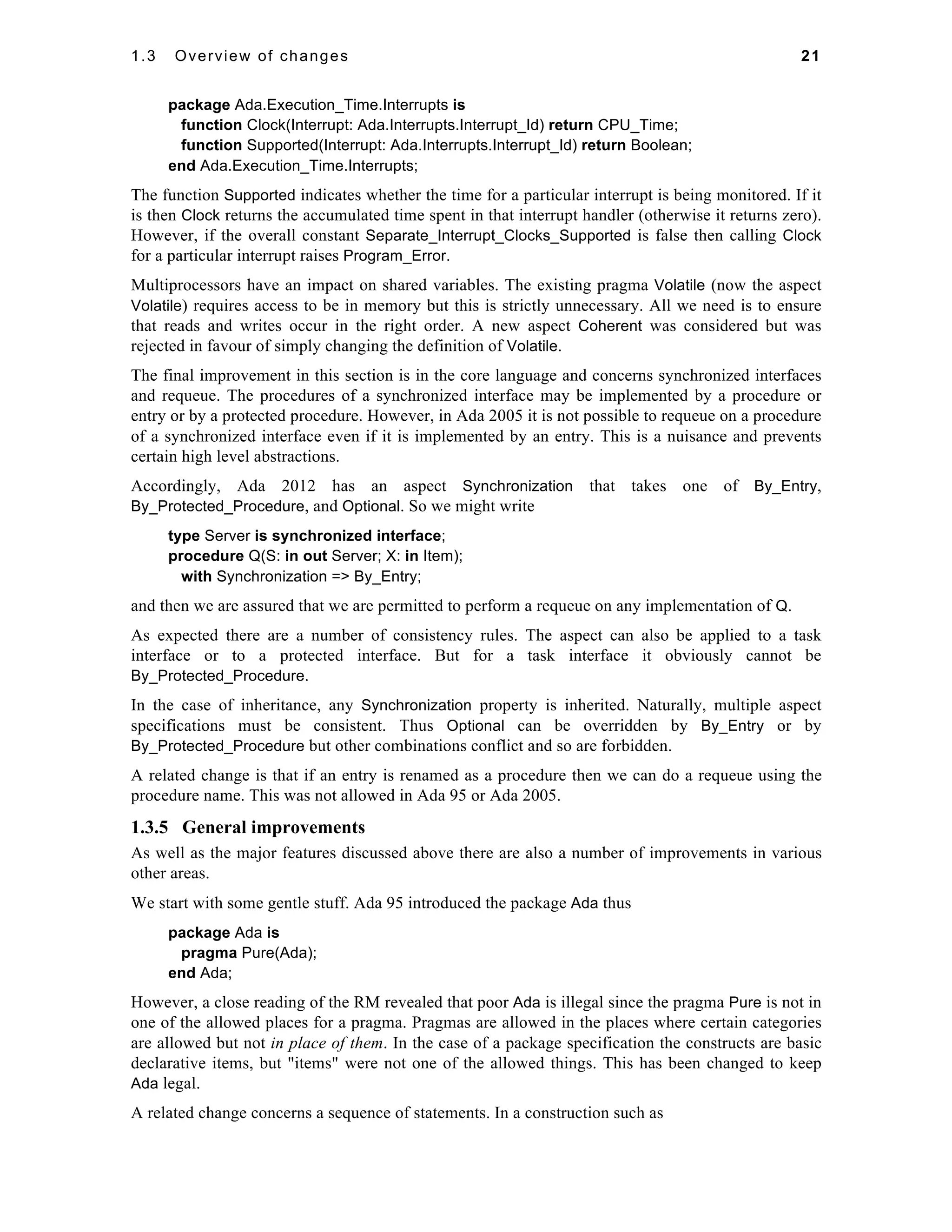
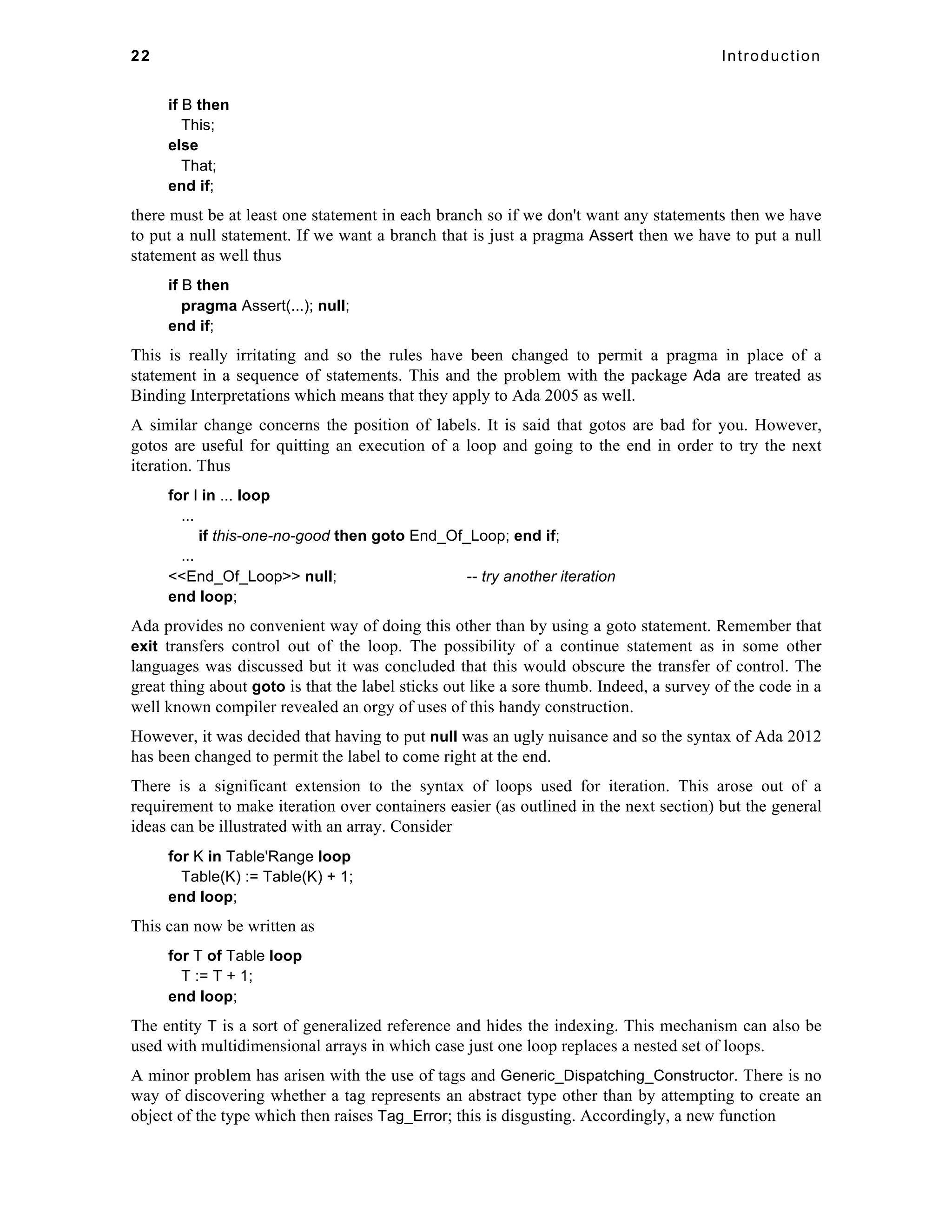
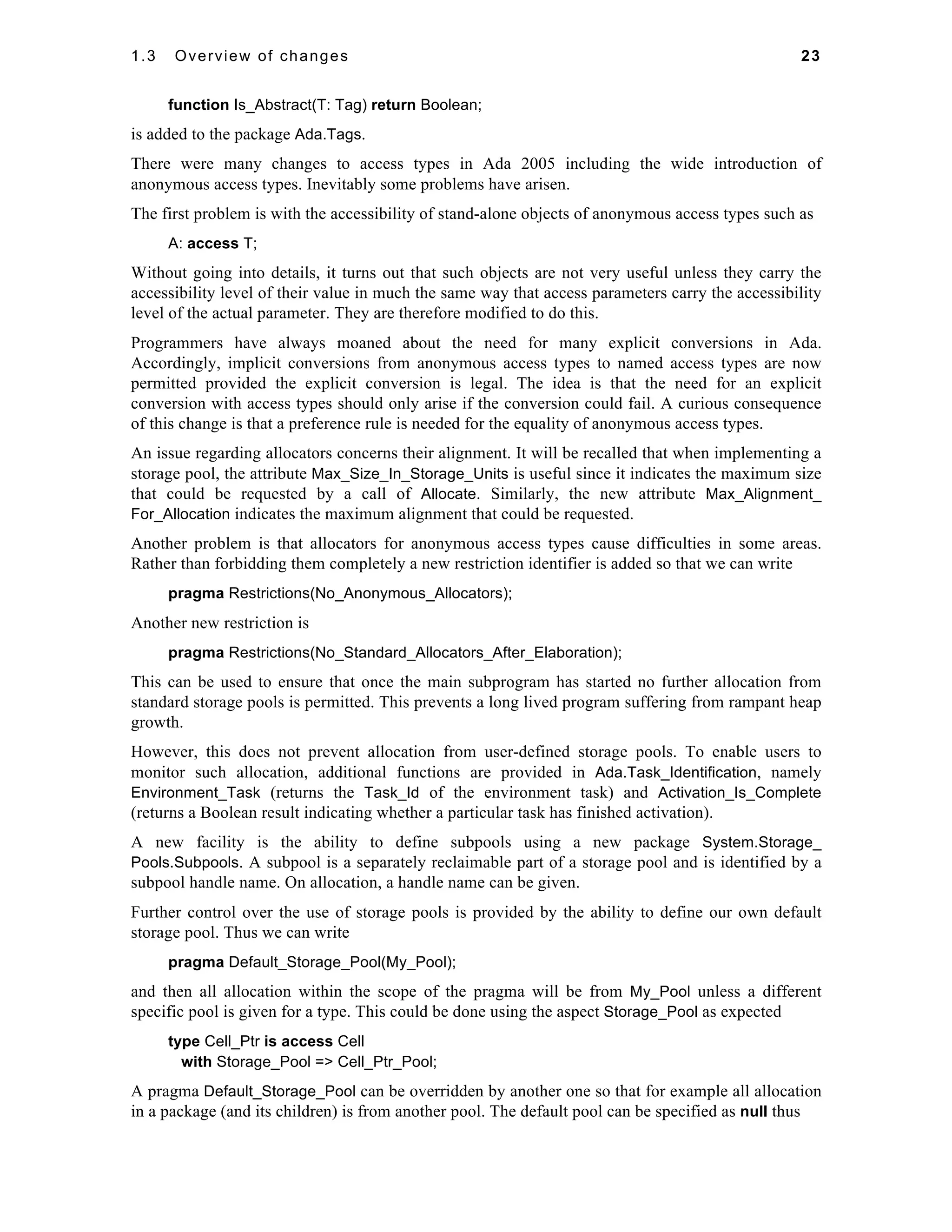
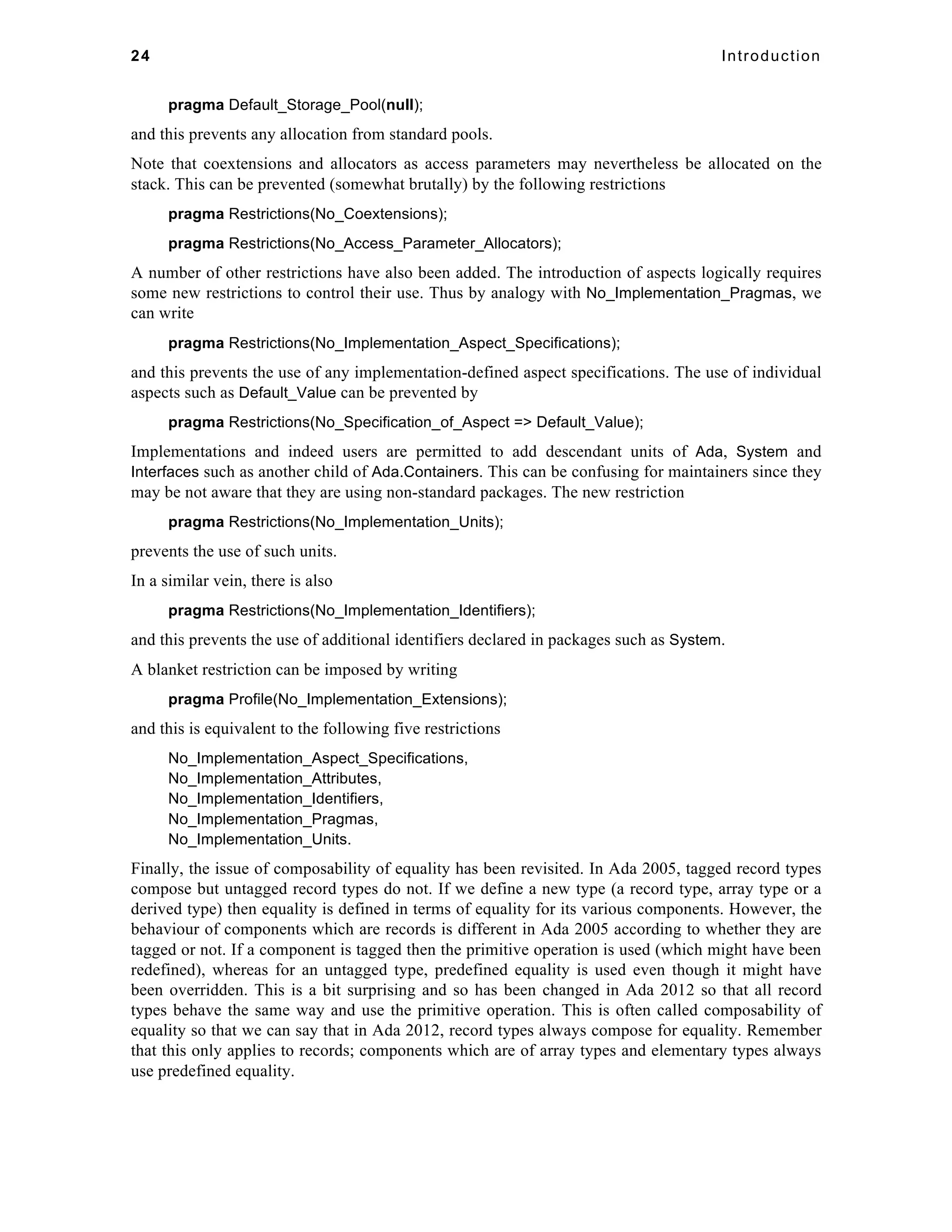
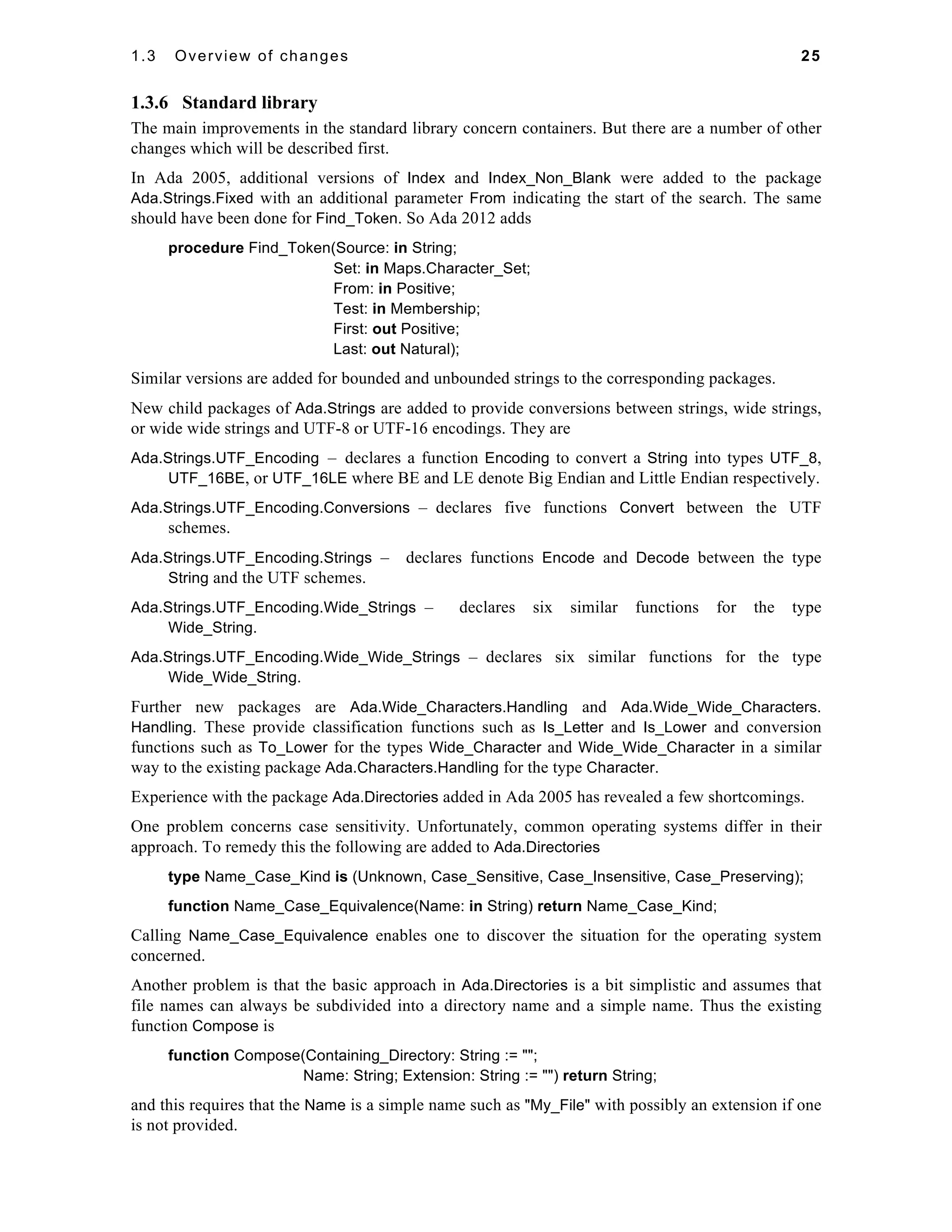
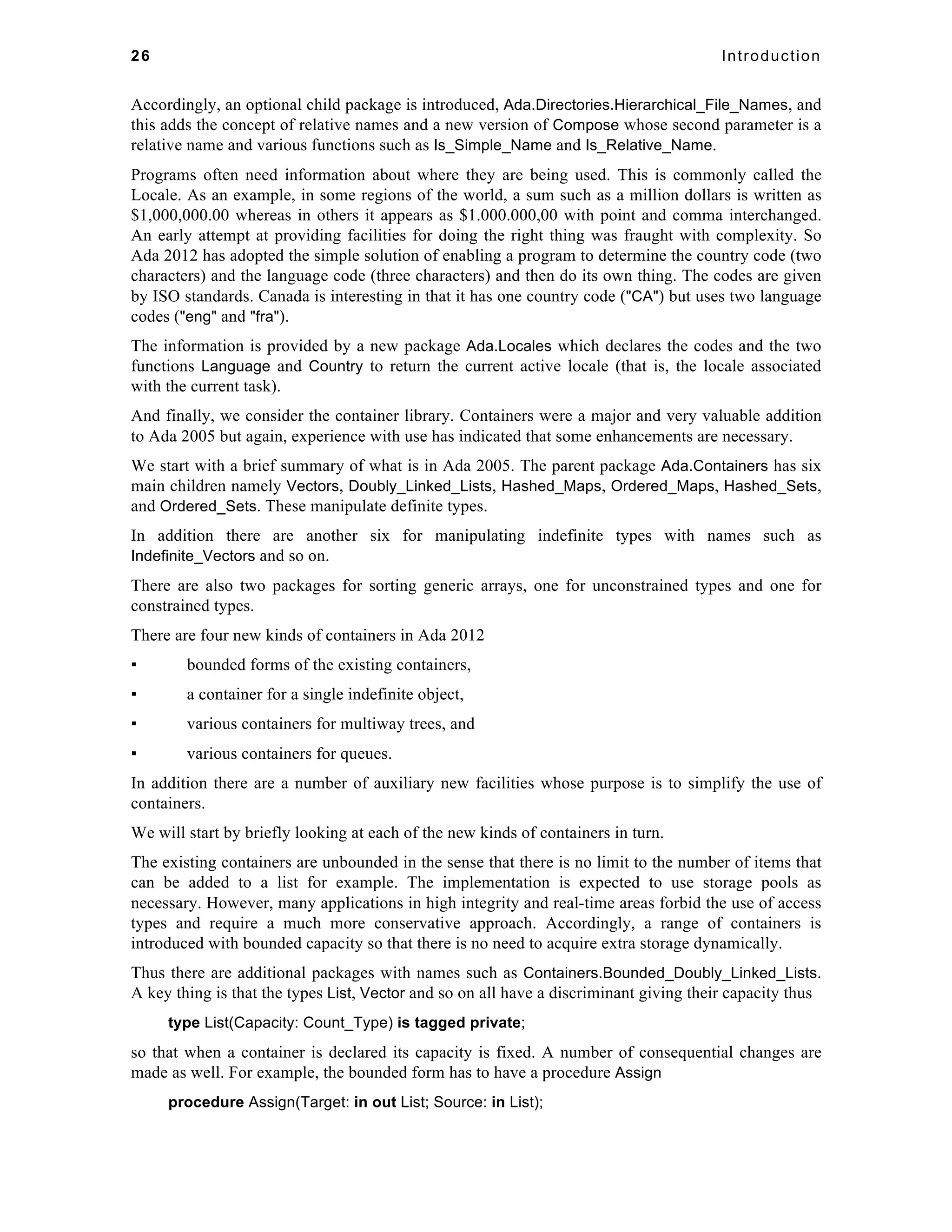
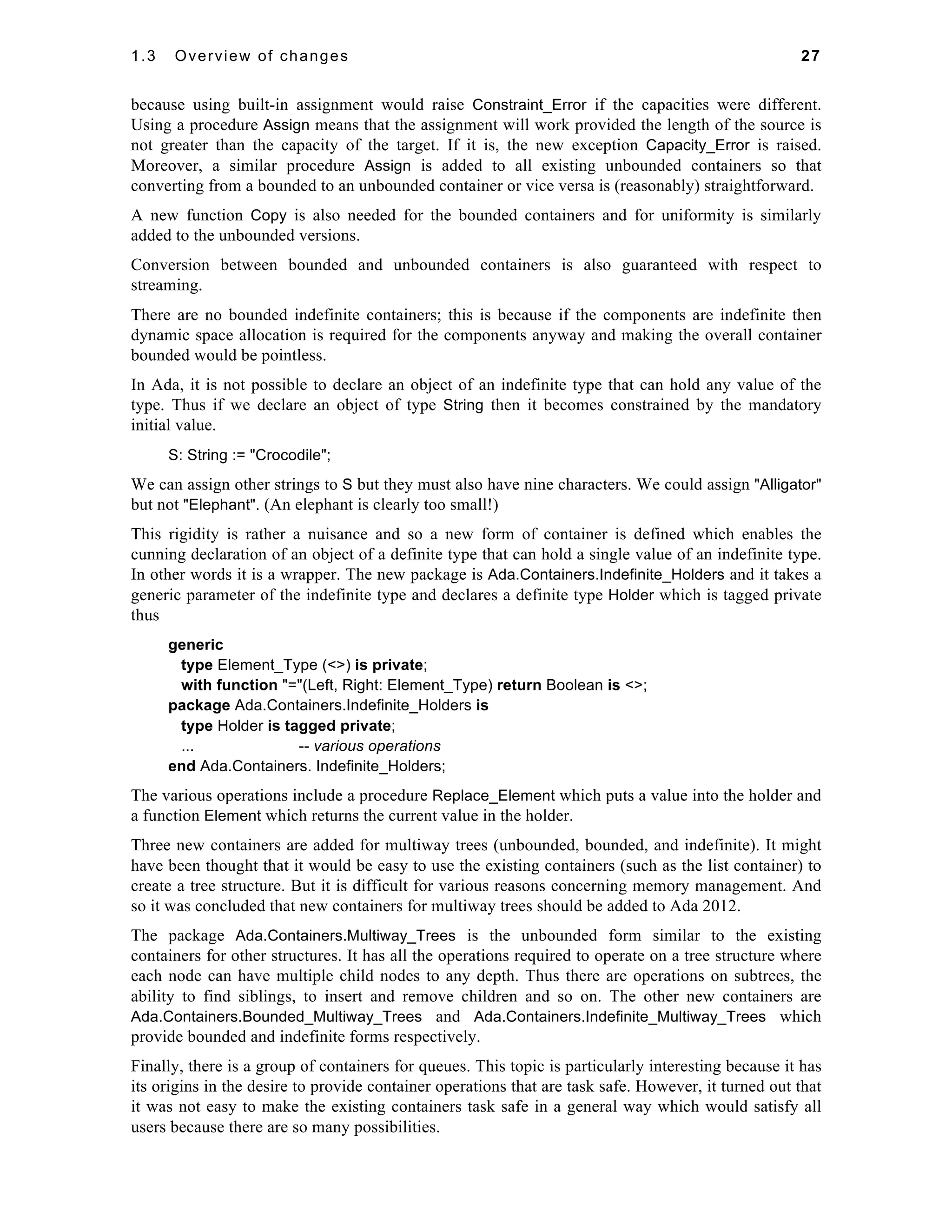
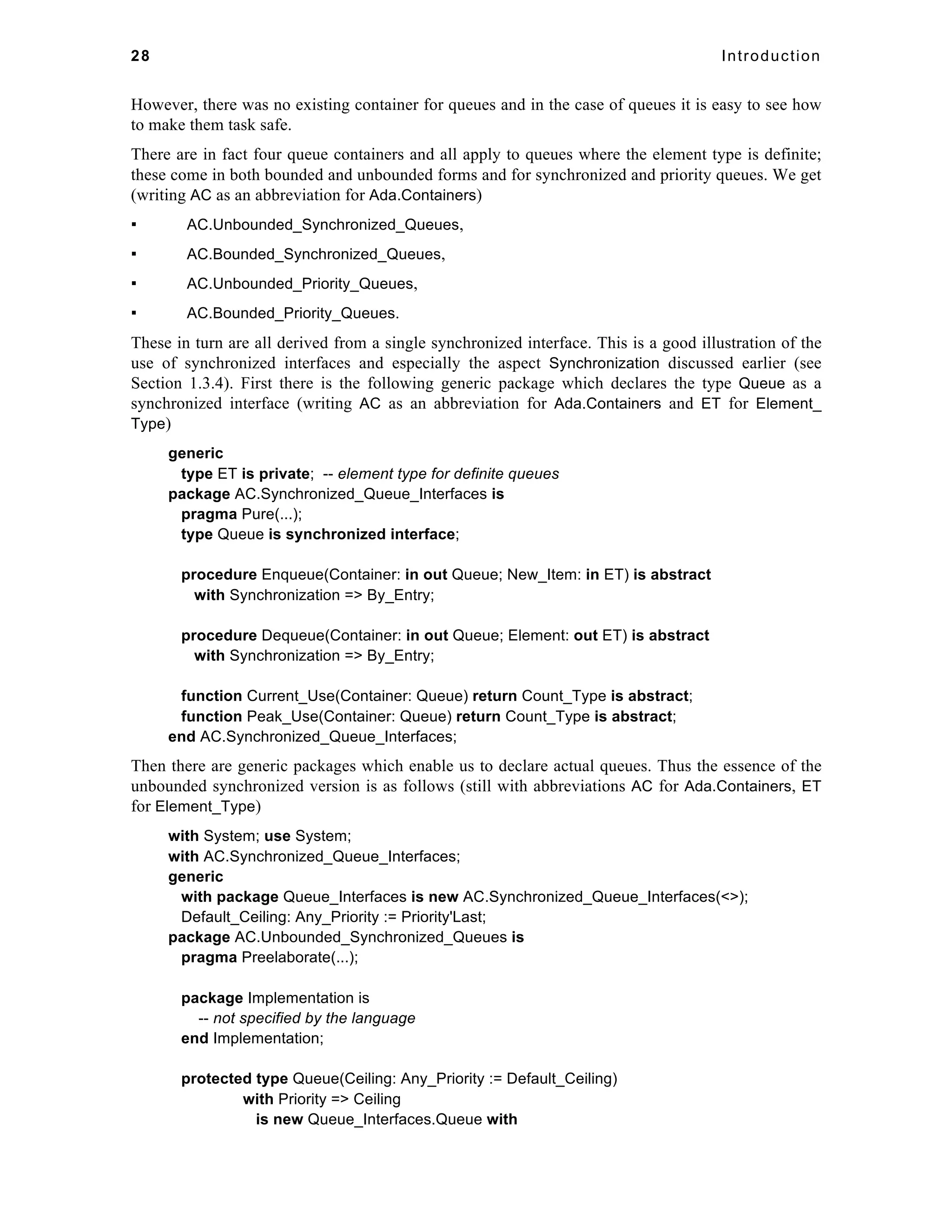
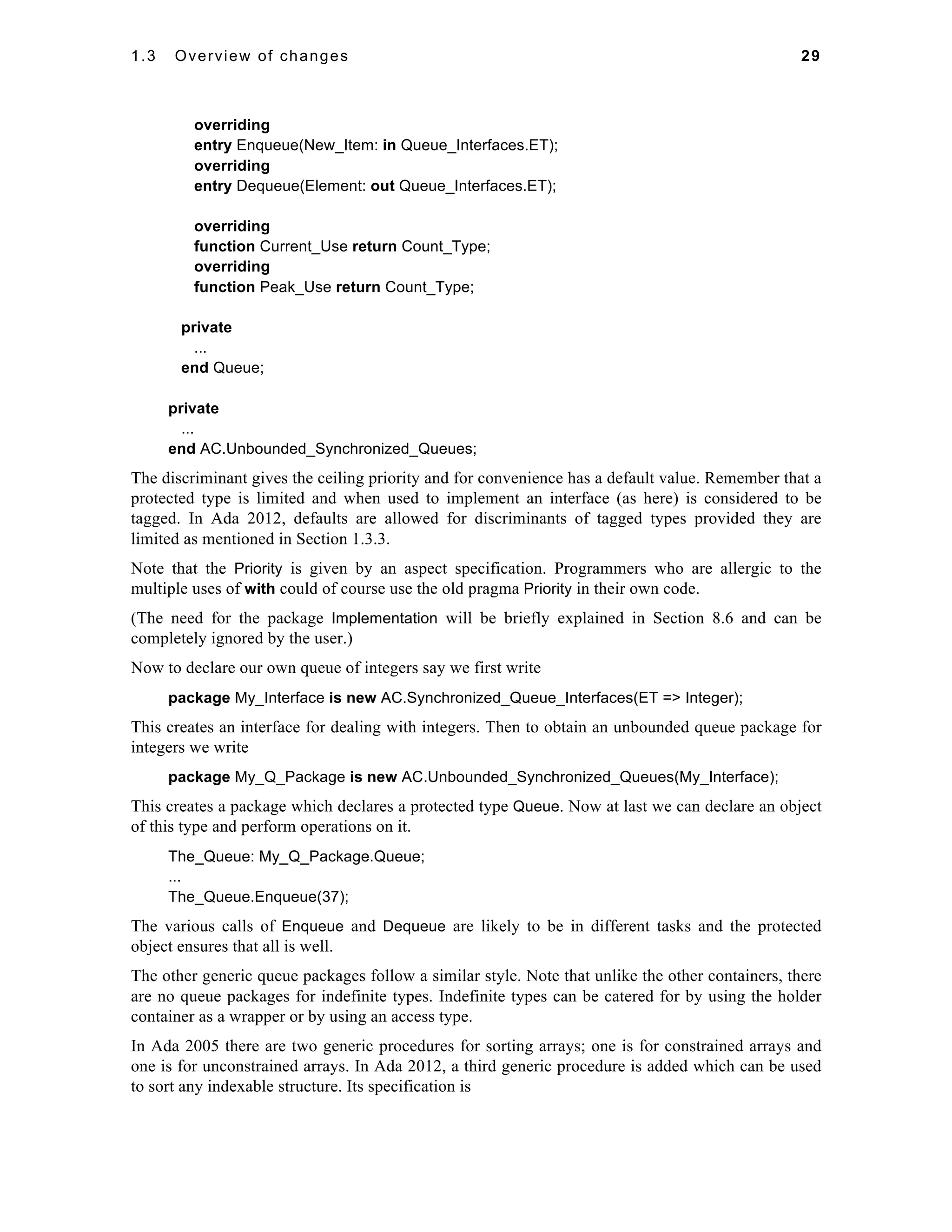
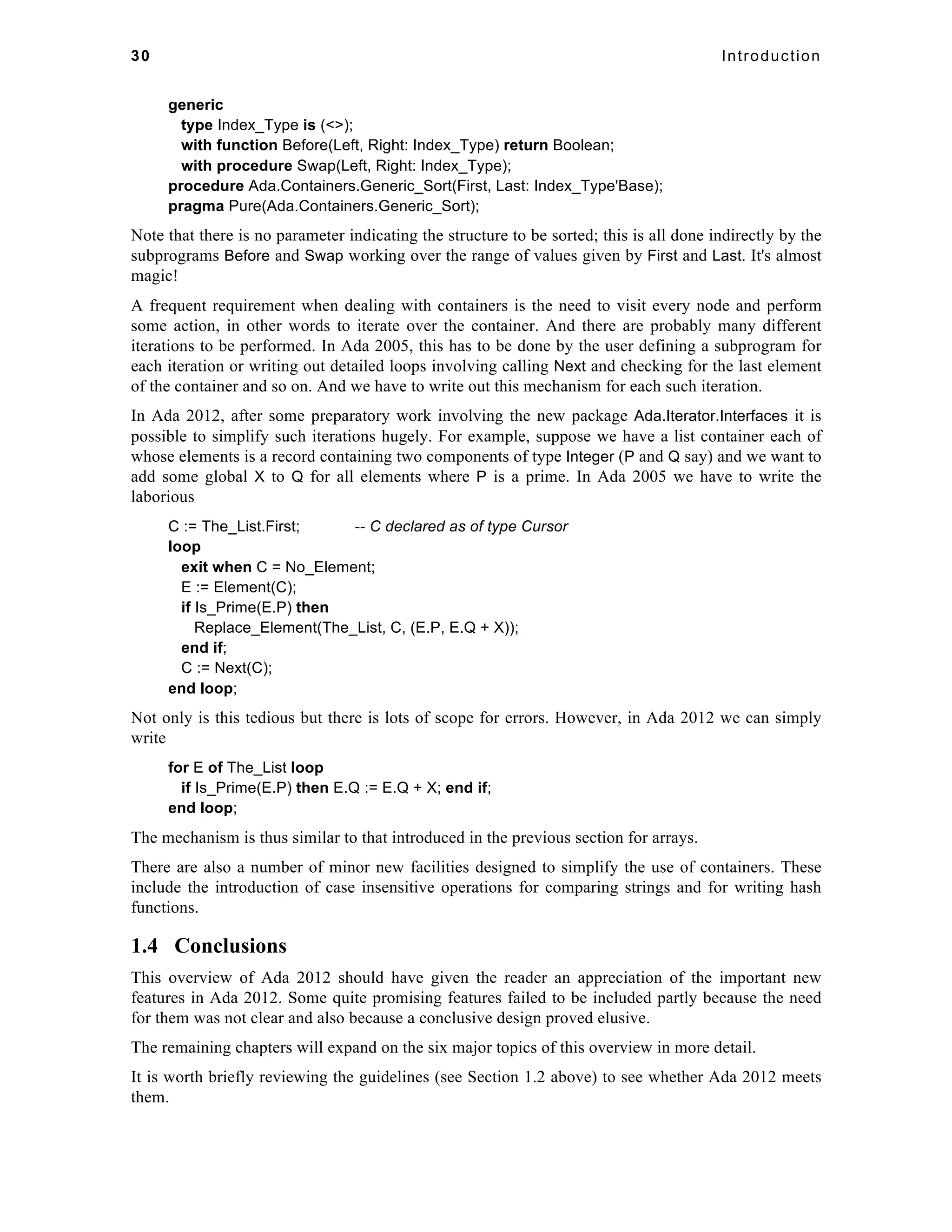


![33
2 Contracts and Aspects
This chapter describes the mechanisms for including contracts in Ada 2012.
The main feature is that preconditions and postconditions can be given for subprograms. In
addition, invariants can be given for types and predicates can be given for subtypes.
In attempting to find a satisfactory way of adding these features it was found expedient to
introduce the concept of an aspect specification for describing properties of entities in
general. It is thus convenient to describe aspect specifications in this chapter.
2.1 Overview of changes
The WG9 guidance document [1] identifies very large complex systems as a major application area
for Ada. It further identifies four areas for improvements, one of which is
Improving the ability to write and enforce contracts for Ada entities (for instance, via
preconditions).
The idea of contracts has been a cornerstone of programming for many years. The very idea of
specifying parameters for subroutines is a simple form of contract going back to languages such as
Fortran over half a century ago. More recently the idea of contracts has been brought to the fore by
languages such as SPARK and Eiffel.
SPARK is, as many readers will be aware, a subset of Ada with annotations providing assertions
regarding state embedded as Ada comments. The subset excludes features such as access types and
dynamic dispatching but it does include Ravenscar tasking and generics. The subset was chosen to
enable the contracts to be proved prior to execution. Thus SPARK is a very appropriate vehicle for
real programs that just have to be correct because of concerns of safety and security.
Eiffel, on the other hand, is a language with a range of dynamic facilities much as in Ada and has
found favour as a vehicle for education. Eiffel includes mechanisms describing contracts which are
monitored on a dynamic basis at program execution.
The goal of this amendment to Ada is to incorporate matters such as pre- and postconditions but
with the recognition that they are, like those in Eiffel, essentially for checking at runtime.
Adding pre- and postconditions and similar features has had quite a wide ranging impact on Ada and
has required much more flexibility in many areas such as the form of expressions which will be
addressed in later chapter s.
The following Ada issues cover the key changes and are described in detail in this chapter:
145 Pre- and postconditions
146 Type invariants
153 Subtype predicates
183 Aspect specifications
191 Aliasing predicates
228 Default initial values for types
229 Specifiable aspects
230 Inheritance of null procedures with precondition
243 Clarification of categorization](https://image.slidesharecdn.com/ada2012rationale-141002094233-phpapp01/75/Ada2012-Rationale-43-2048.jpg)
![34 Contracts and aspects
247 Preconditions, postconditions, multiple inheritance and dispatching calls
250 Thoughts on type invariants
254 Do we really have contracts right?
267 Improvements for aspect specifications
287 Some questions on subtype predicates
289 Invariants and in mode parameters
297 First_Valid and Last_Valid attributes
These changes can be grouped as follows.
First we lay the syntactic foundations necessary to introduce features such as preconditions by
discussing aspect specifications which essentially replace or provide an alternative to pragmas for
specifying many features (183, 229, 243, 267).
Then we discuss the introduction of pre- and postconditions on subprograms including the problems
introduced by multiple inheritance (145, 230, 247, 254).
Two other related topics are type invariants and subtype predicates which provide additional means
of imposing restrictions on types (146, 153, 250, 287, 289, 297).
Finally, two auxiliary features are the ability to provide default values for scalar types and array
types (228) and means of checking that aliasing does not occur between two objects (191).
2.2 Aspect specifications
Although in a sense the introduction of aspect specifications is incidental to the main themes of Ada
2012 which are contracts, real-time, and containers, the clarity (and some might say upheaval)
brought by aspect specifications merits their description first.
An early proposal to introduce preconditions was by the use of pragmas. Thus to give a precondition
not Is_Full to the usual Push procedure acting on a stack S and a corresponding postcondition not
Is_Empty, it was proposed that this should be written as
pragma Precondition(Push, not Is_Full(S));
pragma Postcondition(Push, not Is_Empty(S));
But this looks ugly and is verbose since it mentions Push in both pragmas. Moreover, potential
problems with overloading means that it has to be clarified to which procedure Push they apply if
there happen to be several. As a consequence it was decreed that the pragmas had to apply to the
immediately preceding subprogram. Which of course is not the case with pragma Inline which with
overloading applies to all subprograms with the given name. Other curiosities include the need to
refer to the formal parameters of Push (such as S) so that the expression has to be resolved taking
heed of these even though it is detached from the actual specification of Push.
Other pragmas proposed were Inherited_Precondition and Inherited_Postcondition for use with
dispatching subprograms.
So it was a mess and an alternative was sought. The solution which evolved was to get away from
wretched pragmas in such circumstances. Indeed, the Ada 83 Rationale [6] says "In addition, a
program text can include elements that have no influence on the meaning of the program but are
included as information and guidance for the human reader or for the compiler. These are:
Comments; Pragmas..."](https://image.slidesharecdn.com/ada2012rationale-141002094233-phpapp01/75/Ada2012-Rationale-44-2048.jpg)
![2.2 Aspect specifications 35
So pragmas were meant to have no effect on the meaning of the program. Typical pragmas in Ada
83 were List, Inline, Optimize and Suppress. But in later versions of Ada, pragmas are used for all
sorts of things. The days when pragmas had no effect are long gone!
The basic need was to tie the pre- and postconditions syntactically to the specification of Push so
that there could be no doubt as to which subprogram they applied; this would also remove the need
to mention the name of the subprogram again. And so, as described in the Introduction, we now
have
procedure Push(S: in out Stack; X: in Item)
with
Pre => not Is_Full(S),
Post => not Is_Empty(S);
The syntax for aspect specification is
aspect_specification ::=
with aspect_mark [ => expression] { ,
aspect_mark [ => expression] }
and this can be used with a variety of structures, subprogram declaration being the example here.
Note especially the use of the reserved word with. Serious attempts were made to think of another
word so as to avoid using with again but nothing better was suggested. It might be thought that it
would be confusing to use with which is firmly associated with context clauses. However, recall that
with has also been used to introduce generic formal subprogram parameters without causing
confusion since 1983. Thus
generic
with function This ...
procedure That ...
Moreover, Ada 95 introduced the use of with for type extension as in
type Circle is new Object with
record
Radius: Float;
end record;
So in Ada 95 there were already many distinct uses of with and another one will surely do no harm.
It's a versatile little word.
Any risk of confusion is easily avoided by using a sensible layout. Thus a with clause should start
on a new line at the left and aligned with the following unit to which it applies. A formal generic
parameter starting with with should be aligned with other formal parameters and indented after the
word generic. In the case of type extension, with should be at the end of the line. Finally, in the case
of aspect specifications, with should be at the beginning of a line and indented after the entity to
which it applies.
Having introduced aspect specifications which are generally so much nicer than pragmas, it was
decided to allow aspect specifications for all those situations where pragmas are used and an aspect
specification makes sense (typically where it applies to an entity rather than a region of text). And
then to make most of the pragmas obsolete.
Before looking at the old pragmas concerned in detail, two general points are worth noting.
The usual linear elaboration rules do not apply to the expression in an aspect specification. It is
essentially sorted out at the freezing point of the entity to which the aspect applies. The reason for
this was illustrated by an example in the Introduction which was](https://image.slidesharecdn.com/ada2012rationale-141002094233-phpapp01/75/Ada2012-Rationale-45-2048.jpg)
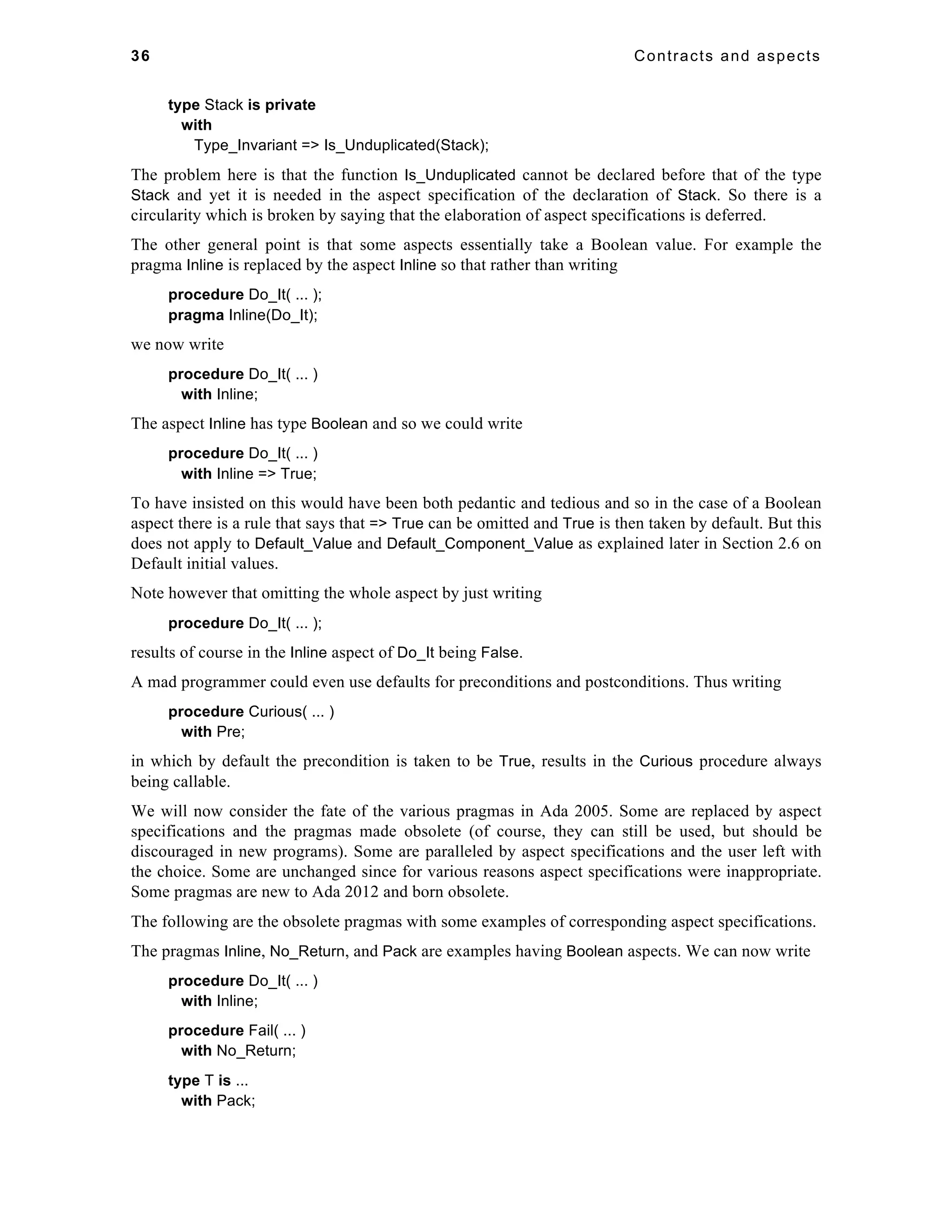
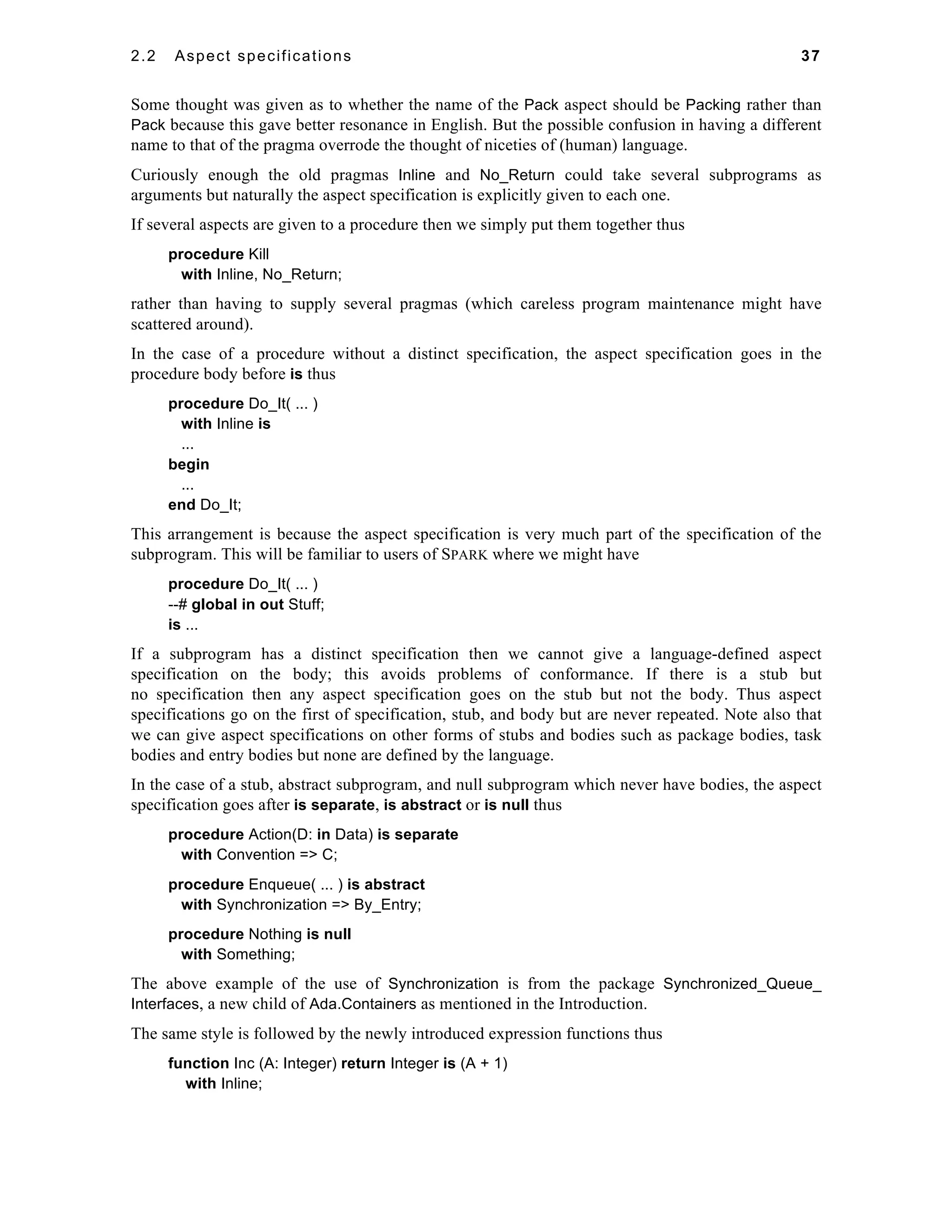
![38 Contracts and aspects
Other examples of Boolean aspects are Atomic, Volatile, and Independent. We now write for
example
Converged: Boolean := False
with Atomic;
The aspects Atomic_Components, Volatile_Components and Independent_Components are similar.
The three pragmas Convention, Import and Export are replaced by five aspects, namely Import,
Export, Convention, External_Name and Link_Name.
For example, rather than, (see [8] page 702)
type Response is access procedure (D: in Data);
pragma Convention(C, Response);
procedure Set_Click(P: in Response);
pragma Import(C, Set_Click);
procedure Action(D: in Data) is separate;
pragma Convention(C, Action);
we now more neatly write
type Response is access procedure (D: in Data)
with Convention => C;
procedure Set_Click(P: in Response)
with Import, Convention => C;
procedure Action(D: in Data) is separate
with Convention => C;
Note that the aspects can be given in any order whereas in the case of pragmas, the parameters had
to be in a particular order. We could have written with Import => True but that would have been
pedantic. As another example (see the RM 7.4), instead of
CPU_Identifier: constant String(1 .. 8);
pragma Import(Assembler, CPU_Identifier, Link_Name => "CPU_ID");
we now have
CPU_Identifier: constant String(1 .. 8)
with Import, Convention => Assembler, Link_Name => "CPU_ID";
Observe that we always have to give the aspect name such as Convention whereas with pragmas
Import and Export, the parameter name Convention was optional. Clearly it is better to have to give
the name.
The pragma Controlled which it may be recalled told the system to keep its filthy garbage collector
off my nice access type is plain obsolete and essentially abandoned. It is doubted whether it was
ever used. The subclause of the RM (13.11.3) relating to this pragma is now used by a new pragma
Default_Storage_Pools which will be discussed in Section 6.4 on Access types and storage pools.
The pragma Unchecked_Union is another example of a pragma replaced by a Boolean aspect. So we
now write
type Number(Kind: Precision) is
record
...](https://image.slidesharecdn.com/ada2012rationale-141002094233-phpapp01/75/Ada2012-Rationale-48-2048.jpg)
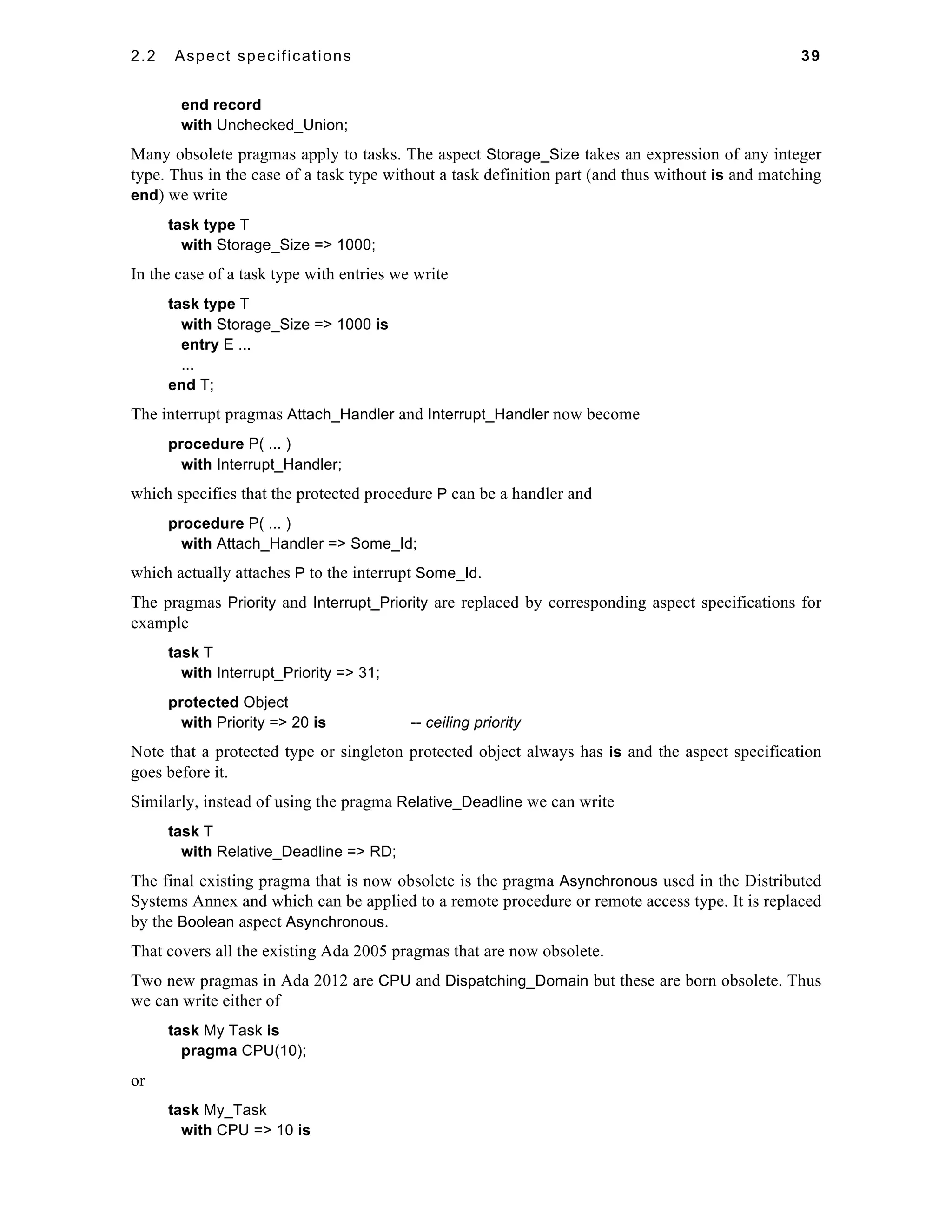
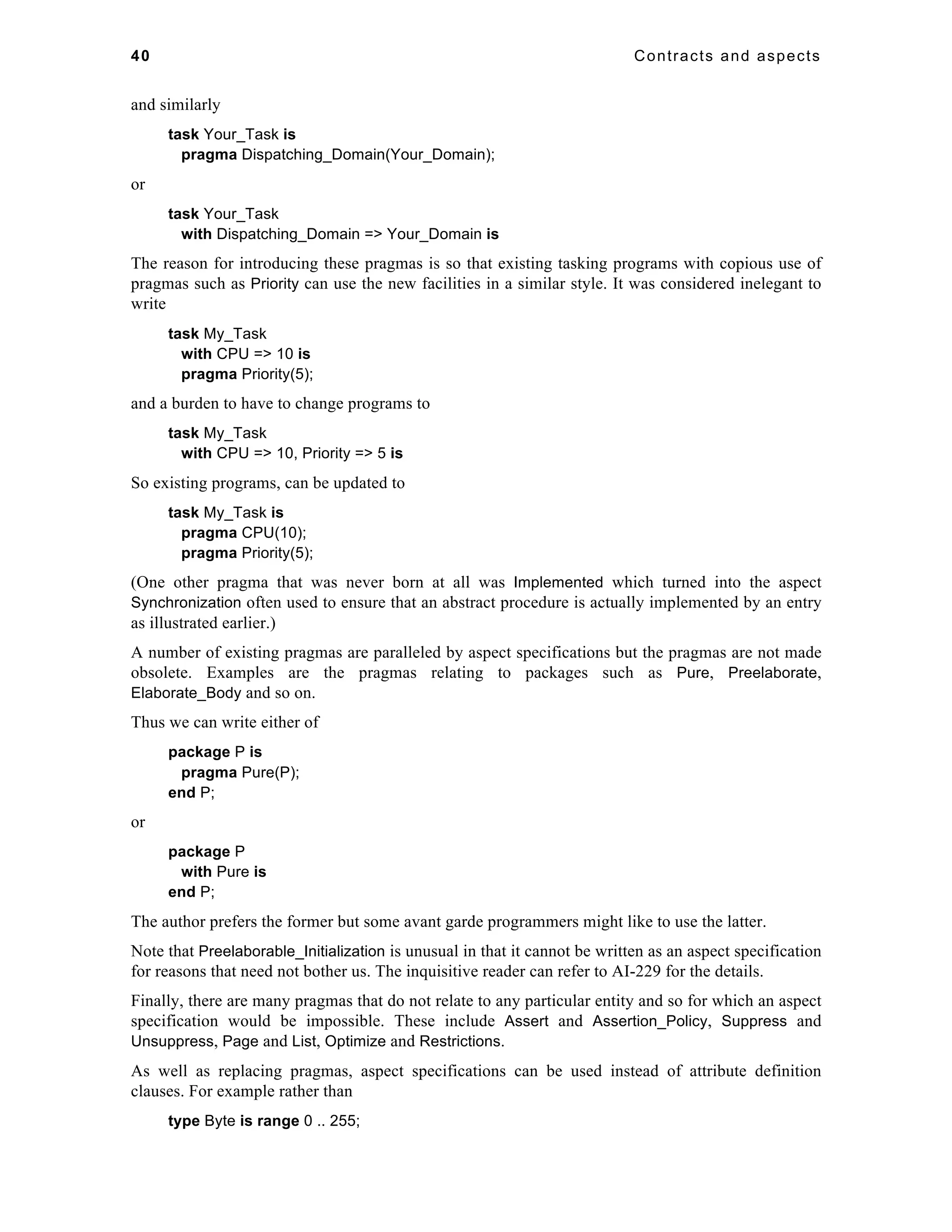
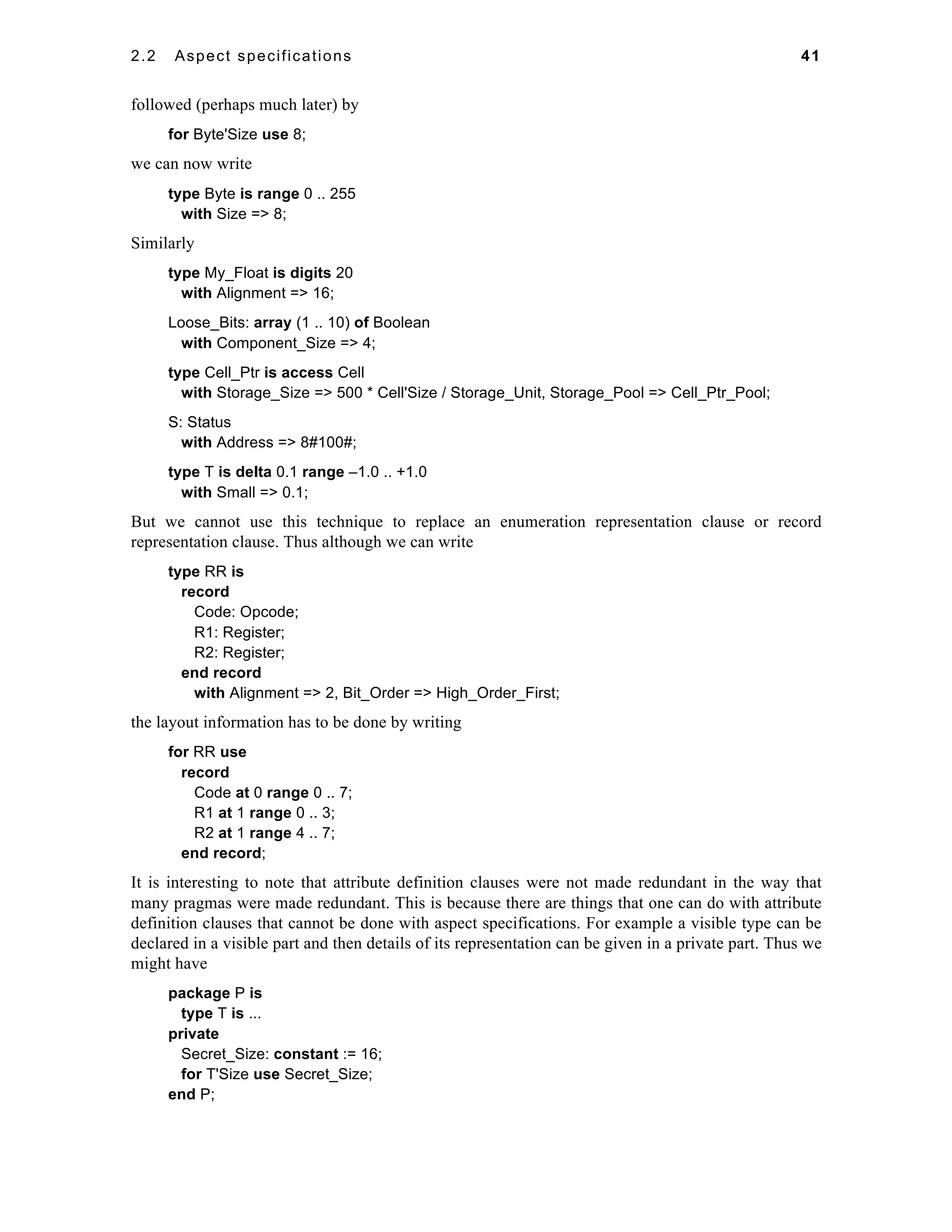
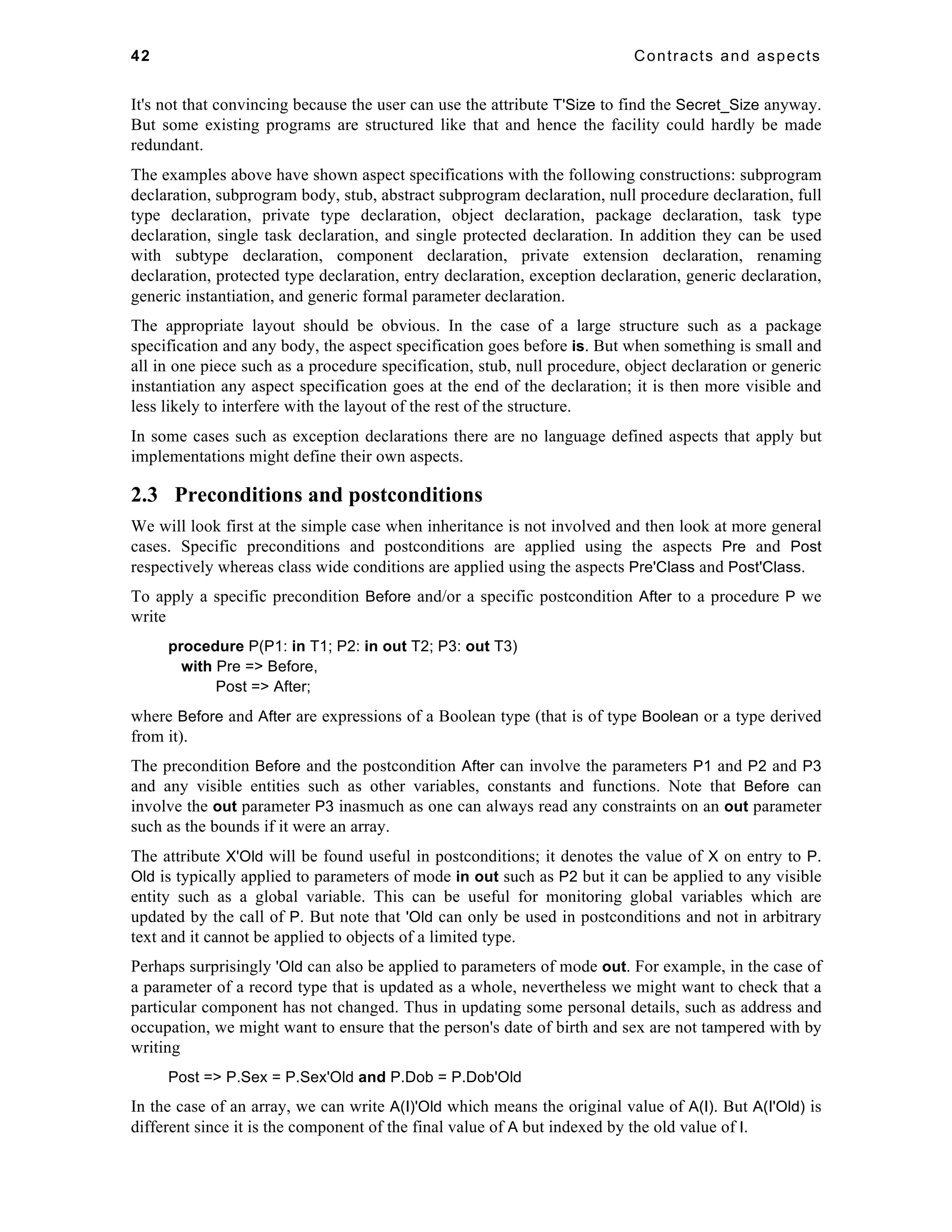
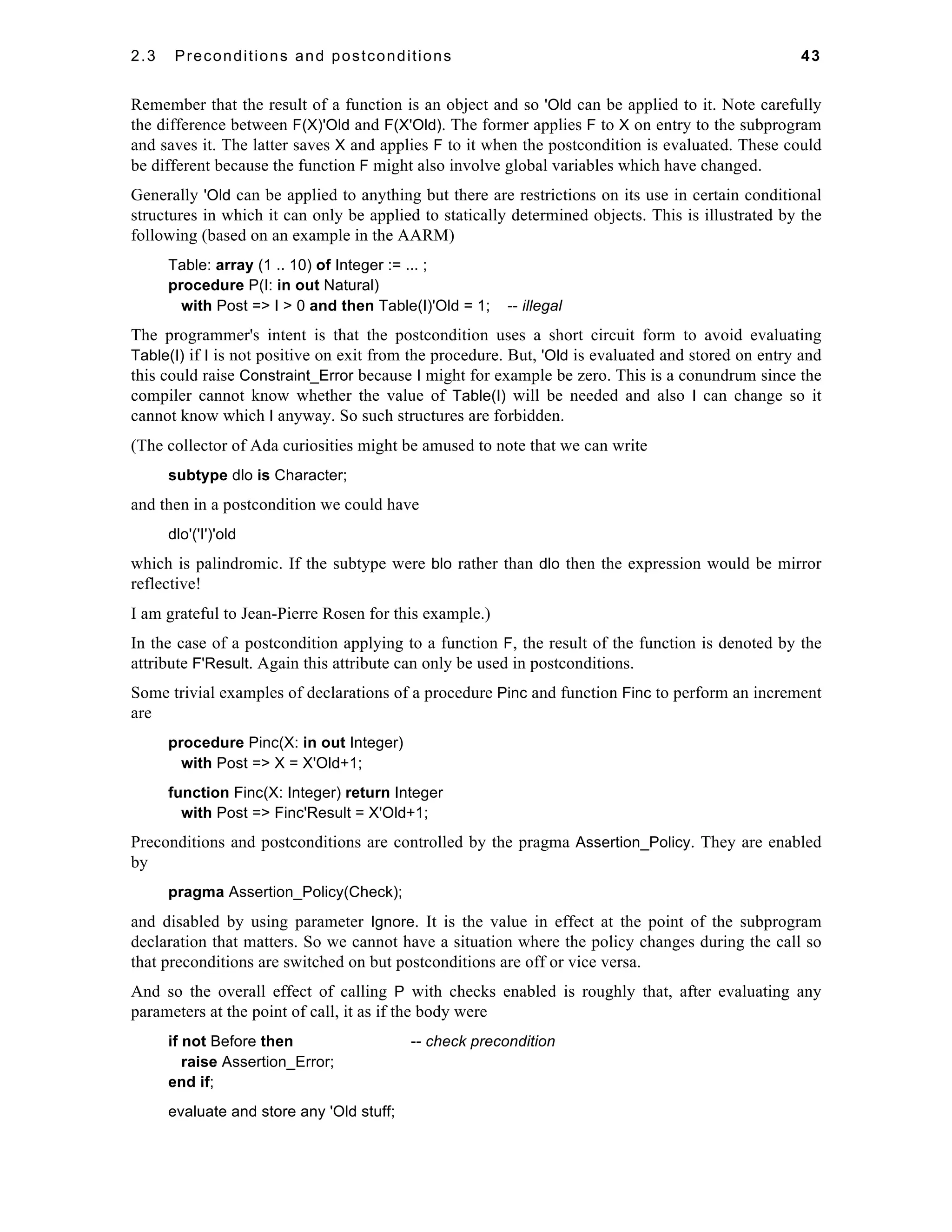
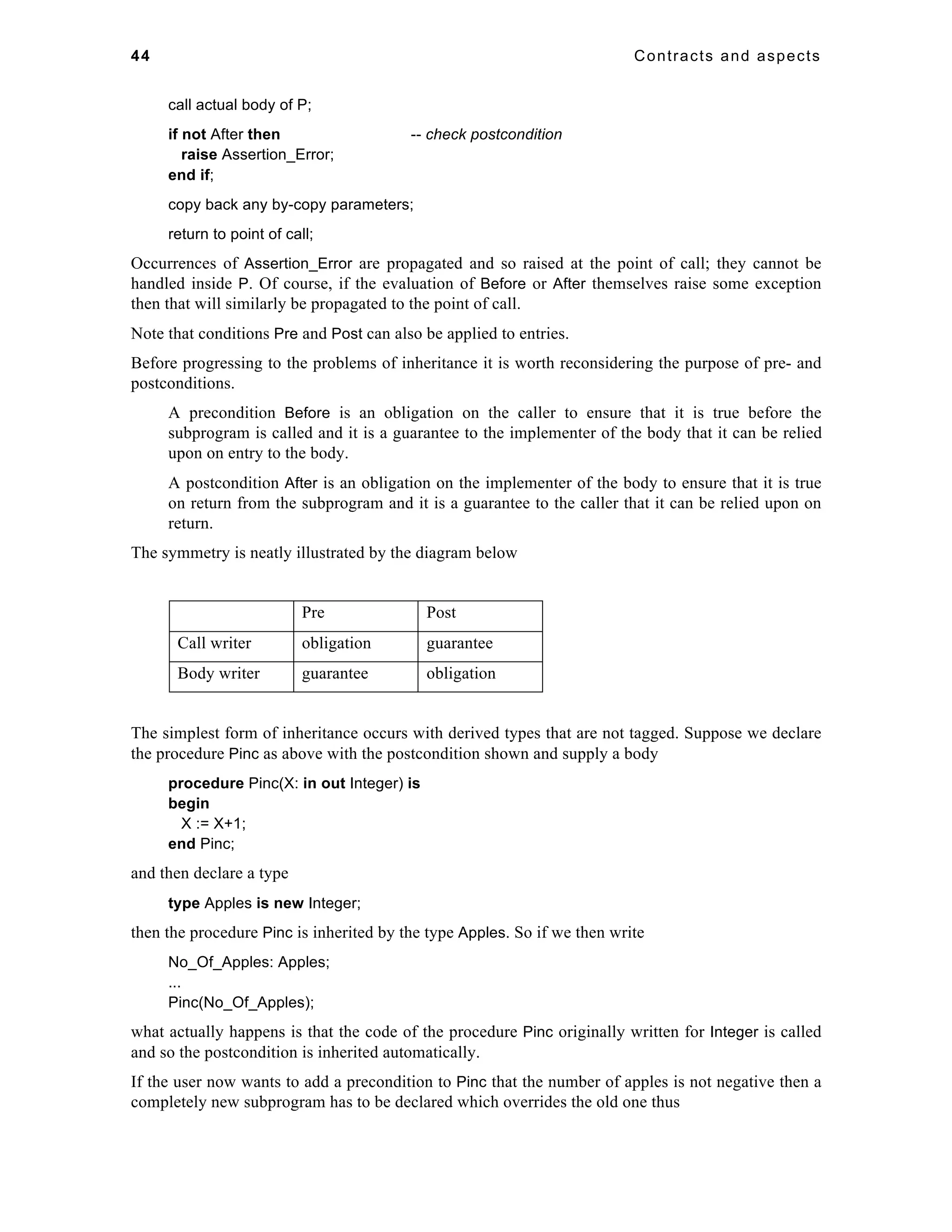
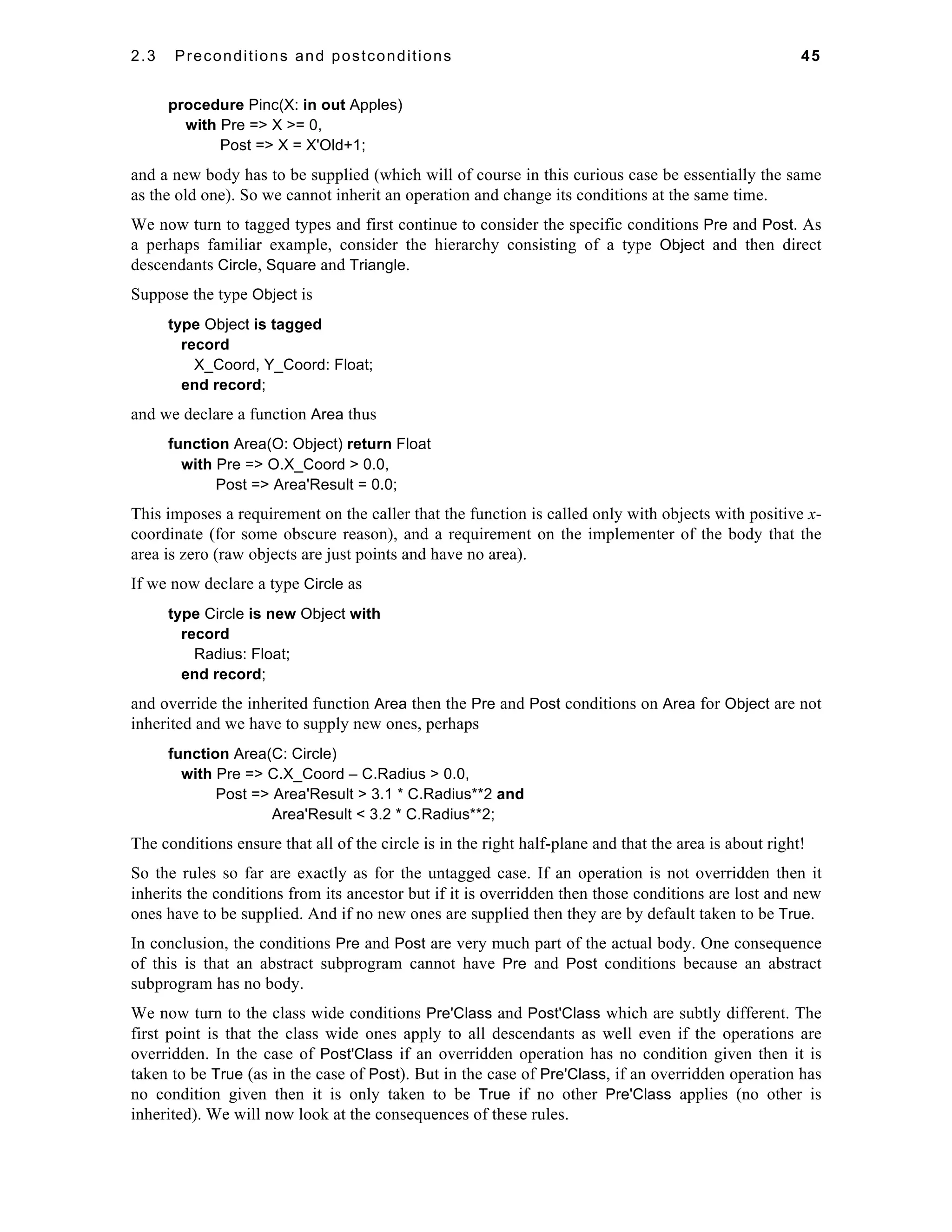
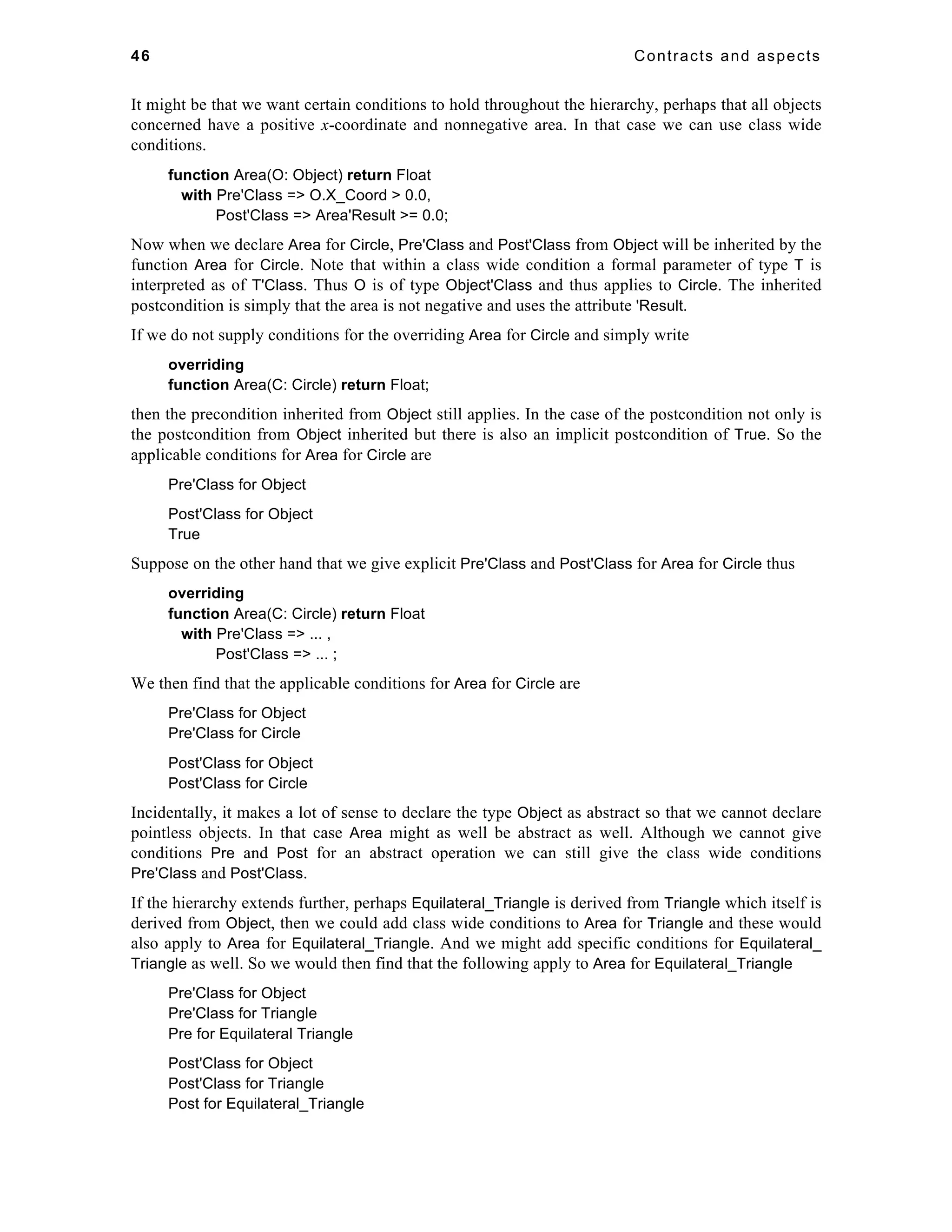

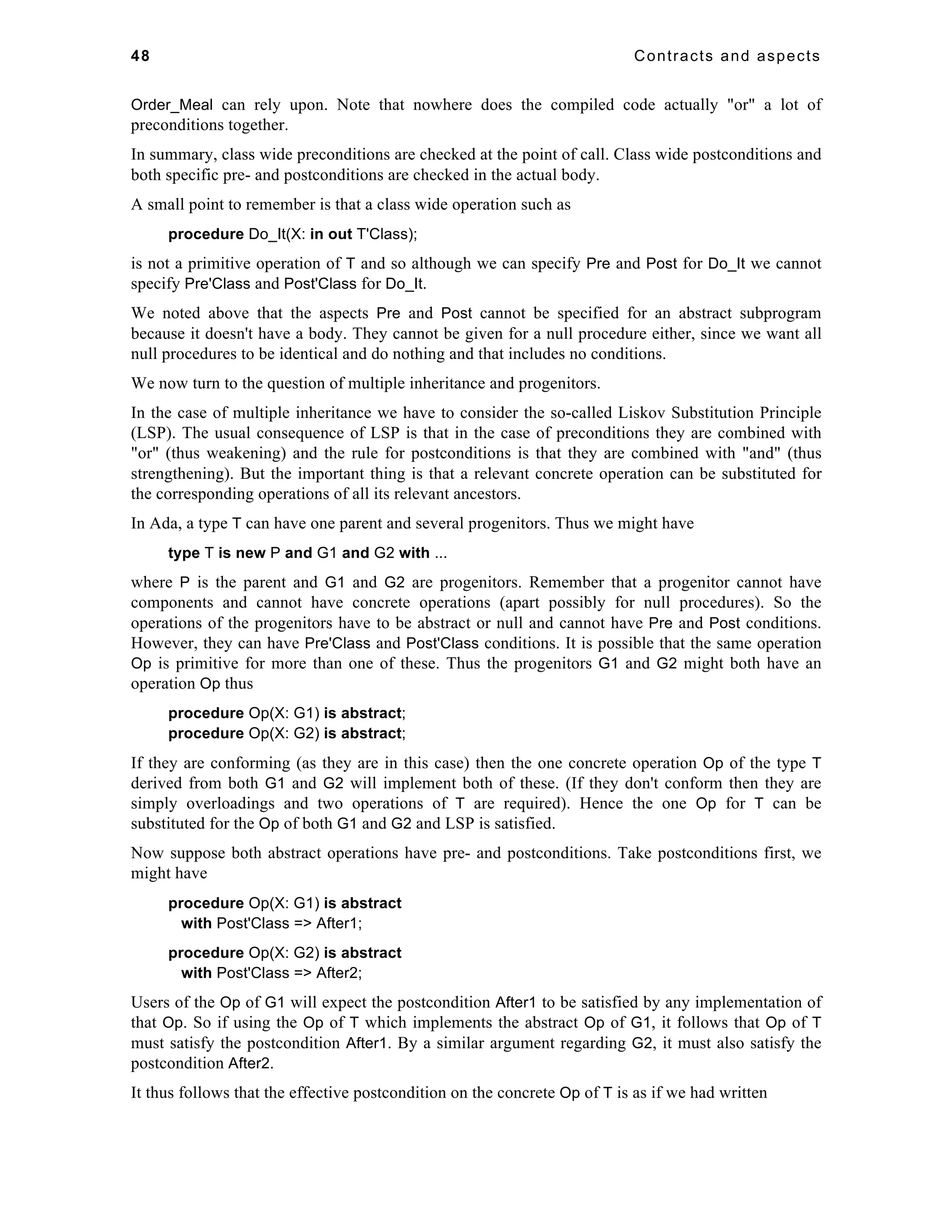

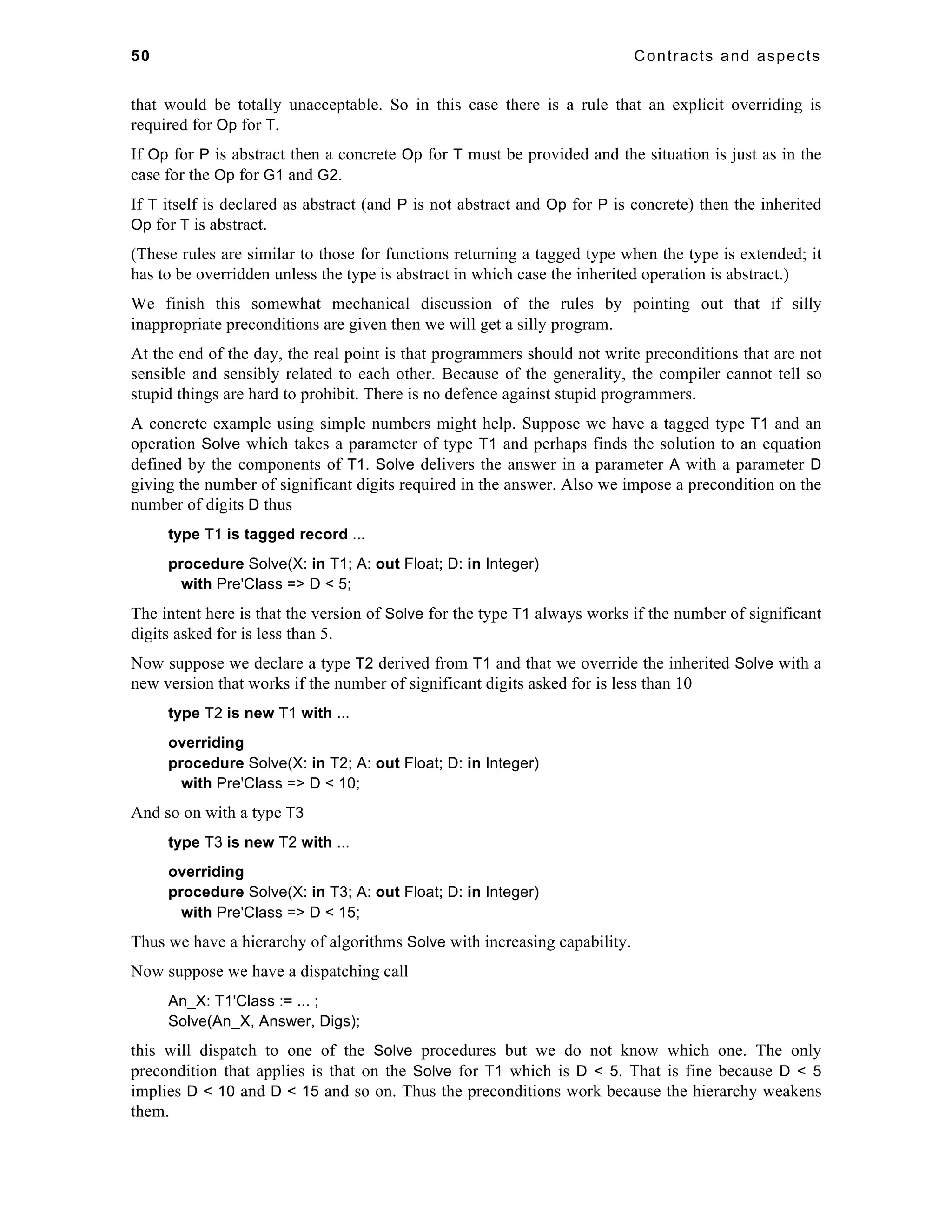
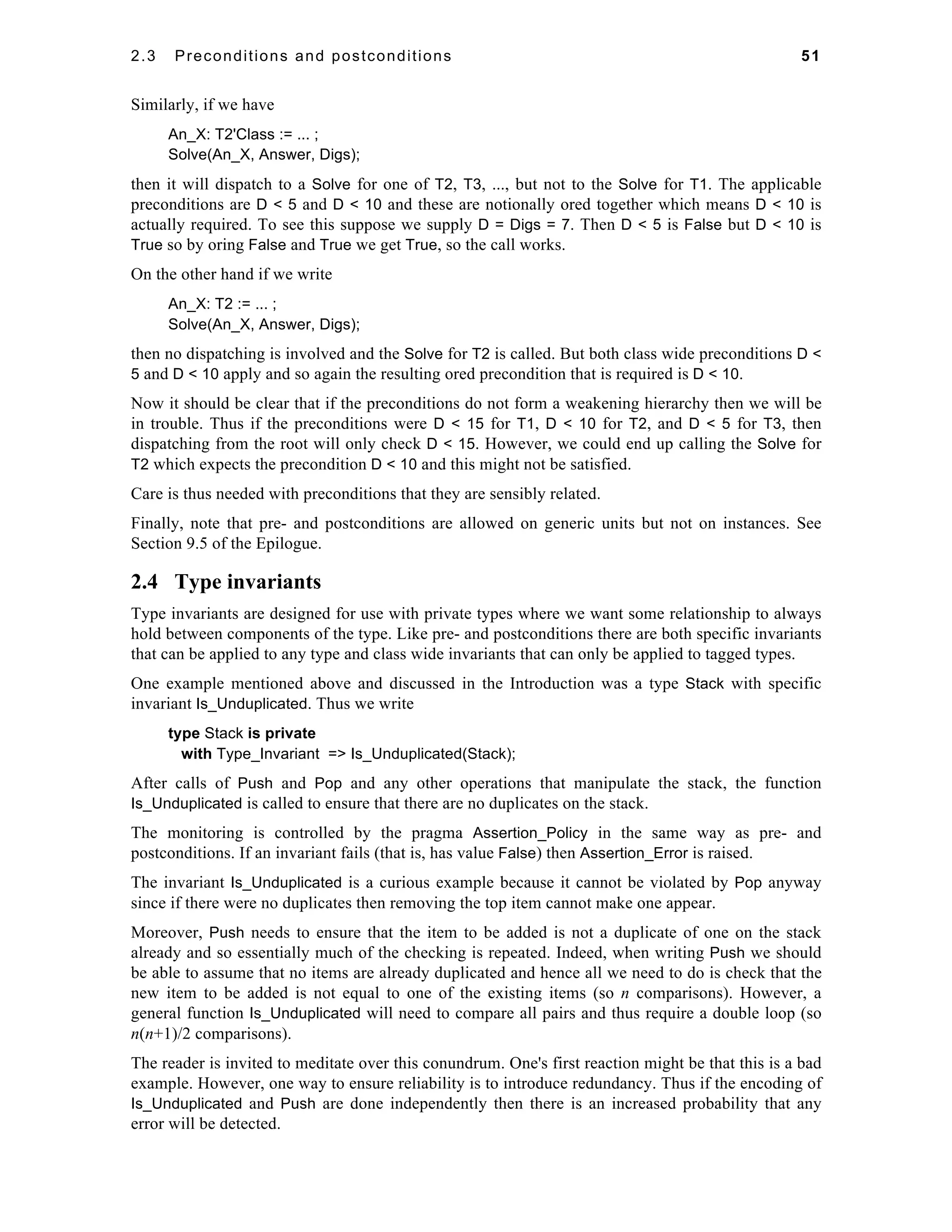

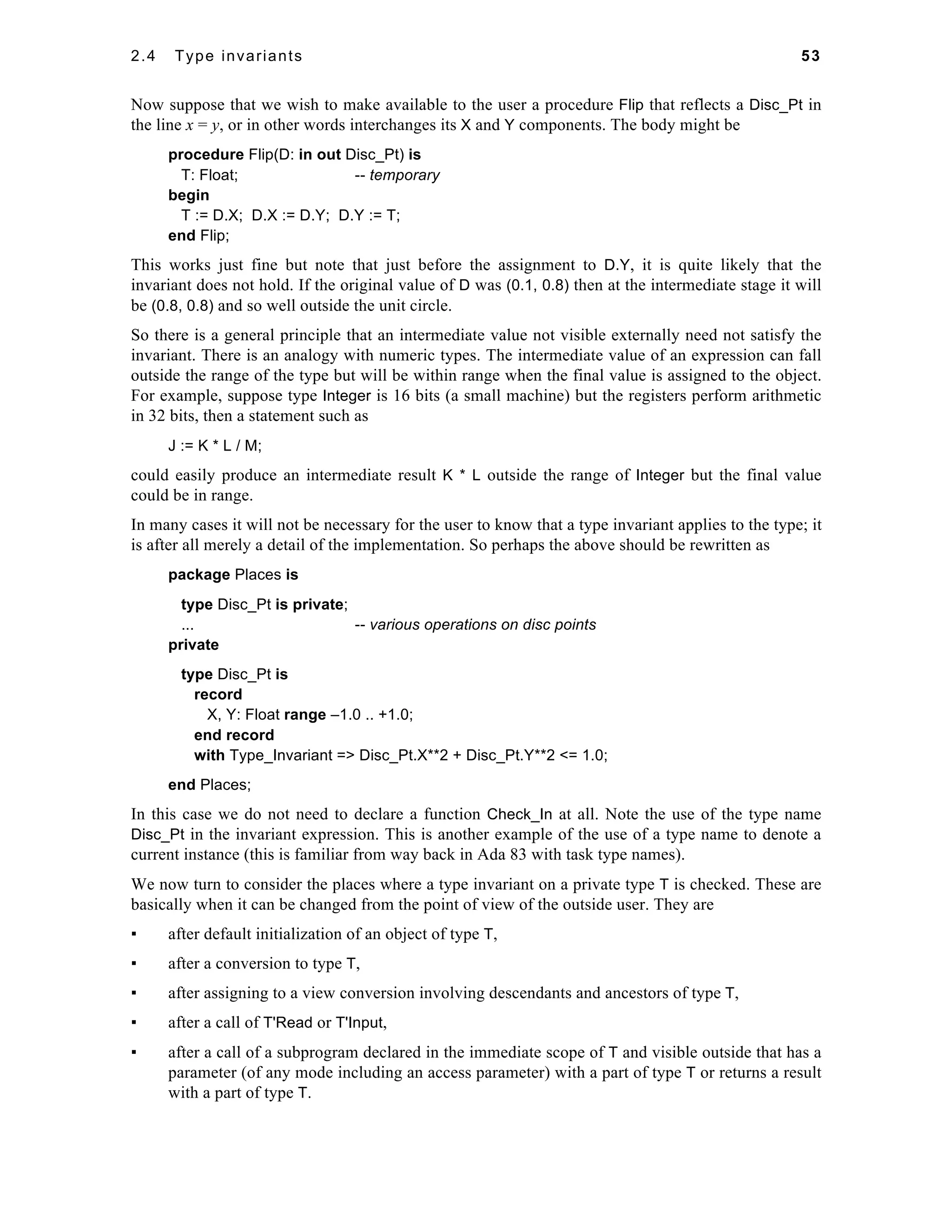

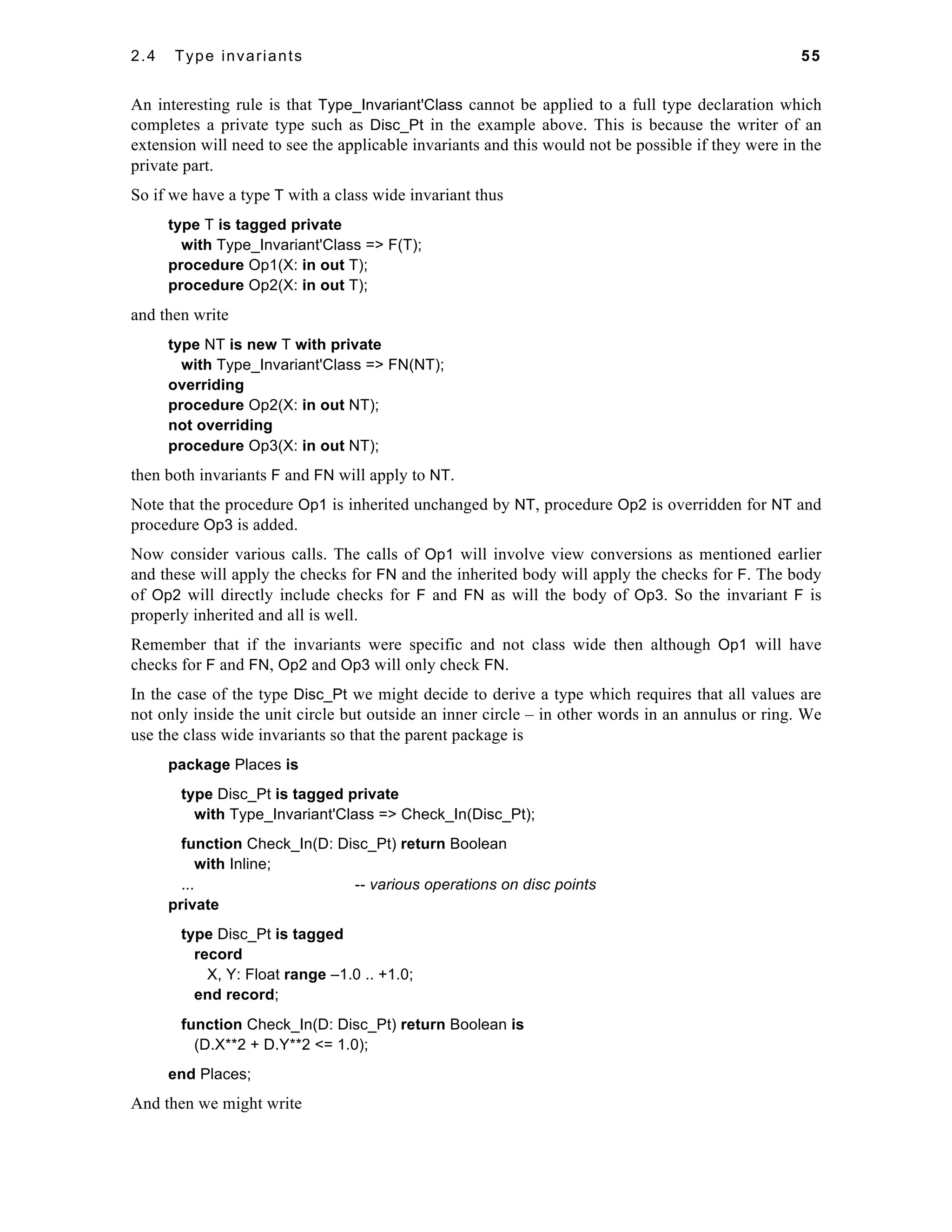
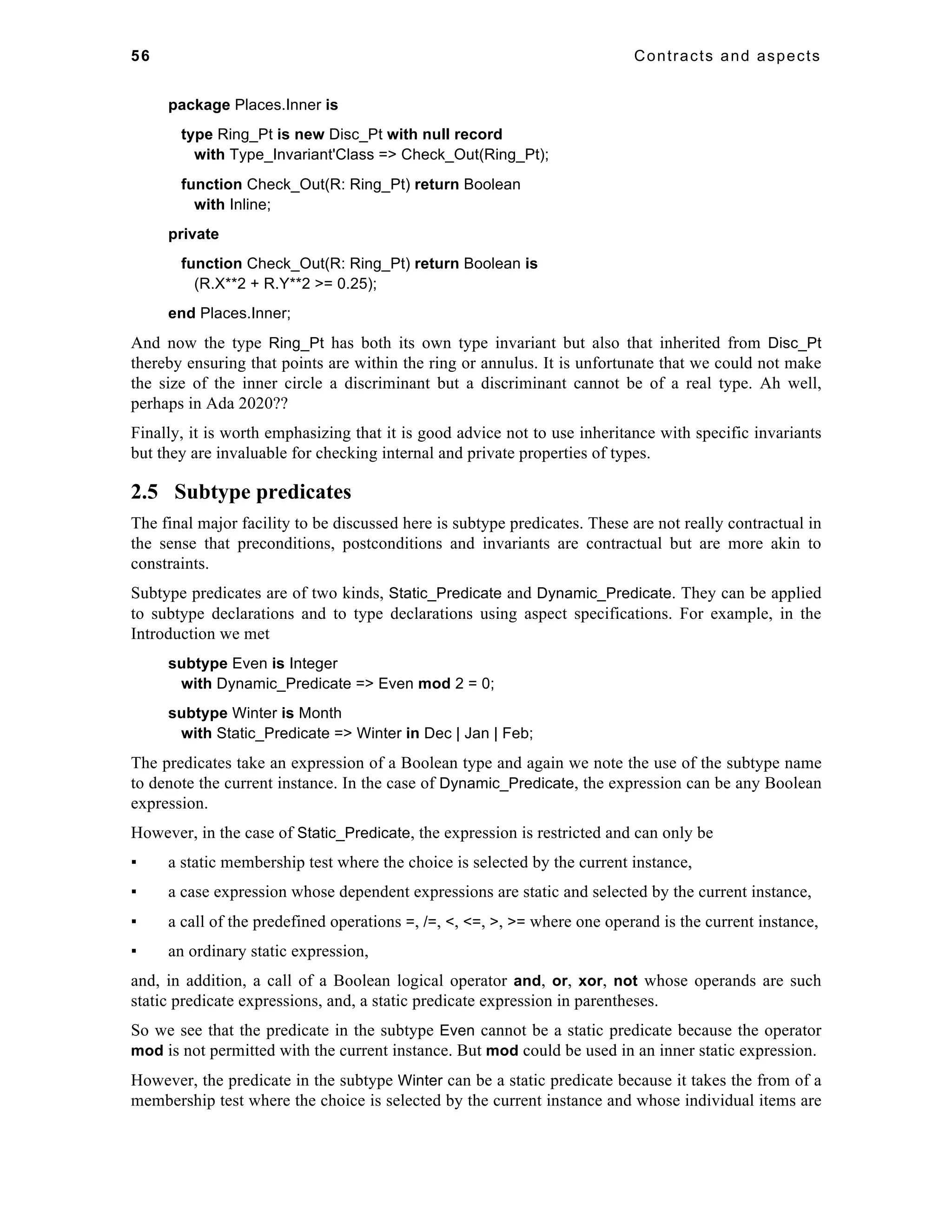
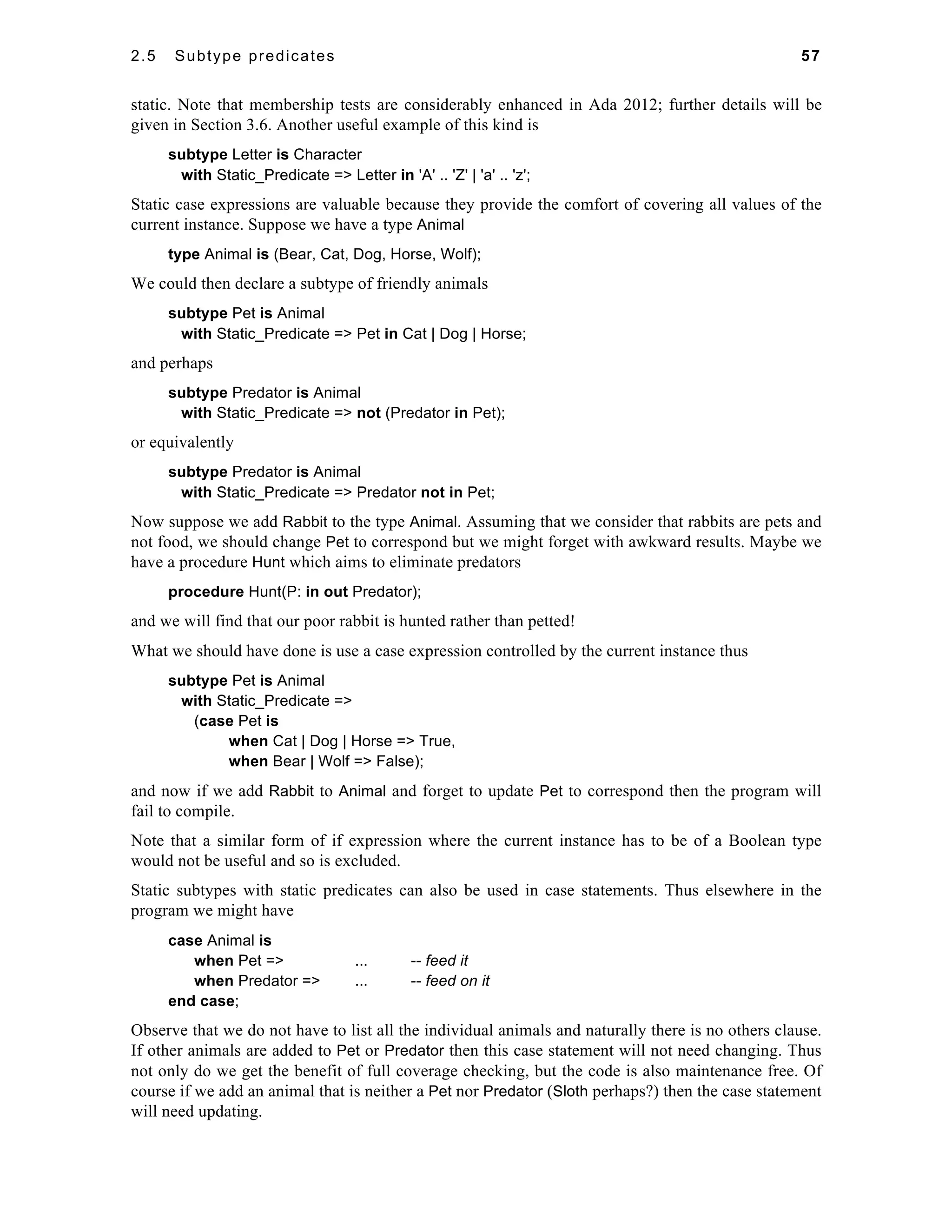

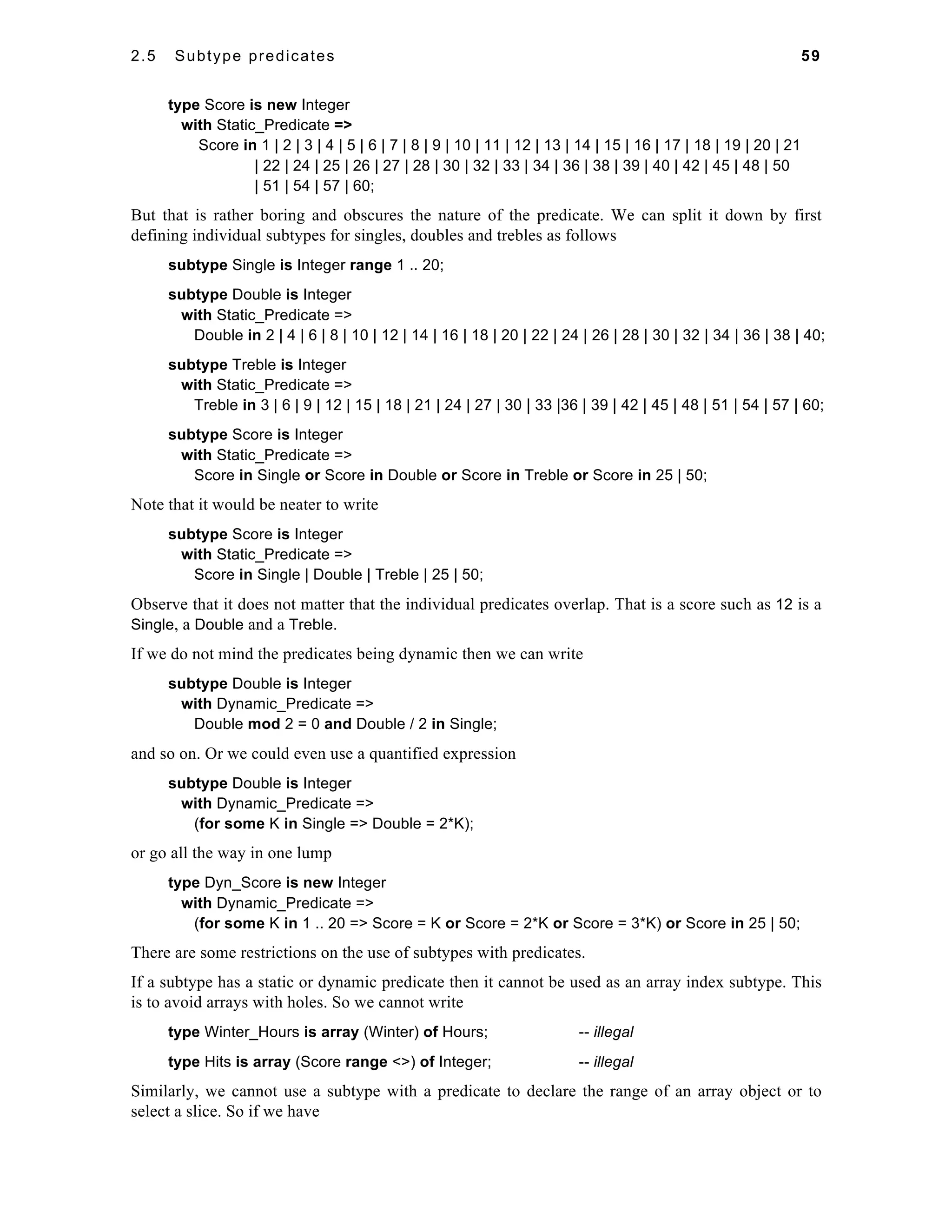
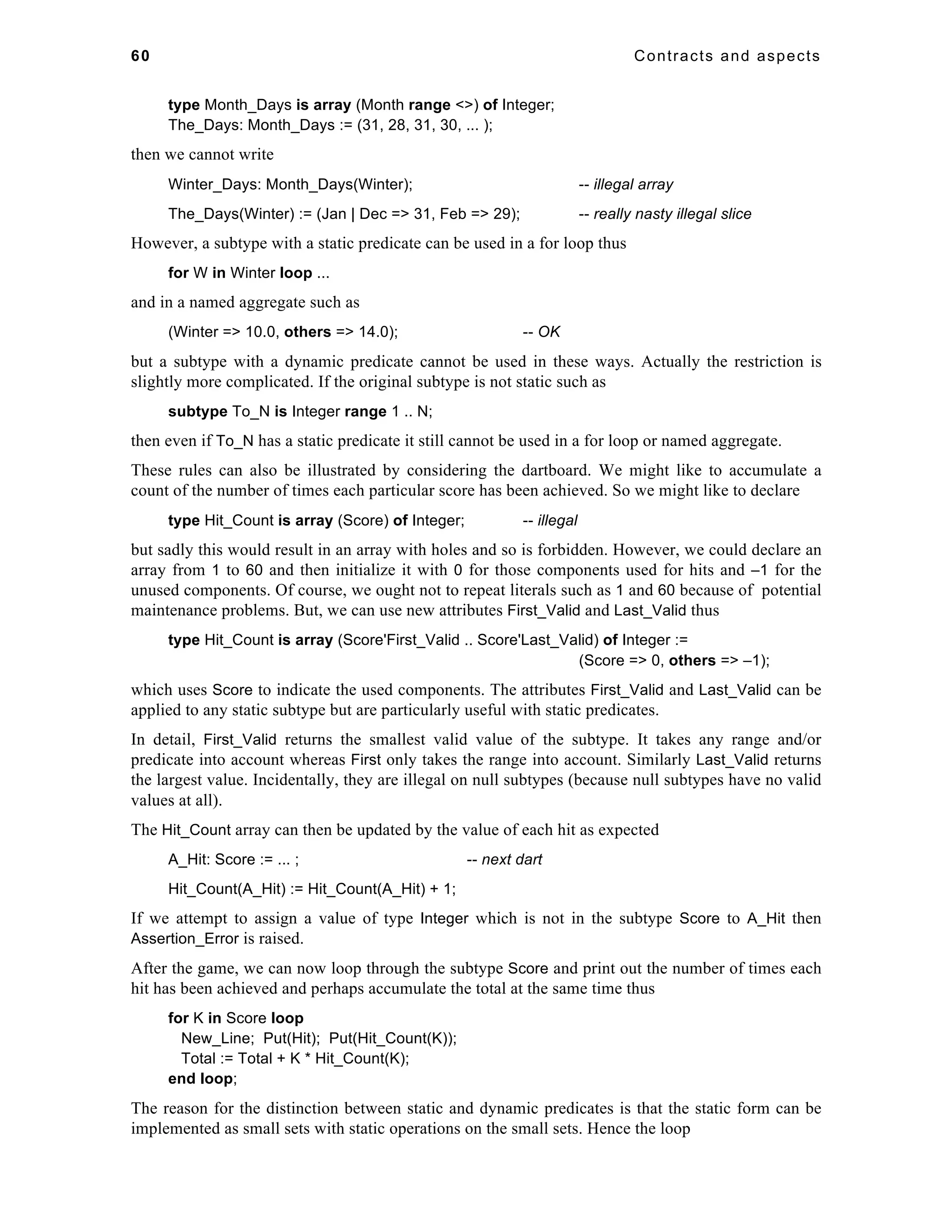

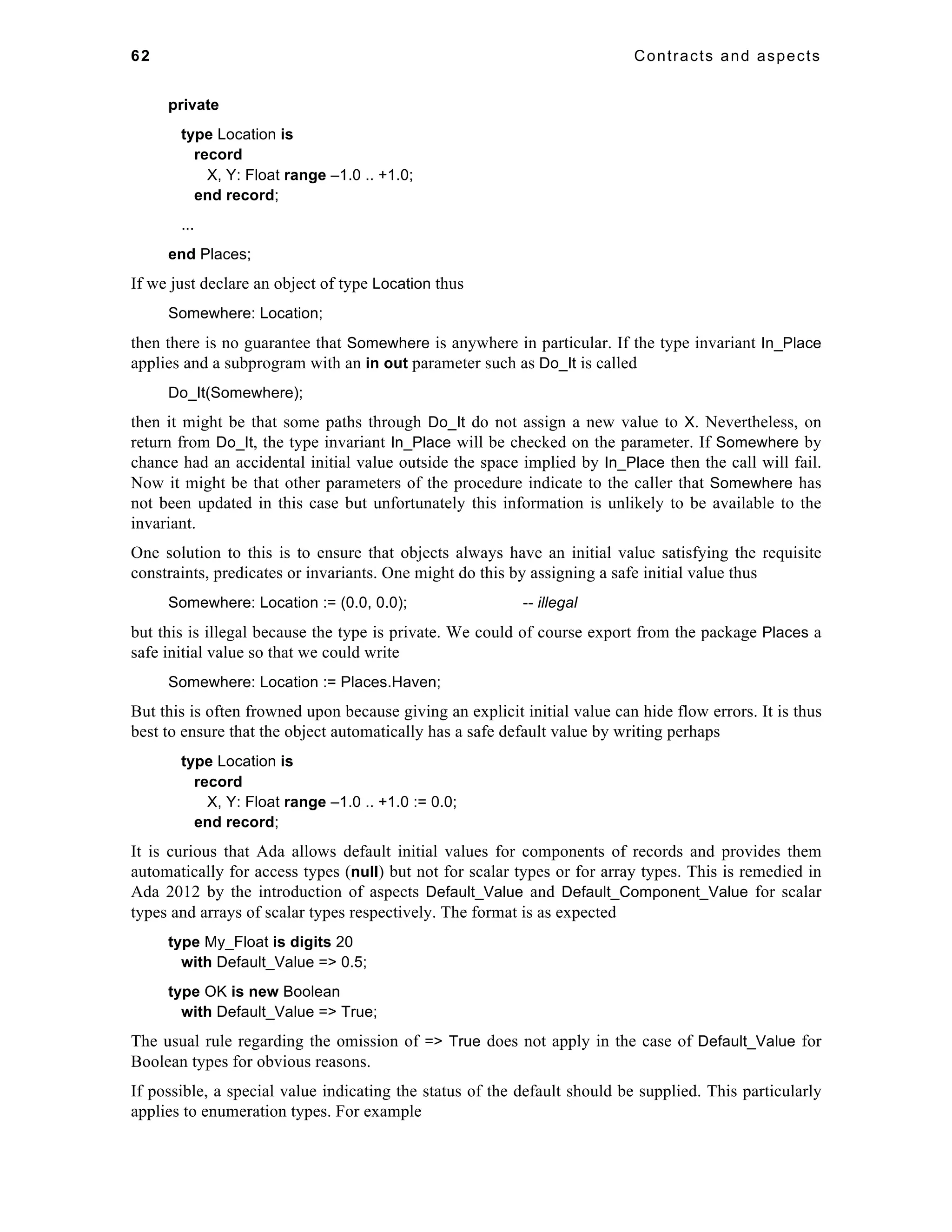
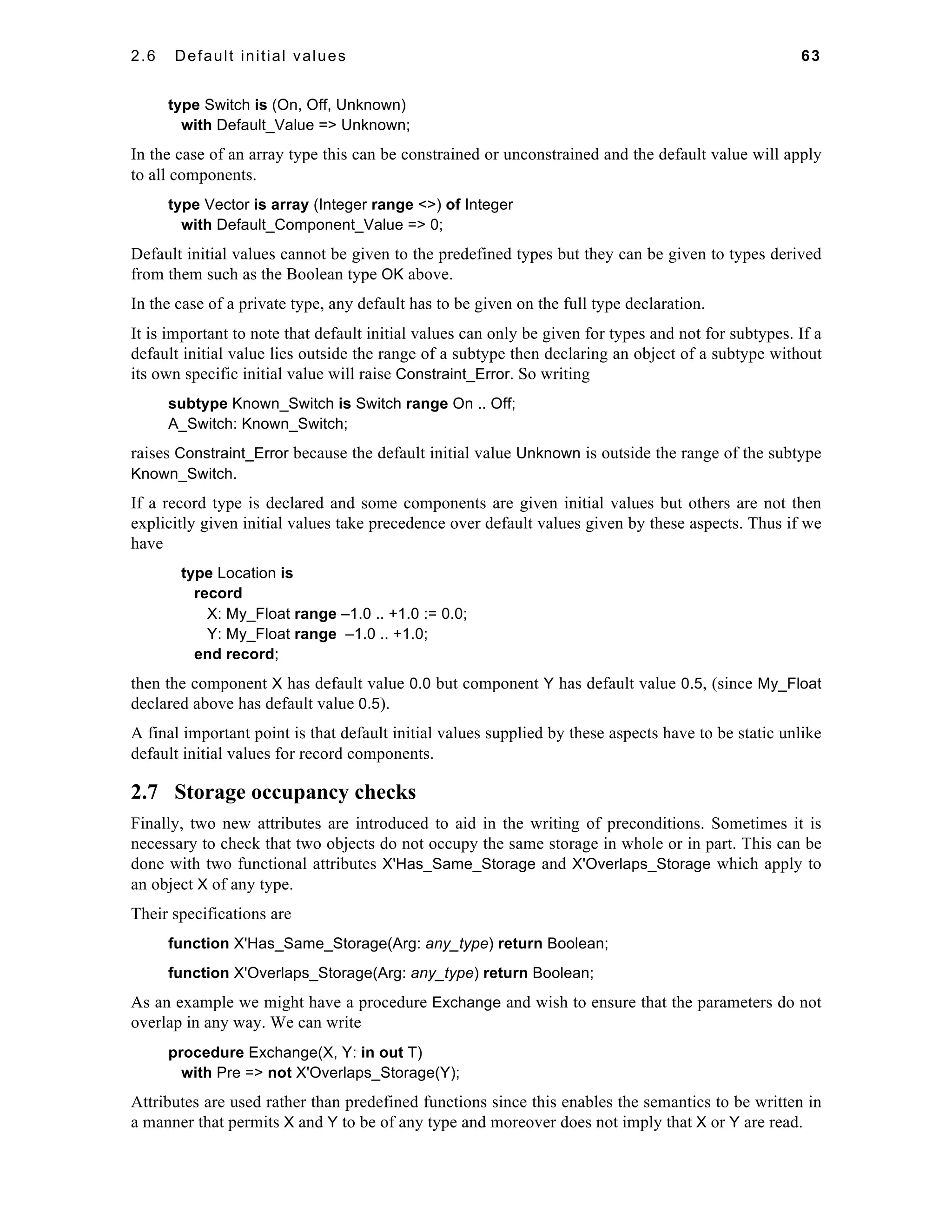
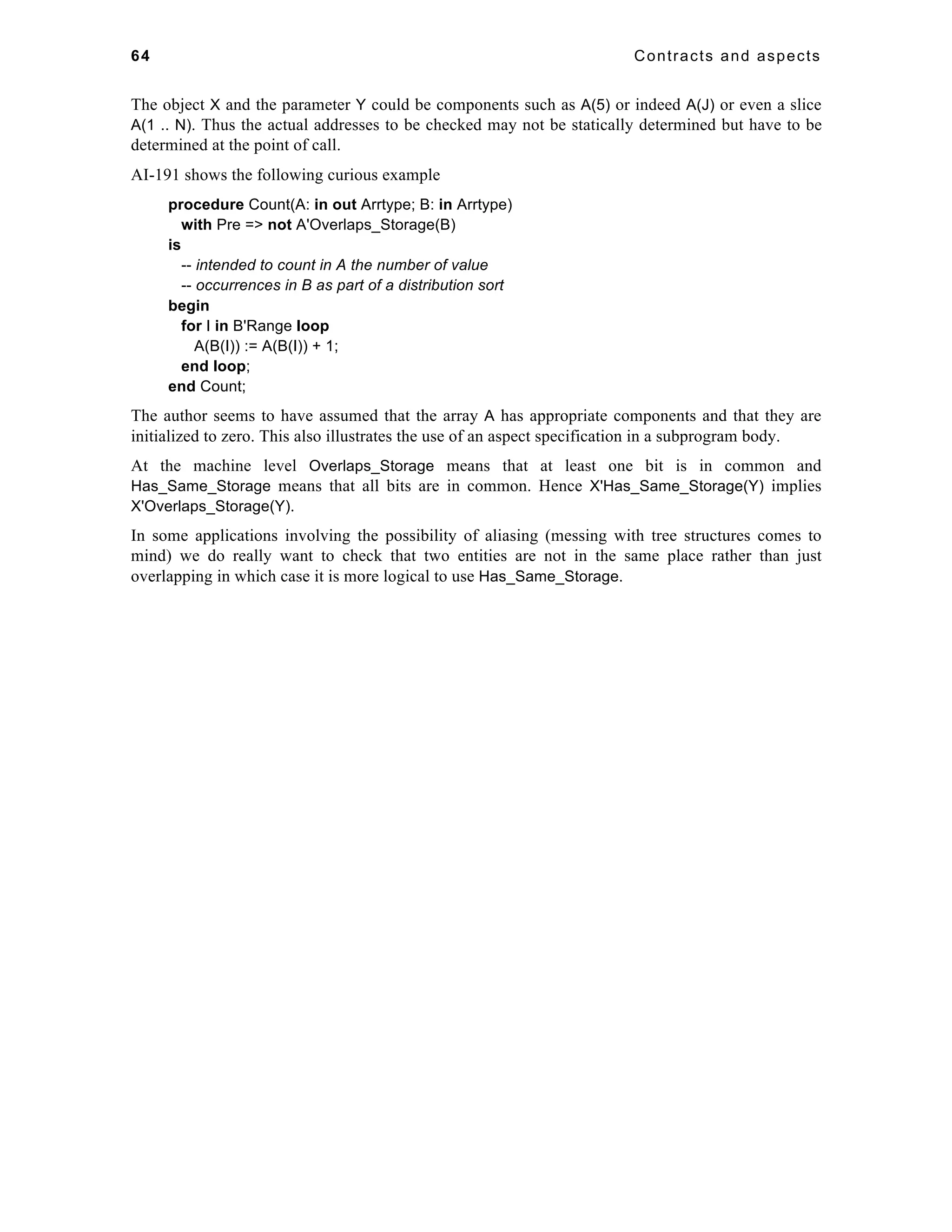
![65
3 Expressions
This chapter describes the introduction of more flexible forms of expressions in Ada 2012.
There are four new forms of expressions. If expressions and case expressions define a value
and closely resemble if statements and case statements. Quantified expressions take two
forms using for all and for some to return a Boolean value. Finally, expression functions
provide a simple means of parameterizing an expression without the formality of providing
a function body.
These more flexible forms of expressions will be found invaluable in formulating contracts
such as preconditions. It is interesting to note that Ada now has conditional expressions
over 50 years after their introduction in Algol 60.
3.1 Overview of changes
One of the key areas identified by the WG9 guidance document [1] as needing attention was
improving the ability to write and enforce contracts. These were discussed in detail in the previous
chapter.
When defining the new aspects for preconditions, postconditions, type invariants and subtype
predicates it became clear that without more flexible forms of expressions, many functions would
need to be introduced because in all cases the aspect was given by an expression.
However, declaring a function and thus giving the detail of the condition, invariant or predicate in
the function body makes the detail of the contract rather remote for the human reader. Information
hiding is usually a good thing but in this case, it just introduces obscurity.
Four forms are introduced, namely, if expressions, case expressions, quantified expressions and
expression functions. Together they give Ada some of the flexible feel of a functional language.
In addition, membership tests are generalized to allow greater flexibility which is particularly useful
for subtype predicates.
The following Ada issues cover the key changes and are described in detail in this chapter:
3 Qualified expressions and names
147 Conditional expressions
158 Generalizing membership tests
176 Quantified expressions
177 Expression functions
188 Case expressions
These changes can be grouped as follows.
First there are conditional expressions which come in two forms, if expressions and case
expressions, which have a number of features in common (147, 188).
Then there is the introduction of quantified expressions which use for all to describe a universal
quantifier and for some to describe an existential quantifier. Note that some is a new reserved word
(176).
Next comes the fourth new form of expression which is the expression function (177).](https://image.slidesharecdn.com/ada2012rationale-141002094233-phpapp01/75/Ada2012-Rationale-75-2048.jpg)
![66 Expressions
Finally, membership tests are generalized (158) and there is a minor change regarding qualified
expressions (3).
3.2 If expressions
It is perhaps very surprising that Ada does not have if expressions as well as if statements. In order
to provide some background context we briefly look at two historic languages that are perhaps the
main precursors to modern languages; these are Algol 60 [8] and CPL [9].
Algol 60 had conditional expressions of the form
Z := if X = Y then P else Q
which can be contrasted with the conditional statement
if X = Y then
Z := P
else
Z := Q
Conditional statements in Algol 60 allowed only a single statement in each branch, so if several
were required then they had to be grouped into a compound statement thus
if X = Y then
begin
Z := P; A := B
end
else
begin
Z := Q; A := C
end
It may be recalled that statements were not terminated by semicolons in Algol 60 but separated by
them. However, a null statement was simply nothing so the effect of adding an extra semicolon in
some cases was harmless. However, accidentally writing
if X = Y then ;
begin
Z := P; A := B
end;
results in a disaster because the test then just covers a null statement and the assignments to Z and A
always take place. The complexity of compound statements did not arise with conditional
expressions.
The designers of Algol 68 [10] sensibly recognized the problem and introduced closing brackets
thus
if X = Y then
Z := P; A := B;
fi;
where fi matches the if. Conditional expressions in Algol 68 were similar
Z := if X = Y then P else Q fi;
An alternative shorthand notation was
Z := (X = Y | P | Q);](https://image.slidesharecdn.com/ada2012rationale-141002094233-phpapp01/75/Ada2012-Rationale-76-2048.jpg)
![3.2 If expressions 67
which was perhaps a bit too short.
The next major language in this series was Pascal [11]. The designers of Pascal rejected everything
that had been learnt from Algol 68 and foolishly continued the Algol 60 style for compound
statements and also dropped conditional expressions. Only with Modula did they realise the need for
bracketing rather than compounding.
The other foundation language was CPL [9]. Conditional statements in CPL took the following form
if X = Y then do Z := P
if X = Y then do § Z := P; A := B §|
where compound statements were delimited by section symbols (note that the closing symbol has a
vertical line through it).
From CPL came BCPL, B and C. Along the way, the expressive := for assignment got lost in favour
of = which then meant that = had to be replaced by == for equality. And the section brackets became
{ and } so in C the above conditional statements become
if (X == Y) Z = P;
if (X == Y) {Z = P; A = B;}
This suffers from the same stray semicolon problem mentioned above with reference to Algol 60.
Steelman [12] did not require Ada to have conditional expressions and since they were not required
they were not provided (the requirements were treated with considerable reverence). A further
influence might have been that the new language had to be based on one of Pascal, Algol 68 and
PL/I and Ada is based on Pascal which did not have conditional expressions as mentioned above.
Moreover, the Ada designers felt that the Algol 68 style with reversed keywords such as fi (or worse
esac) for conditional statements would not be acceptable to the USDoD or the public at large and so
we have end if as the closing bracket thus
if X = Y then
Z := P;
A := B;
end if;
Remember that semicolons terminate statements in Ada and so those above are all required.
Moreover, since null statements in Ada have to be given explicitly, placing a stray semicolon after
then gives a compiler error.
The absence of conditional expressions is a pain. It leads to unnecessary duplication such as having
to write
if X > 0 then
P(A, B, D, E);
else
P(A, C, D, E);
end if;
where all parameters but one are the same. This can even lead to disgusting coding using the fact
that Boolean'Pos(True) is 1 whereas Boolean'Pos(False) is 0. Thus (assuming that B and C are of
type Integer) the above could be written as a single procedure call thus
P(A, Boolean'Pos(X>0)*B+Boolean'Pos(X<=0)*C, D, E);
So it is a great relief in Ada 2012 to be able to write](https://image.slidesharecdn.com/ada2012rationale-141002094233-phpapp01/75/Ada2012-Rationale-77-2048.jpg)
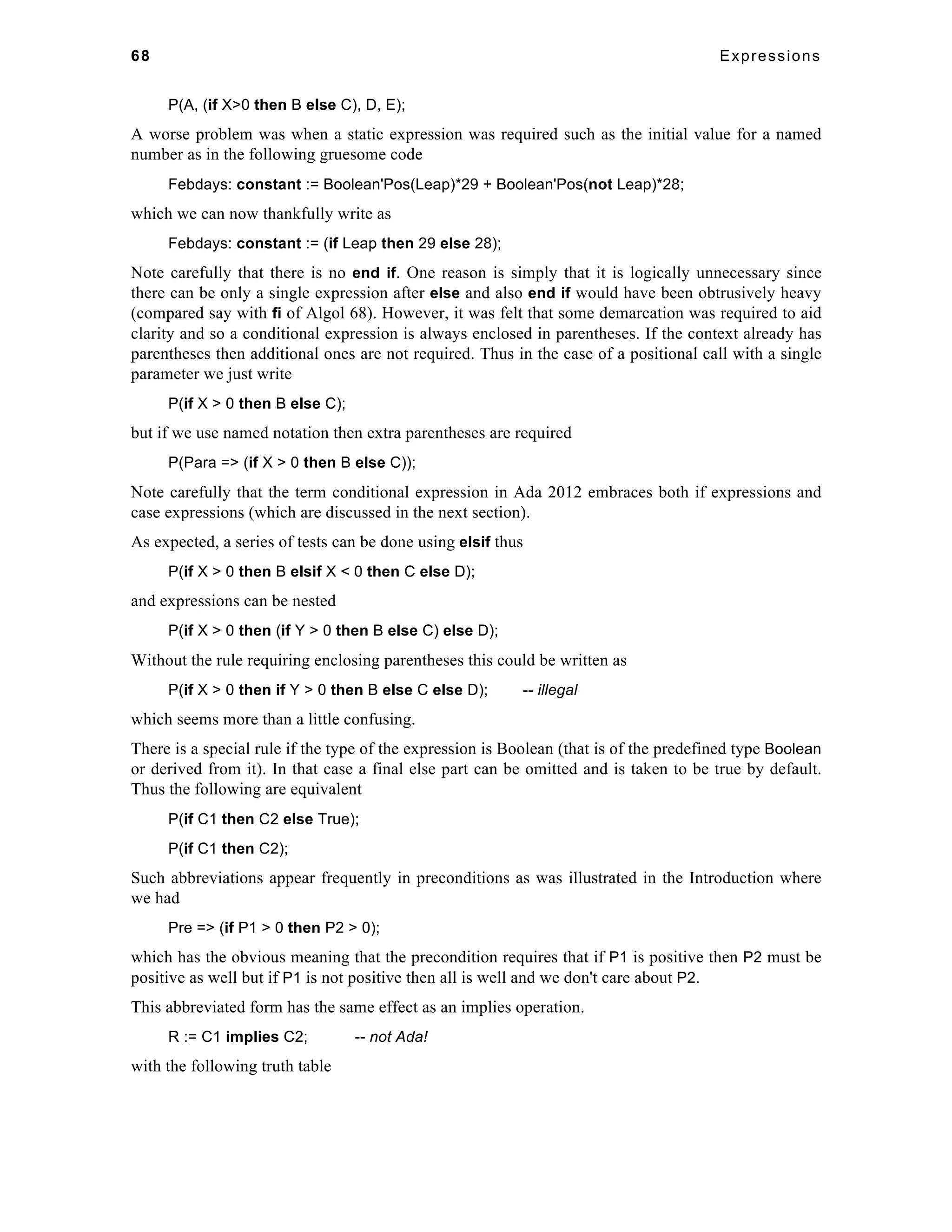
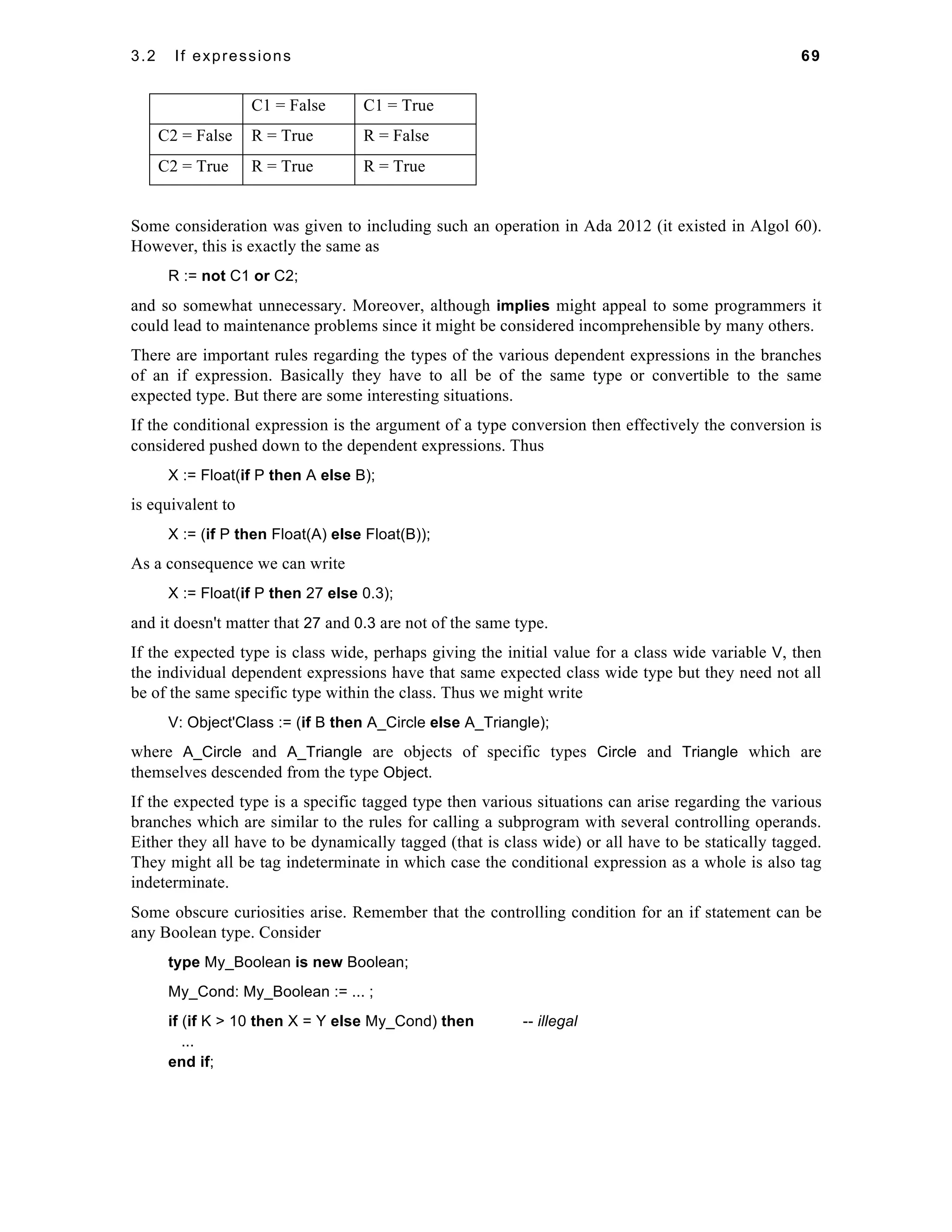
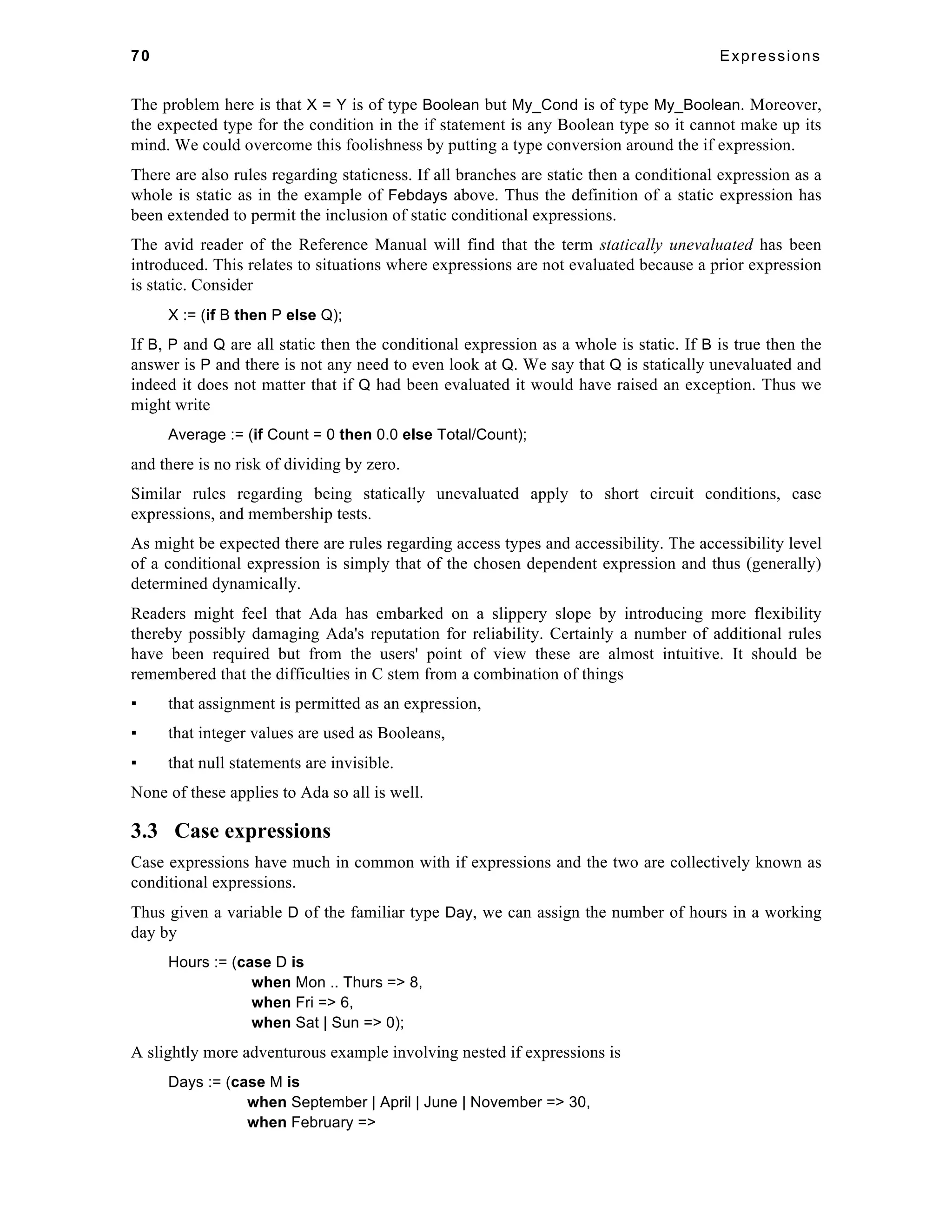
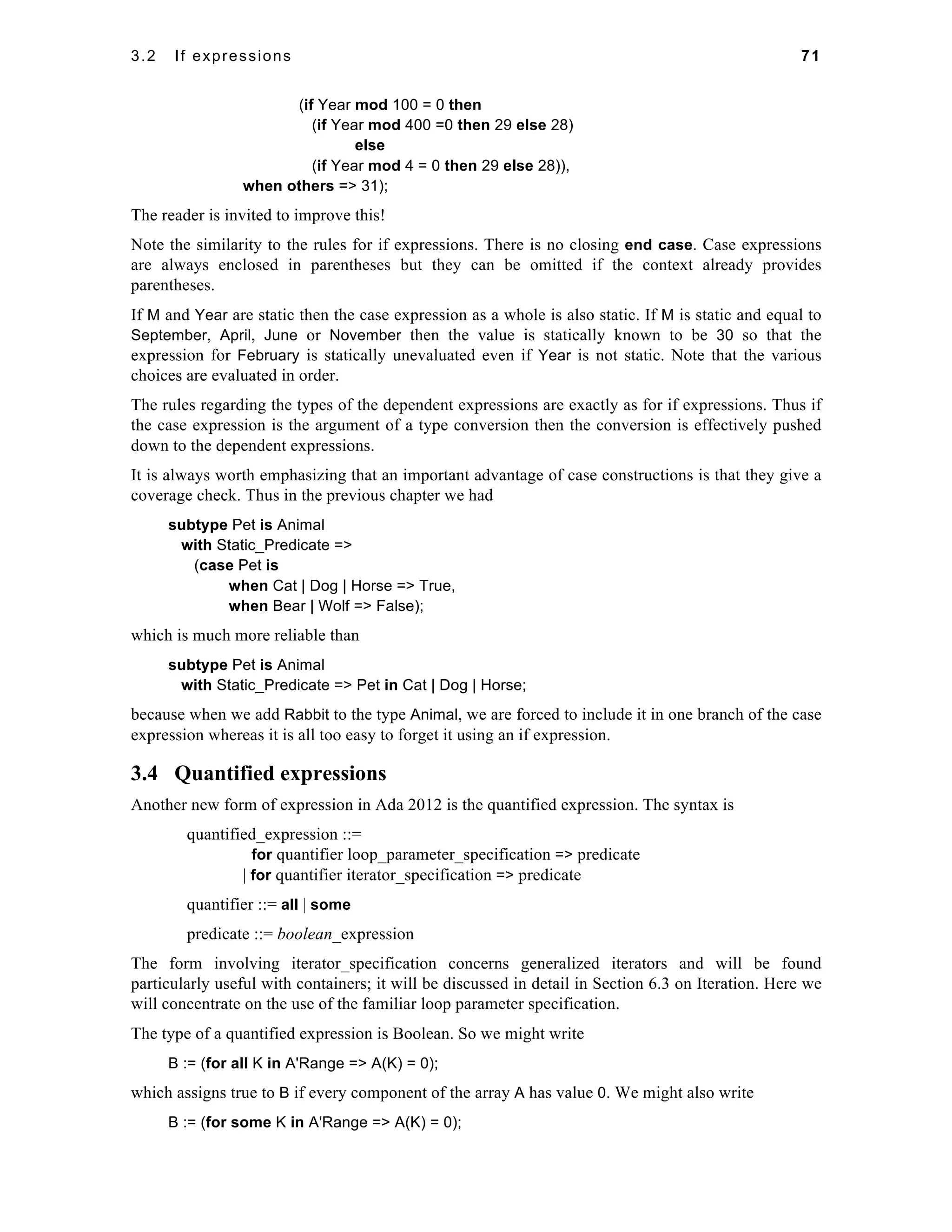
![72 Expressions
which assigns true to B if some component of the array A has value 0.
Note that the loop parameter is almost inevitably used in the predicate. A quantified expression is
very much like a for statement except that we evaluate the expression after => on each iteration
rather than executing one or more statements. The iteration is somewhat implicit and the words loop
and end loop do not appear.
The expression is evaluated for each iteration in the appropriate order (reverse can be inserted of
course) and the iteration stops as soon as the value of the expression is determined. Thus in the case
of for all, as soon as one value is found to be False, the overall expression is False whereas in the
case of for some as soon as one value is found to be True, the overall expression is True. An
iteration could raise an exception which would then be propagated in the usual way.
Like conditional expressions, a quantified expression is always enclosed in parentheses which can
be omitted if the context already provides them, such as in a procedure call with a single positional
parameter.
Incidentally, predicate is a fancy word meaning Boolean expression. Older folk might recall that it
also means the part of a sentence after the subject. Thus in the sentence "I love Ada", the subject is
"I" and the predicate is "love Ada".
The forms for all and for some are technically known as the universal quantifier and existential
quantifier respectively.
Note that some is a new reserved word (the only one in Ada 2012). There were six new ones in Ada
95 (abstract, aliased, protected, requeue, tagged and until) and three new ones in Ada 2005
(interface, overriding and synchronized). Hopefully we are converging.
The type of a quantified expression can be any Boolean type (that is the predefined type Boolean or
perhaps My_Boolean derived from Boolean). The predicate must be of the same type as the
expression as a whole. Thus if the predicate is of type My_Boolean then the quantified expression is
also of type My_Boolean.
The syntax for quantified expressions uses => to introduce the predicate. This is similar to the
established notation in SPARK [13]. Consideration was given to using a vertical bar which is
common in mathematics but that would have been confusing because of its use in membership tests
and other situations with multiple choices.
As illustrated in the Introduction, quantified expressions will find their major uses in pre- and
postconditions. Thus a procedure Sort on an array A of type Atype such as
type Atype is array (Index) of Float;
might have specification
procedure Sort(A: in out Atype)
with Post => A'Length < 2 or else
(for all K in A'First .. Index'Pred(A'Last) => A(K) <= A(Index'Succ(K)));
where we are assuming that the index type need not be an integer type and so we have to use Succ
and Pred. Note how the trivial cases of a null array or an array with a single component are
dismissed first.
Quantified expressions can be nested. So we might check that all components of a two-dimensional
array are zero by writing
B := (for all I in AA'Range(1) => (for all J in AA'Range(2) => AA(I, J) = 0));
This can be done rather more neatly using the syntactic form](https://image.slidesharecdn.com/ada2012rationale-141002094233-phpapp01/75/Ada2012-Rationale-82-2048.jpg)
![3.4 Quantified expressions 73
for quantifier iterator_specification => predicate
as will be discussed in detail in Section 6.3 on Iteration. We just write
B := (for all E of AA => E = 0);
which iterates over all elements of the array AA however many dimensions it has.
3.5 Expression functions
The final new form to be discussed is the expression function. As outlined in the Introduction, an
expression function provides the effect of a small function without the formality of introducing a
body. It is important to appreciate that strictly speaking an expression function is basically another
form of function and not another form of expression. But it is convenient to discuss expression
functions in this chapter because like conditional expressions and quantified expressions they arose
for use with aspect clauses such as pre- and postconditions.
The syntax is
expression_function_declaration ::=
[overriding_indicator]
function_specification is
(expression)
[aspect_specification] ;
As an example we can reconsider the type Point and the function Is_At_Origin thus
package P is
type Point is tagged
record
X, Y: Float := 0.0;
end record;
function Is_At_Origin(P: Point) return Boolean is
(P.X = 0.0 and P.Y = 0.0)
with Inline;
...
end P;
The expression function Is_At_Origin is a primitive operation of Point just as if it were a normal
function with a body. If a type My_Point is derived from Point then Is_At_Origin would be inherited
or could be overridden with a normal function or another expression function. Thus an expression
function can be prefixed by an overriding indicator as indicated by the syntax.
Expression functions can have an aspect clause and since by their very nature they will be short, this
will frequently be with Inline as in this example.
The result of an expression function is given by an expression in parentheses. The parentheses are
included to immediately distinguish the structure from a normal body which could start with an
arbitrary local declaration. The expression can be any expression having the required type. It could
for example be a quantified expression as in the following
function Is_Zero(A: Atype) return Boolean is
(for all J in A'Range => A(J) = 0);
This is another example of a situation where the quantified expression does not need to be enclosed
in its own parentheses because the context supplied by the expression function provides parentheses.](https://image.slidesharecdn.com/ada2012rationale-141002094233-phpapp01/75/Ada2012-Rationale-83-2048.jpg)
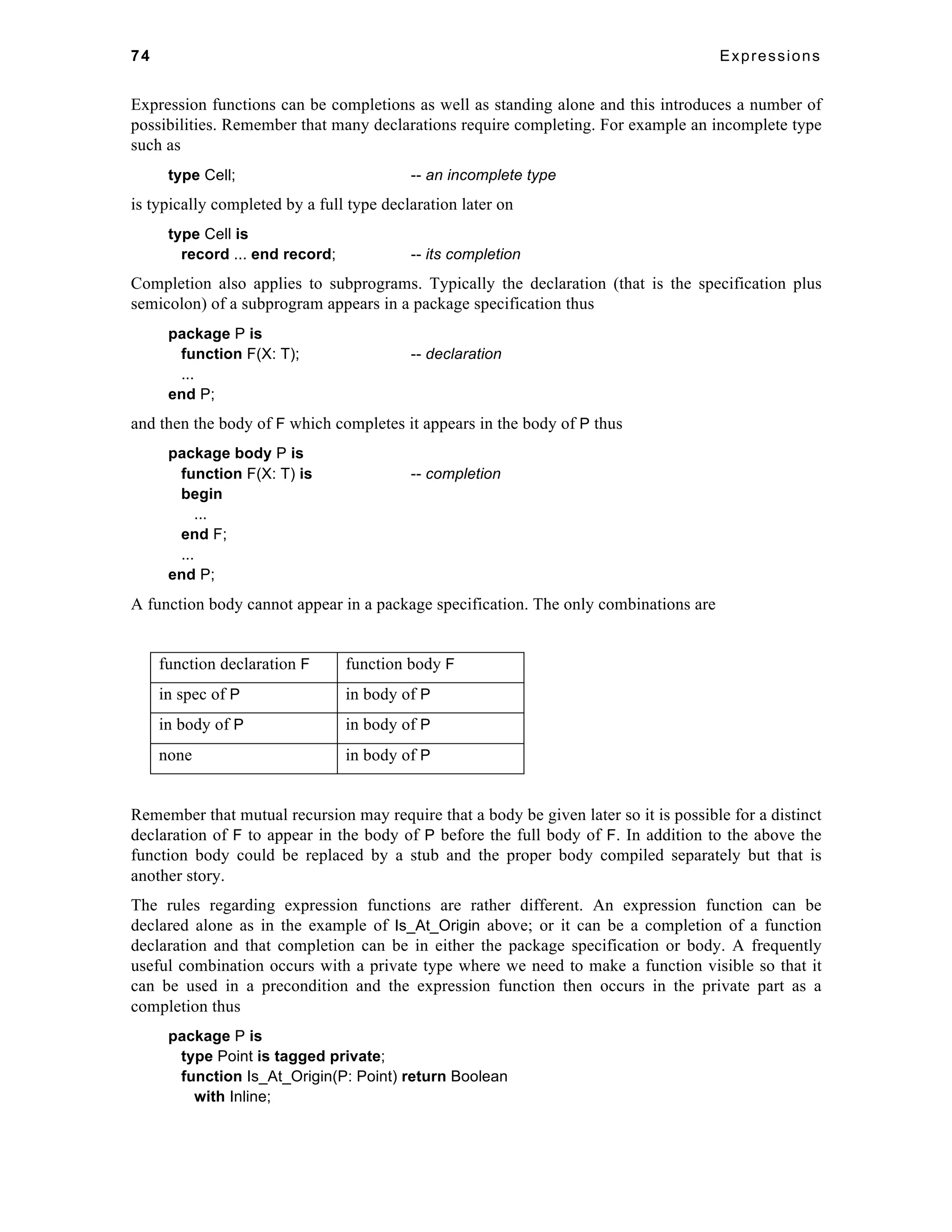
![3.5 Expression functions 75
procedure Do_It(P: in Point; ... )
with Pre => not Is_At_Origin;
private
type Point is tagged
record
X, Y: Float := 0.0;
end record;
function Is_At_Origin(P: Point) return Boolean is
(P.X = 0.0 and P.Y = 0.0);
...
end P;
Note that we cannot give an aspect specification on an expression function used as a completion so
it is given on the function specification; this makes it visible to the user. (This rule applies to all
completions such as subprogram bodies and is not special to expression functions.)
An expression function can also be used in a package body as an abbreviation for
function Is_At_Origin(P: Point) return Boolean is
begin
return P.X = 0.0 and P.Y = 0.0;
end Is_At_Origin;
The possible combinations regarding a function in a package are
function declaration F expression function F
in spec of P in spec or body of P
in body of P in body of P
none in spec or body of P
We perhaps naturally think of an expression function used as a completion to be in the private part
of a package. But we could declare a function in the visible part of a package and then an expression
function to complete it in the visible part as well. This is illustrated by the following interesting
example of two mutually recursive functions.
package Hof is
function M(K: Natural) return Natural;
function F(K: Natural) return Natural;
function M(K: Natural) return Natural is
(if K = 0 then 0 else K – F(M(K–1)));
function F(K: Natural) return Natural is
(if K =0 then 1 else K – M(F(K–1)));
end Hof;
These are the Male and Female functions described by Hofstadter [14]. They are inextricably
intertwined and both are given with completions for symmetry.](https://image.slidesharecdn.com/ada2012rationale-141002094233-phpapp01/75/Ada2012-Rationale-85-2048.jpg)
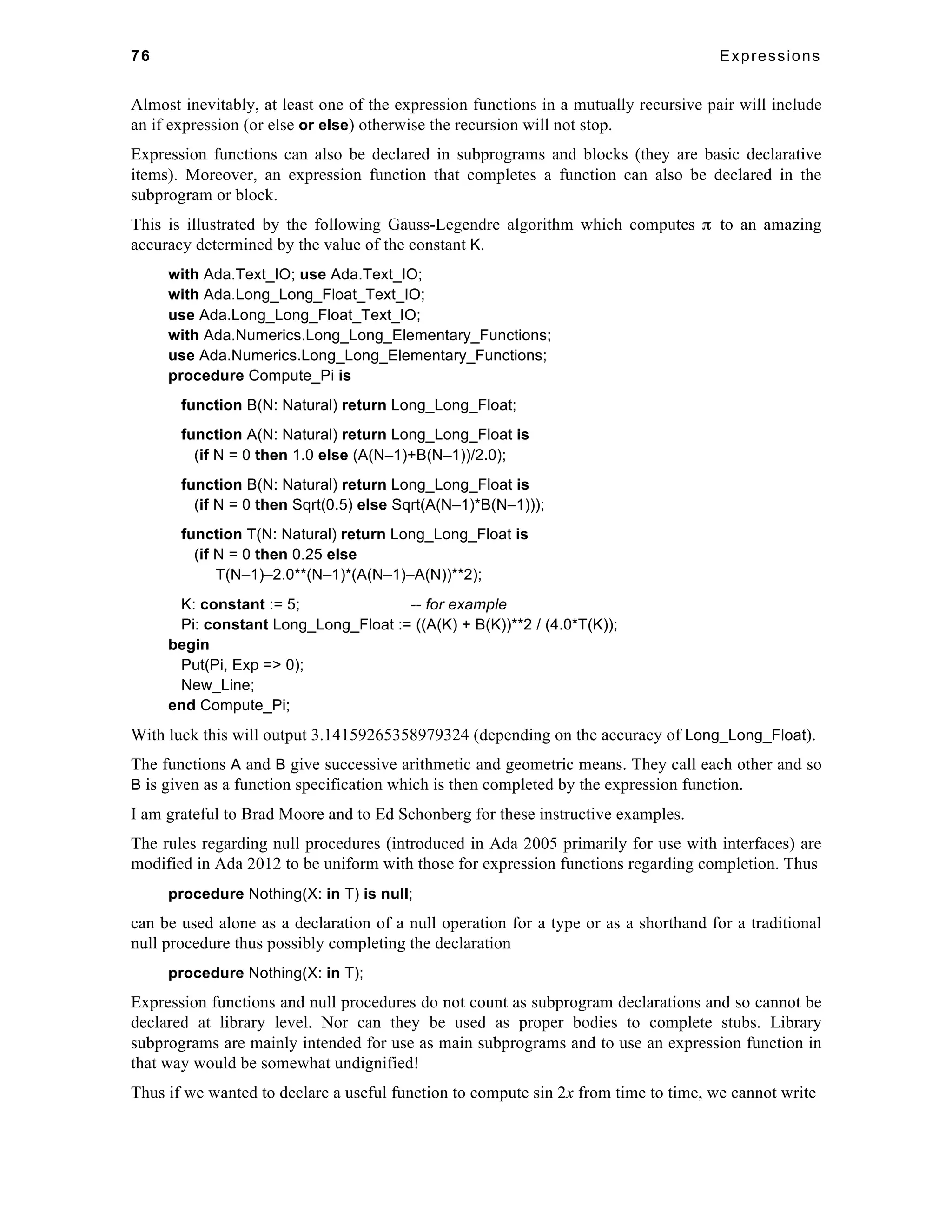
![3.5 Expression functions 77
with Ada.Numerics.Elementary_Functions;
use Ada.Numerics.Elementary_Functions;
function Sin2(X: Float) is -- illegal
(2.0 * Sin(X) * Cos(X));
but either have to write it out the long way or wrap the expression function in a package.
3.6 Membership tests
Membership tests in Ada 83 to Ada 2005 are somewhat restrictive. They take two forms
▪ to test whether a value is in a given range, or
▪ to test whether a value is in a given subtype.
Examples of these are
if M in June .. August then
if I in Index then
However, the restrictions are annoying. If we want to test whether it is safe to eat an oyster (there
has to be an R in the month) then we would really like to write
if M in Jan .. April | Sep .. Dec then -- illegal in Ada 2005
whereas we are forced to write something like
if M in Jan .. April or M in Sep .. Dec then
which means repeating M and then perhaps worrying about whether to use or or or else. Or in this
case we could do the test the other way
if M not in May .. Aug then
What we would really like to do is use the vertical bar as in case statements and aggregates to select
a combination of ranges, subtypes, and values.
Ada 2012 is much more flexible in this area. To see the differences it is probably easiest to look at
the old and new syntax. The relevant old syntax for Ada 2005 is
relation ::=
simple_expression [relational_operator simple_expression]
| simple_expression [not] in range
| simple_expression [not] in subtype_mark
where the last two productions define membership tests. The syntax regarding choices in aggregates
and case statements in Ada 2005 is
discrete_choice_list ::= discrete_choice { | discrete_choice}
discrete_choice ::= expression | discrete_range | others
discrete_range ::= discrete_subtype_indication | range
The syntax in Ada 2012 is rather different and changes relation to use new productions for
membership_choice_list and membership_choice (this enables the vertical bar to be used in
membership tests). And then a membership choice in turn uses choice_expression and
choice_relation as follows
relation ::=
simple_expression [relational_operator simple_expression]
| simple_expression [not] in membership_choice_list](https://image.slidesharecdn.com/ada2012rationale-141002094233-phpapp01/75/Ada2012-Rationale-87-2048.jpg)
![78 Expressions
membership_choice_list ::= membership_choice { | membership_choice}
membership_choice ::= choice_expression | range | subtype_mark
choice_expression ::=
choice_relation {and choice_relation}
| choice_relation {or choice_relation}
| choice_relation {xor choice_relation}
| choice_relation {and then choice_relation}
| choice_relation {or else choice_relation}
choice_relation ::= simple_expression [relational_operator simple_expression]
The difference between a choice_relation and a relation is that the choice_relation does not include
membership tests. Moreover, discrete_choice is changed to
discrete_choice ::= choice_expression | discrete_subtype_indication | range | others
the difference being that a discrete_choice now uses a choice_expression rather than an expression
as one of its possibilities.
The overall effect of the changes is to permit the vertical bar in membership tests without getting too
confused by nesting membership tests.
Here are some examples that are now permitted in Ada 2012 but were not permitted in Ada 2005
if N in 6 | 28 | 496 then -- N is small and perfect!
if M in Spring | June | October .. December then
-- combination of subtype, single value and range
if X in 0.5 .. Z | 2.0*Z .. 10.0 then -- not discrete or static
if Obj in Triangle | Circle then -- with tagged types
if Letter in 'A' | 'E' | 'I' | 'O' | 'U' then -- characters
Membership tests are permitted for any type and values do not have to be static. There is no change
here but it should be remembered that existing uses of the vertical bar in case statements and
aggregates do require the type to be discrete and the values to be static.
Another important point about membership tests is that the membership choices are evaluated in
order and as soon as one is found to be true (or false if not is present) then the relation as a whole is
determined and the other membership choices are not evaluated. This is therefore the same as using
short circuit forms such as or else and so gives another example of expressions which are statically
unevaluated.
There is one very minor incompatibility. In Ada 2005 we can write
X: Boolean := ...
case X is
when Y in 1 .. 10 => F(10);
when others => F(5);
end case;
This is rather peculiar. The discrete choice Y in 1 .. 10 must be static. Suppose Y is 5, so that Y in 1
.. 10 is true; then if X is True, we call F(10) whereas if X is false we call F(5). And vice versa for
values of Y not in the range 1 to 10.](https://image.slidesharecdn.com/ada2012rationale-141002094233-phpapp01/75/Ada2012-Rationale-88-2048.jpg)


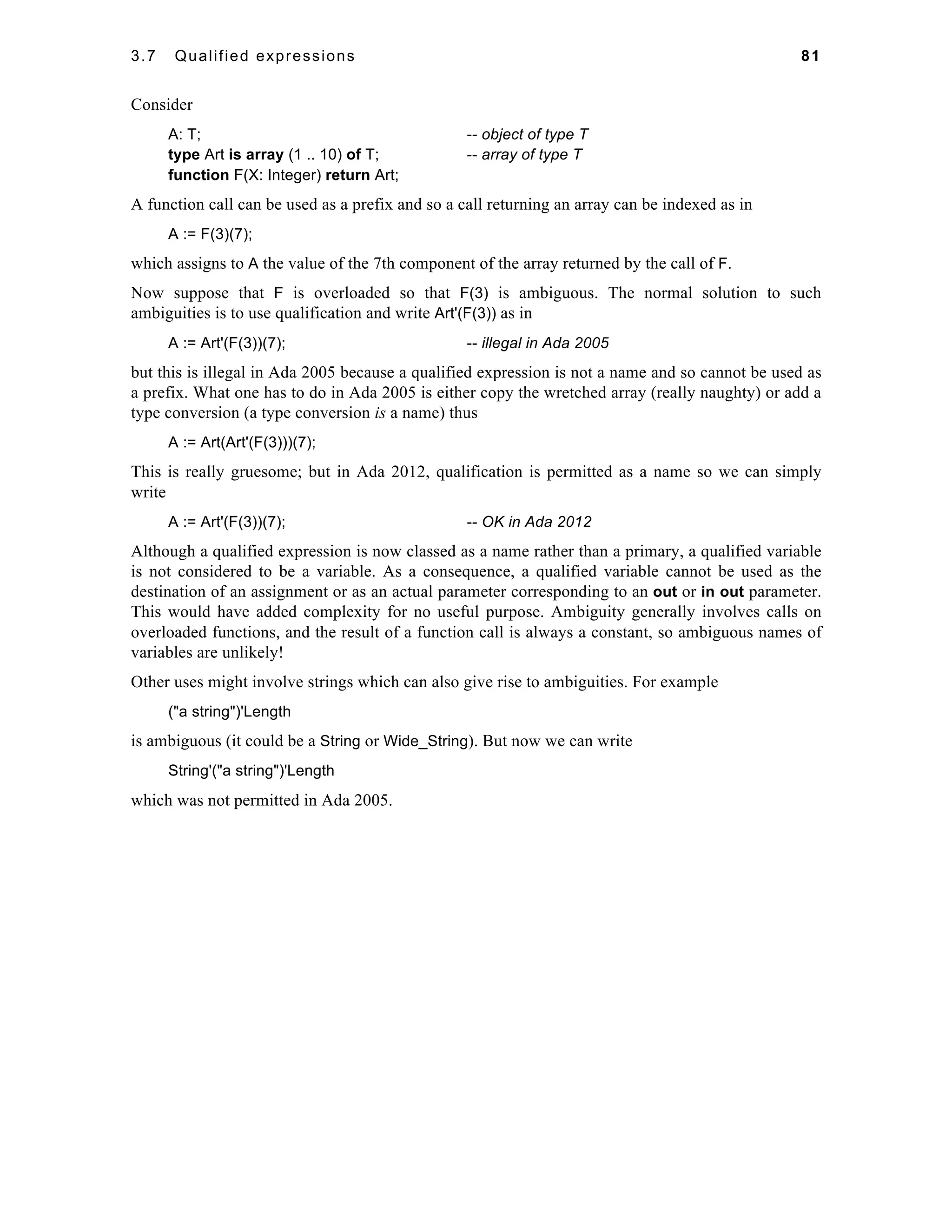

![83
4 Structure and Visibility
This chapter describes various improvements in the areas of structure and visibility for Ada
2012.
Perhaps the most amazing change is that functions may now have parameters of all modes.
In earlier versions of Ada, functions could only have parameters of mode in and so could
not change variables explicitly passed as parameters; however, they could silently
manipulate global variables in any way whatsoever. In order to ameliorate any risks of
foolishness with this new freedom, there are new rules regarding order dependence.
There are also important improvements to incomplete types which make them much more
useful; these include completion by a private type, their use as parameters and a new form
of generic parameter.
Other improvements include a new form of use clause and changes to extended return
statements.
4.1 Overview of changes
The WG9 guidance document [1] does not specifically identify problems in this area other than
through a general exhortation to remedy shortcomings.
The following Ada Issues cover the relevant changes and are described in detail in this chapter:
15 Constant return objects
19 Primitive subprograms are frozen with a tagged type
32 Extended return statements for class-wide functions
53 Aliased views of unaliased objects
142 Explicitly aliased parameters
143 In out parameters for functions
144 Detecting dangerous order dependencies
150 Use all type clause
151 Incomplete types as parameters and result
162 Incomplete types completed by partial views
213 Formal incomplete types
214 Default discriminants for limited tagged types
235 Accessibility of explicitly aliased parameters
277 Aliased views of extended return objects
296 Freezing of subprograms with incomplete parameters
These changes can be grouped as follows.
First there is the exciting business of allowing parameters of all modes for functions (143) and the
associated rules to prevent certain order dependences (144). Another change concerning parameters
is permitting explicitly aliased parameters (142, 235).](https://image.slidesharecdn.com/ada2012rationale-141002094233-phpapp01/75/Ada2012-Rationale-93-2048.jpg)
![84 Structure and visibility
There are then a number of improvements in the area of incomplete types (151, 162) including the
ability to permit them as formal generic parameters (213, 296). There are also related changes to the
freezing rules (19).
There is also a minor change regarding discriminants (214).
The existing two forms of use clause (use package clause and use type clause) are augmented by a
third form: the use all type clause (150).
Finally, there are a number of changes (corrections really) to extended return statements which were
introduced in Ada 2005 (15, 32, 277). An associated change is the introduction of the idea of an
immutably limited type (53).
4.2 Subprogram parameters
The main topic here is the fact that functions (but not operators) in Ada 2012 can have parameters of
any mode.
This is a topic left over from Ada 2005. The epilogue to the Rationale for Ada 2005 [15] discusses a
number of topics that were abandoned and in the case of function modes says:
"Clearly, Ada functions are indeed curious. But strangely this AI (that is AI95-323) was abandoned
quite early in the revision process on the grounds that it was 'too late'. (Perhaps too late in this
context meant 25 years too late.)" It was not possible to agree on a way forward and so effort was
devoted to other topics.
But mists clear with time. The big concern was that allowing parameters of all modes might open
the door to dangerous programming practices but a solution to that was found in the introduction of
stricter rules preventing many order dependences.
It is instructive to quickly go through the various historical documents.
A probably little known document is one written in 1976 by David Fisher of the Institute for
Defense Analyses [16] which provided the foundation for the requirements for the development of a
new language. It doesn't seem to distinguish between procedures and functions; it does mention the
need for parameters which are constant and those which effectively rename a variable. Moreover, it
does say (item C1 on page 81): Side effects which are dependent on the evaluation order among the
arguments of an expression will be evaluated left-to-right. This does not actually require left-to-right
evaluation but the behaviour must be as if it were. I have always thought it tragic that this was not
observed.
This document was followed by a series known as Strawman, Woodenman, Tinman, Ironman [17]
and finishing with Steelman [12].
The requirement on left-to-right evaluation remained in Tinman and was even stronger in Ironman
but was somewhat weakened in Steelman to allow instrumentation and ends with a warning about
being erroneous.
Further requirements are introduced in Ironman which requires both functions and procedures as we
know them. Moreover, Ironman has a requirement about assignment to variables non-local to a
function; they must be encapsulated in a region that has no calls on the function; this same
requirement notes that it implies that functions can only have input parameters. This requirement
does not seem to have carried forward to Steelman.
However, Ironman also introduces a requirement on restrictions to prevent aliasing. One is that the
same actual parameter of a procedure cannot correspond to more than one input-output parameter.
This requirement does survive into Steelman. But, it only seems to apply to procedures and not to](https://image.slidesharecdn.com/ada2012rationale-141002094233-phpapp01/75/Ada2012-Rationale-94-2048.jpg)
![4.2 Subprogram parameters 85
functions and Steelman appears not to have noticed that the implied requirement that functions can
only have input parameters has vanished.
It interesting to then see what was proposed in the sequence of languages leading to Ada 83, namely,
Preliminary Green [18], Green [19], Preliminary Ada [20], and Ada [21]. Note that Preliminary
Green was based on Ironman whereas Green was based on Steelman.
In Preliminary Green we find procedures and functions. Procedures can have parameters of three
modes, in, out and access (don't get excited, access meant in out). Functions can only have
parameters of mode in. Moreover,
side effects to variables accessible at the function call are not allowed. In particular, variables
that are global to the function body may not be updated in the function body. The rationale for
Preliminary Green makes it quite clear that functions can have no side effects whatsoever.
In Green we find the three modes in, out, and in out. But the big difference is that as well as
procedures and functions as in preliminary Green, there are now value returning procedures such as
procedure Random return Real range –1.0 .. 1.0;
The intent is that functions are still free of all side effects whereas value returning procedures have
more flexibility. However, value returning procedures can only have parameters of mode in and
assignments to global variables are permitted within value returning procedures. Calls of such
procedures are only valid at points of the program where the corresponding variables are not
within the scope of their declaration. The order of evaluation of these calls is strictly that given
in the text of the program. Calls to value returning procedures are only allowed in assignment
statements, initializations and procedure calls.
The rationale for Green notes that if you want to instrument a function then use a pragma. It also
notes that functions
with arbitrary side effects would undermine the advantage of the functional approach to
software. In addition it would complicate the semantics of all language structures where
expressions involving such calls may occur. Hence this form of function is not provided.
And now we come to Ada herself. There are manuals dated July 1979 (preliminary Ada), July 1980
(draft mil-std), July 1982 (proposed ANSI standard), and January 1983 (the ANSI standard usually
known as Ada 83).
In Preliminary Ada, we have procedures, functions and value returning procedures exactly as in
Green. Indeed, it seems that the only difference between Green and Preliminary Ada is that the
name Green has been converted to Ada.
But the 1980 Ada manual omits value returning procedures and any mention of any restrictions on
what you can do in a function. And by 1982 we find that we are warned that parameters can be
evaluated in any order and so on.
The Rationale for Ada 83 [6] didn't finally emerge until 1986 and discusses briefly the reason for the
change which is basically that benevolent side effects are important. It concludes by quoting from a
paper regarding Algol 60 [22]
The plain fact of the matter is (1) that side-effects are sometimes necessary, and (2)
programmers who are irresponsible enough to introduce side-effects unnecessarily will soon
lose the confidence of their colleagues and rightly so.
However, an interesting remark in the Rationale for Ada 83 in the light of the change in Ada 2012 is](https://image.slidesharecdn.com/ada2012rationale-141002094233-phpapp01/75/Ada2012-Rationale-95-2048.jpg)
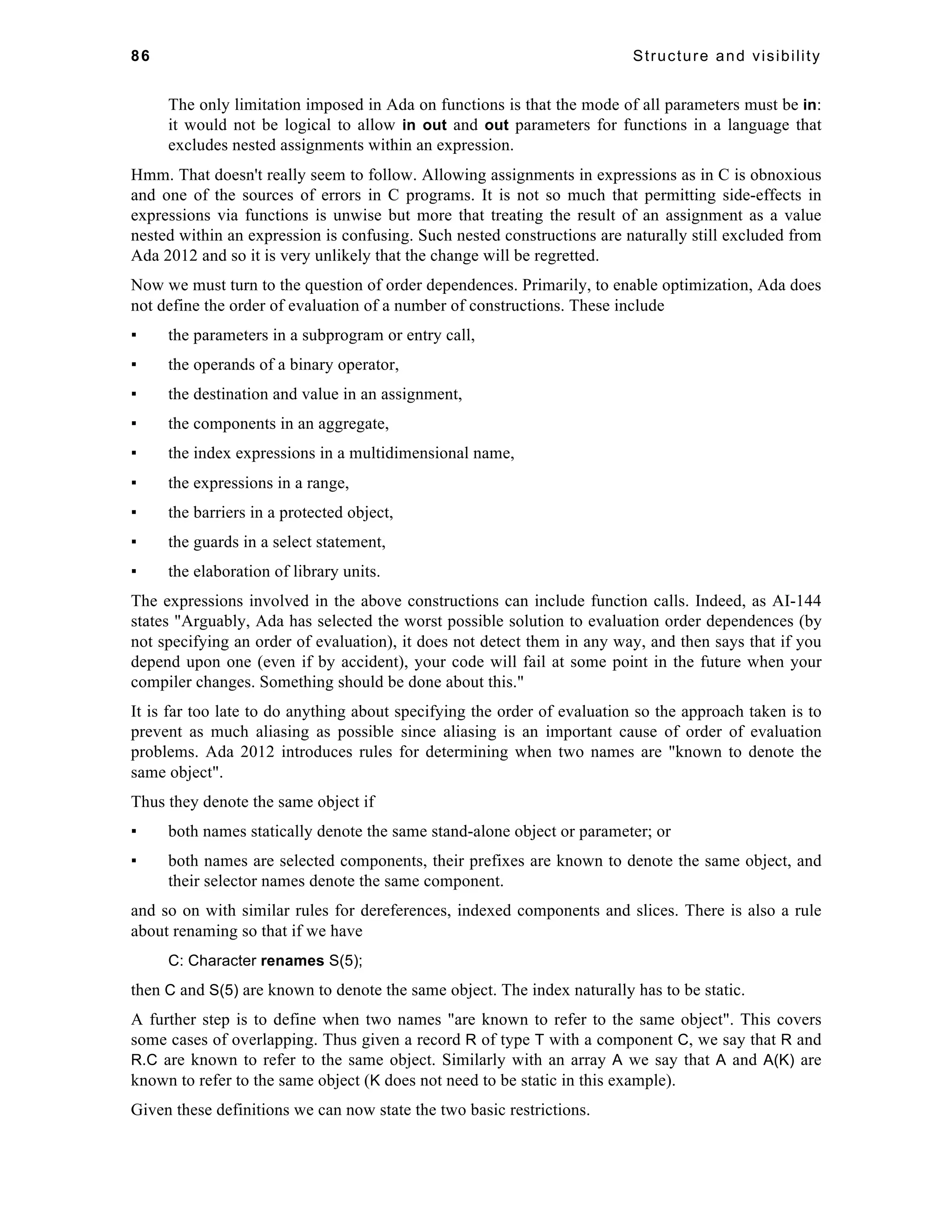
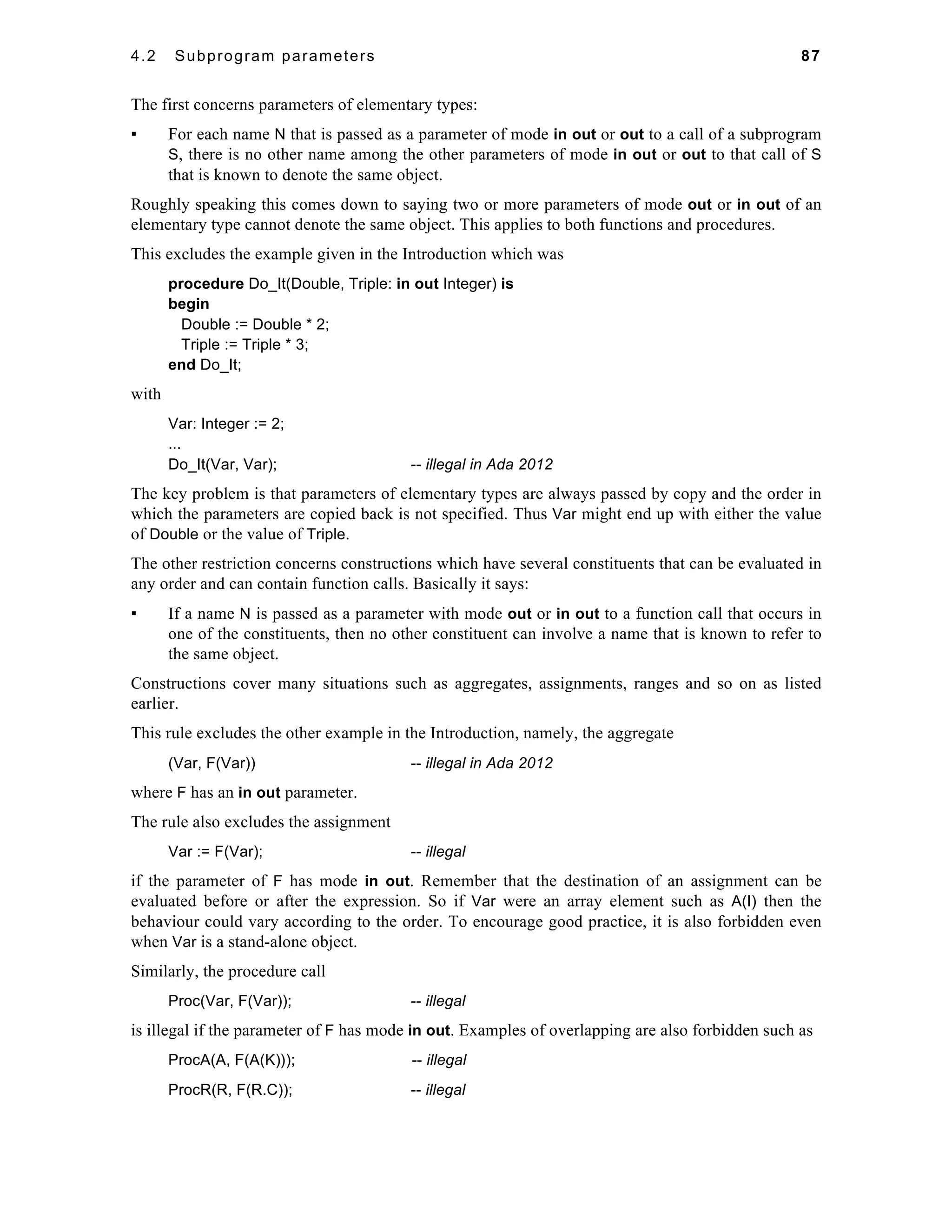
![88 Structure and visibility
assuming still that F has an in out parameter and that ProcA and ProcR have appropriate profiles
because, as explained above, A and A(K) are known to refer to the same object as are R and R.C.
On the other hand
Proc(A(J), F(A(K))); -- OK
is permitted provided that J and K are different objects because this is only a problem if J and K
happen to have the same value.
For more details the reader is referred to the AI. The intent is to detect situations that are clearly
troublesome. Other situations that might be troublesome (such as if J and K happen to have the same
value) are allowed, since to prevent them would make many programs illegal that are not actually
dubious. This would cause incompatibilities and upset many users whose programs are perfectly
correct.
The other change in Ada 2012 concerning parameters is that they may be explicitly marked aliased
thus
procedure P(X: aliased in out T; ... );
As a consequence within P we can write X'Access. Recall that tagged types were always considered
implicitly aliased anyway and always passed by reference. If the type T is a by-copy type such as
Integer, then adding aliased causes it to be passed by reference. (So by-copy types are not always
passed by copy!)
The possibility of permitting explicitly aliased function results such as
function F( ... ) return aliased T; -- illegal Ada 2012
was considered but this led to difficulties and so was not pursued.
The syntax for parameter specification is modified thus
parameter_specification ::=
defining_identifier_list: [aliased] mode [null exclusion] subtype_mark
[:= default_expression]
| defining_identifier_list: access_definition [:= default_expression]
showing that aliased comes first as it does in all contexts where it is permitted.
The rules for mode conformance are modified as expected. Two profiles are only mode conformant
if both or neither are explicitly marked as aliased. Although adding aliased for a tagged type
parameter makes little difference since tagged types are implicitly aliased, if this is done for a
subprogram declaration then it must be done for the corresponding body as well.
There are (of course) rules regarding accessibility; these are much as expected although a special
case arises in function return statements. These allow a function to safely return an access to a part
of an explicitly aliased parameter and be assured that the result will not outlive the parameter. As
usual, if the foolish programmer does something silly, the compiler will draw attention to the error.
Explicitly aliased parameters are used in the functions Reference (and Constant_Reference)
declared in the various container packages. See Section 6.3 on Iteration and Section 8.3 on Iterating
and updating containers.
4.3 Incomplete types
Incomplete types in Ada 83 were very incomplete. They were mostly used for the traditional linked
list such as](https://image.slidesharecdn.com/ada2012rationale-141002094233-phpapp01/75/Ada2012-Rationale-98-2048.jpg)
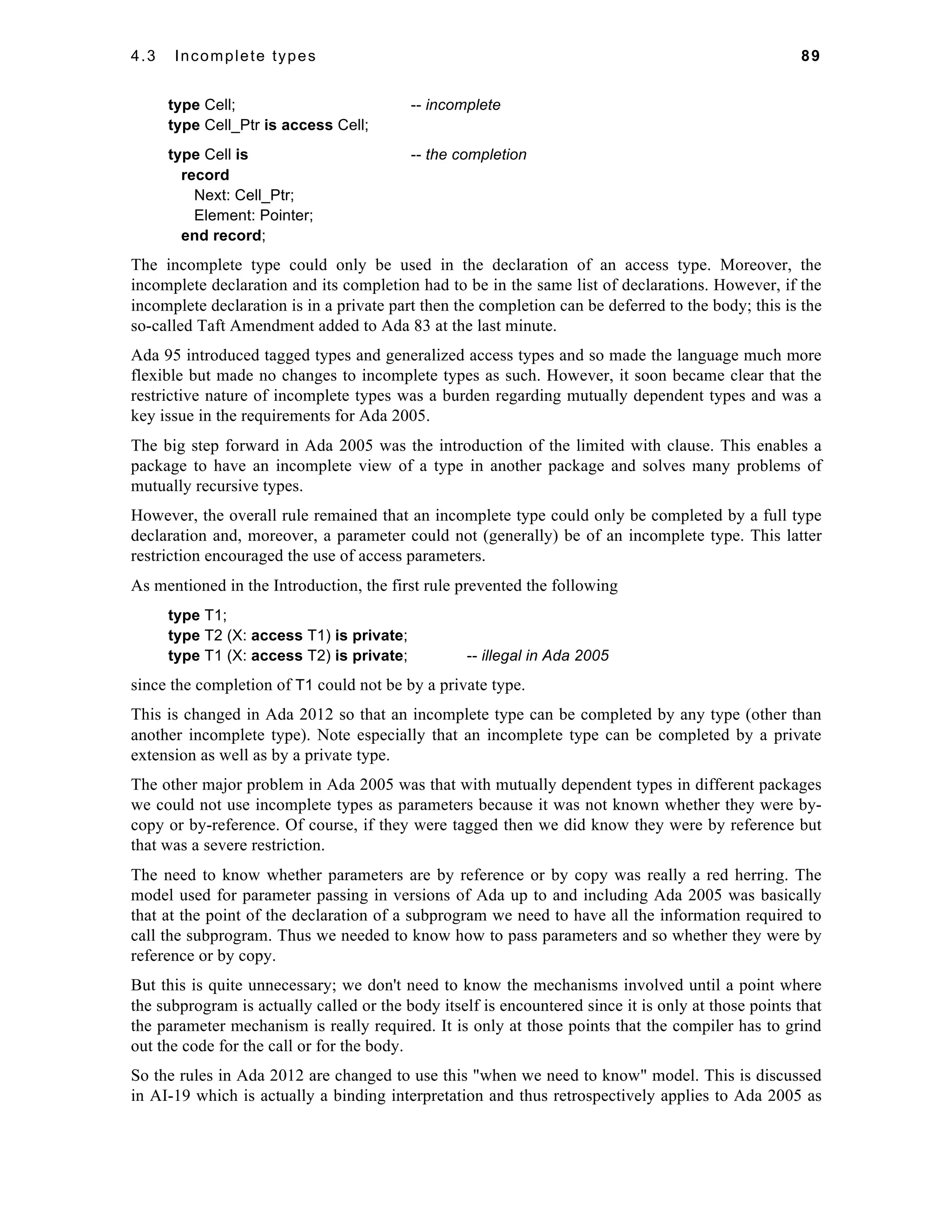
![90 Structure and visibility
well. This is formally expressed by the difference between freezing a subprogram and freezing its
profile. This was motivated by a problem with tagged types whose details need not concern us.
As a highly benevolent consequence, we are allowed to use incomplete types as both parameters and
function results provided that they are fully defined at the point of call and at the point where the
body is defined.
But another consequence of this approach is that we cannot defer the completion of an incomplete
type declared in a private part to the corresponding body. In other words, parameters of an
incomplete type are allowed provided the Taft Amendment is not used for completing the type.
The other exciting change regarding incomplete types is that in Ada 2012 they are allowed as
generic parameters. In Ada 2005 the syntax is
formal_type_declaration ::=
type defining_identifier [discriminant_part] is formal_type_definition ;
whereas in Ada 2012 we have
formal_type_declaration ::=
formal_complete_type_declaration
| formal_incomplete_type_declaration
formal_complete_type_declaration ::=
type defining_identifier [discriminant_part] is formal_type_definition ;
formal_incomplete_type_declaration ::=
type defining_identifier [discriminant_part] [is tagged] ;
So the new kind of formal generic parameter has exactly the same form as the declaration of an
incomplete type. It can be simply type T; or can require that the actual be tagged by writing type T
is tagged; – and in both cases a discriminant can be given.
A formal incomplete type can then be matched by any appropriate incomplete type. If the formal
specifies tagged, then so must the actual. If the formal does not specify tagged then the actual
might or might not be tagged. Of course, a formal incomplete type can also be matched by an
appropriate complete type. And also, in all cases, any discriminants must match as well.
An example of the use of a formal incomplete type occurs in the package Ada.Iterator_Interfaces
whose generic formal part is
generic
type Cursor;
with function Has_Element(Position: Cursor) return Boolean;
package Ada.Iterator_Interfaces is ...
The formal type Cursor is incomplete and can be matched by an actual incomplete type. The details
of this package will be described in Section 6.3 on Iteration.
Another example is provided by a signature package as mentioned in the Introduction. We can write
generic
type Element;
type Set;
with function Empty return Set is <>;
with function Unit(E: Element) return Set is <>;
with function Union(S, T: Set) return Set is <>;
with function Intersection(S, T: Set) return Set is <>;](https://image.slidesharecdn.com/ada2012rationale-141002094233-phpapp01/75/Ada2012-Rationale-100-2048.jpg)

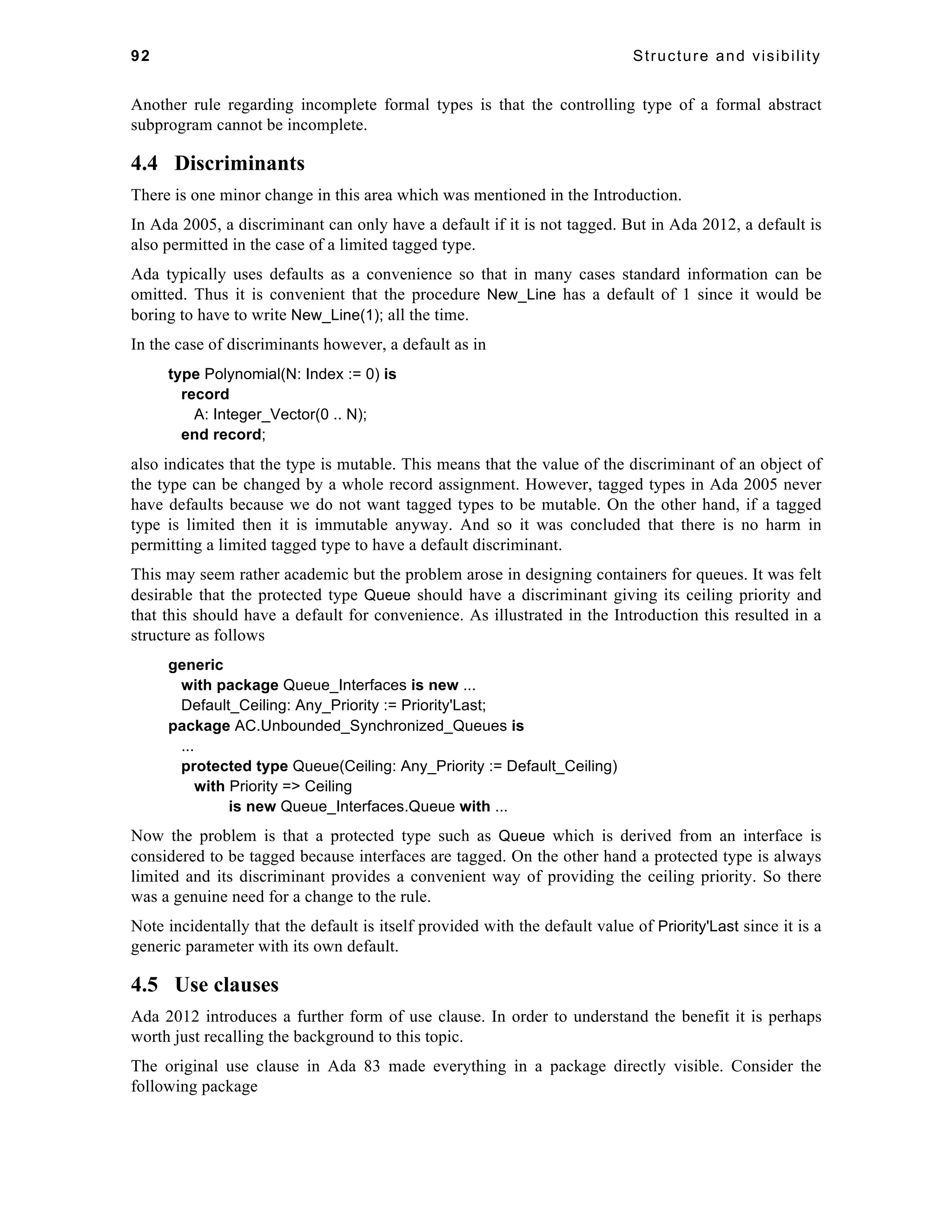

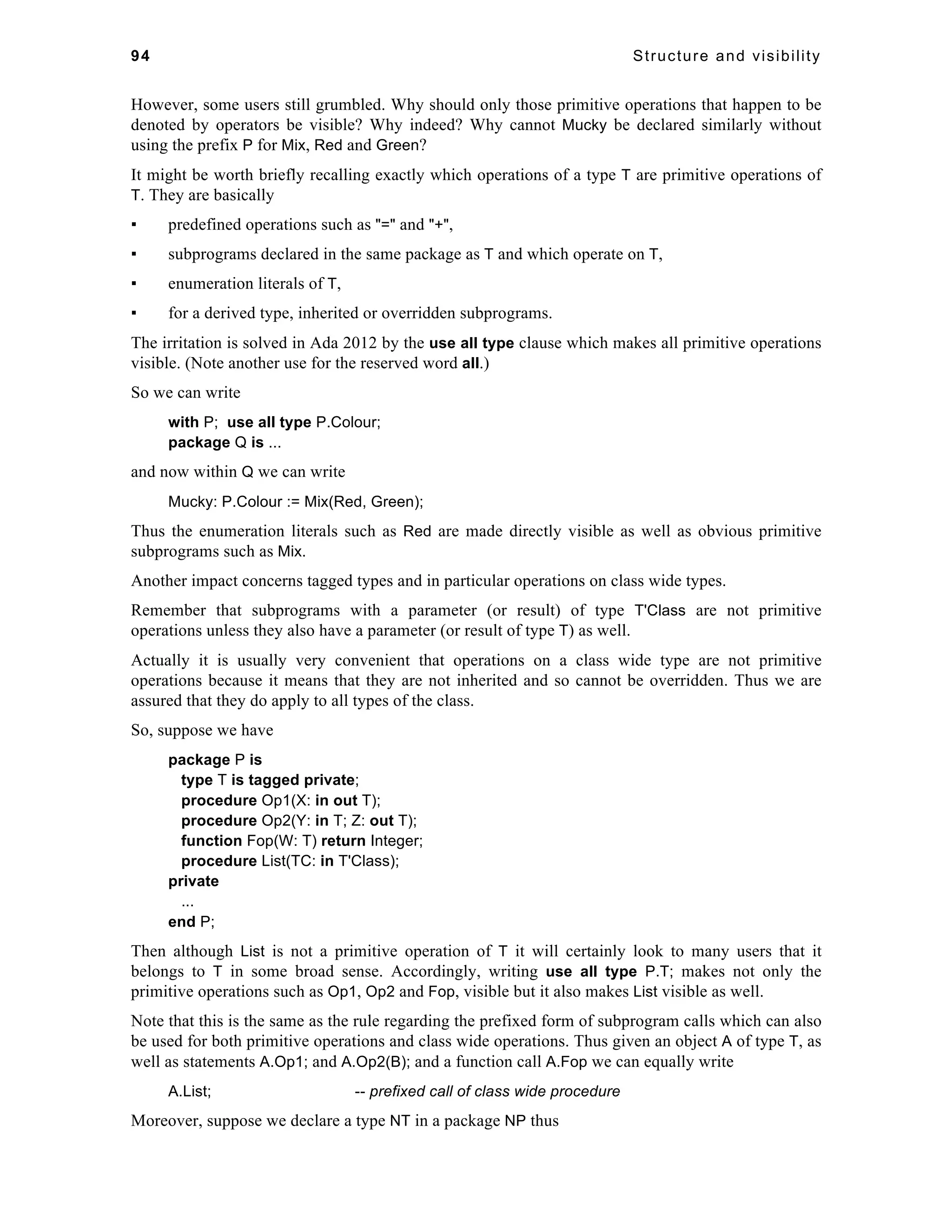
![4.5 Use clauses 95
package NP is
type NT is new T with ...
...
end NP;
If we have an object AN of type NT then not only can we use prefixed calls for inherited and
overridden operations but we can also use prefixed calls for class wide operations in ancestor
packages such as P. So we can write
AN.List; -- prefixed call of List in ancestor package
Similarly, writing use all type NP.NT; on Q makes the inherited (or overridden) operations Op1,
Op2 and Fop visible and also makes the class wide operation List declared in P visible. We do not
also have to write use all type P.T; on Q as well.
We conclude by remarking that the maintenance problem of name clashes really only applies to use
package clauses. In the case of use type and use all type clauses, the entities made visible are
overloadable and a clash only occurs if two have the same profile which is very unlikely and almost
inevitably indicates a bug.
4.6 Extended return statements
The final topic in this chapter is the extended return statement. This was introduced in Ada 2005
largely to solve problems with limited types. However, some glitches have come to light and these
are corrected in Ada 2012.
A description of the reasons for and general properties of the extended return statement will be
found in [15].
The syntax for extended return statement in Ada 2005 as found in [5] is
extended_return_statement ::=
return defining_identifier: [aliased] return_subtype_indication [:= expression] [do
handled_sequence_of_statements
end return] ;
Before going further, it should be mentioned that there was some confusion regarding limited types
and so the term immutably limited was introduced in the course of the maintenance of Ada 2005.
There were various problems. Basically, limitedness is a property of a view of a type. Thus even in
Ada 83 a private type might be limited but the full view found in the private part would not be
limited. Ada 95 introduced explicitly limited types. Ada 2005 introduced coextensions and these
could even include such obviously limited things as task types thus adding a limited part to what
was otherwise a seemingly nonlimited type. It became clear that it was necessary to introduce a term
which meant that a type was really and truly limited and could not subsequently become nonlimited
for example in a private part or in a child unit. So a type is immutably limited if
▪ it is an explicitly limited record type,
▪ it is a task type, protected type or synchronized interface,
▪ it is a non-formal limited private type that is tagged or has an access discriminant with a
default expression,
▪ it is derived from an immutably limited type.
It was then realised that there were problems with extended return statements containing an explicit
aliased. Consequently, it was decided that there was really no need for aliased if there was a rule
that immutably limited return objects were implicitly aliased. So aliased was removed from the
syntax. However, some users had already written aliased and this would have introduced an](https://image.slidesharecdn.com/ada2012rationale-141002094233-phpapp01/75/Ada2012-Rationale-105-2048.jpg)
![96 Structure and visibility
irritating incompatibility. So finally it was decided that aliased could be written but only if the type
were immutably limited.
Another small problem concerned constants. Thus we might write
return X: T do
... -- compute X
end return;
However, especially in the case of a limited type LT, we might also give the return object an initial
value, thus
return X: LT := (A, B, C) do
... -- other stuff
end return;
Now it might be that although the type as a whole is limited one or more of its components might
not be and so could be manipulated in the sequence of statements. But if we want to ensure that this
does not happen, it would be appropriate to indicate that X were constant. But, almost surely by an
oversight, we cannot do that since it is not permitted by the syntax. So the syntax needed changing
to permit the addition of constant.
To aid the description the syntax in Ada 2012 is actually written as two productions as follows
extended_return_object_declaration ::=
defining_identifier: [aliased] [constant] return_subtype_indication [:= expression]
extended_return_statement ::=
return extended_return_object_declaration [do
handled_sequence_of_statements
end return] ;
The other small change to the extended return statement concerns the subtype given in the profile of
the function and that in the extended return statement itself. The result type of the function can be
constrained or unconstrained but that given in the extended return statement must be constrained.
This can be illustrated by considering array types. (These examples are from [15].) Suppose we have
type UA is array (Integer range <>) of Float;
subtype CA is UA(1 .. 10);
then we can write
function Make( ... ) return CA is
begin
...
return R: UA(1 .. 10) do -- statically matches
...
end return;
end Make;
This is allowed because the subtypes statically match.
If the subtype in the function profile is unconstrained then the result must be constrained either by
its subtype or by its initial value. For example
function Make( ... ) return UA is
begin
...
return R: UA(1 .. N) do](https://image.slidesharecdn.com/ada2012rationale-141002094233-phpapp01/75/Ada2012-Rationale-106-2048.jpg)


![99
5 Tasking and Real-Time
This chapter describes various improvements in the tasking and real-time areas for Ada
2012.
The most important is perhaps the recognition of the need to provide control over task
allocation on multiprocessor architectures.
There are also various improvements to the scheduling mechanisms and control of budgets
with regard to interrupts.
An interesting addition to the core language is the ability to specify restrictions on how a
procedure of a synchronized interface is to be implemented.
5.1 Overview of changes
The WG9 guidance document [1] identifies real-time systems as an important application area for
Ada. In particular it says that attention should be paid to
improving the capabilities of Ada on multicore and multiprocessor architectures.
Ada 2012 does indeed address the issues of multiprocessors as well as other real-time
improvements.
The following Ada Issues cover the relevant changes and are described in detail in this chapter:
30 Requeue on synchronized interfaces
117 Memory barriers and Volatile objects
166 Yield for non-preemptive dispatching
167 Affinities for programs on multiprocessor platforms
168 Extended suspension objects
169 Group budgets for multiprocessors
170 Monitoring time spent in interrupt handlers
171 Pragma CPU and Ravenscar profile
174 Implement task barriers in Ada
215 Pragma Implemented should be an aspect
278 Set_CPU called during a protected action
These changes can be grouped as follows.
First there are a number of improvements and additions to the scheduling mechanisms (166, 168,
174). These are in the Real-Time Systems annex (D).
A number of additions recognise the importance of the widespread introduction of multiprocessors
and provide mechanisms for associating tasks with particular CPUs or groups of CPUs known as
dispatching domains (167, 171, 278). There is an associated change to group budgets which were
introduced in Ada 2005 (169). These changes also concern Annex D.
Other changes concerning budgets relate to the time spent in interrupt handlers (170). In some
systems it may be possible to account for time spent in individual interrupts whereas in others it
might only be possible to account for time spent in interrupts as a whole. Again these changes
concern Annex D.](https://image.slidesharecdn.com/ada2012rationale-141002094233-phpapp01/75/Ada2012-Rationale-109-2048.jpg)
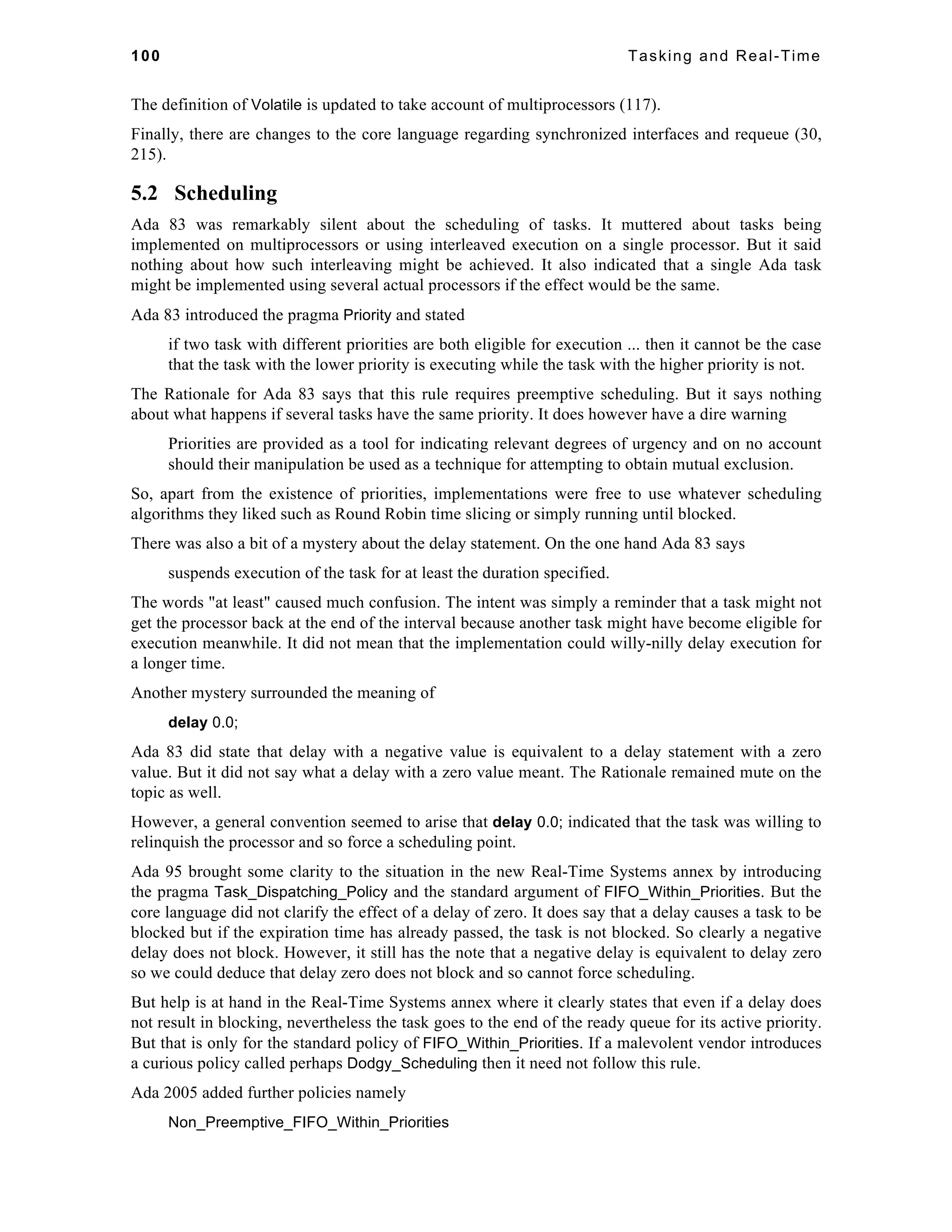

![102 Tasking and Real-Time
...
end Ada.Synchronous_Task_Control;
The state of a suspension object can be set by calls of Set_True and Set_False. The key feature is
that the procedure Suspend_Until_True enables a task to be suspended until the suspension object is
set true by some other task. Thus this provides a neat mechanism for signalling between tasks.
Earliest Deadline First (EDF) scheduling is manipulated by the following child package of
Ada.Dispatching introduced in Ada 2005 (with use clauses added to save space)
with Ada.Real_Time; with Ada.Task_Identification;
use Ada.Real_Time; use Ada.Task_Identification;
package Ada.Dispatching.EDF is
subtype Deadline is Ada.Real_Time.Time;
Default_Deadline: constant Deadline := Time_Last;
procedure Set_Deadline(D: in Deadline; TT: in Task_Id := Current_Task);
procedure Delay_Until_And_Set_Deadline(Delay_Until_Time: in Time;
Deadline_Offset: in Time_Span);
function Get_Deadline(T: Task_Id := Current_Task) return Deadline;
end Ada.Dispatching.EDF;
The procedure Delay_Until_And_Set_Deadline is the key feature. It enables a task to be blocked
until the time given by the parameter Delay_Until_Time and sets the deadline so that it is
Deadline_Offset after that.
But what is missing in Ada 2005 is the ability for a sporadic task triggered by a suspension object to
have its deadline set in a similar manner. This is remedied in Ada 2012 by the addition of the
following child package
with Ada.Real_Time;
package Ada.Synchronous_Task_Control.EDF is
procedure Suspend_Until_True_And_Set_Deadline(S: in out Suspension_Object;
TS: in Ada.Real_Time.Span);
end Ada.Synchronous_Task_Control.EDF;
This enables a task to be blocked until the suspension object S is set true; it then becomes ready with
a deadline of Ada.Real_Time.Clock + TS.
The other new feature concerning scheduling in Ada 2012 is the addition of a package
Ada.Synchronous_Barriers. This enables many tasks to be blocked and to be released together.
The rationale for needing this facility is explained in the AI concerned. As general purpose
computing is moving to parallel architectures and eventually to massively parallel machines, there is
a need to efficiently schedule many tasks using barrier primitives. The POSIX OS interface provides
a barrier primitive where N tasks wait on a barrier and are released simultaneously when all are
ready to execute.
There are many situations where the release of N tasks is required to execute an algorithm in
parallel. Often the calculation is relatively small for each task on each iteration but the number of
tasks is relatively high. As an example consider the solution of partial differential equations where
one task is allocated to each node of a grid; there might easily be several thousand nodes. Such an
example is outlined in [7]. The cost of linearly scheduling and releasing them could remove almost
all gains made through parallelization in the first place.
The new package is](https://image.slidesharecdn.com/ada2012rationale-141002094233-phpapp01/75/Ada2012-Rationale-112-2048.jpg)
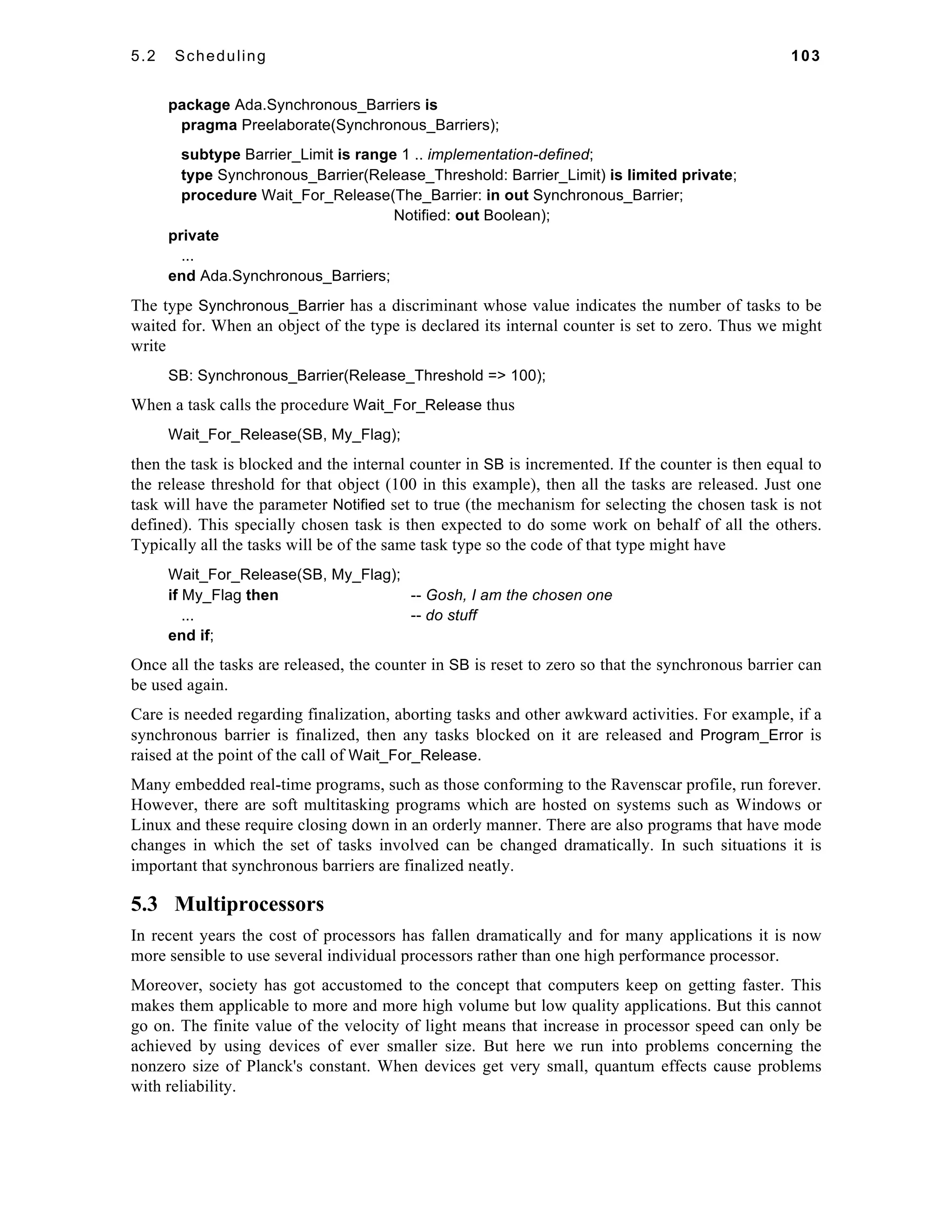

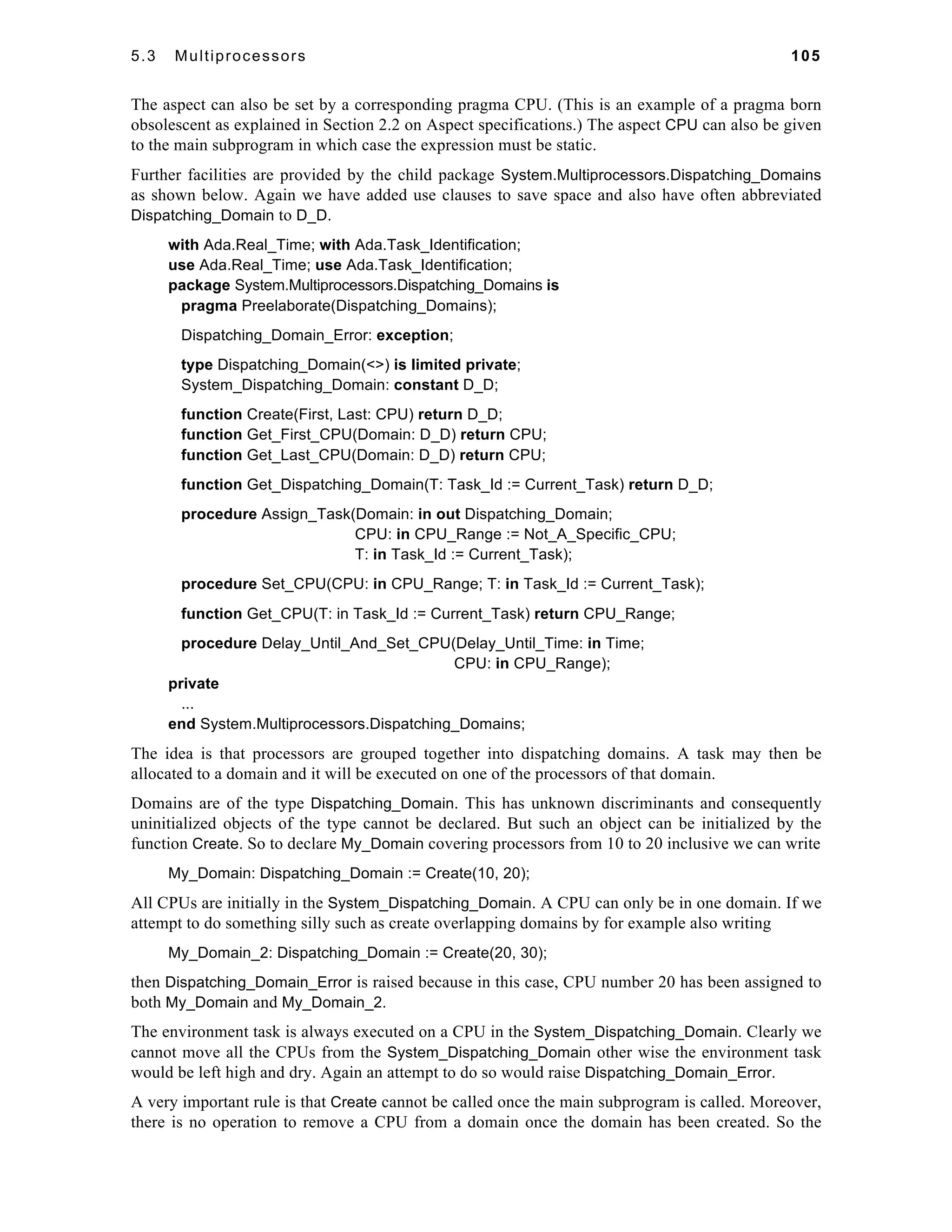
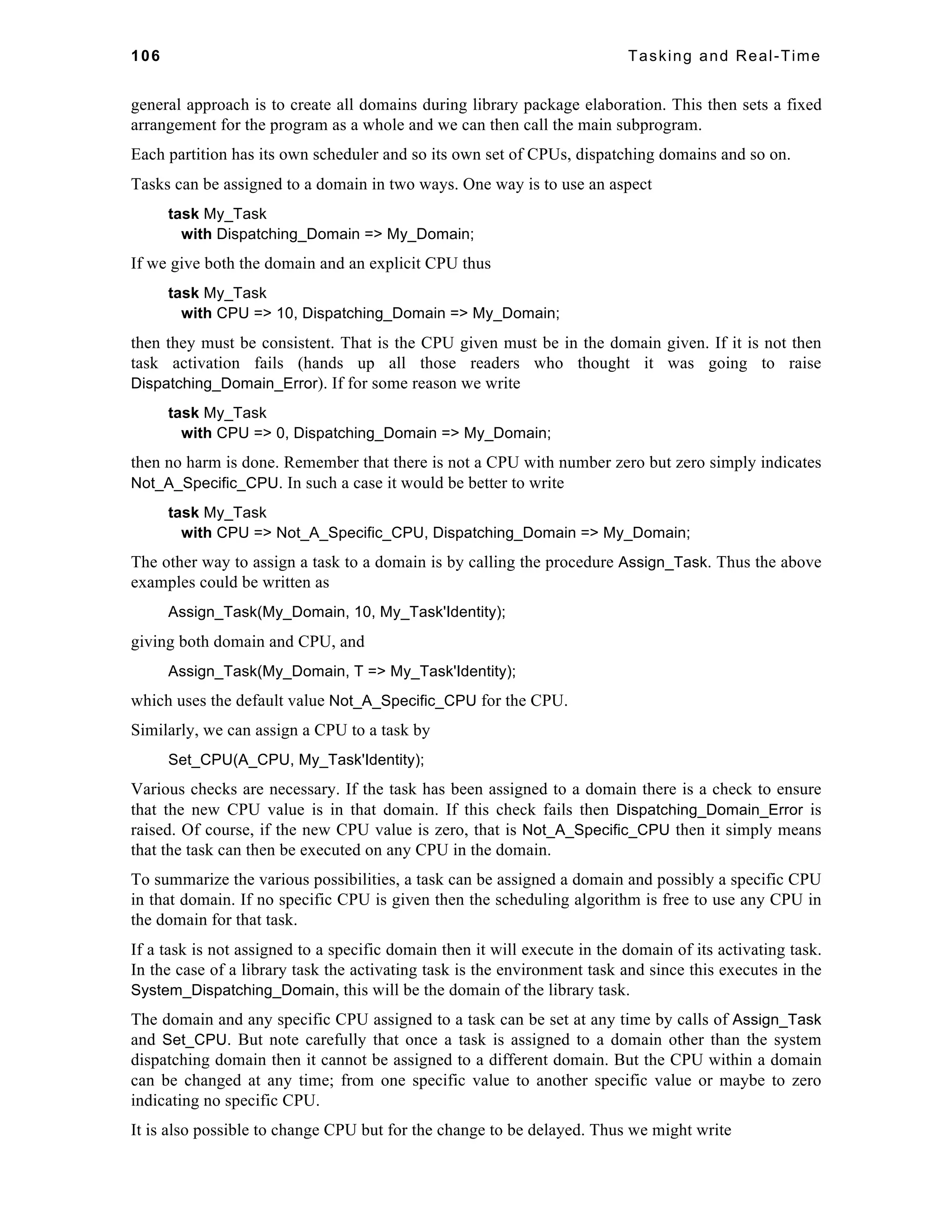
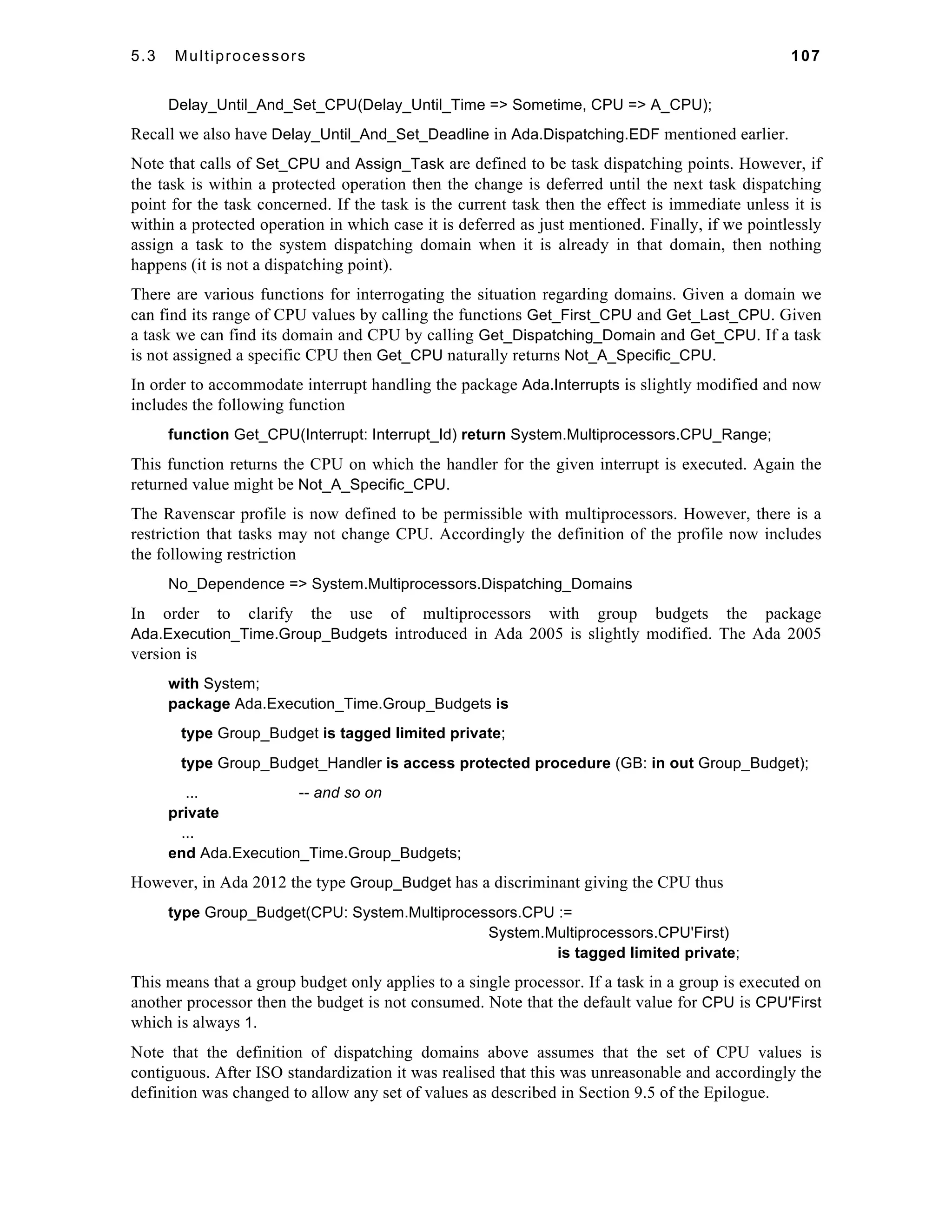
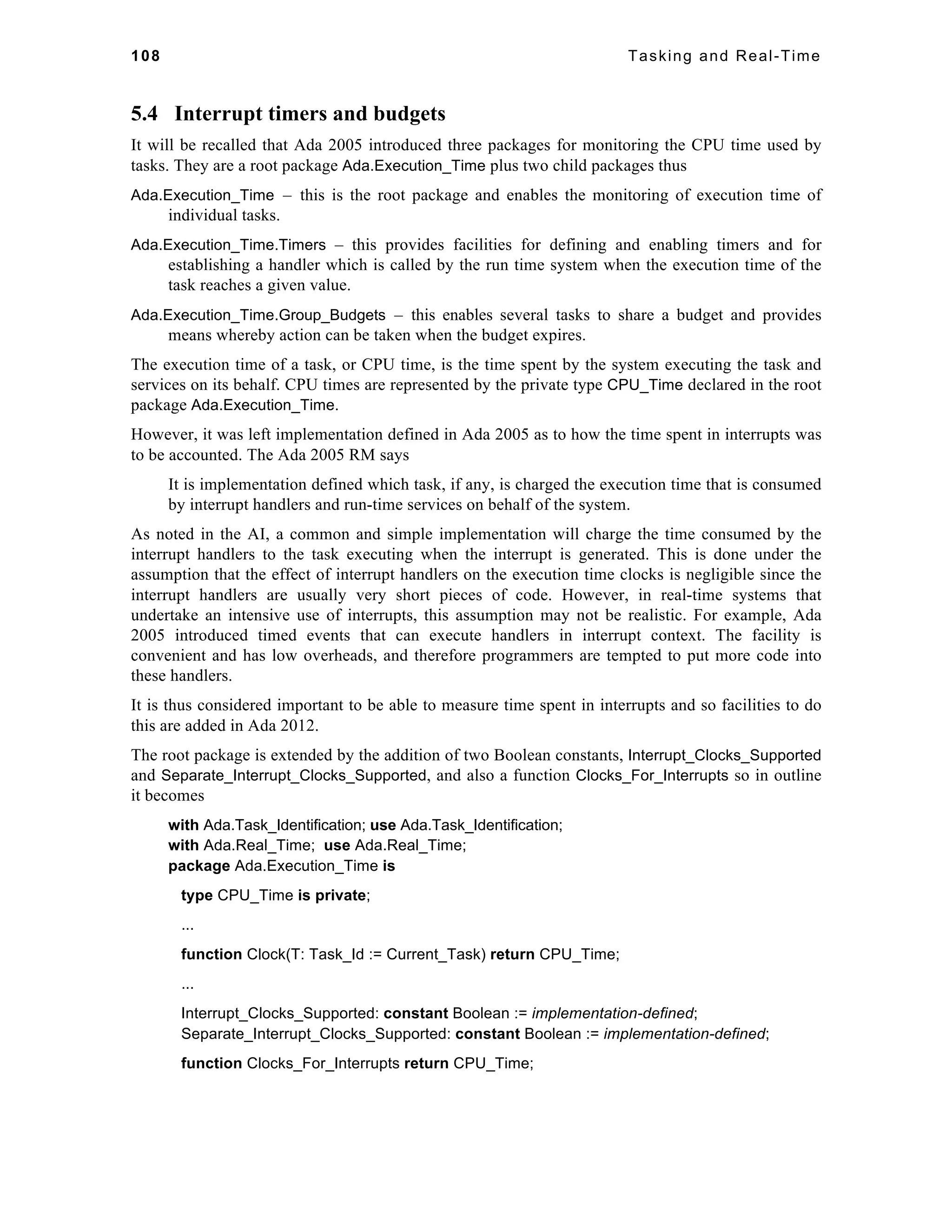


![5.5 Volatile 111
Flag: Boolean
with Atomic; -- Atomic implies Volatile
...
end Common;
where we have given Atomic for Flag. As mentioned above, Atomic implies Volatile so it is not
necessary to give both. However, if we do have to give two aspects, it is much neater that the one
aspect specification does this whereas two distinct pragmas would be necessary.
It is said that this change brings the meaning of volatile into line with that in C. However, it has also
been said that the definition of volatile in C is unclear.
5.6 Synchronized interfaces and requeue
Ada 2005 introduced interfaces of various kinds: limited, nonlimited, synchronized, task, and
protected. These form a hierarchy and in particular task and protected interfaces are forms of
synchronized interfaces. The essence of this was to integrate the OO and real-time features of Ada.
However, a problem was discovered regarding requeue as described in a paper presented at IRTAW
2007 [23].
Some examples of interfaces will be found in [7] or [15] where various implementations of the
readers and writers paradigm are explained.
The operations of a synchronized interface are denoted by subprograms. Thus we might have
package Pkg is
type Server is synchronized interface;
procedure Q(S: in out Server; X: in Item) is abstract;
end Pkg;
We can then implement the interface by a task type or by a protected type. This introduces several
different ways of implementing the operation Q. It can be by an entry, or by a protected procedure or
by a normal procedure. For example using a task type we might have
package TP1 is
task type TT1 is new Server with
-- Q implemented by entry
entry Q(X: in Item);
end TT1;
end TP1;
or
package TP2 is
task type TT2 is new Server with
-- Q implemented by a normal procedure
end TT2;
procedure Q(S: in out TT2; X: in Item);
end TP2;
Similarly using a protected type we might have
package PP1 is
protected type PT1 is new Server with
-- Q implemented by entry
entry Q(X: in Item);
...](https://image.slidesharecdn.com/ada2012rationale-141002094233-phpapp01/75/Ada2012-Rationale-121-2048.jpg)
![112 Tasking and Real-Time
end PT1;
end PP1;
or
package PP2 is
protected type PT2 is new Server with
-- Q implemented by a protected procedure
procedure Q(X: in Item);
...
end PT2;
end PP2;
or
package PP3 is
protected type PT3 is new Server with
-- Q implemented by a normal procedure
...
end PT3;
procedure Q(X: In out PT3; X: in Item);
end PP3;
So the interface Server could be implemented in many different ways. And as usual we could
dispatch to any of the implementations. We could have
Server_Ptr: access Server'Class := ...
...
Server_Ptr.Q(X => An_Item);
and this will dispatch to the implementation of Q concerned.
So a call of Q could end up as a call of an entry in a task, an entry in a protected object, a protected
procedure in a protected object, or an ordinary procedure.
Two curious situations arise. One concerns timed calls. We could write a timed call such as
select
Server_Ptr.Q(An_Item);
or
delay Seconds(10);
end select;
and this will always be acceptable. It will dispatch to the appropriate operation. If it is an entry then
it will be a timed call. But if it is not an entry then no time-out is possible and so by default the call
will always go ahead.
The other curious situation concerns requeue. In this case there is no obvious default action. It is not
possible to requeue a procedure call since there is no queue on which to hang it.
The first proposal to do something about this was simply not to allow requeue at all on interfaces.
And indeed this was the solution adopted in Ada 2005.
However, this is not really acceptable as explained in [23]. The next idea was to raise some
exception if it turned out that the destination was not an entry. But this was considered
unsatisfactory.](https://image.slidesharecdn.com/ada2012rationale-141002094233-phpapp01/75/Ada2012-Rationale-122-2048.jpg)


![115
6 Iterators, Pools, etc.
This chapter describes various improvements in a number of general areas in Ada 2012.
There are some minor but perhaps surprising changes concerning matters such as the
placement of pragmas and labels.
There are important new features regarding indexing and accessing largely introduced to
simplify iterating over containers.
There are also a number of additional Restrictions identifiers many related to the
introduction of aspect specifications.
The functionality of access types and storage management is made more flexible by the
introduction of subpools.
Finally, a number of minor additions and corrections are made to a range of topics such as
generics.
6.1 Overview of changes
The areas mentioned in this chapter are not specifically mentioned in the WG9 guidance document
[1] other than under the request to remedy shortcomings and improve the functionality of access
types and dynamic storage management.
The following Ada Issues cover the relevant changes and are described in detail in this chapter.
6 Nominal subtypes for all names
71 Class-wide operations for formal subprograms
95 Address of intrinsic subprograms
100 Placement of pragmas
111 Subpools, allocators & control of finalization
119 Package Calendar, Daylight Saving Time and UTC_Offset
123 Composability of equality
139 Syntactic sugar for access, containers & iterators
148 Accessibility of anonymous access stand-alone objects
149 Access type conversion and membership
152 Restriction No_Anonymous_Allocators
163 Pragmas in place of null
173 Testing of tags representing abstract types
179 Labels at end of a sequence of statements
189 Restriction No_Standard_Allocators_After_Elaboration
190 Global storage pool control
193 Alignment of allocators
212 Accessors and iterators for Ada.Containers
241 Aspect-related restrictions](https://image.slidesharecdn.com/ada2012rationale-141002094233-phpapp01/75/Ada2012-Rationale-125-2048.jpg)
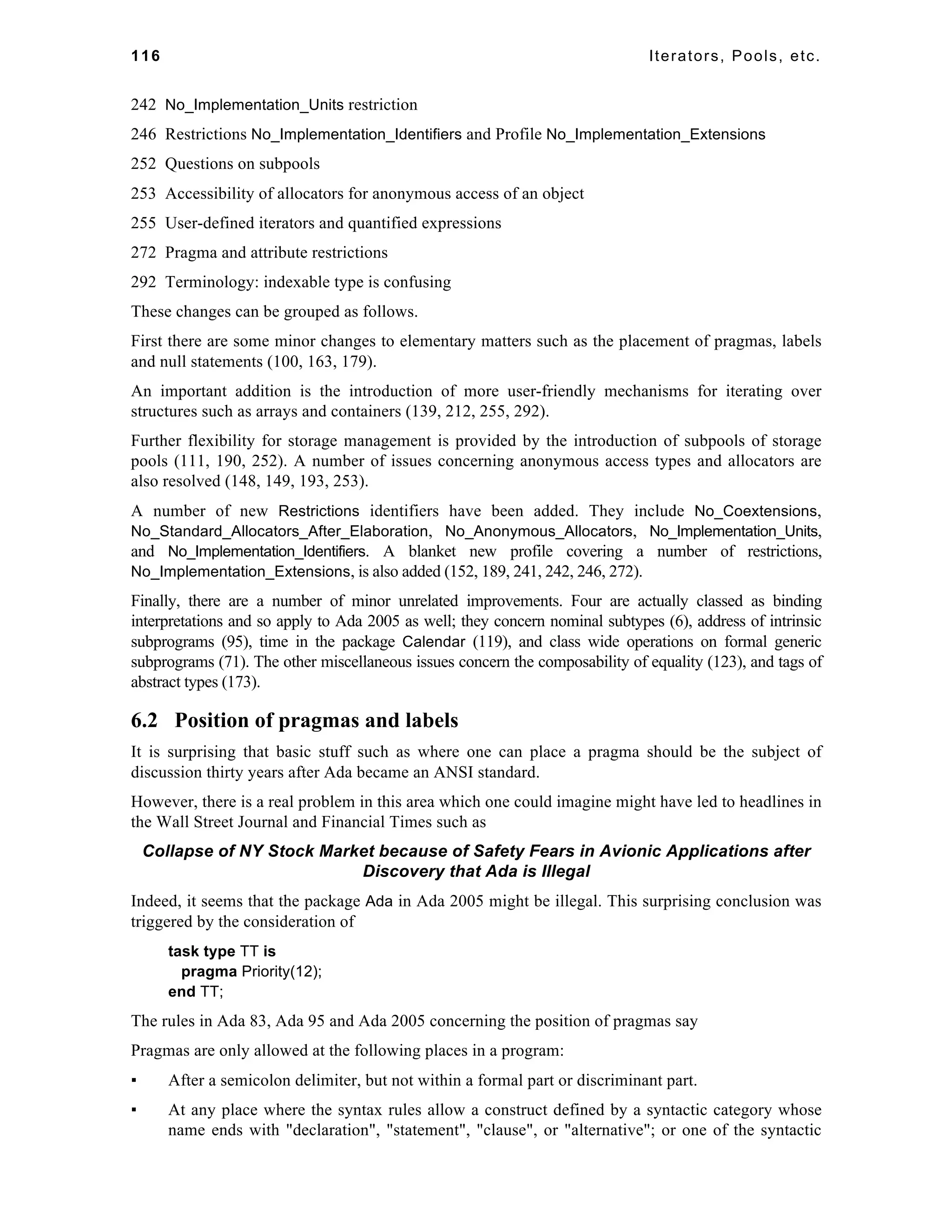
![6.2 Position of pragmas and labels 117
categories variant or exception_handler; but not in place of such a construct. Also at any place
where a compilation_unit would be allowed.
Now the syntax for task_definition in Ada 2005 is
task_definition ::=
{task_item}
[private
{task_item}]
end [task_identifier]
There are at least two problems. The key one here is that the list of categories in the rule does not
include "item". The other concerns the words "not in place of". It seems that the intent was that if at
least one instance of the construct is required (as in a sequence of statements) then the pragma
cannot be given in place of a single statement. So it looks as if the task type TT is not legal.
It has probably been permitted because task_item itself splits down into aspect_clause or
entry_declaration and they seem to be allowed. But if none is present then we cannot tell which
category is permitted!
Note rather scarily that the package Ada is given as
package Ada is
pragma Pure(Ada);
end Ada;
and the same problem applies.
The entities in a package specification are of the category basic_declarative_item and again although
it splits down into things ending _clause or _declaration we don't know which.
The fear concerning package Ada made one member of the ARG concerned that the sky might be
falling in. Of course, we don't ever have to submit a package Ada in our file (on punched cards,
paper tape or whatever media we are using). The package Ada is just in the mind of the compiler so
that it behaves as if she were declared. The same applies to Standard. They are sort of synthesized
and not actually declared.
Anyway, the upshot is that in Ada 2012, the description of the placement of pragmas is corrected by
adding "item" to the list and clarifying the meaning of not in place of.
A further discussion considered sequences of statements. In a structure such as an if statement the
syntax is
if_statement ::=
if condition then
sequence_of_statements
...
where
sequence_of_statements ::= statement {statement}
The important point is that a sequence_of_statements must have at least one statement. Moreover,
the rules for placing pragmas in Ada 2005 do not allow a pragma in place of a construct so we
cannot write
if B then
pragma Assert( ... ); -- illegal in Ada 2005
else ...](https://image.slidesharecdn.com/ada2012rationale-141002094233-phpapp01/75/Ada2012-Rationale-127-2048.jpg)
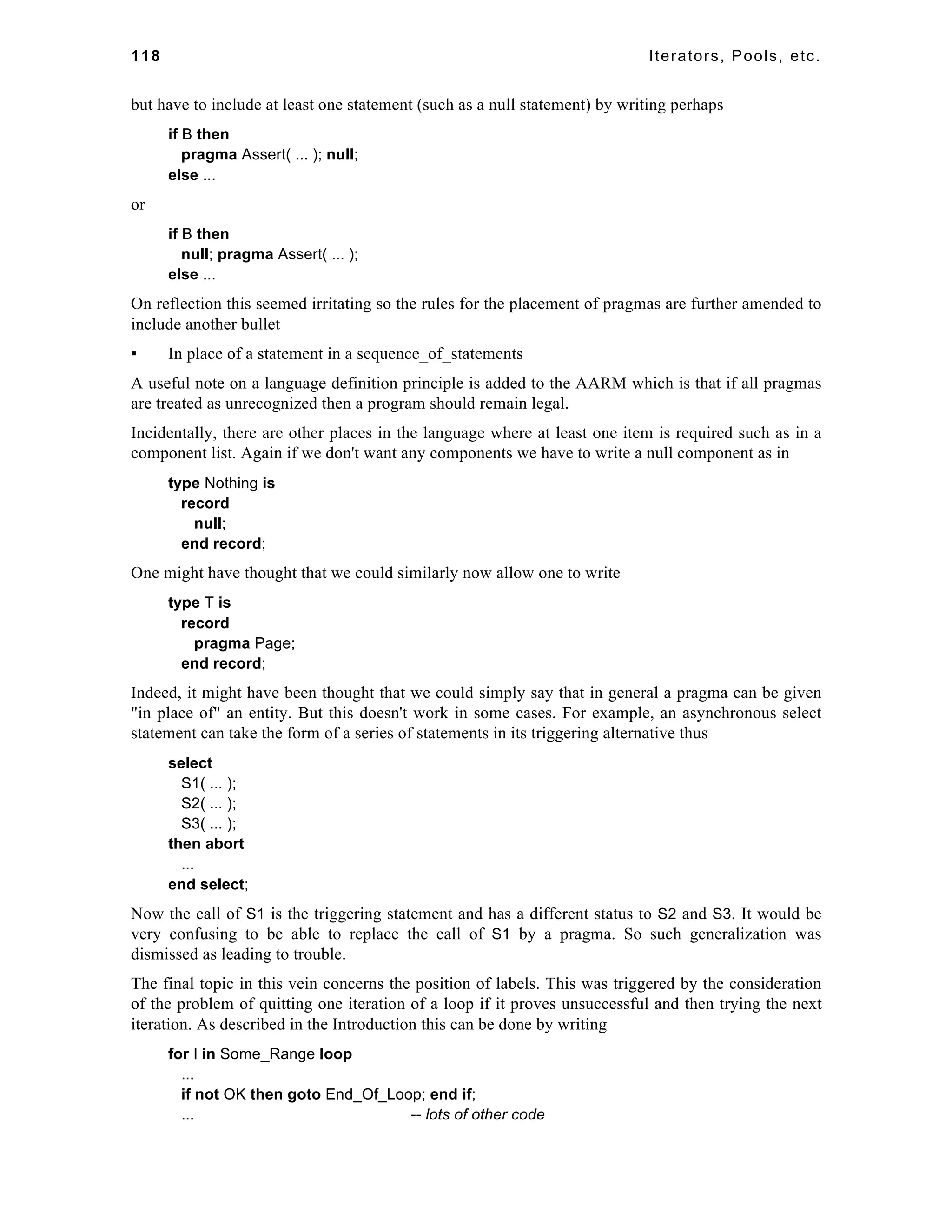
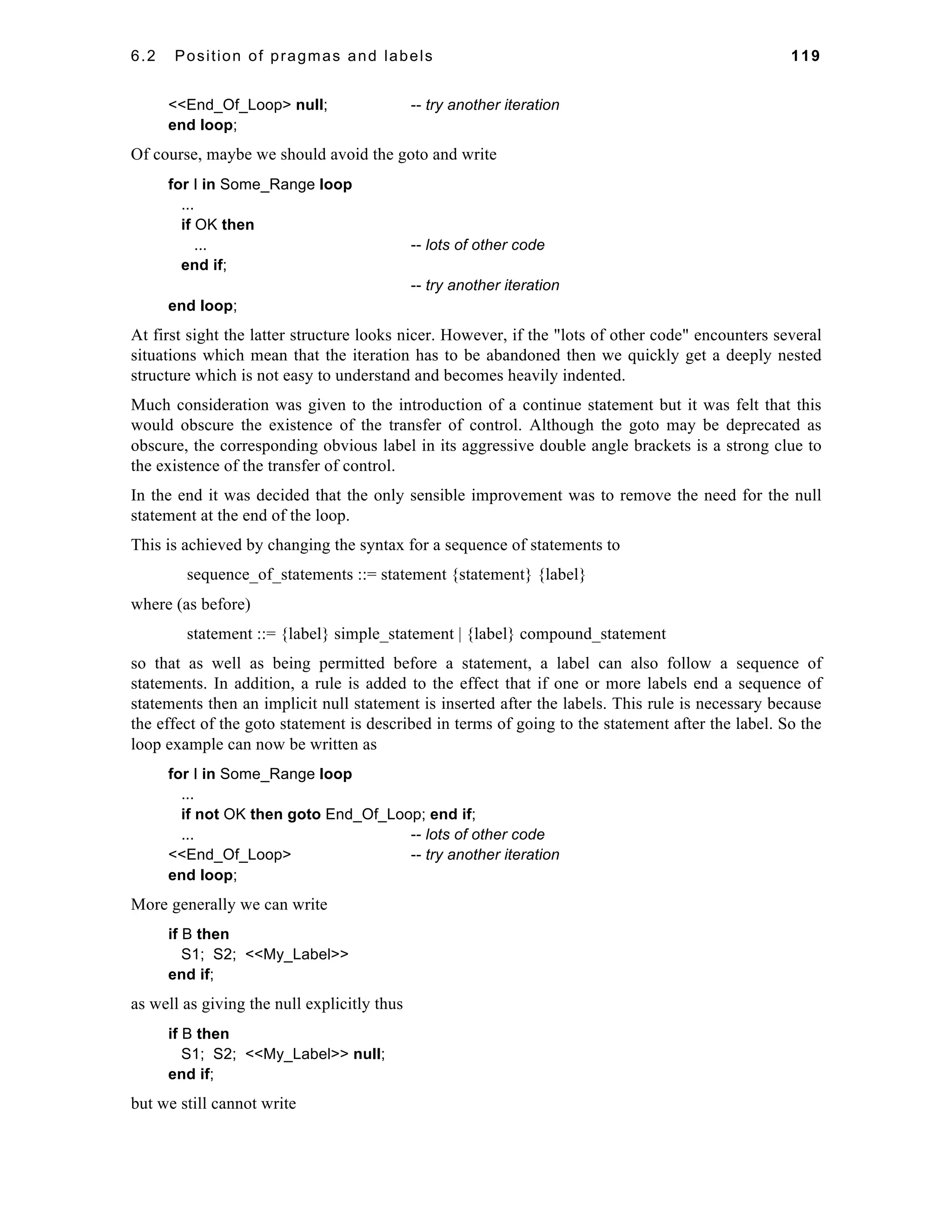
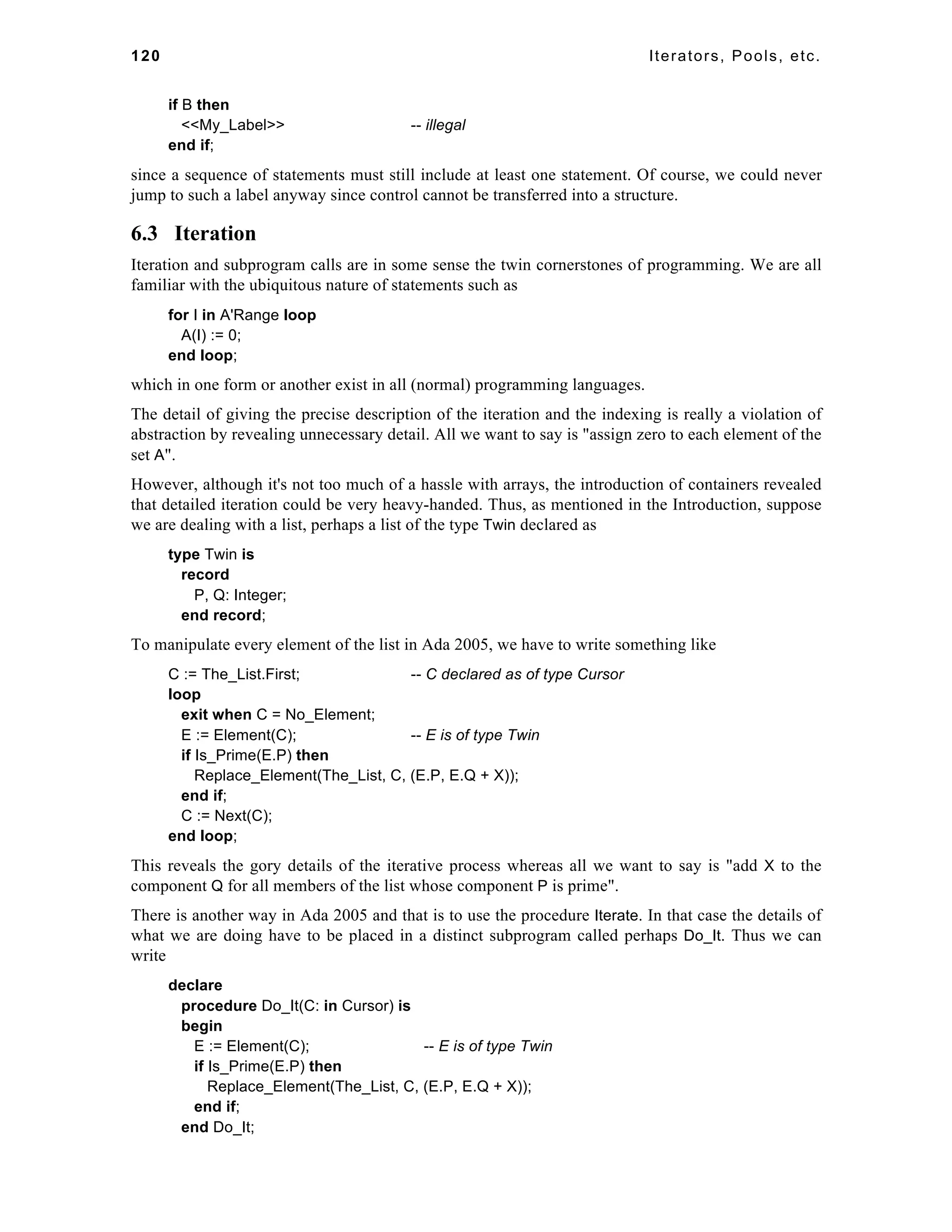
![6.3 Iteration 121
begin
The_List.Iterate(Do_It'Access);
end;
This avoids the fine detail of calling First and Next but uses what some consider to be a heavy
infrastructure.
However, in Ada 2012 we can simply say
for E of The_List loop
if Is_Prime(E.P) then
E.Q := E.Q + X;
end if;
end loop;
Not only is this just five lines of text rather than nine or eleven, the key point is that the possibility
of making various errors of detail is completely removed.
The mechanisms by which this magic abstraction is achieved are somewhat laborious and it is
anticipated that users will take a cookbook approach (show us how to do it, but please don't explain
why – after all, this is the approach taken with boiling an egg, we can do it without deep knowledge
of the theory of coagulation of protein material).
We will start by looking at the process using arrays. Rather than
for I in A'Range loop
if A(I) /= 0 then
A(I) := A(I) + 1;
end if;
end loop;
we can write
for E of A loop
if E /= 0 then
E := E + 1;
end if;
end loop;
In the case of a two-dimensional array, instead of
for I in AA'Range(1) loop
for J in AA'Range(2) loop
A(I, J) := 0.0;
end loop;
end loop;
we can write
for EE of AA loop
EE := 0.0;
end loop;
In Ada 2005 (and indeed in Ada 95 and Ada 83), the syntax for a loop is given by
loop_statement ::= [loop_statement_identifier :]
[iteration_scheme] loop
sequence_of_statements
end loop [loop_identifier] ;](https://image.slidesharecdn.com/ada2012rationale-141002094233-phpapp01/75/Ada2012-Rationale-131-2048.jpg)
![122 Iterators, Pools, etc.
iteration_scheme ::= while condition
| for loop_parameter_specification
loop_parameter_specification ::= defining_identifier in
[reverse] discrete_subtype_definition
This is all quite familiar. In Ada 2012, the syntax for loop_statement remains the same but
iteration_scheme is extended to give
iteration_scheme ::= while condition
| for loop_parameter_specification
| for iterator_specification
Thus the new form iterator_specification is introduced which is
iterator_specification ::=
defining_identifier in [reverse] iterator_name
| defining_identifier [: subtype_indication] of [reverse] iterable_name
The first production defines a generalized iterator whereas the second defines an array component
iterator or a container element iterator. For the moment we will just consider the second production
which has of rather than in. The iterable_name can refer to an array or a container. Suppose it is an
array such as A or AA in the examples above.
We note that we can optionally give the subtype of the loop parameter. Suppose that the type A is
given as
type A is array (index) of Integer;
then the subtype of the loop parameter (E in the example) if not given will just be that of the
component which in this case is simply Integer. If we do give the subtype of the loop parameter then
it must cover that of the component. This could be useful with tagged types.
Note carefully that the loop parameter does not have the type of the index of the array as in the
traditional loop but has the type of the component of the array. So on each iteration it denotes a
component of the array. It iterates over all the components of the array as expected. If reverse is not
specified then the components are traversed in ascending index order whereas if reverse is specified
then the order is descending. In the case of a multidimensional array then the index of the last
dimension varies fastest matching the behaviour of AA in the expanded traditional version as shown
(and which incidentally is the order used in streaming). However, if the array has convention Fortran
then it is the index of the first dimension that varies fastest both in the case of the loop and in
streaming.
There are other obvious rules. If the array A or AA is constant then the loop parameter E or EE is
also constant. So it all works much as expected. But do note carefully the use of the reserved word
of (rather than in) which distinguishes this kind of iteration from the traditional form using an index.
As another array example suppose we have the following
type Artwin is array (1 .. N) of Twin;
The_Array: Artwin;
which is similar to the list example above. In the traditional way we might write
for K in Artwin'Range loop
if Is_Prime(The_Array(K).P) then
The_Array(K).Q := The_Array(K).Q + X;
end if;
end loop;](https://image.slidesharecdn.com/ada2012rationale-141002094233-phpapp01/75/Ada2012-Rationale-132-2048.jpg)
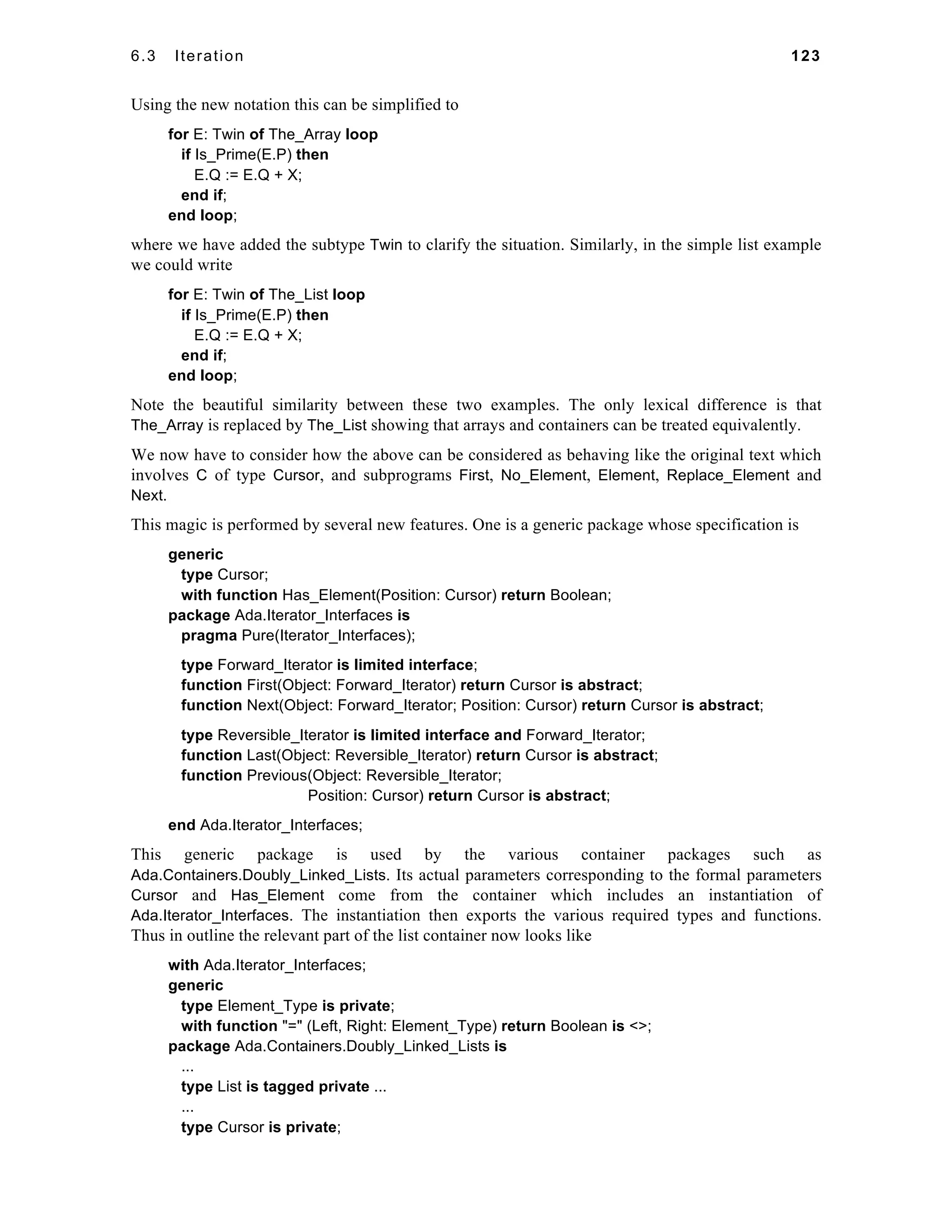
![124 Iterators, Pools, etc.
...
function Has_Element(Position: Cursor) return Boolean;
package List_Iterator_Interfaces is
new Ada.Iterator_Interfaces(Cursor, Has_Element);
...
...
end Ada.Containers.Doubly_Linked_Lists;
The entities exported from the generic package Ada.Iterator_Interfaces are the two interfaces
Forward_Iterator and Reversible_Iterator. The interface Forward_Iterator has functions First and
Next whereas the Reversible_Iterator (which is itself descended from Forward_Iterator) has
functions First and Next inherited from Forward_Iterator plus additional functions Last and Previous.
Note carefully that a Forward_Iterator can only go forward but a Reversible_Iterator can go both
forward and backward. Hence it is reversible and not Reverse_Iterator.
The container packages also contain some new functions which return objects of the type
Reversible_Iterator'Class or Forward_Iterator'Class. In the case of the list container they are
function Iterate(Container: in List) return
List_Iterator_Interfaces.Reversible_Iterator'Class;
function Iterate(Container: in List; Start: in Cursor) return
List_Iterator_Interfaces.Reversible_Iterator'Class;
These are new functions and are not to be confused with the existing procedures Iterate and
Reverse_Iterate which enable a subprogram to be applied to every element of the list but are
somewhat cumbersome to use as shown earlier. The function Iterate with only one parameter is used
for iterating over the whole list whereas that with two parameters iterates starting with the cursor
value equal to Start.
Now suppose that the list container is instantiated with the type Twin followed by the declaration of
a list
package Twin_Lists is
new Ada.Containers.Doubly_Linked_Lists(Element_Type => Twin);
The_List: Twin_Lists.List;
So we have now declared The_List which is a list of elements of the type Twin. Suppose we want to
do something to every element of the list. As we have seen we might write
for E: Twin of The_List loop
... -- do something to E
end loop;
However, it might be wise at this point to introduce the other from of iterator_specification which is
defining_identifier in [reverse] iterator_name
This defines a generalized iterator and uses the traditional in rather than of used in the new array
component and container element iterators. Using this generalized form we can write
for C in The_List.Iterate loop
... -- do something via cursor C
end loop;
In the body of the loop we manipulate the elements using cursors in a familiar way. The reader
might wonder why there are these two styles, one using in and the other using of. The answer is that](https://image.slidesharecdn.com/ada2012rationale-141002094233-phpapp01/75/Ada2012-Rationale-134-2048.jpg)
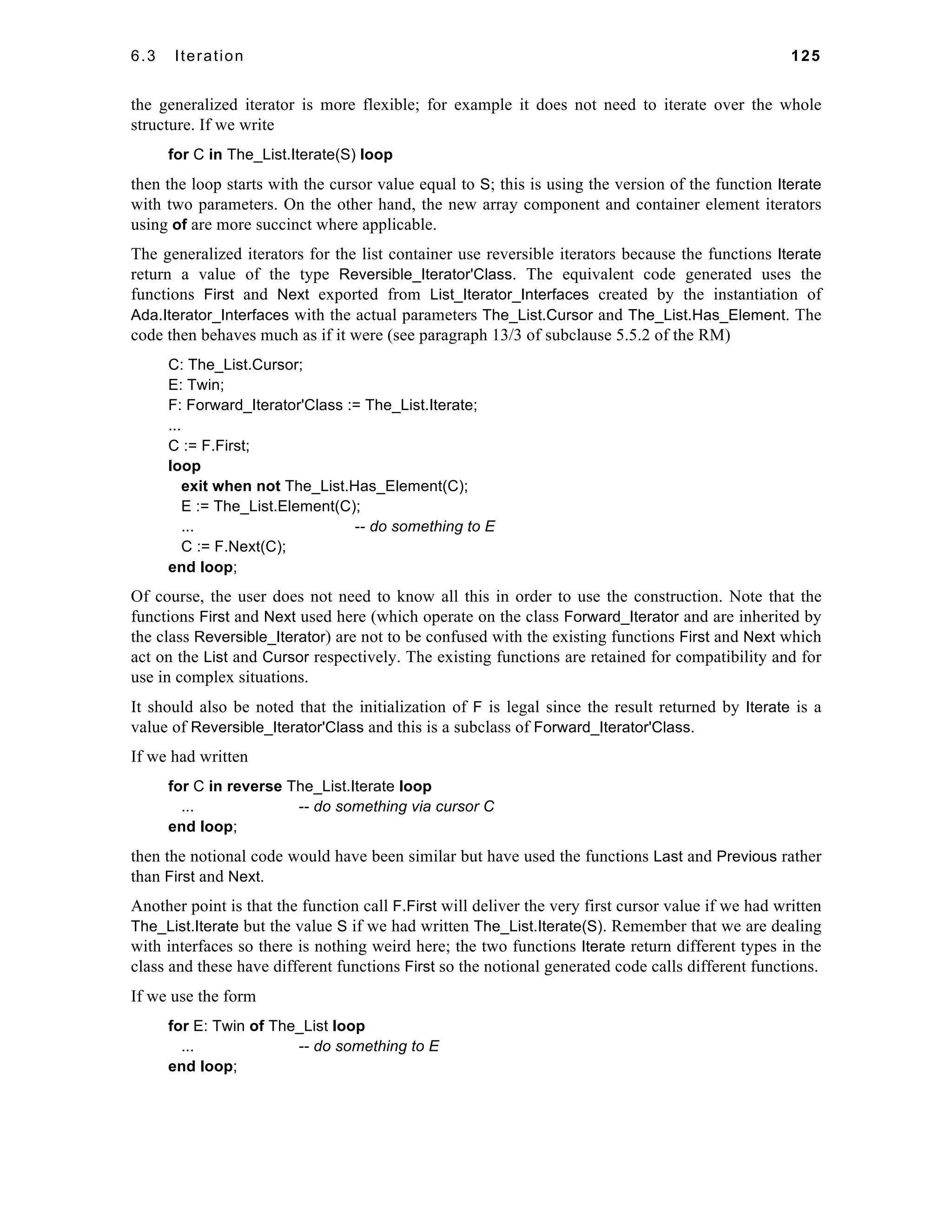
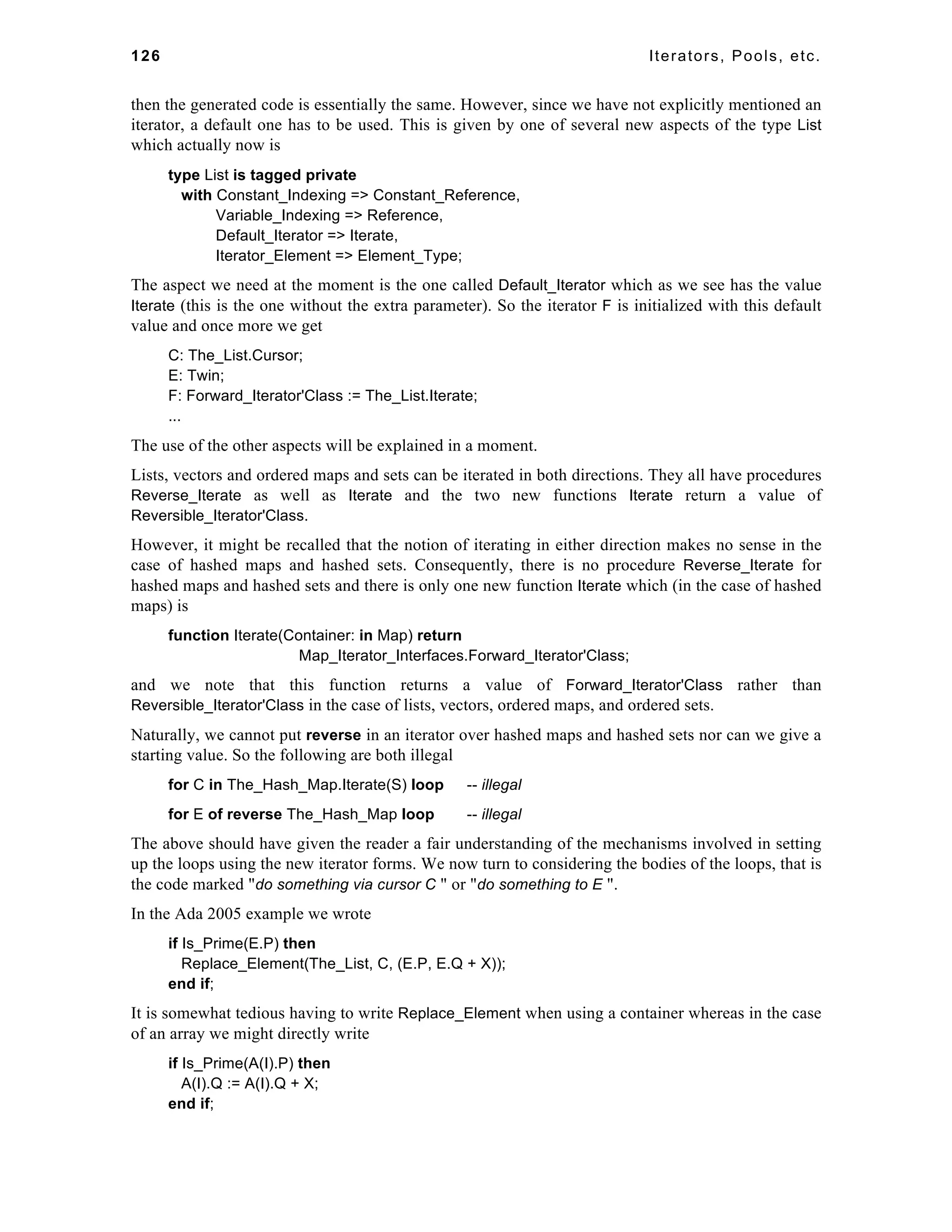
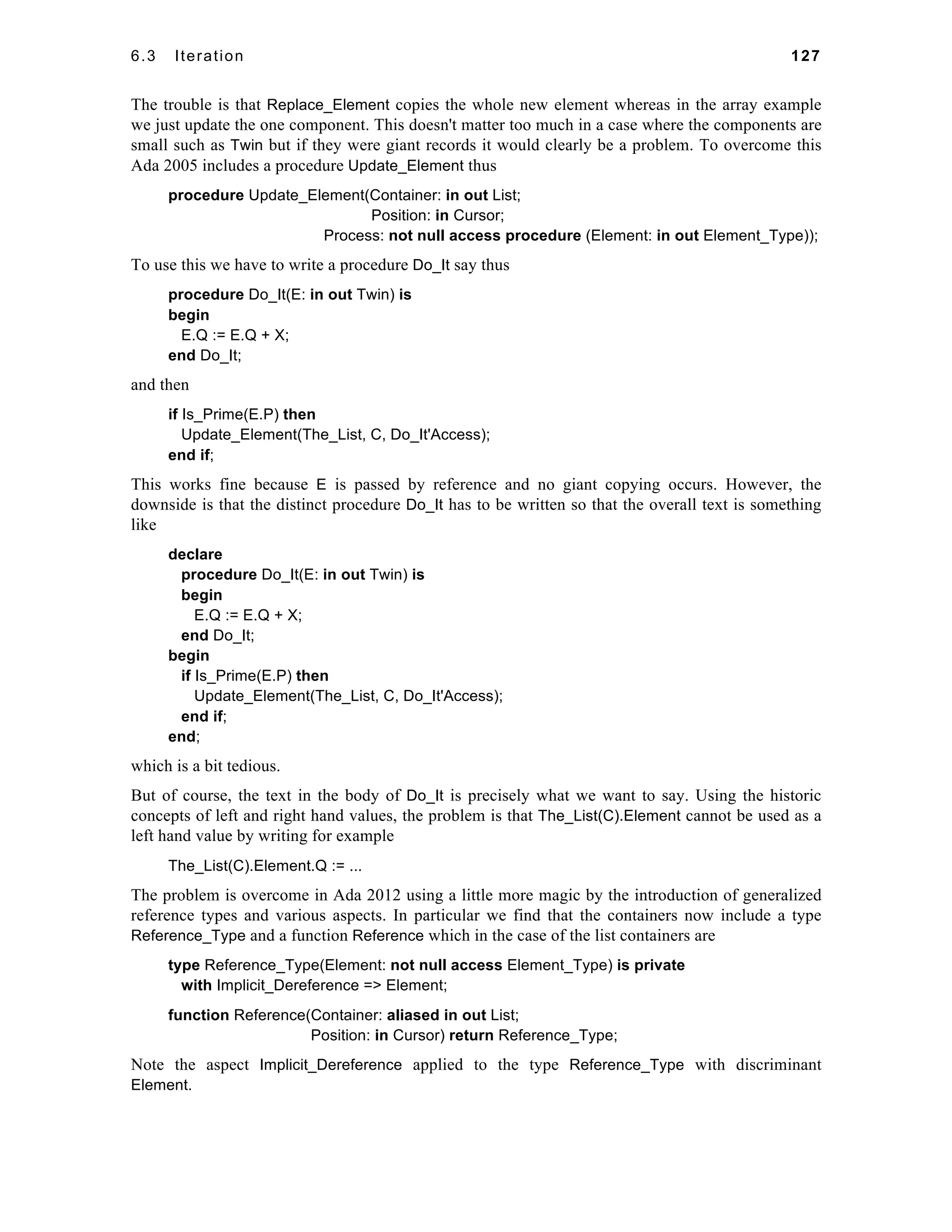
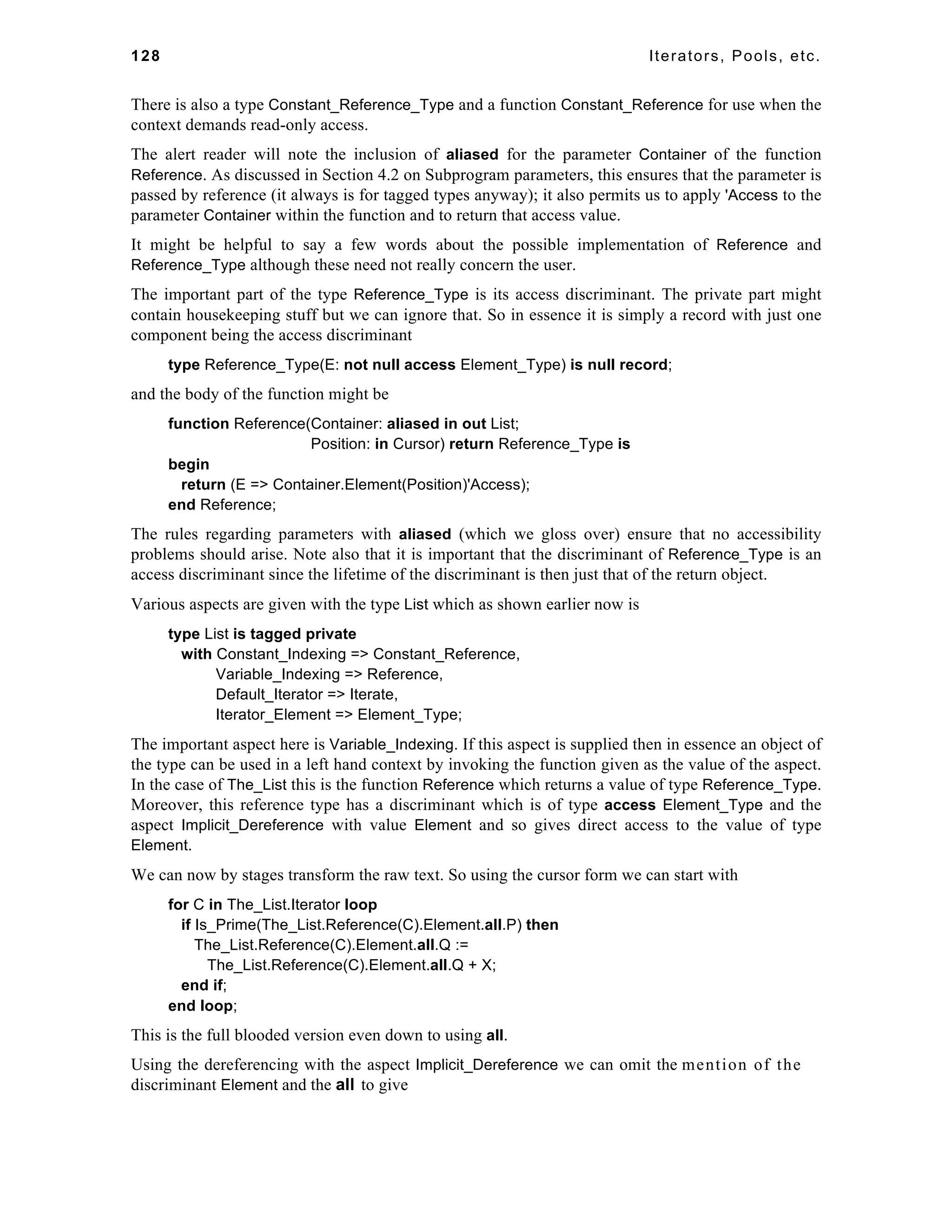
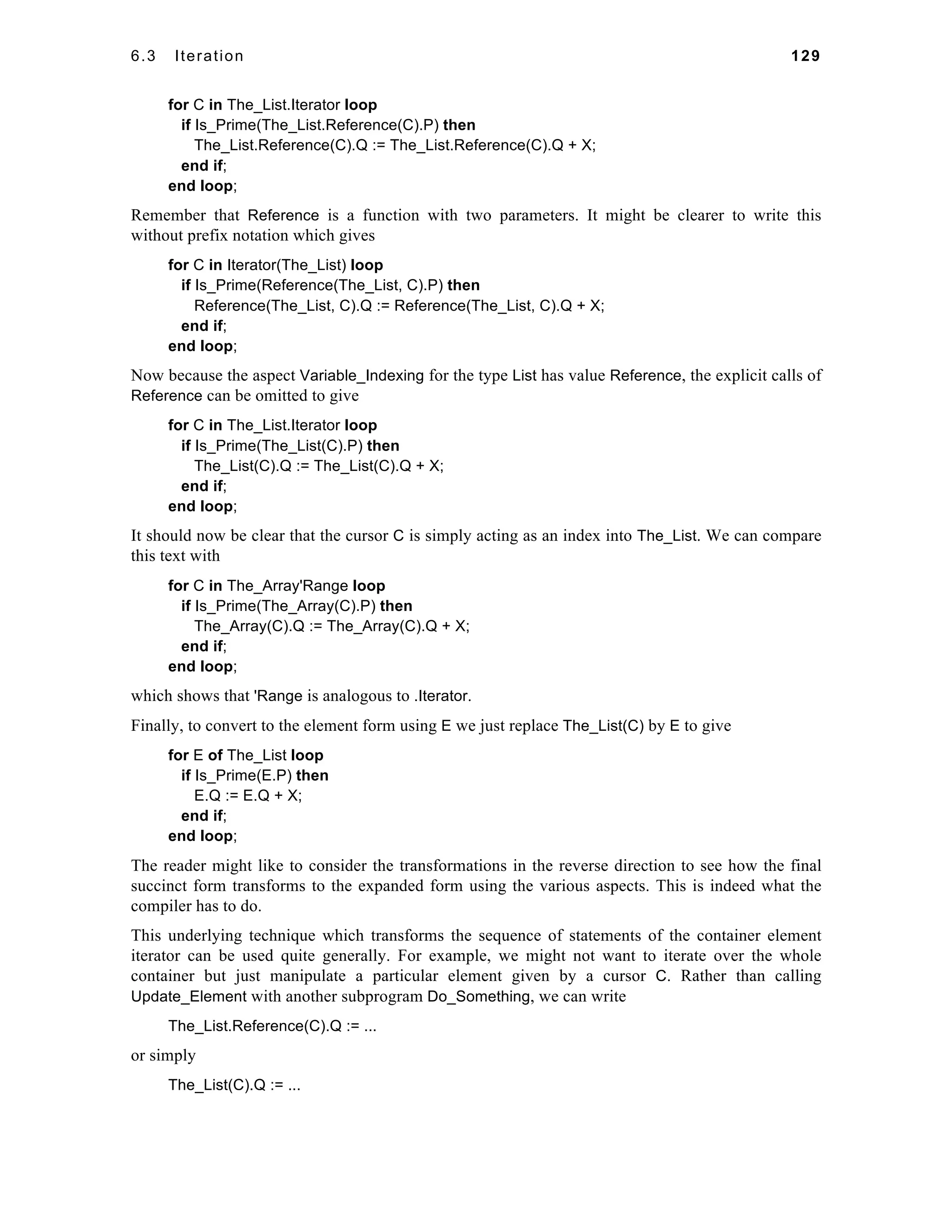
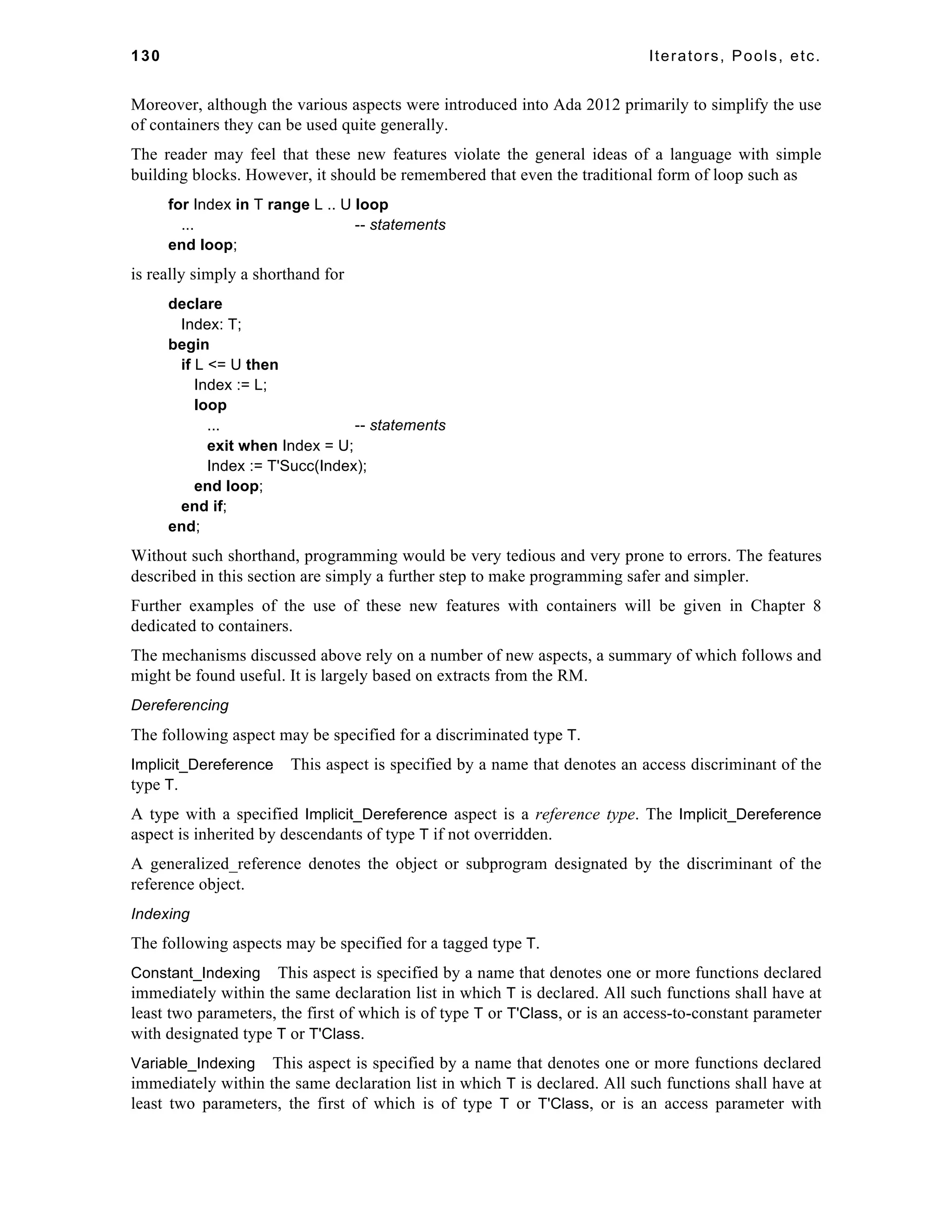
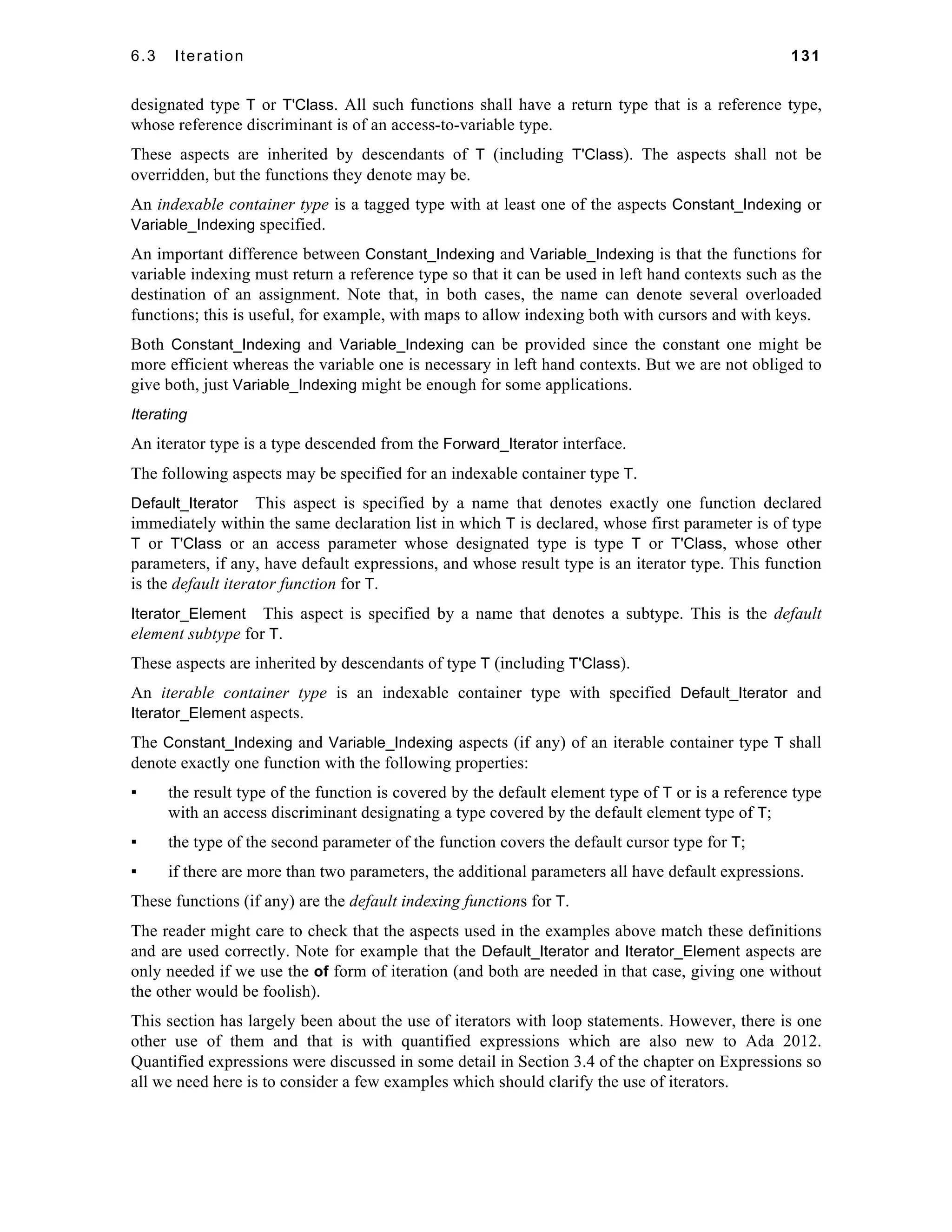

![6.4 Access types and storage pools 133
function Reverse_List(List: access Node) return access Node is
Result: access Node := null;
This_Node: access Node := List;
Next_Node: access Node := null;
begin
while This_Node /= null loop
Next_Node := This_Node.Next;
This_Node.Next := Result; -- access failure in 2005
Result := This_Node;
This_Node := Next_Node;
end loop;
return Result; -- access failure in 2005
end Reverse_List;
This uses the obvious algorithm of working down the list and rebuilding it. However, in Ada 2005
there are two accessibility failures associated with the variable Result. The assignment to
This_Node.Next fails because Result might be referring to something local and we cannot assign
that to a node of the list since the list itself lies outside the scope of Reverse_List. Similarly,
attempting to return the value in Result fails.
The problem with returning a result can sometimes be solved by using an extended return statement
as illustrated in [7]. But this is not a general remedy. The problem is solved in Ada 2012 by treating
stand-alone access objects rather like access parameters so that they carry the accessibility of the last
value assigned to them as part of their value.
Another reason for introducing anonymous access types in Ada 2005 was to reduce the need for
explicit type conversions (note that anonymous access types naturally have no name to use in an
explicit conversion). However, it turns out that in practice it is convenient to use anonymous access
types in some contexts (such as the component Next of type Node) but in other contexts we might
find it logical to use a named access type such as
type List is access Node;
In Ada 2005, explicit conversions are often required from anonymous access types to named general
access types and this has been considered to be irritating. Accordingly, the rule has been changed
in Ada 2012 to say that an explicit conversion is only required if the conversion could fail.
This relaxation covers both accessibility checks and tag checks. For example we might have
type Class_Acc is access all T'Class; -- named general access type
type Rec is
record
Comp: access T'Class; -- anon type
end record;
R: Rec;
and then some code somewhere
Z: Class_Acc;
...
Z := R.Comp; -- OK in Ada 2012
The conversion from the anonymous type of Comp to the named type Class_Acc of Z on the
assignment to Z cannot fail and so does not require an explicit conversion whereas it did in Ada
2005. However, a conversion from a stand-alone access object or an access parameter always](https://image.slidesharecdn.com/ada2012rationale-141002094233-phpapp01/75/Ada2012-Rationale-143-2048.jpg)
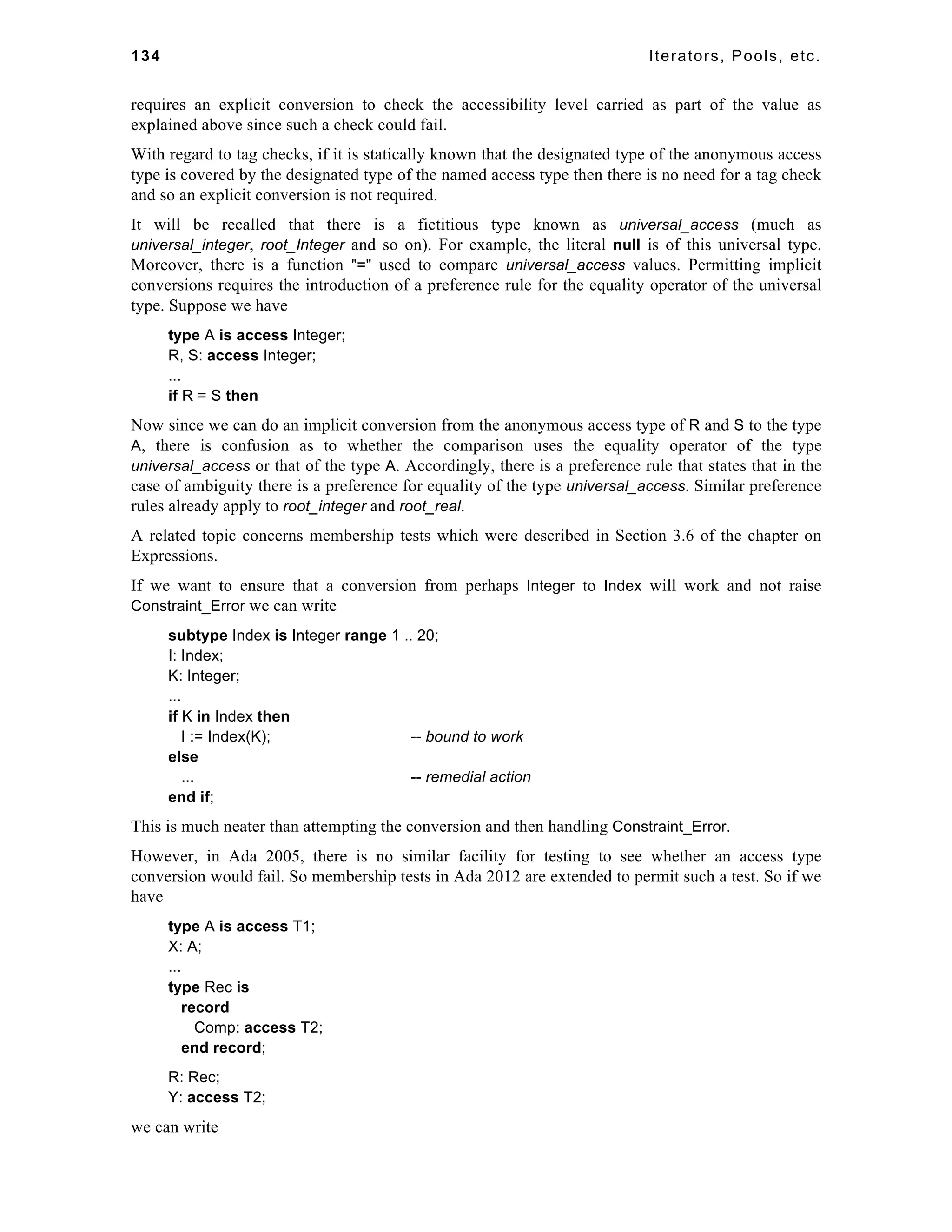

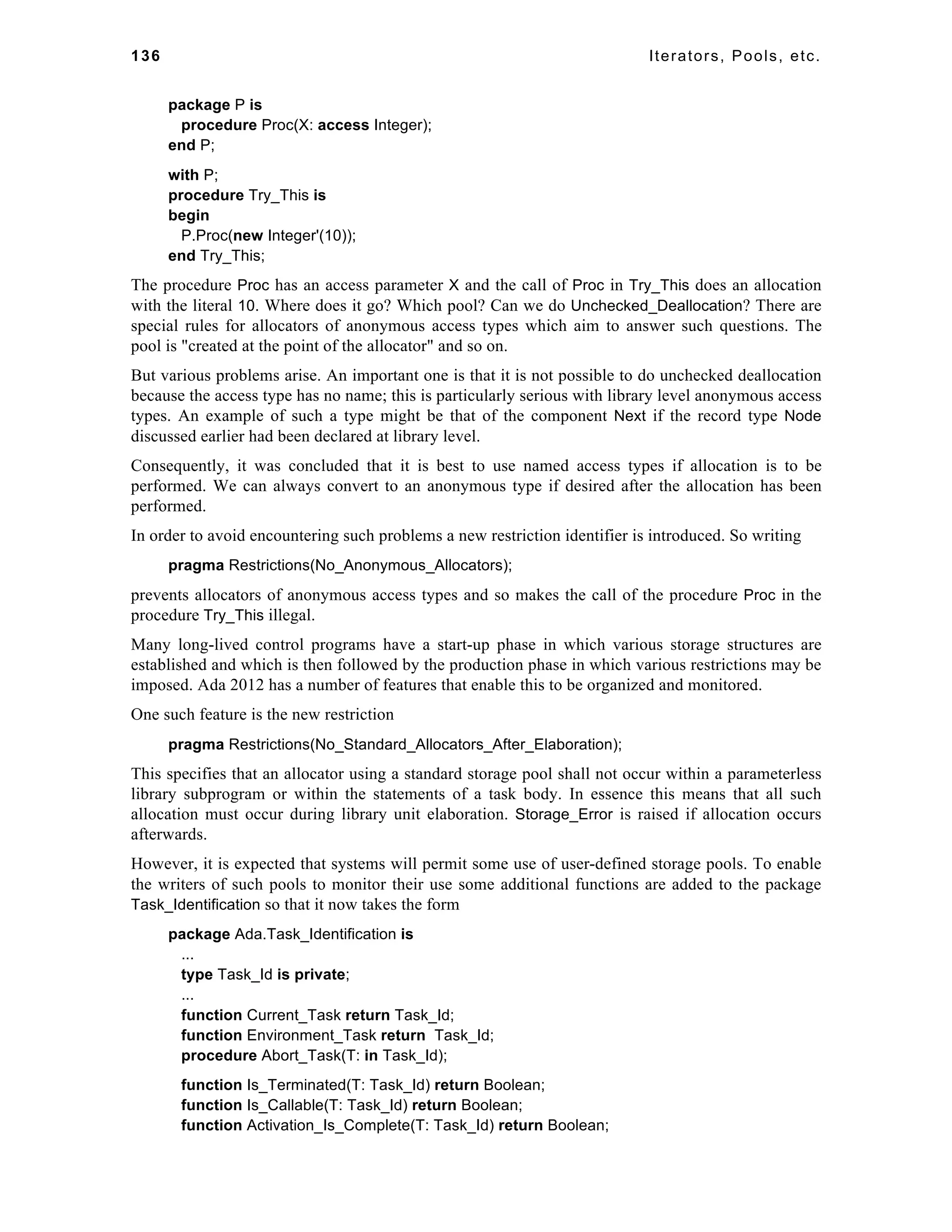
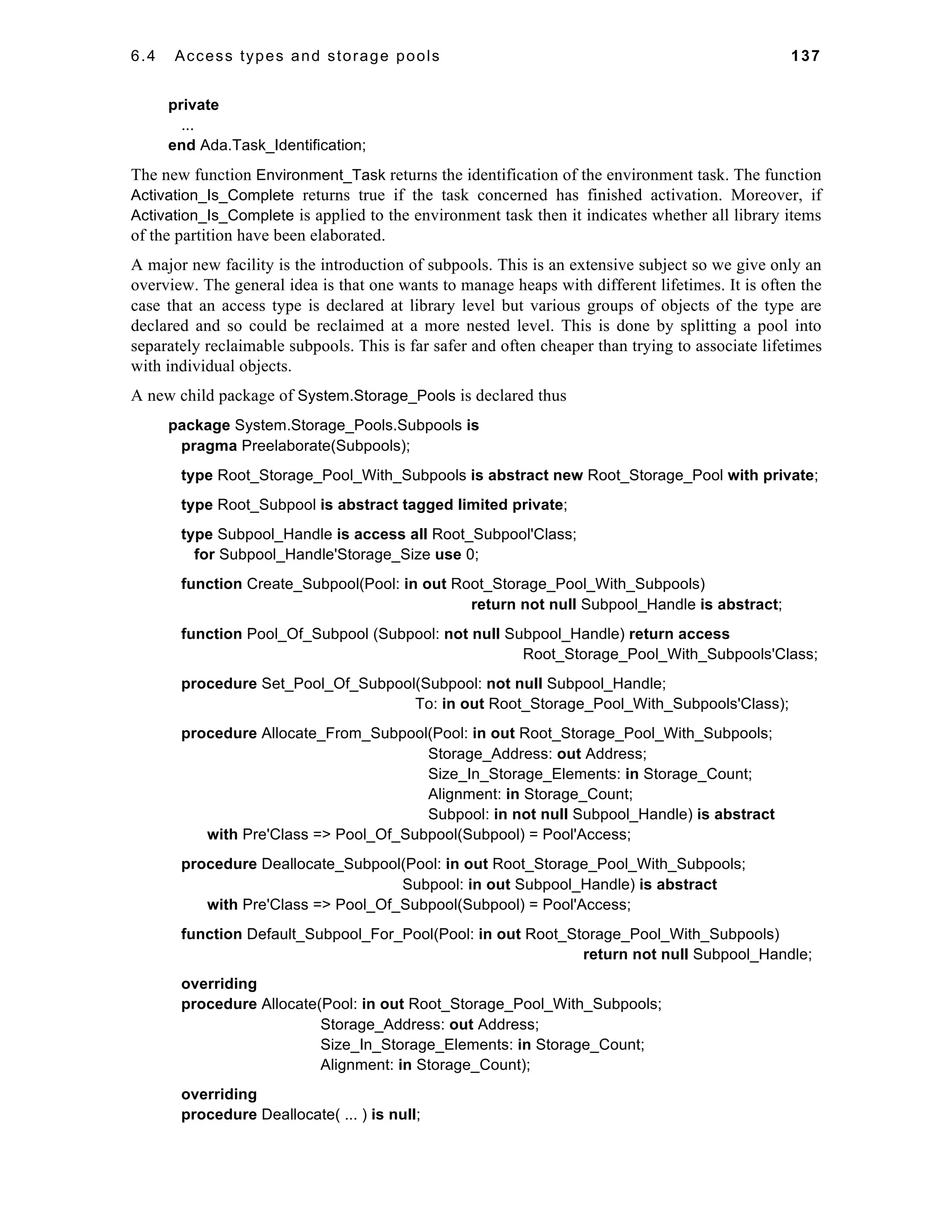
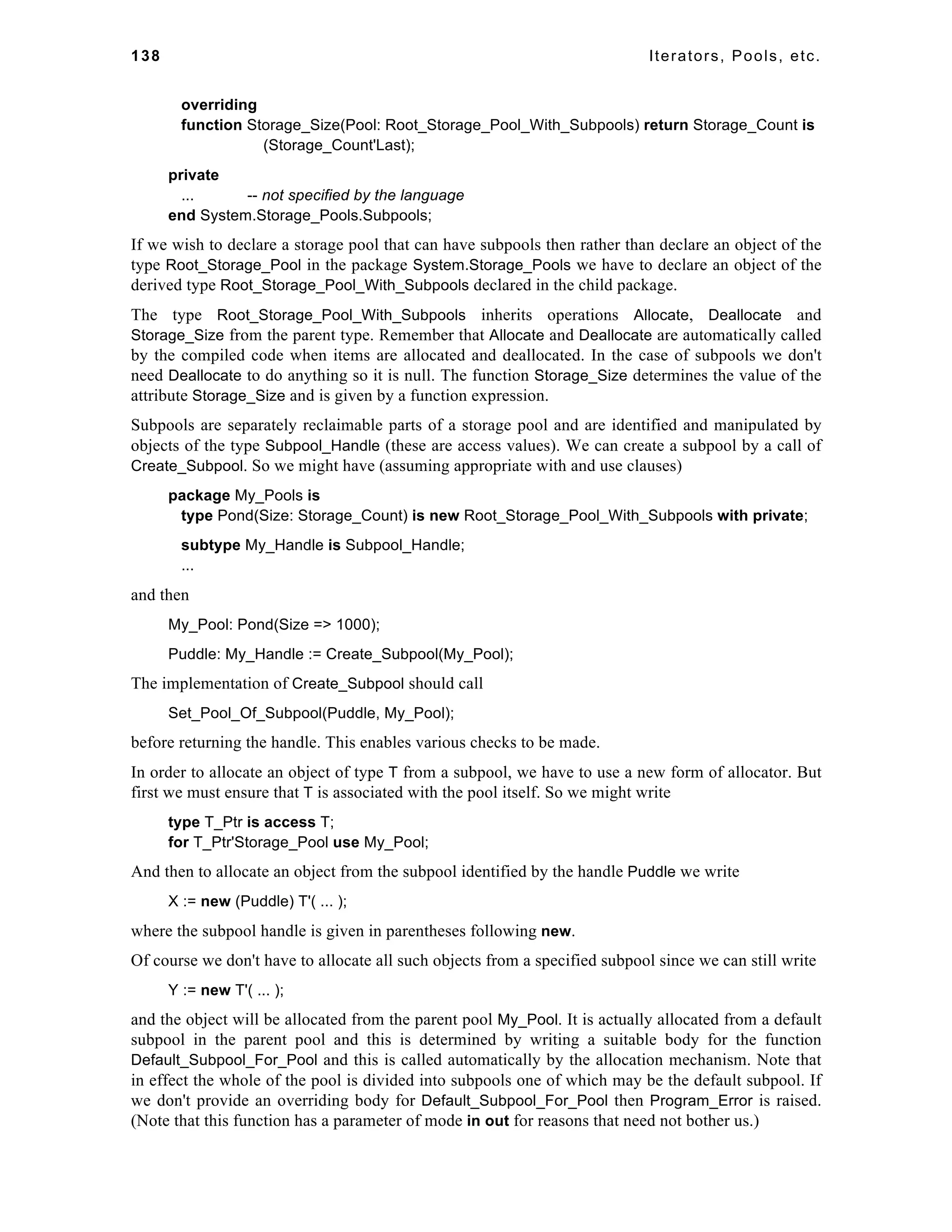
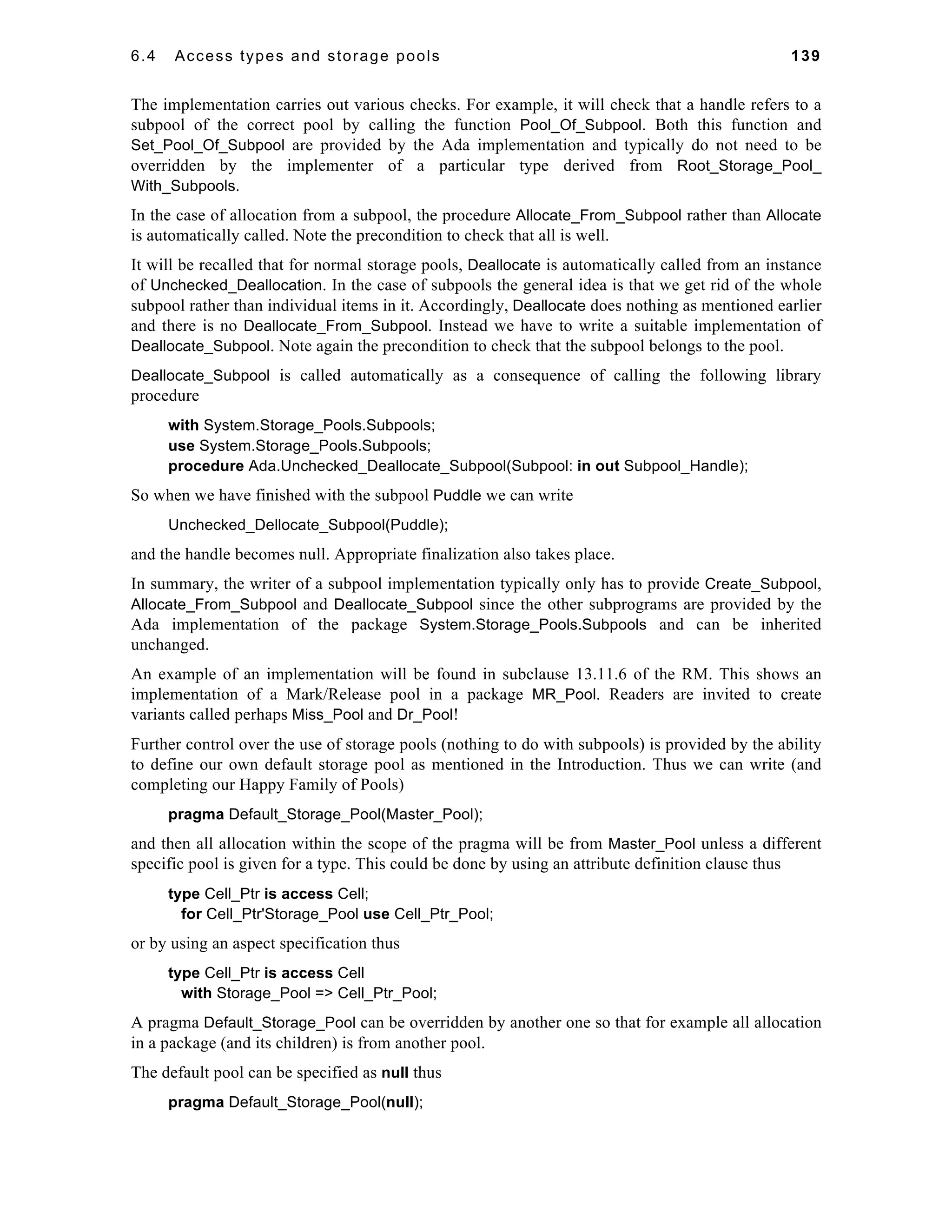
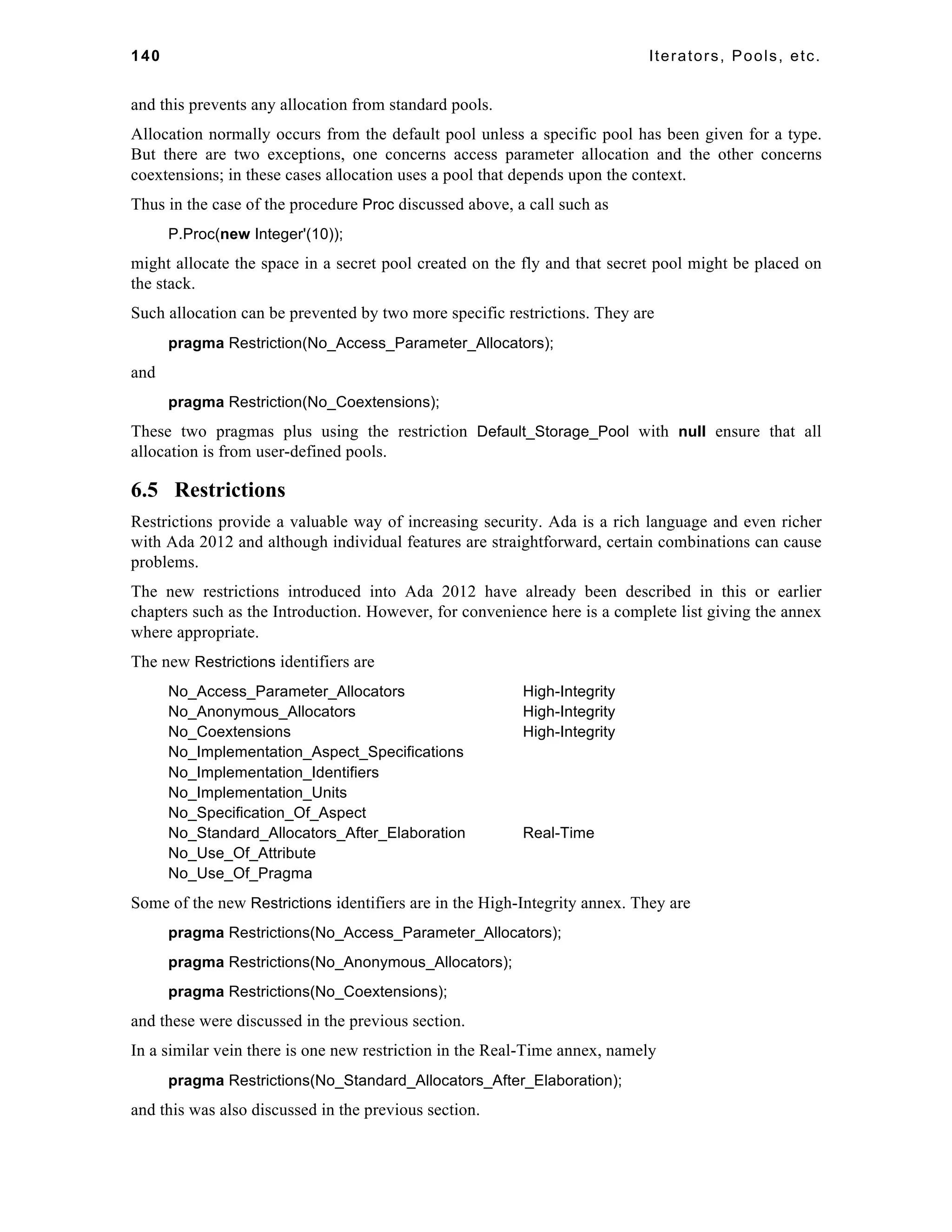
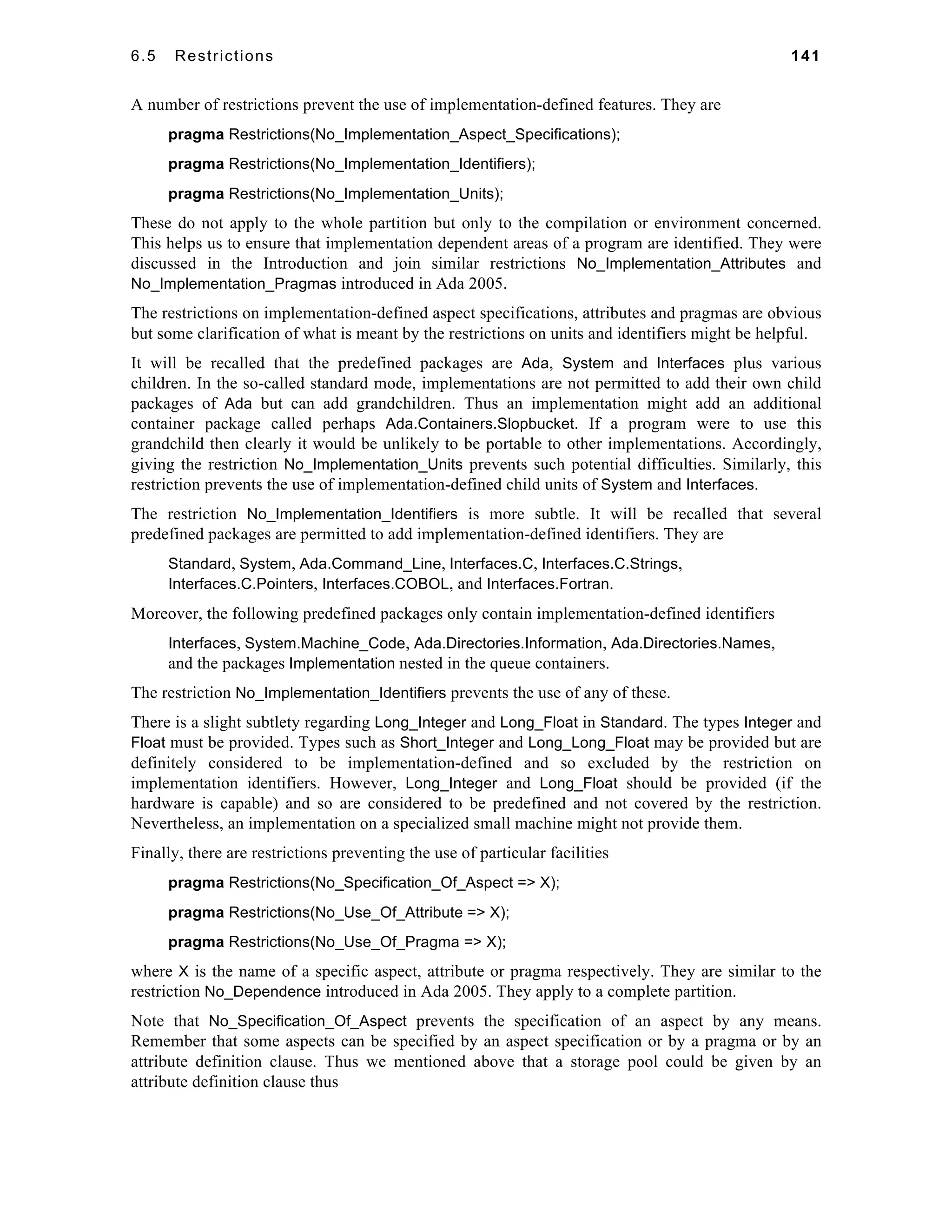
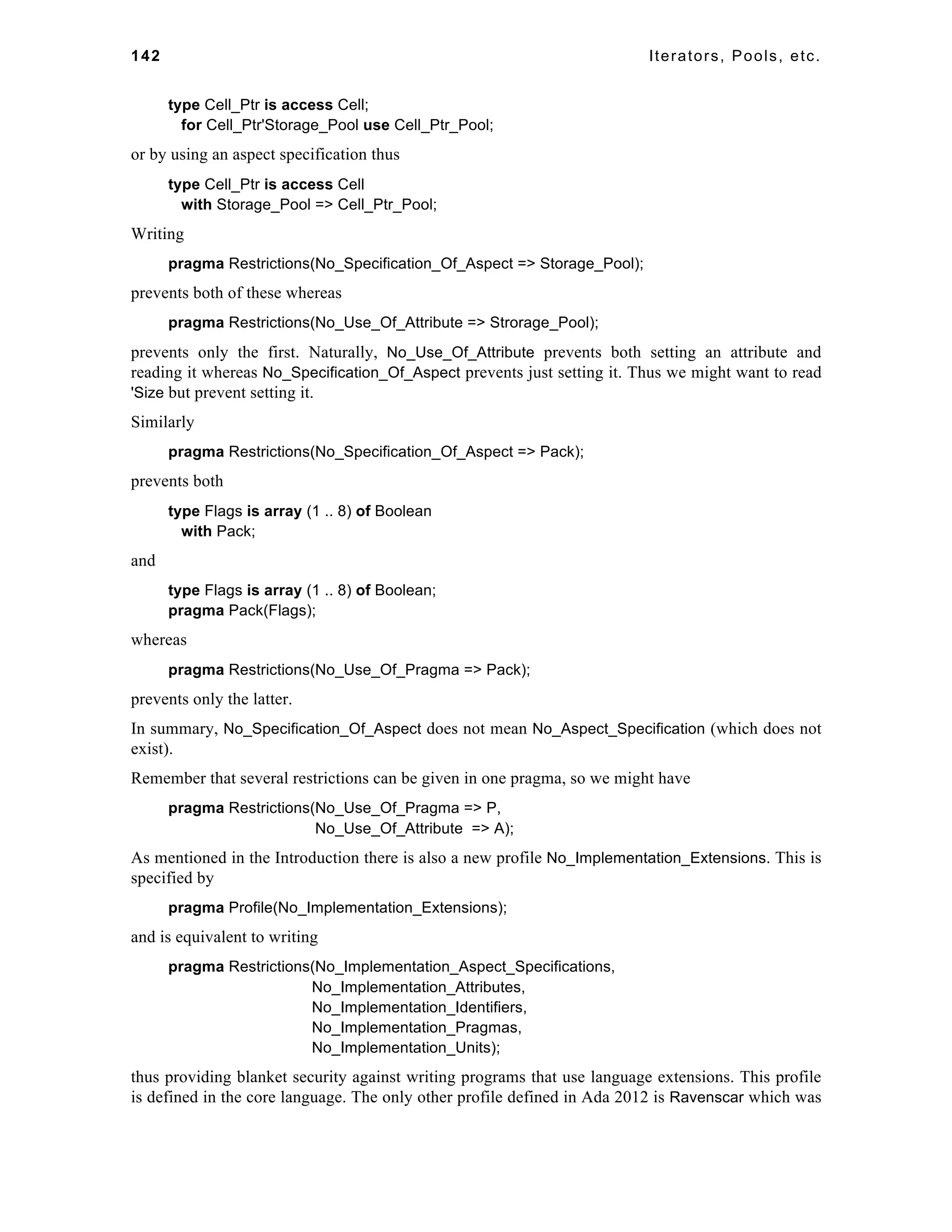
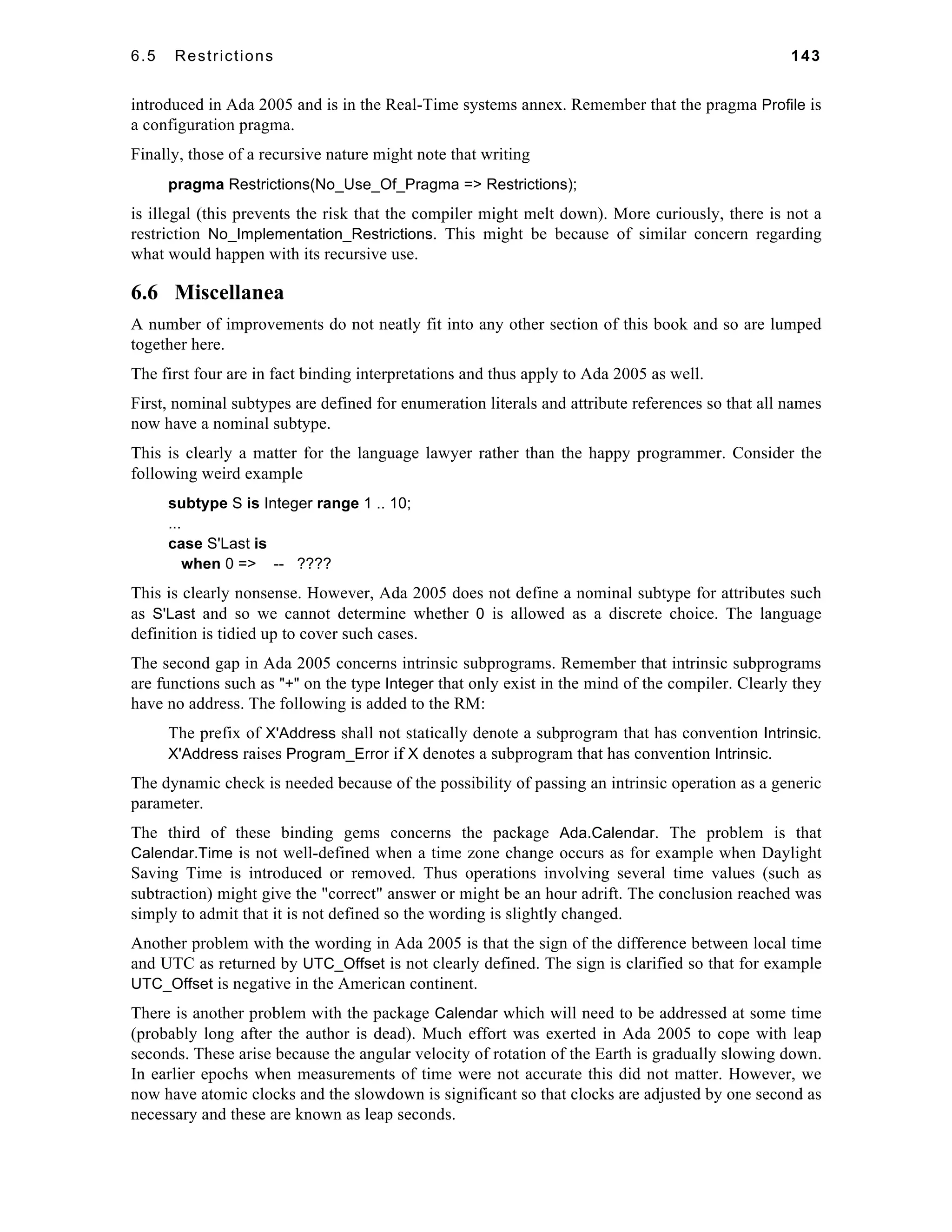

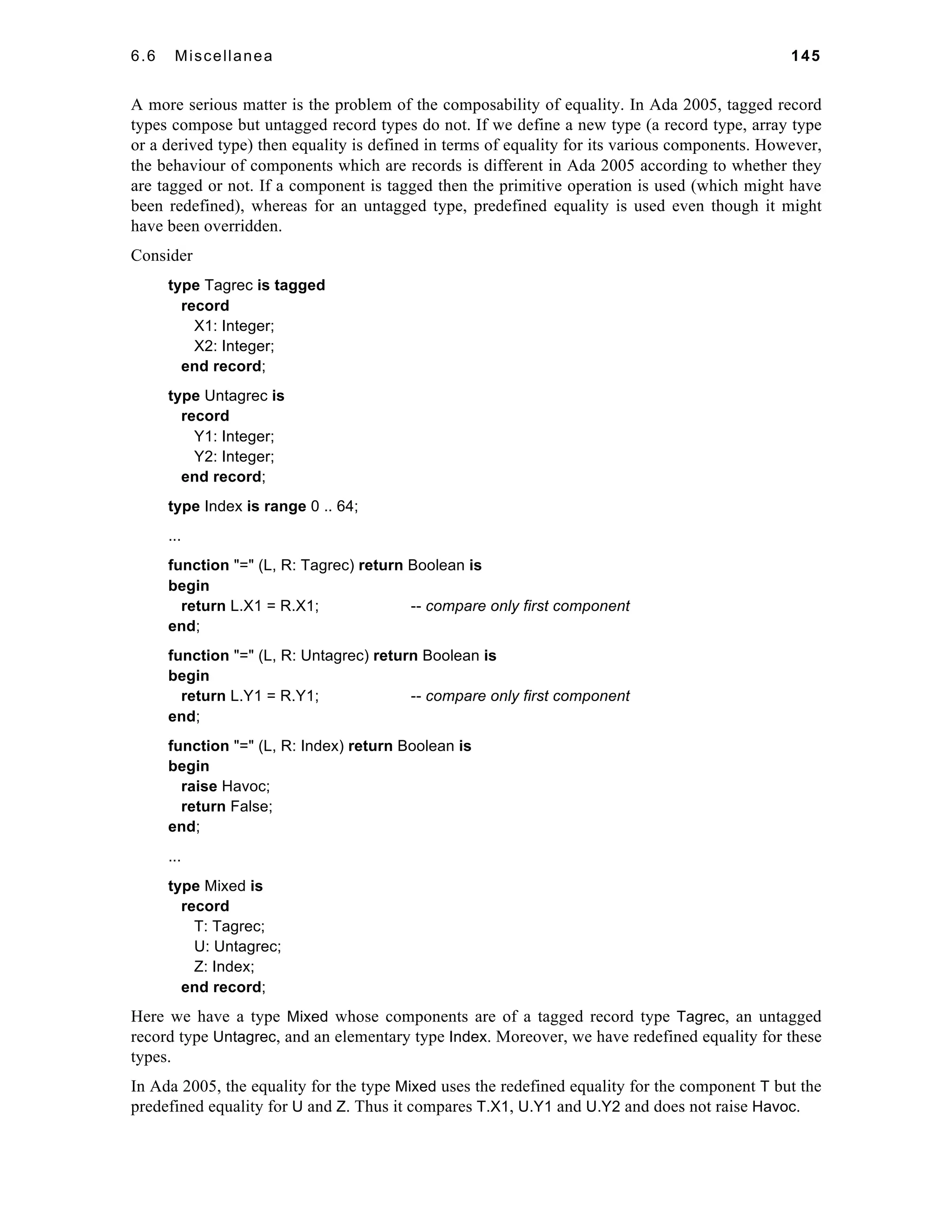
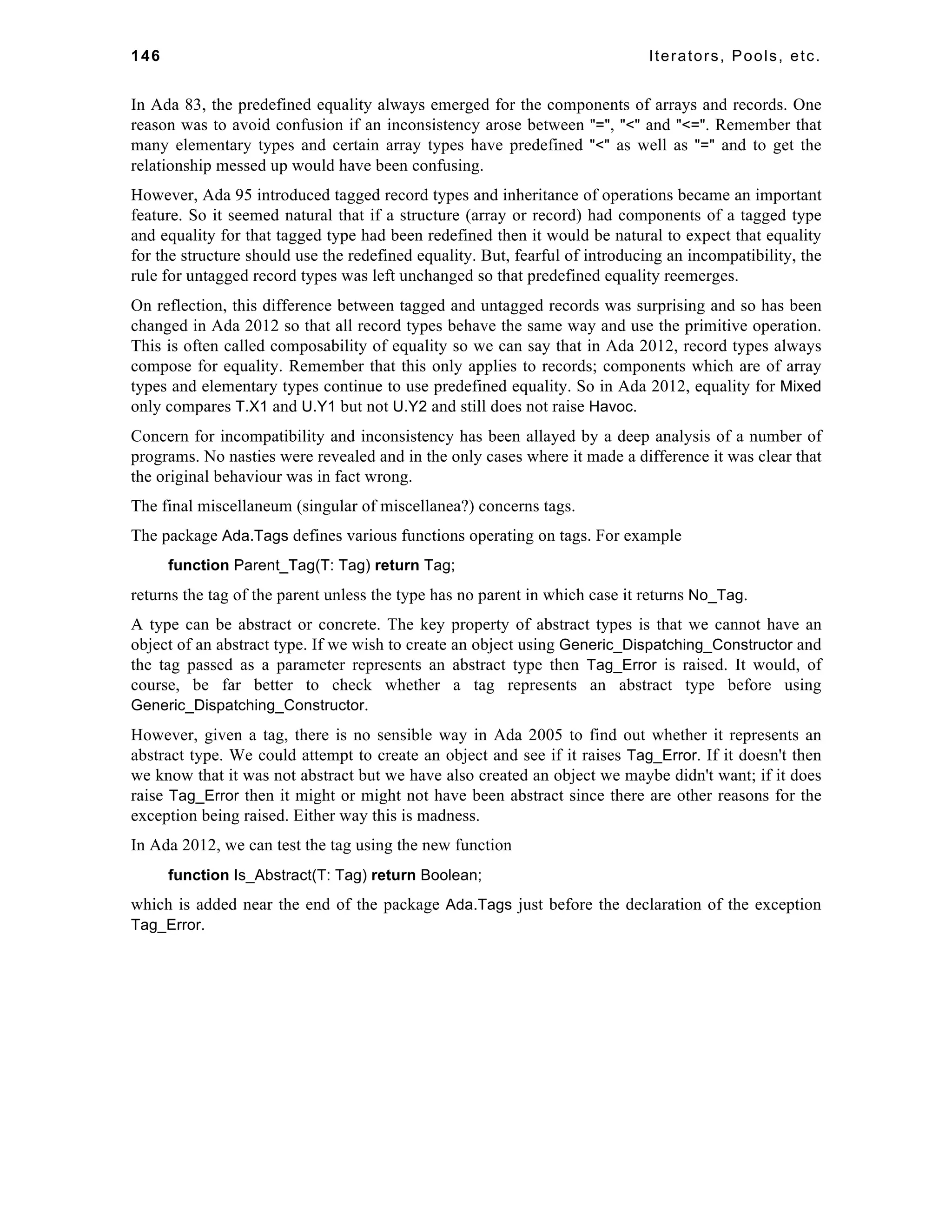
![147
7 Predefined library
This chapter describes various relatively minor improvements to the predefined library in
Ada 2012. The major changes concerning the container library will be described in the
chapter.
7.1 Overview of changes
The WG9 guidance document [1] does not specifically identify problems in this area other than
through a general exhortation to remedy shortcomings.
We have already discussed the additional library packages in the area of tasking and real-time in
Chapter 5. There are also many additional library packages concerning containers and these will be
discussed in the next chapter. The following Ada issues cover the relevant changes in other areas
and are described in detail in this chapter:
1 Bounded containers and other container issues
31 Add a From parameter to Find_Token
49 Extend file name processing in Ada.Directories
127 Adding locale capabilities
137 String encoding package
185 Wide_Character and Wide_Wide_Character classification and folding
233 Questions on locales
266 Use latest version of ISO/IEC 10646
283 Stream_IO should be preelaborated
285 Defaulted environment variable queries
286 Internationalization of Ada
These changes can be grouped as follows.
A number of enhancements concern strings and characters. These include comprehensive new
packages to support conversions between strings (and wide strings and wide-wide strings) and the
UTF-8 and UTF-16 encodings (137). It is important to note that Ada 2012 directly supports source
code in UTF-8 (286). Additional facilities are also provided for the classification of characters and
new packages added for similar operations on wide characters and wide wide characters (185, 266).
A minor change is the provision of a further procedure Find_Token with an additional parameter
giving the start of the search (31).
The file name processing in Ada.Directories is enhanced to overcome some shortcomings (49).
A new package is added to enable a program to identify the locale in which it is being used (127,
233).
There are a number of additional facilities regarding hashing and case insensitive comparisons. The
hashing issues really relate to containers but are briefly mentioned here for completeness (1, 286).
Finally, other improvements are that the package Ada.Streams.Stream_IO is now preelaborated
(283) and that an additional function Value is added to the package Ada.Environment_Variables
(285).](https://image.slidesharecdn.com/ada2012rationale-141002094233-phpapp01/75/Ada2012-Rationale-157-2048.jpg)
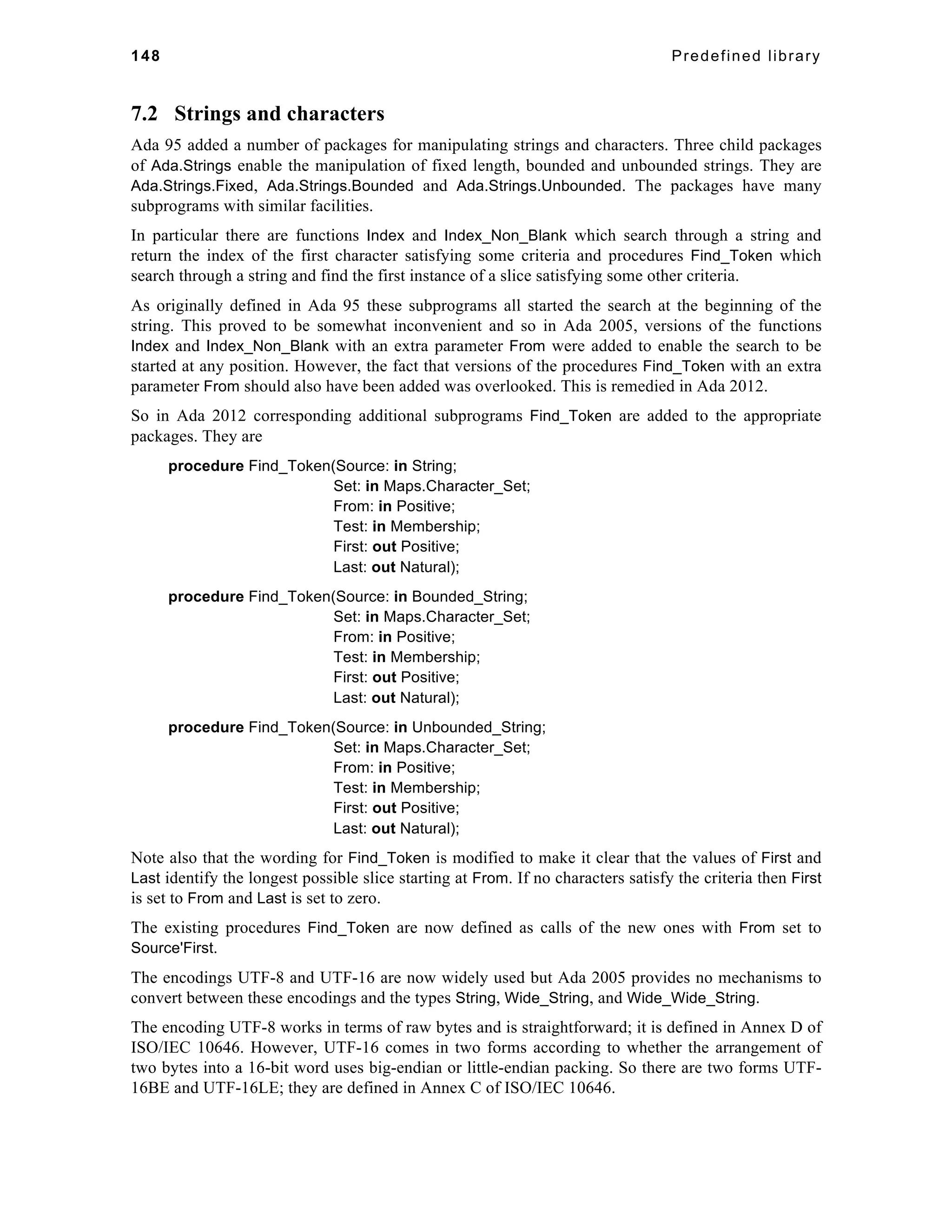
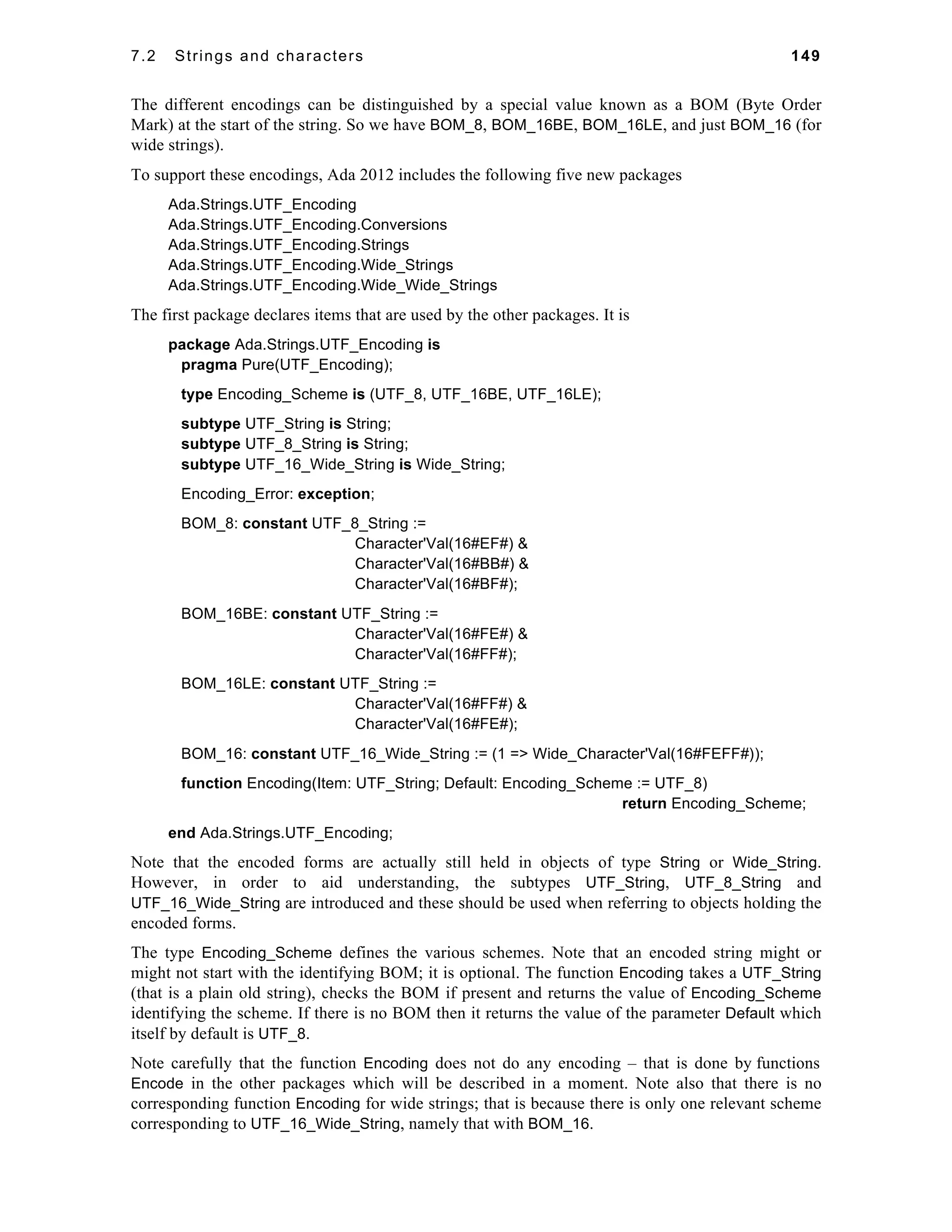
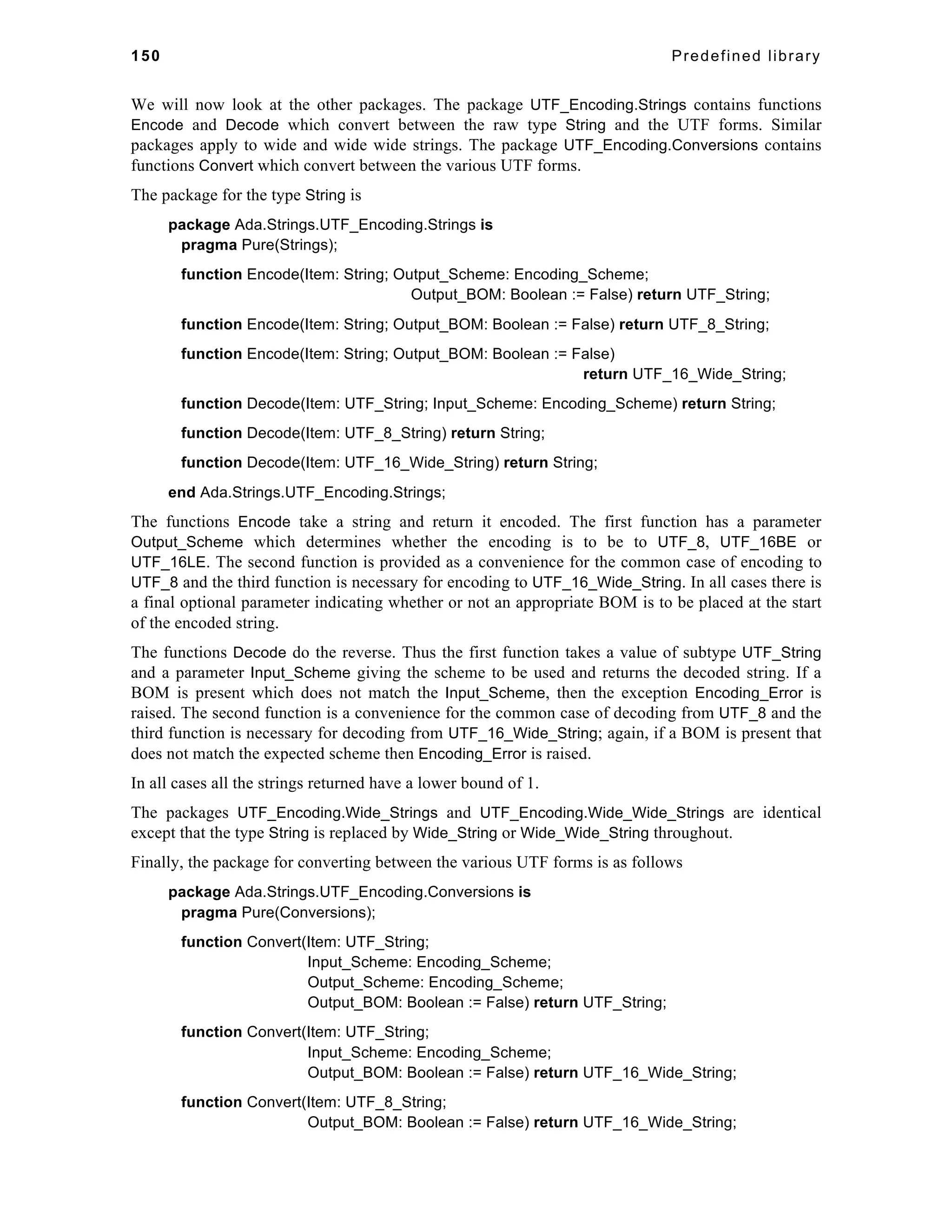
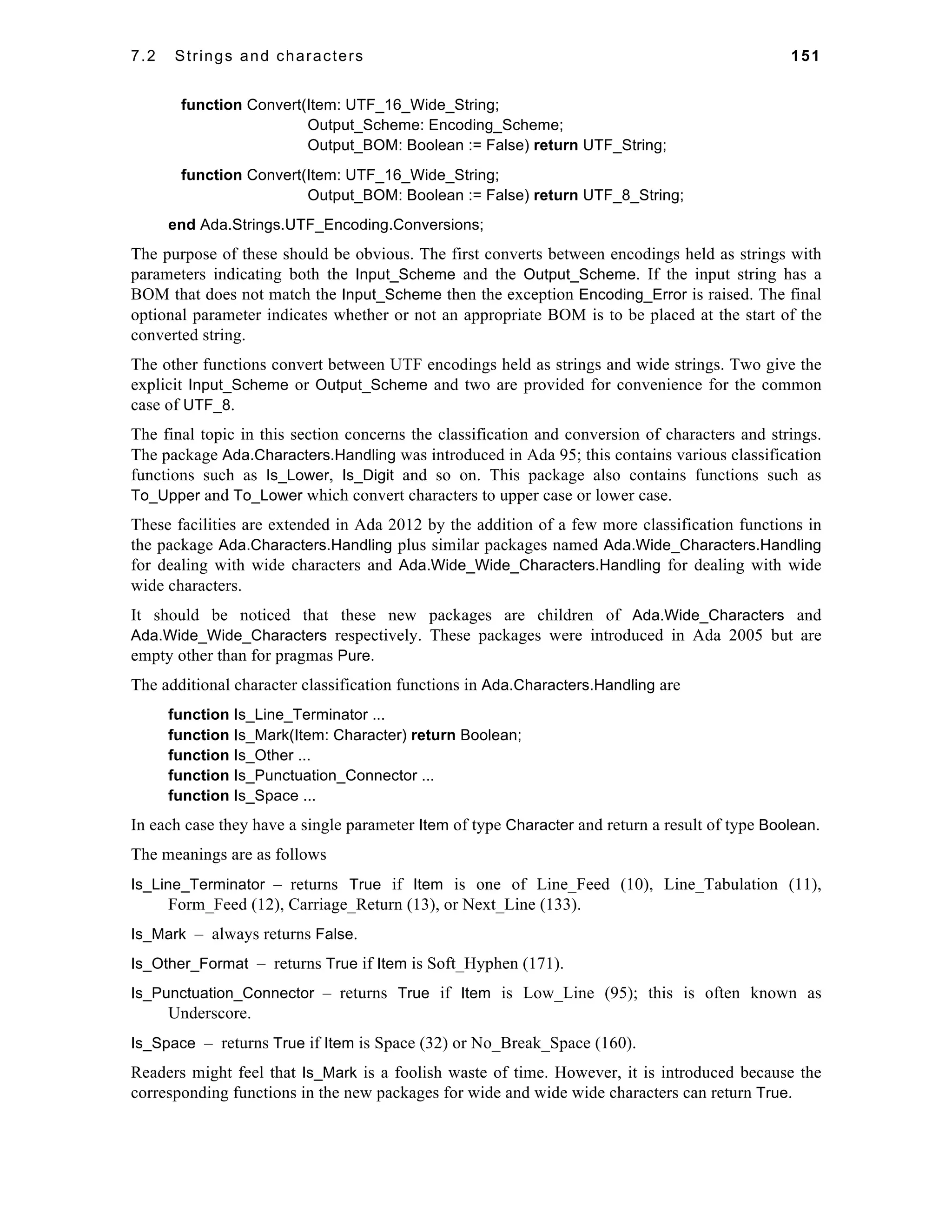
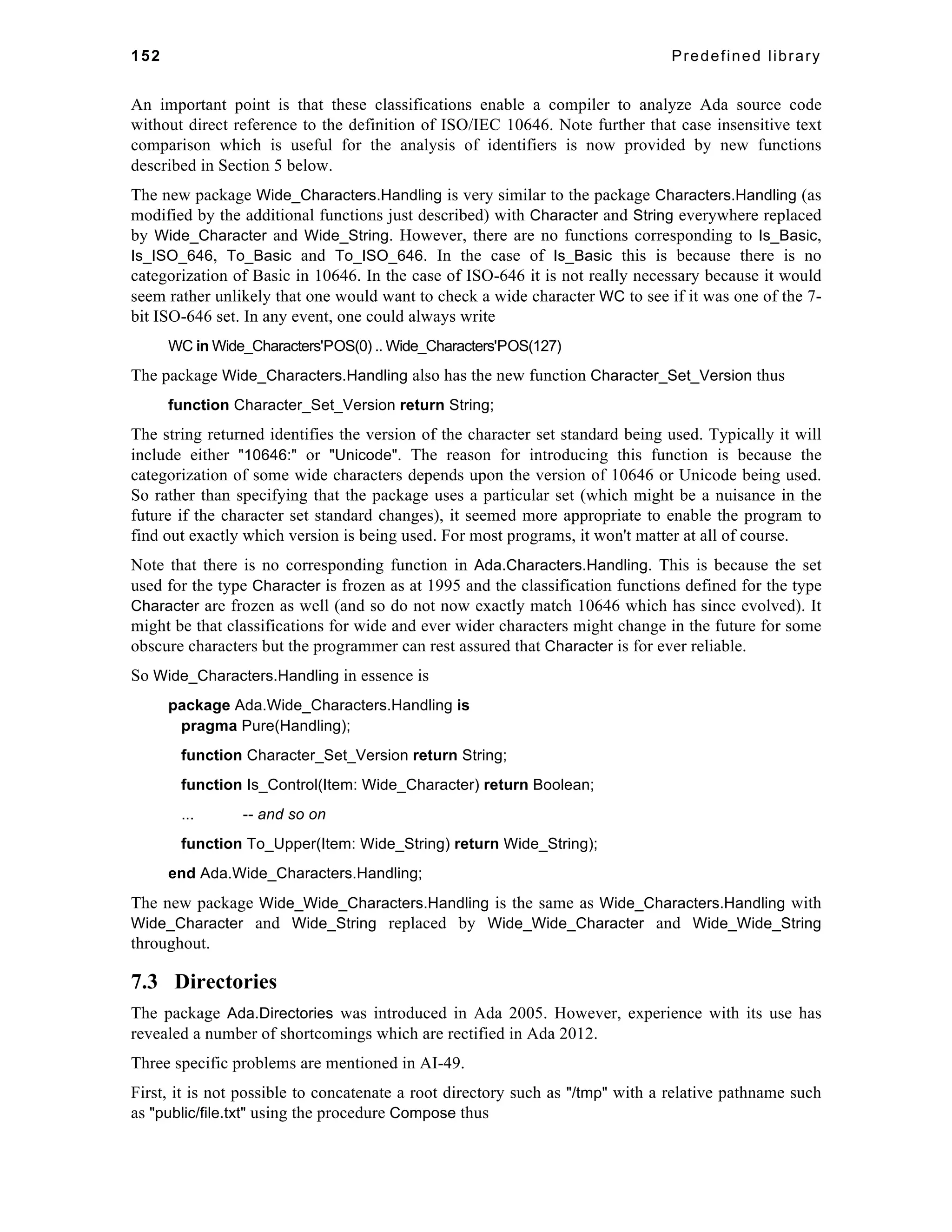
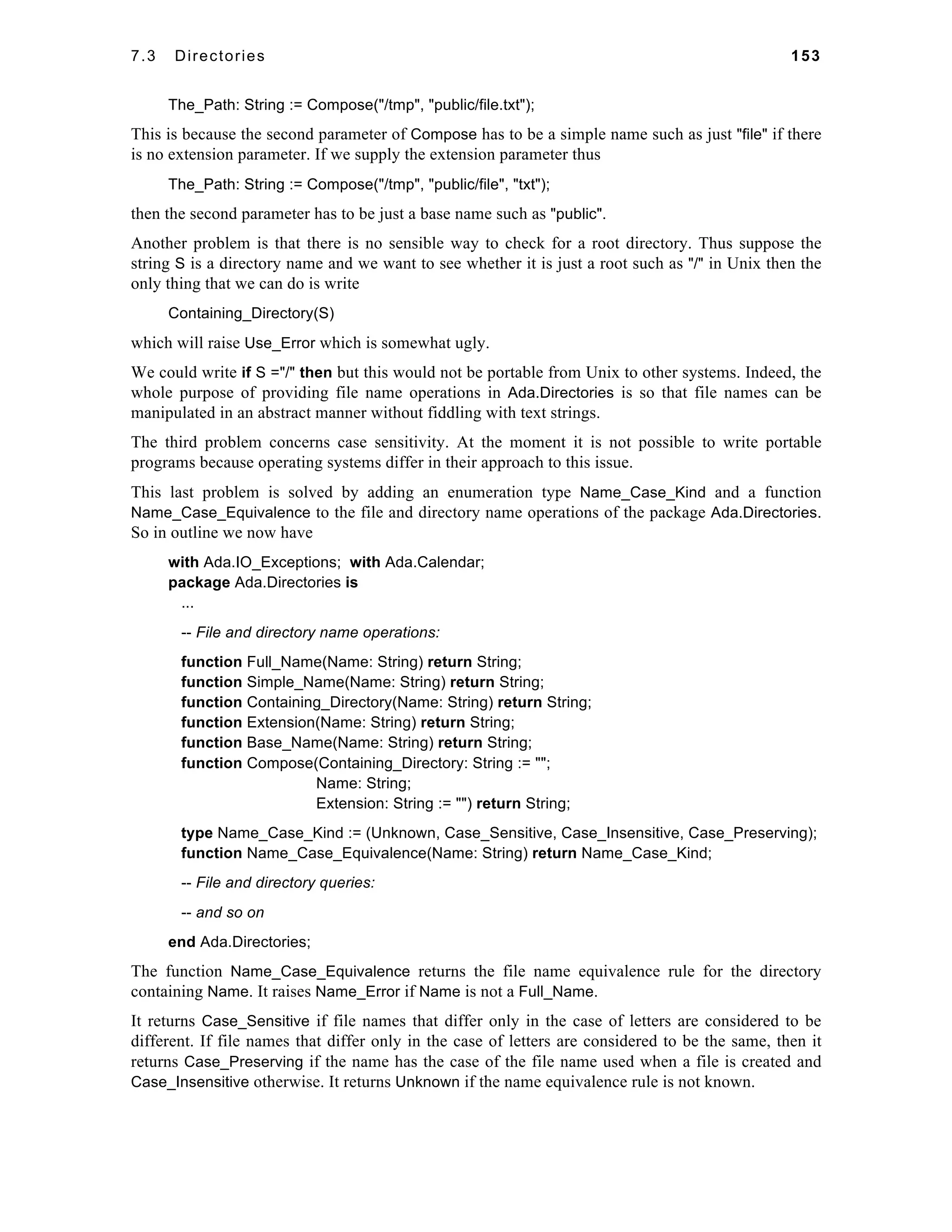
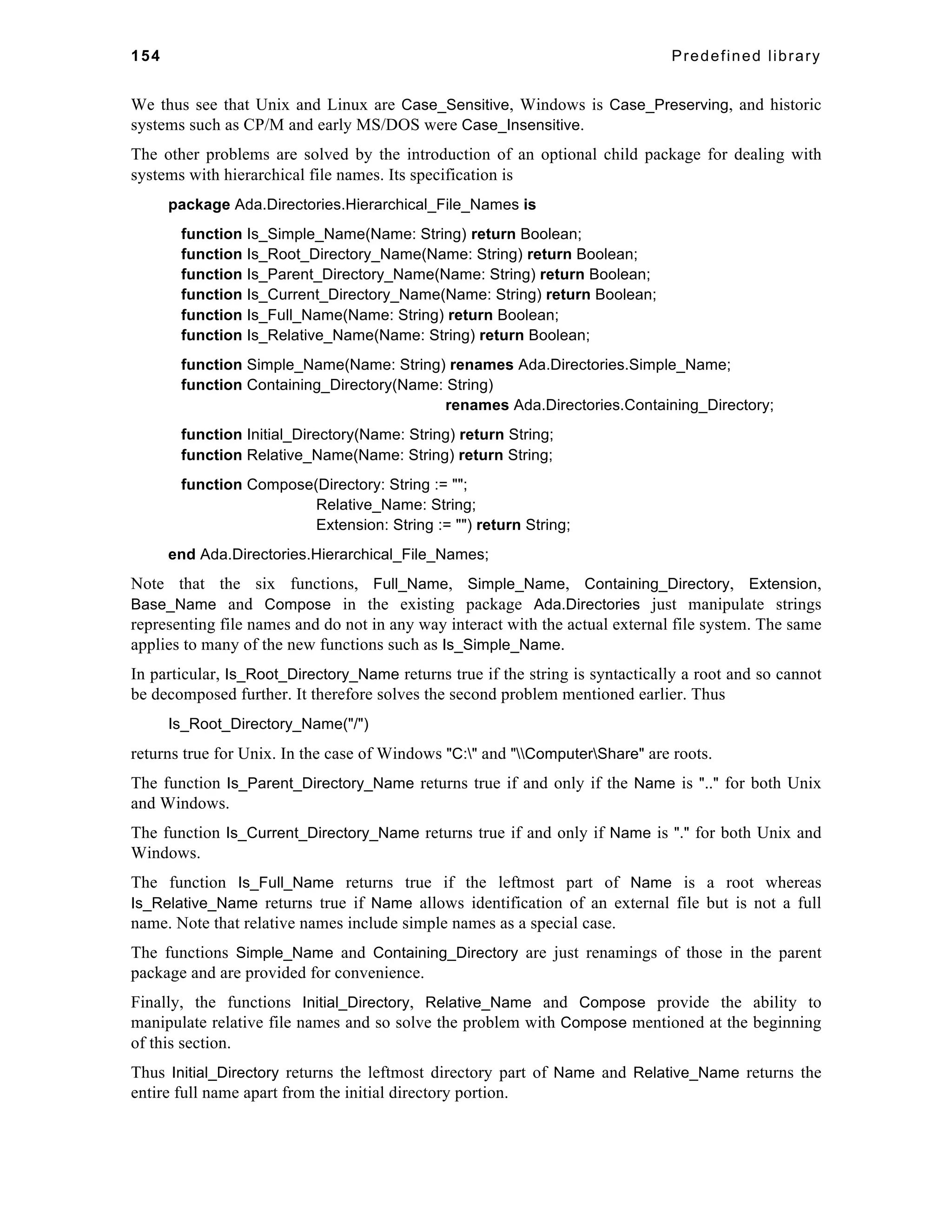
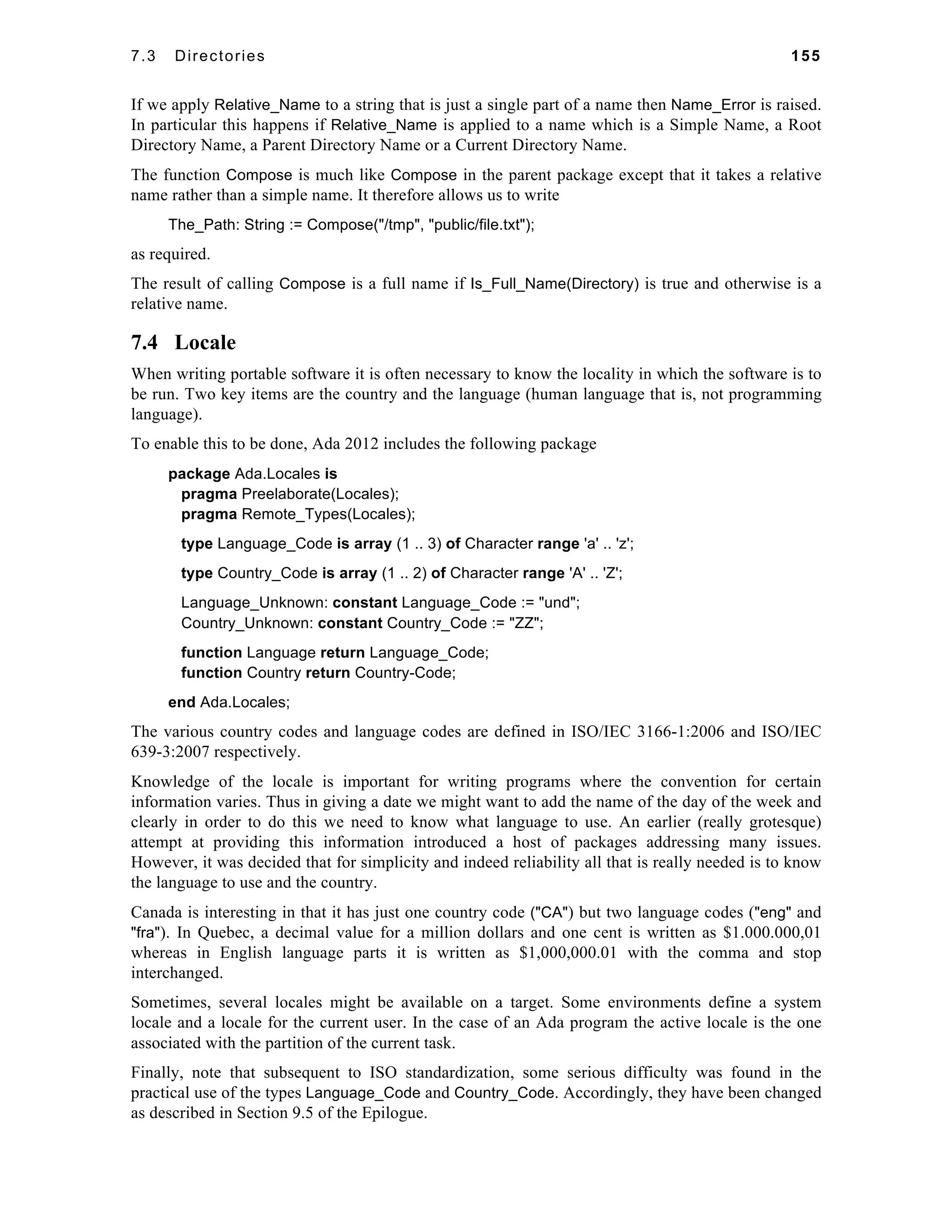
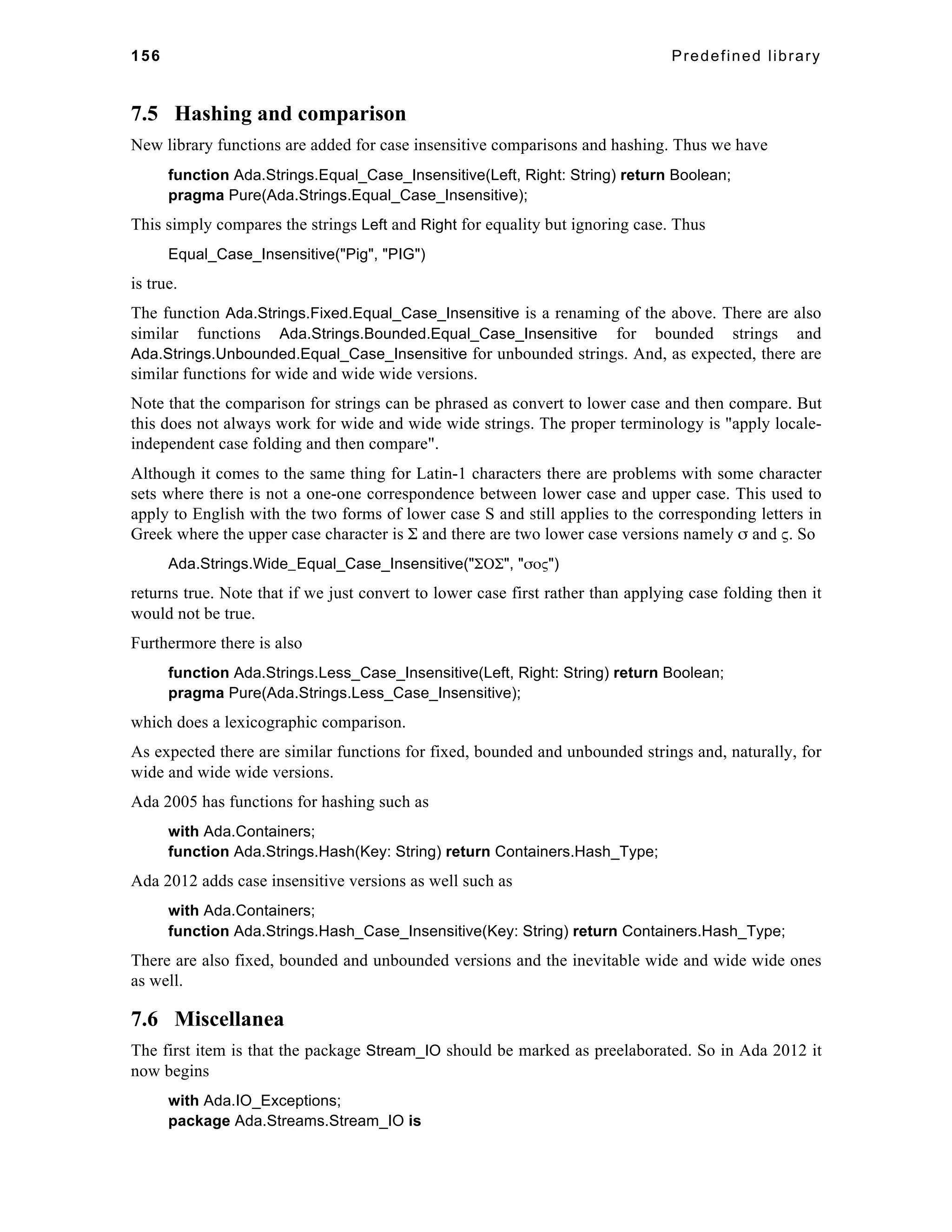
![7.6 Miscellanea 157
pragma Preelaborate(Stream_IO);
...
The reason for making this change concerns the use of input–output in preelaborated packages. The
normal input–output packages such as Text_IO are not preelaborated and so cannot be used in
packages that are themselves preelaborated. This makes preelaborated packages awkward to debug
since they cannot do straightforward output for monitoring purposes. To make packages such as
Text_IO preelaborated is essentially impossible because they involve local state. However, no such
problem exists with Stream_IO, and so making it preelaborated means that it can be used to
implement simple logging facilities in other preelaborated packages.
In principle, there is a similar problem with pure units. But they cannot change state anyway and so
cannot do output since that changes the state of the environment. They just have to be written
correctly in the first place.
(I have been told that there are naughty ways around this with pure packages but I will not
contaminate innocent minds with the details.)
The package Ada.Environment_Variables was introduced in Ada 2005 as follows
package Ada.Environment_Variables is
pragma Preelaborate(Environment_Variables);
function Value(Name: String) return String;
function Exists(Name: String) return Boolean;
procedure Set(Name: in String; Value: in String);
procedure Clear(Name: in String);
procedure Clear;
procedure Iterate(Process: not null access procedure (Name, Value: in String));
end Ada.Environment_Variables;
If we do not know whether an environment variable exists then we can check by calling Exists prior
to accessing the current value. Thus a program might be running in an environment where we might
expect an environment variable "Ada" whose value indicates the version of Ada currently supported.
So as in [7] we might write
if not Exists("Ada") then
raise Horror;
end if;
Put("Current Ada is ");
Put_Line(Value("Ada"));
But this raises a possible race condition. After determining that Ada does exist some malevolent
process (such as another Ada task or an external human agent) might execute Clear("Ada"); and then
the call of Value("Ada") will raise Constraint_Error.
The other race condition might arise as well. Having decided that Ada does not exist and so taking
remedial action some kindly process might have created Ada.
These problems are overcome in Ada 2012 by the introduction of an additional function Value with
a default parameter
function Value(Name: String; Default: String);
Calling this version of Value returns the value of the variable if it exists and otherwise returns the
value of Default.](https://image.slidesharecdn.com/ada2012rationale-141002094233-phpapp01/75/Ada2012-Rationale-167-2048.jpg)

![159
8 Containers
This chapter describes improvements to the predefined container library in Ada 2012.
8.1 Overview of changes
The WG9 guidance document [1] specifically says that attention should be paid to
improving the use and functionality of the predefined containers.
The predefined containers were introduced in Ada 2005 and experience with their use revealed a
number of areas where they could be improved.
The following Ada Issues cover the relevant changes and are described in detail in this chapter.
1 Bounded containers and other container issues
69 Holder container
136 Multiway tree container
139 Syntactic sugar for access, containers & iterators
159 Queue containers
184 Compatibility of streaming of containers
212 Accessors and iterators for Ada.Containers
251 Problems with queue containers
These changes can be grouped as follows.
The existing containers are unbounded and generally require dynamic storage management to be
performed behind the scenes. However, for high-integrity systems, such dynamic management is
often unacceptable. Accordingly, bounded versions of all the existing containers are added (1).
A number of facilities are added to make important operations on containers more elegant. These are
the updating of individual elements of a container and iteration over a container (139, 212).
Ada 2005 introduced containers for the manipulation of lists and it was expected that this would
provide a basis for manipulating trees. However, this proved not to be the case, so specific
containers are added for the manipulation of multiway trees (136). There are versions for unbounded
indefinite and unbounded definite trees and for bounded definite trees.
A further new kind of container is just for single indefinite objects and is known as the holder
container (69).
A range of containers are added for manipulating queues with defined behaviour regarding multiple
task access to the queues (159, 251).
The Ada 2005 container library also introduced sorting procedures for constrained and
unconstrained arrays. An additional more general sorting mechanism is added in Ada 2012 (1).
Finally, an oversight regarding the streaming of containers is corrected (184).
8.2 Bounded and unbounded containers
It is perhaps worth starting this discussion by summarizing the containers introduced in Ada 2005.
First, there is a parent package Ada.Containers which simply declares the types Hash_Type and
Count_Type.](https://image.slidesharecdn.com/ada2012rationale-141002094233-phpapp01/75/Ada2012-Rationale-169-2048.jpg)
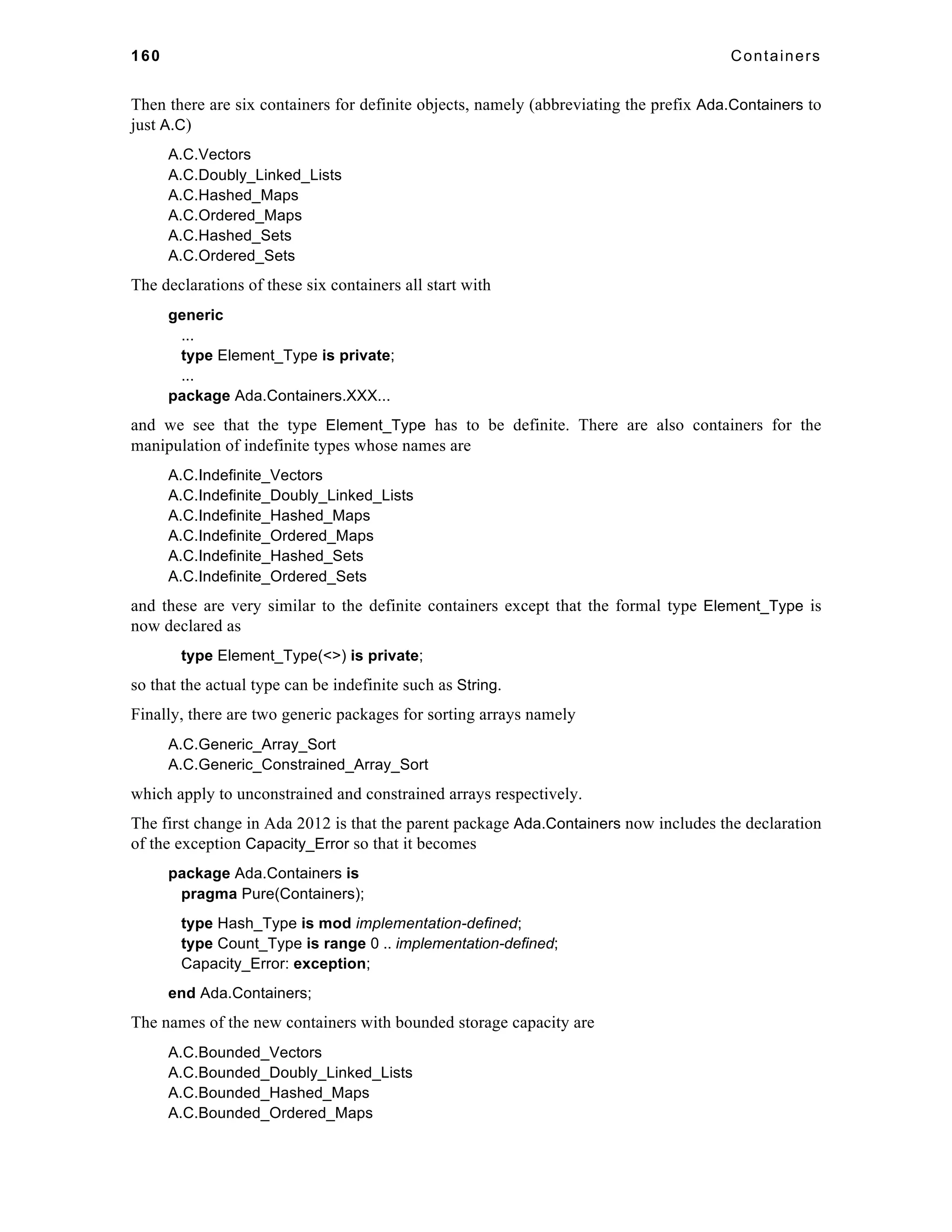
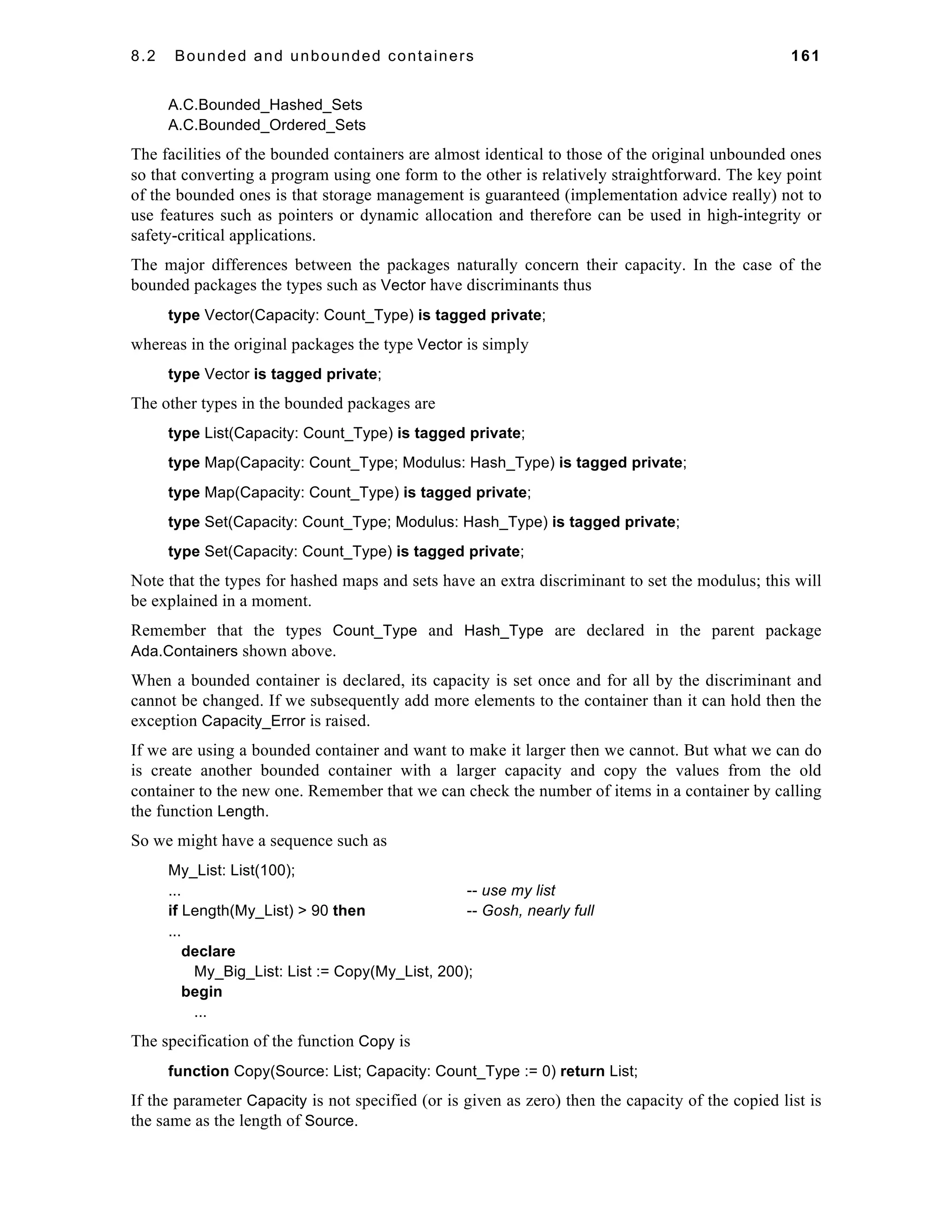
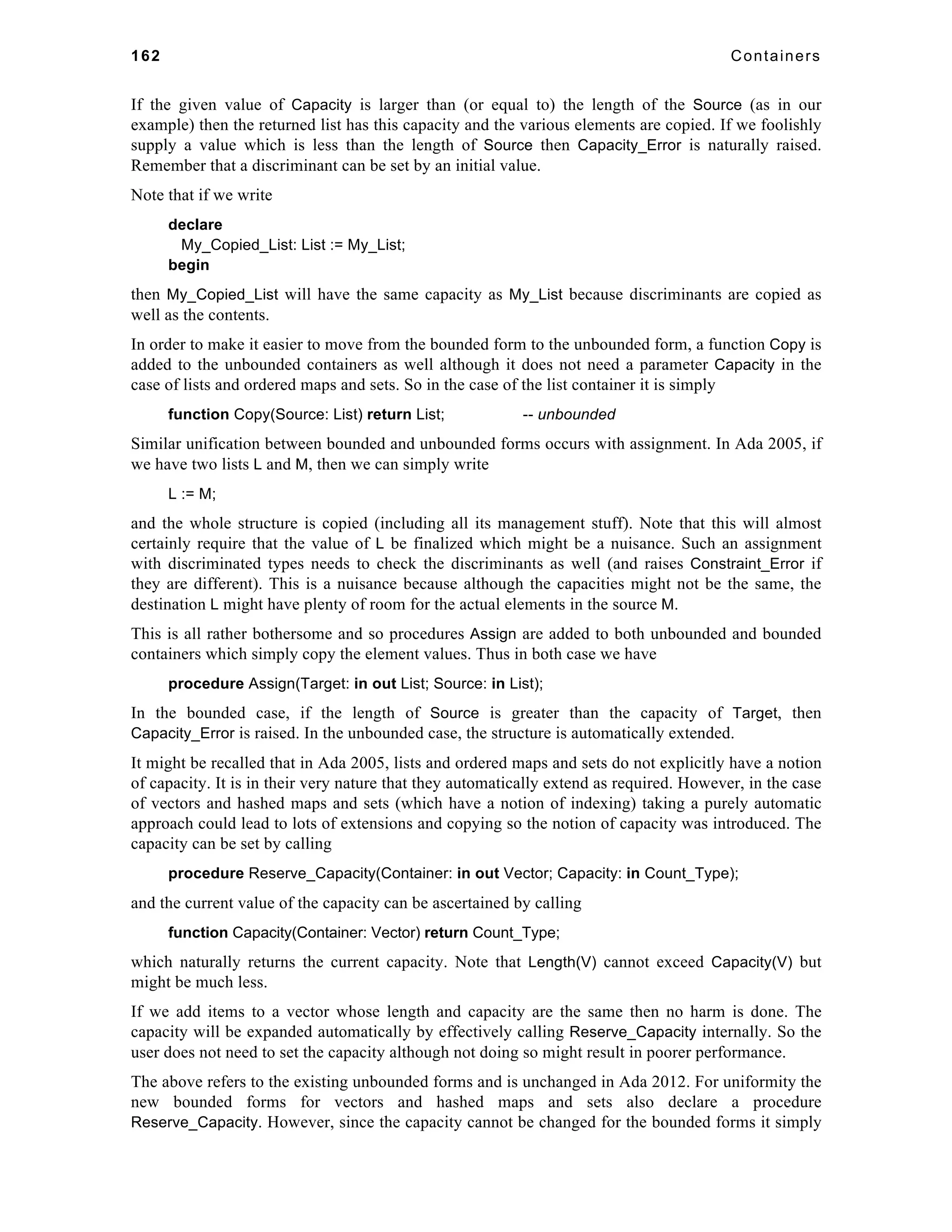
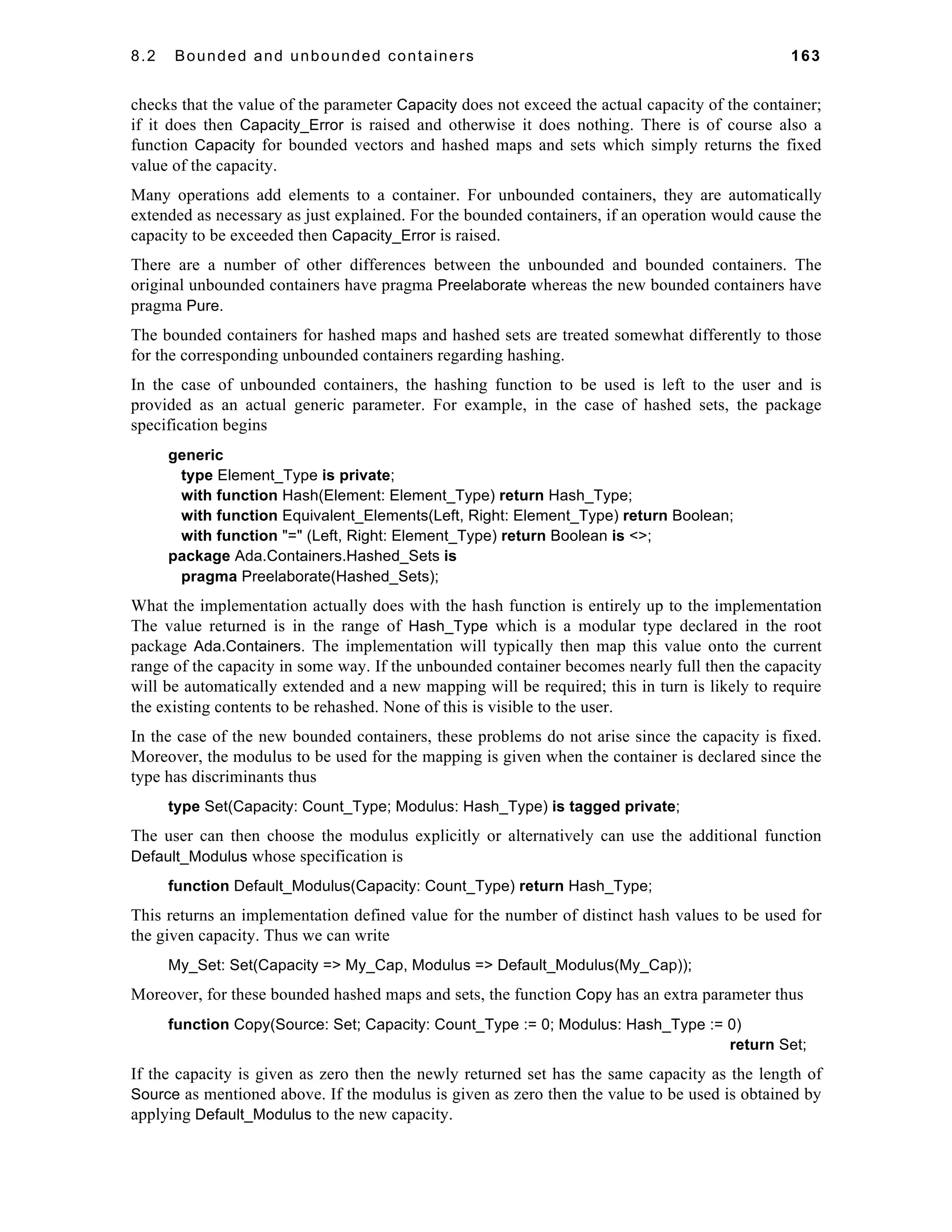
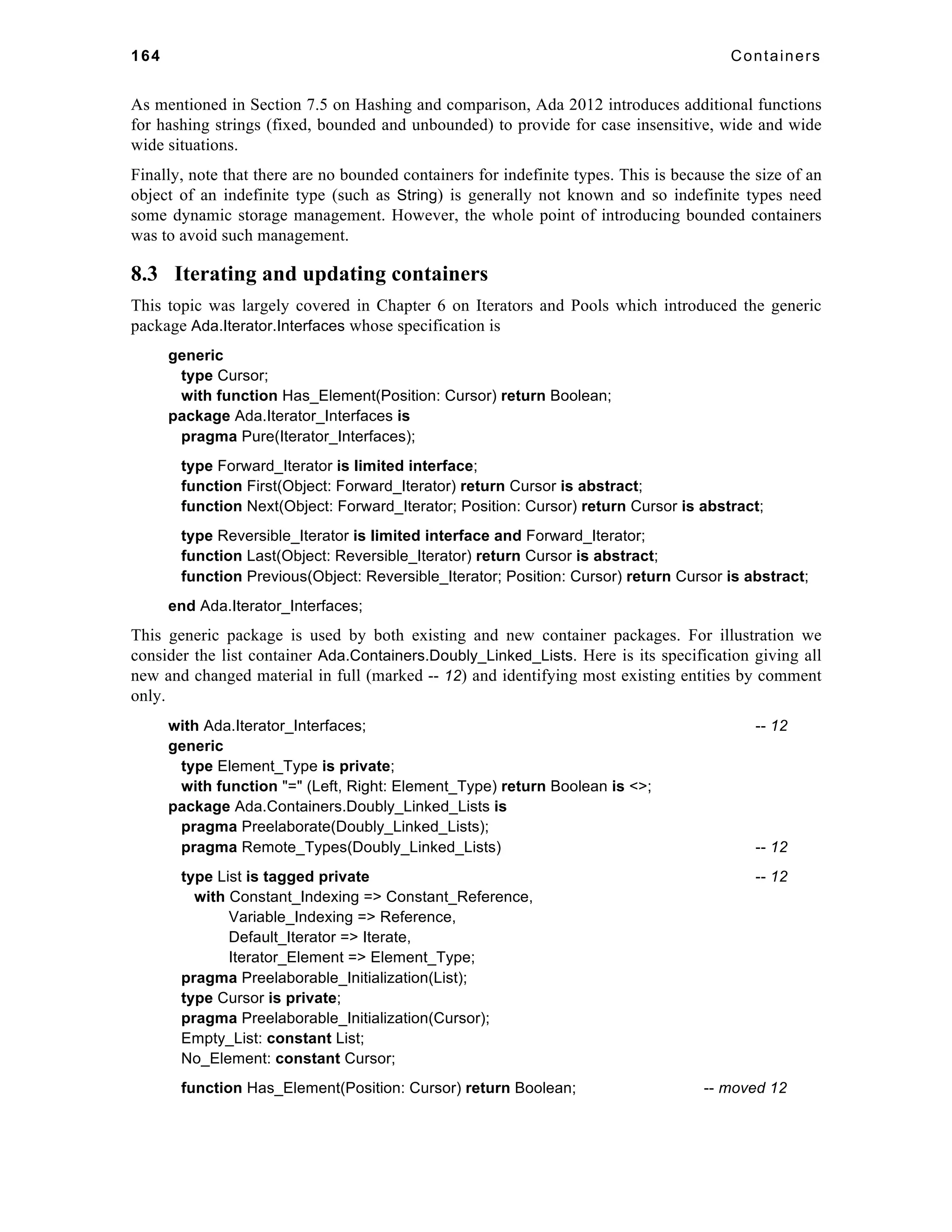

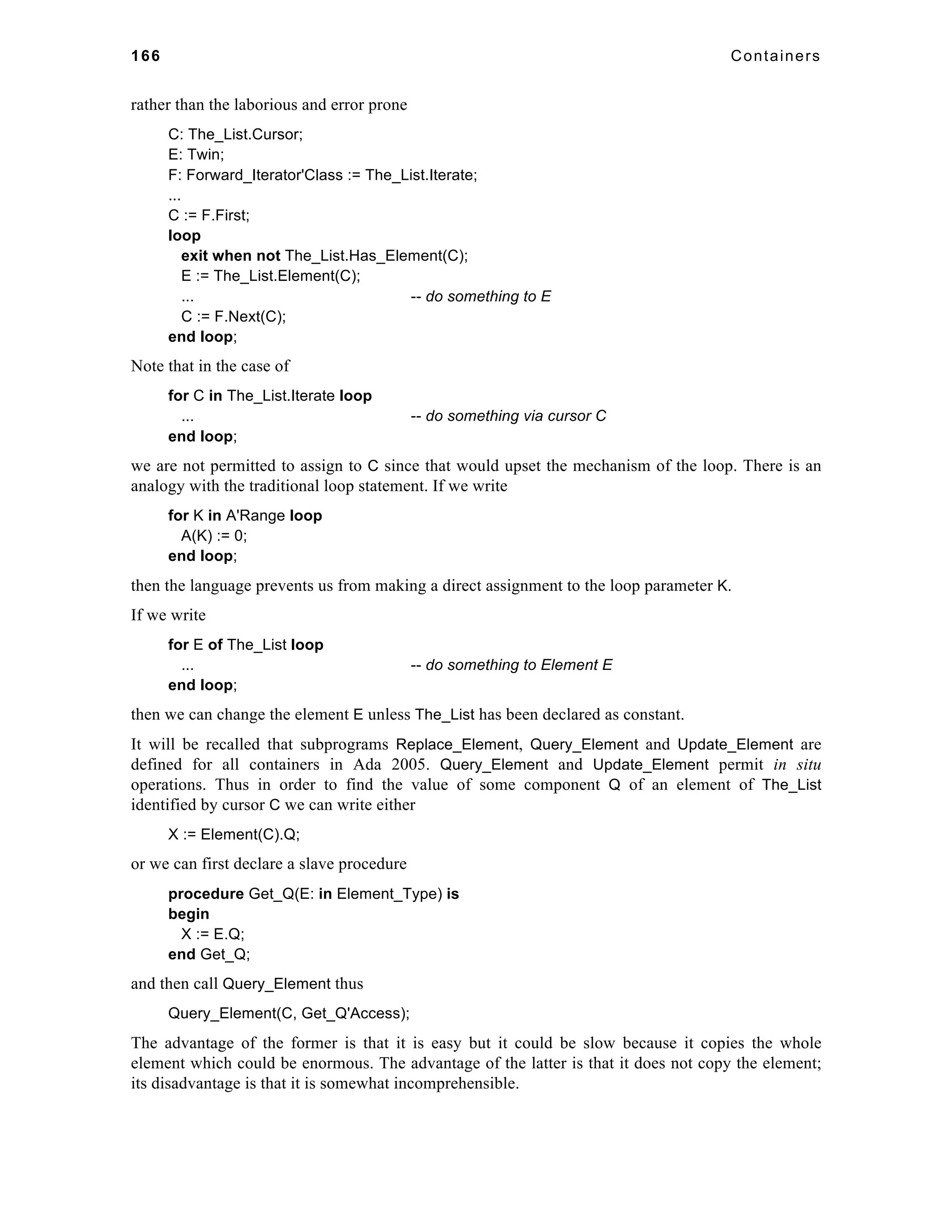
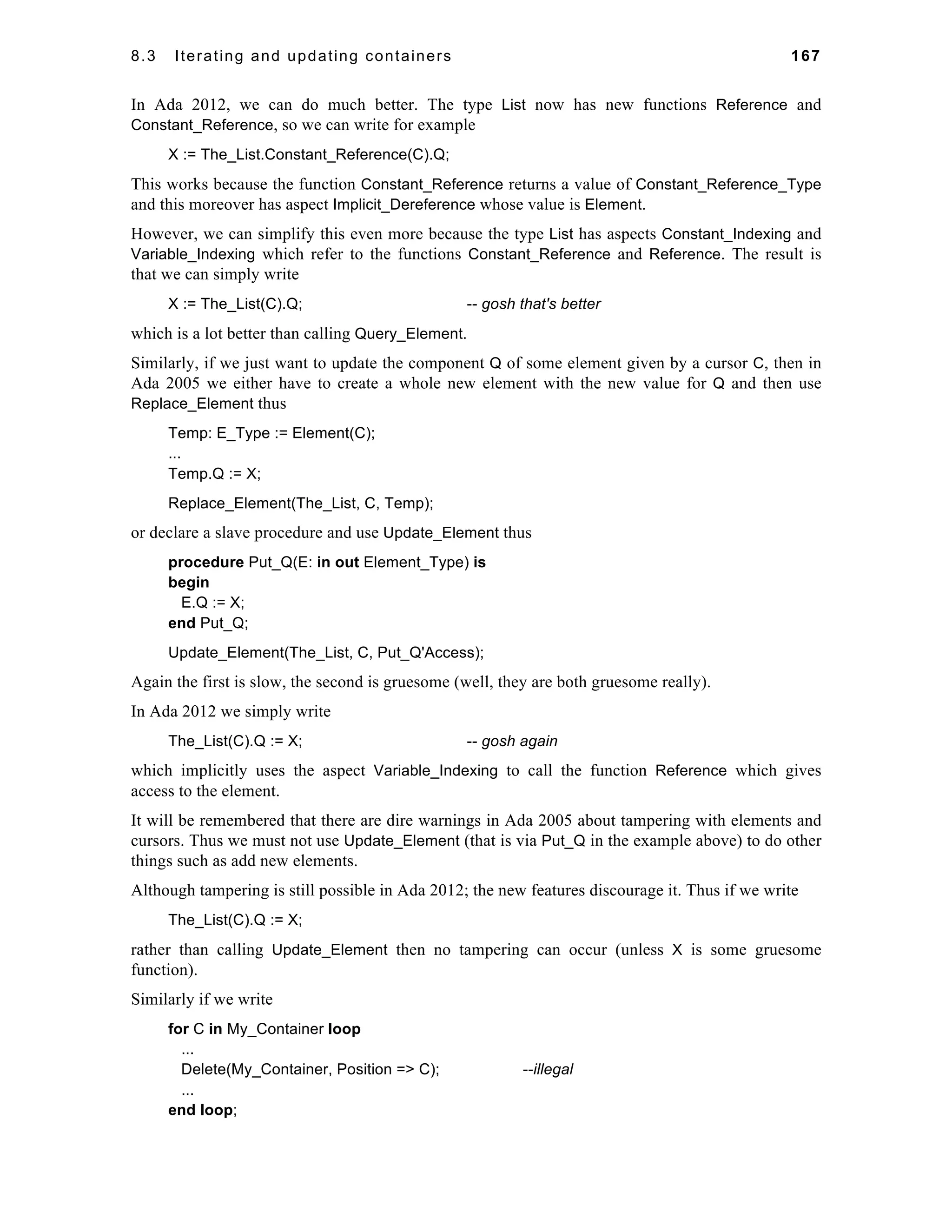
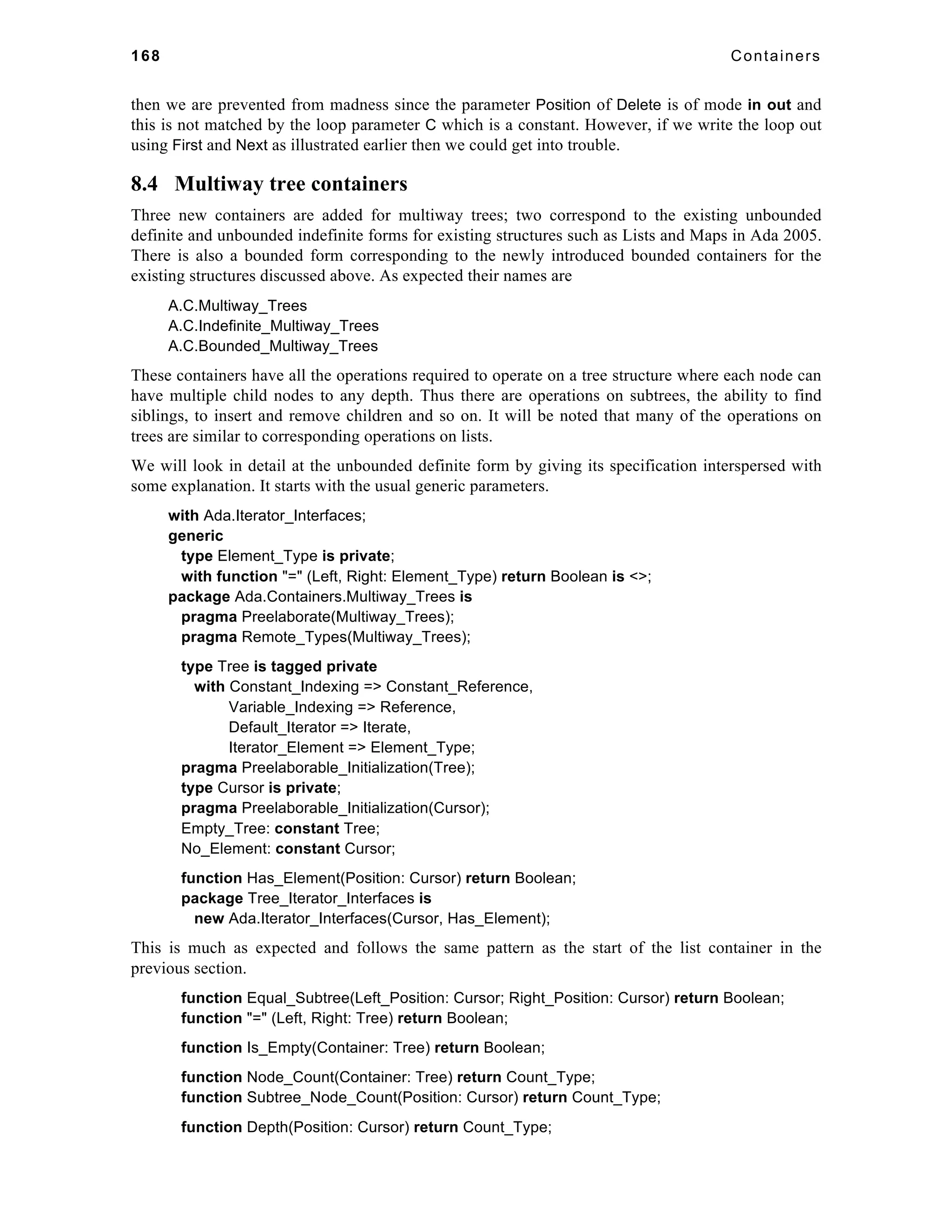
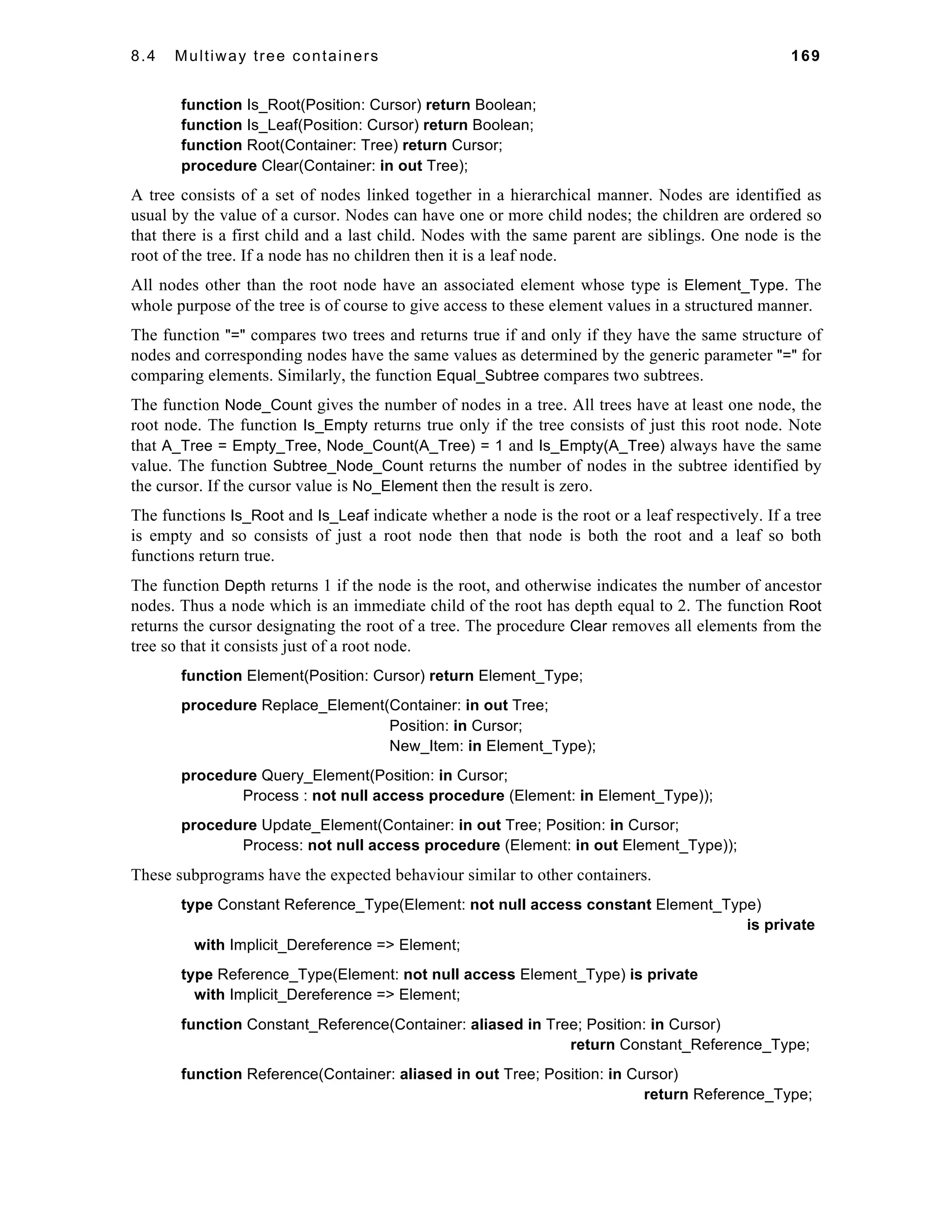
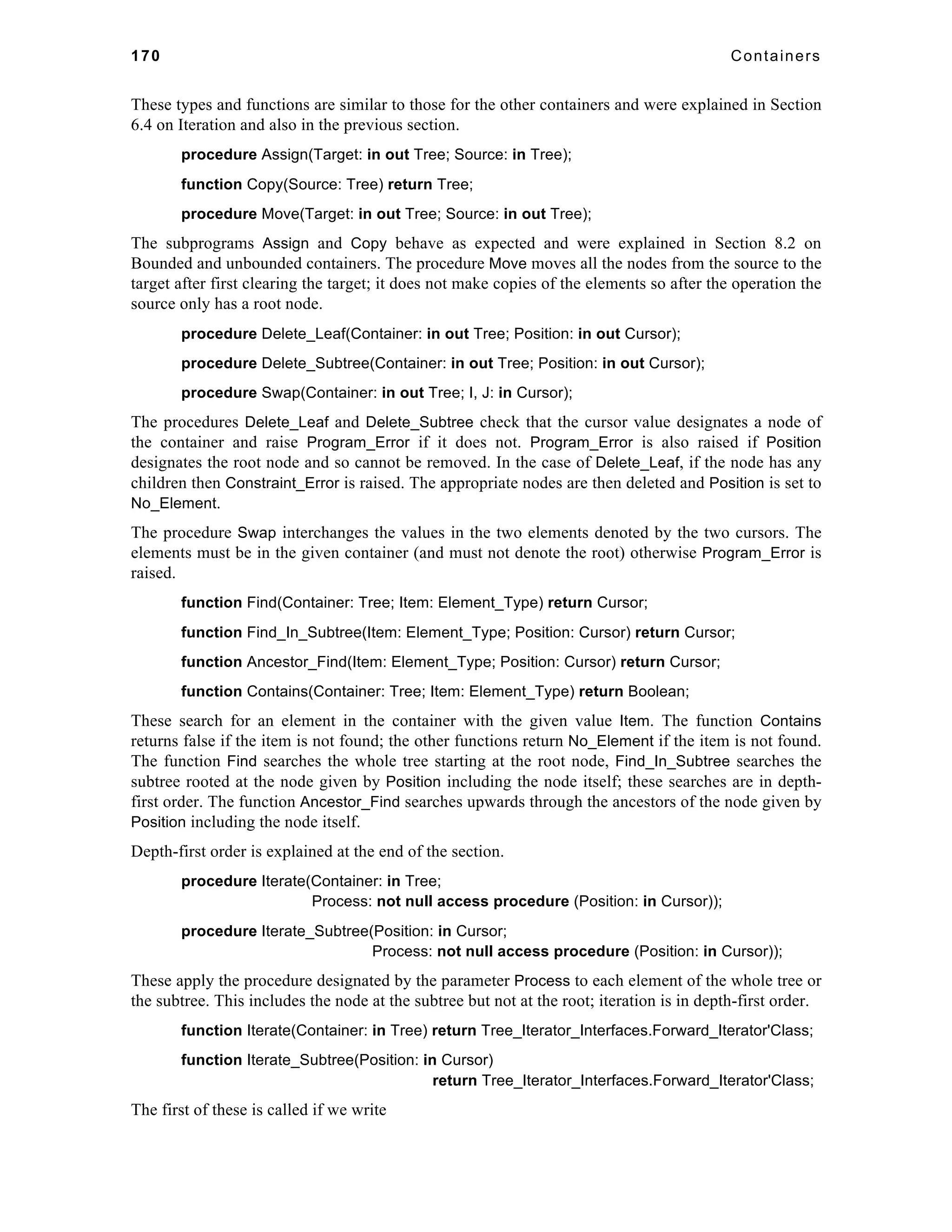
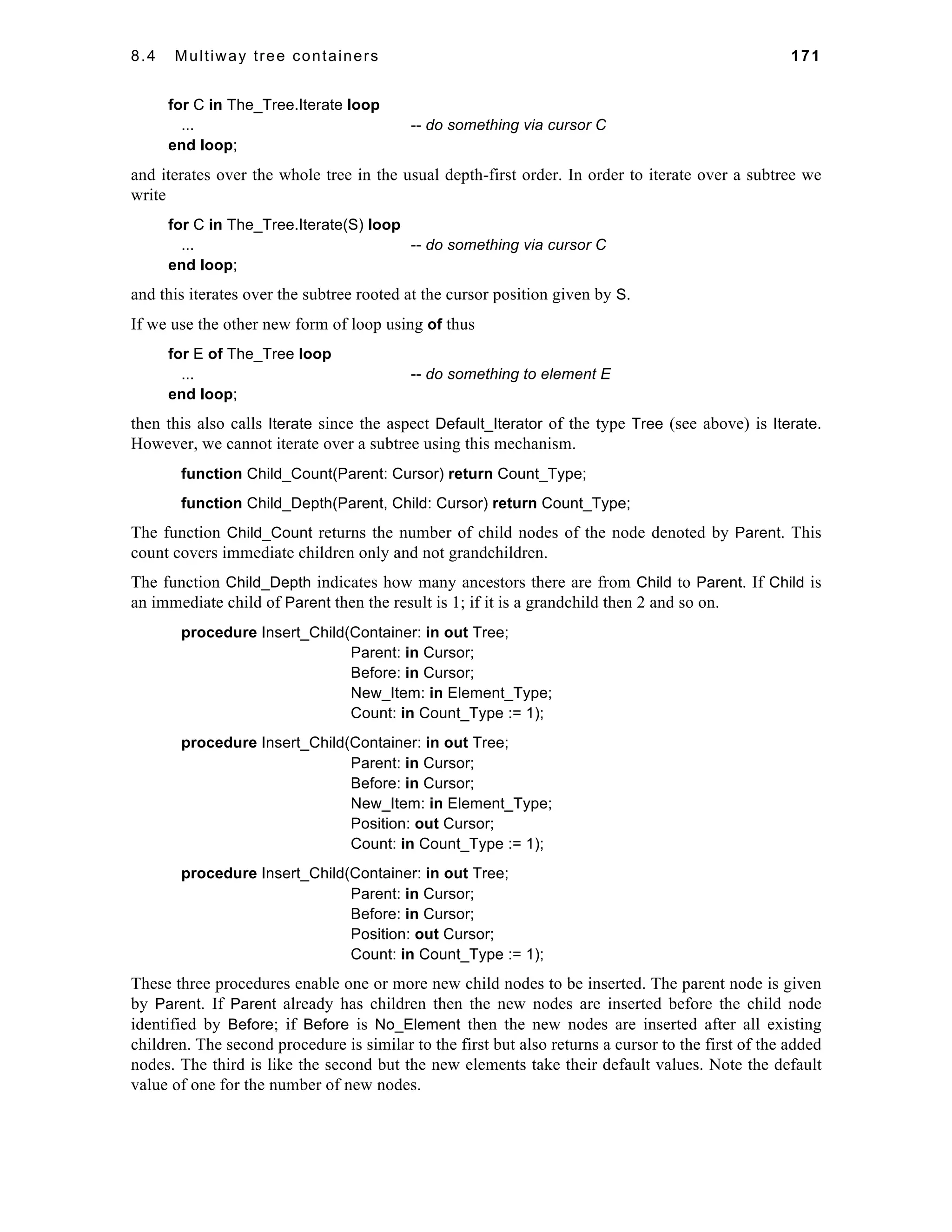
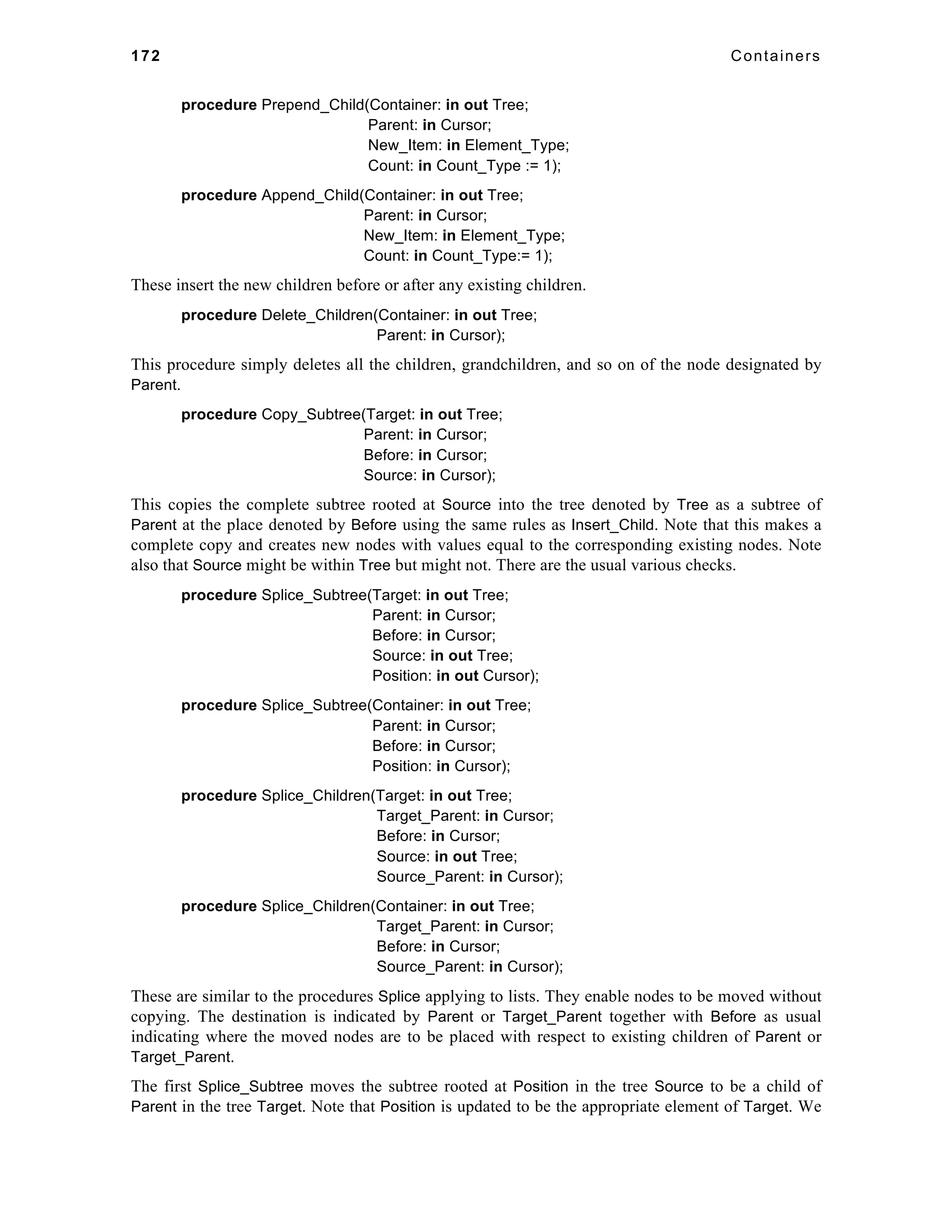
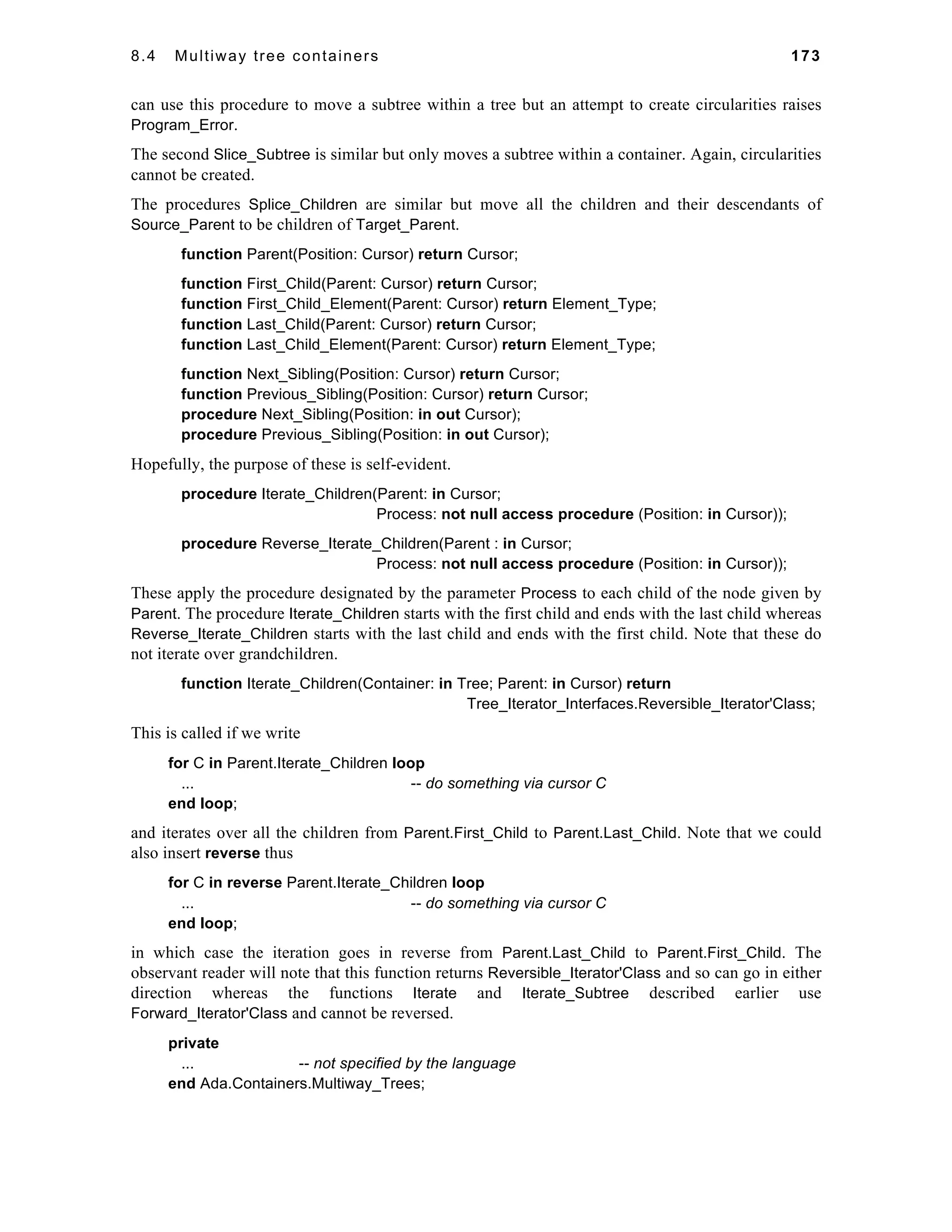
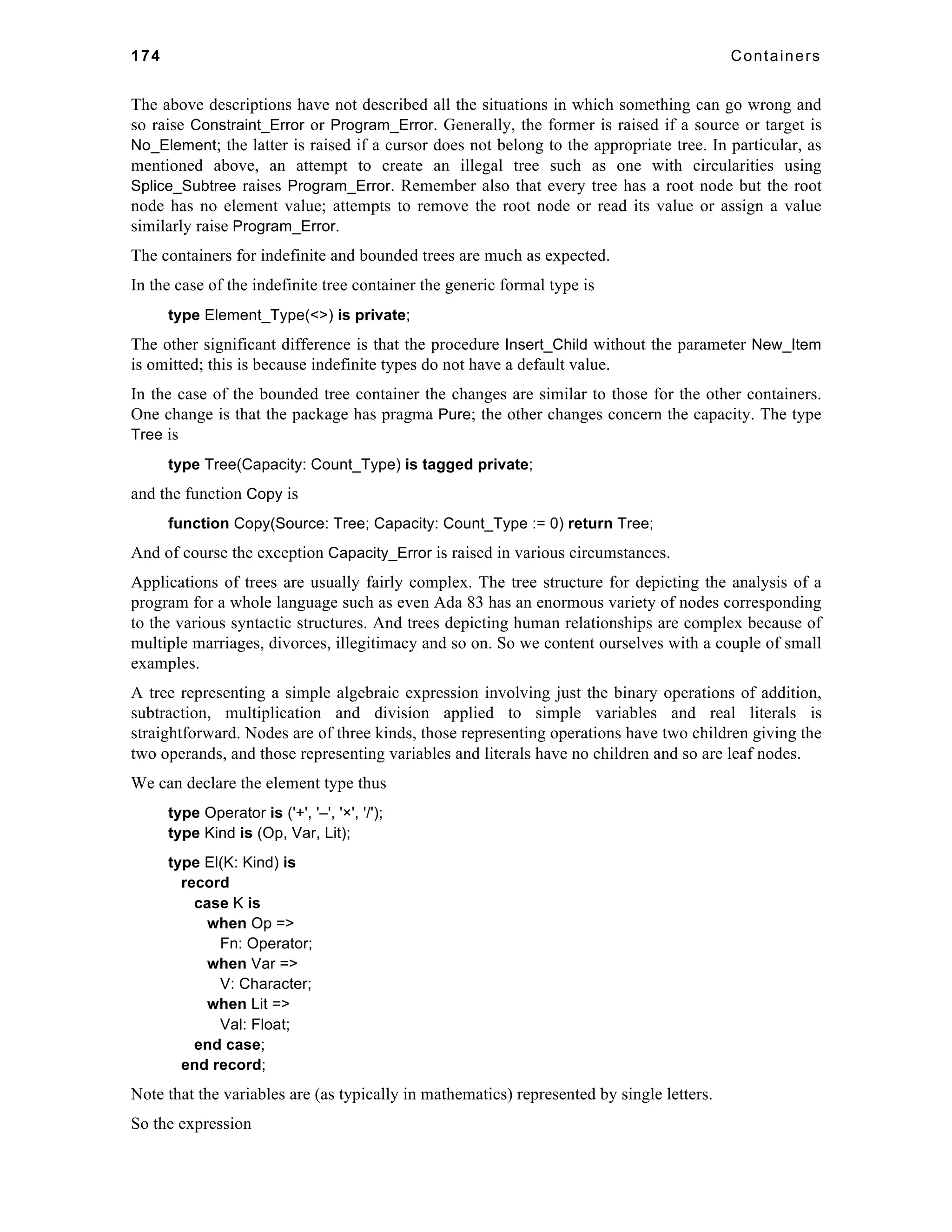
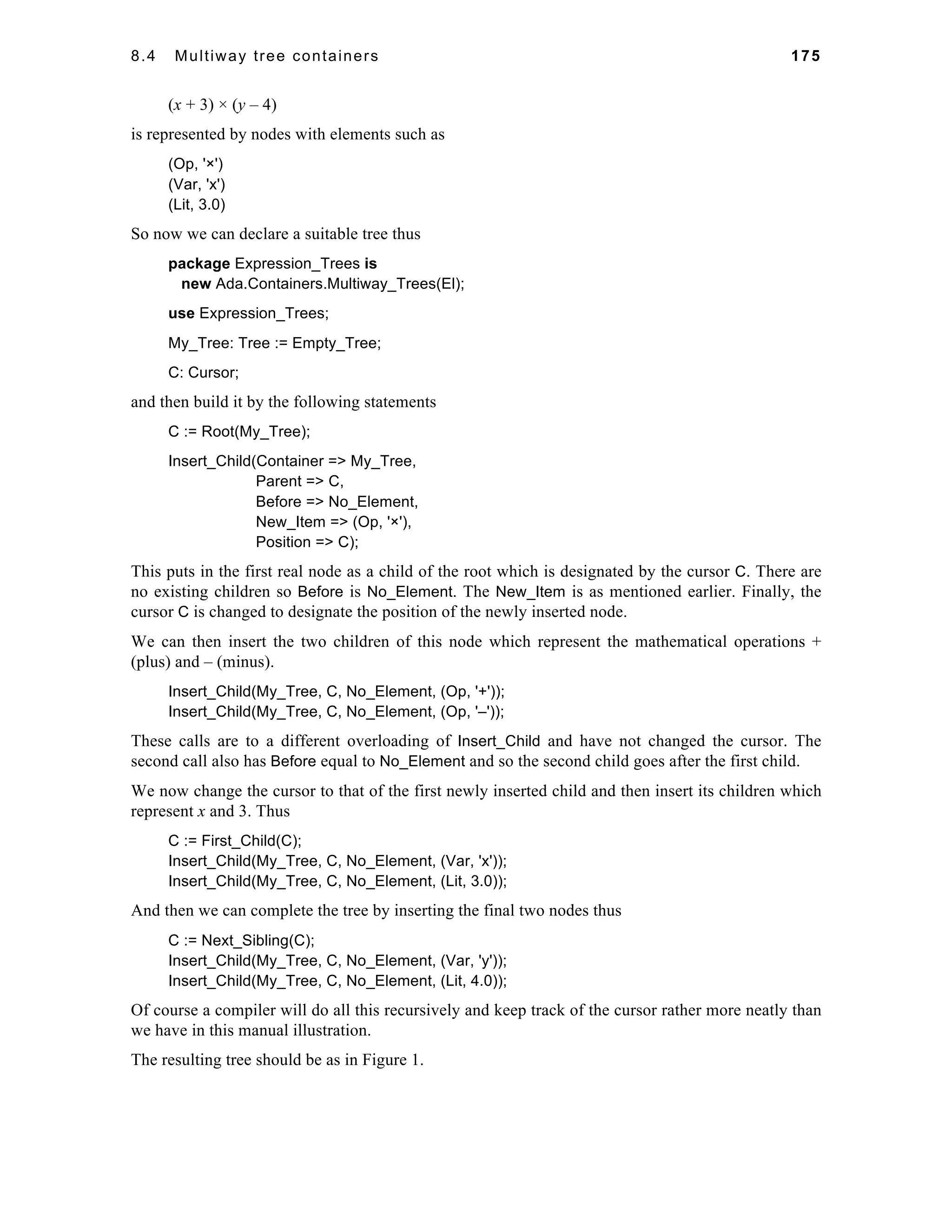
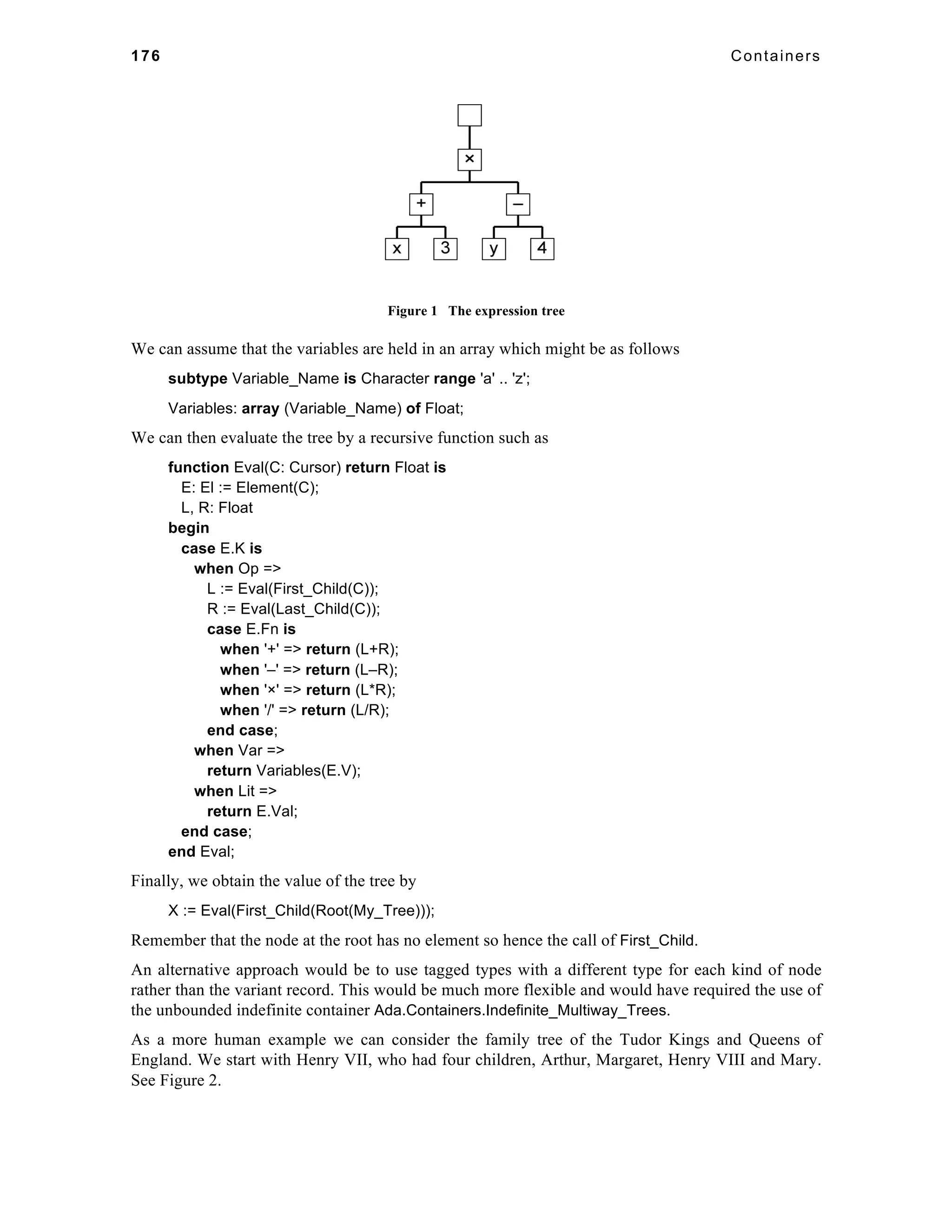
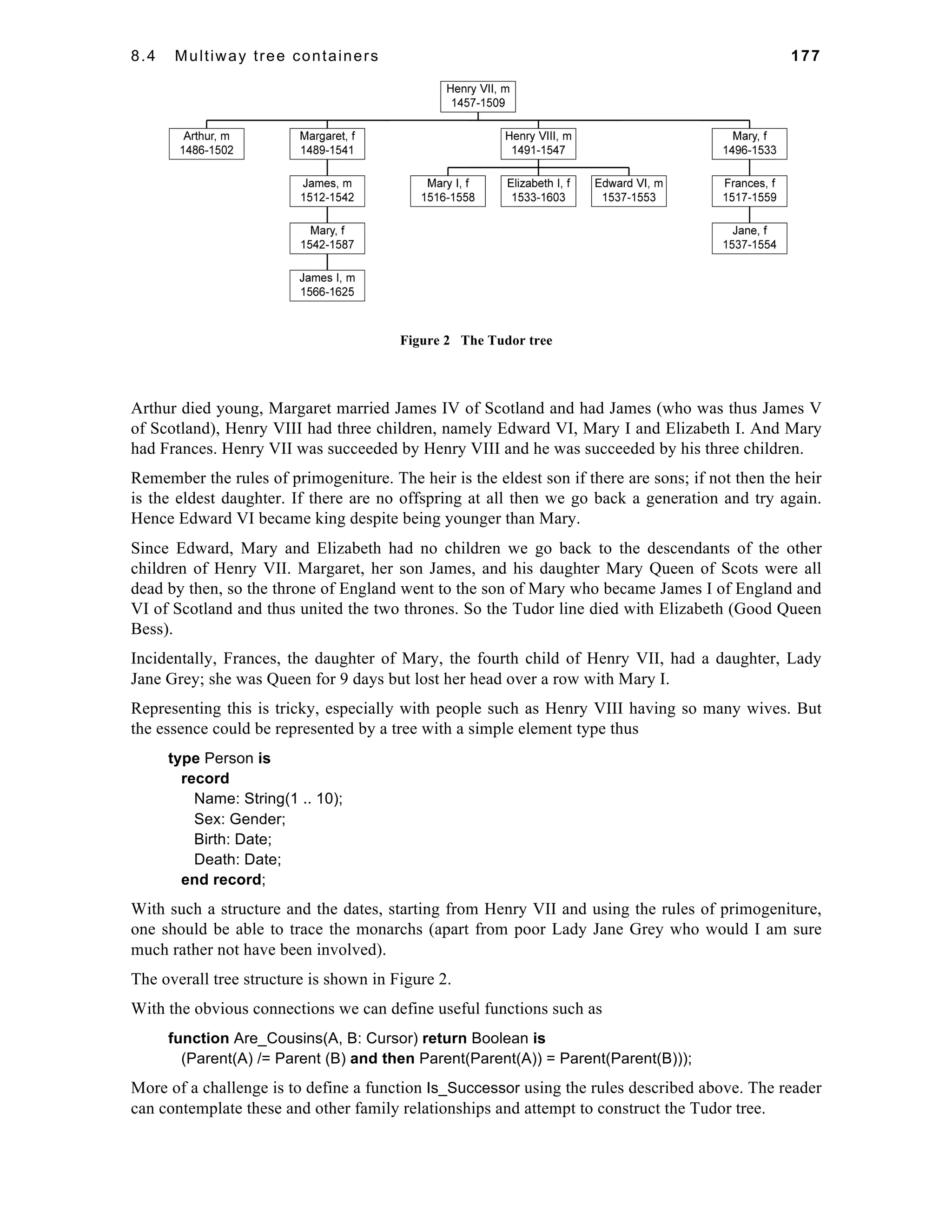

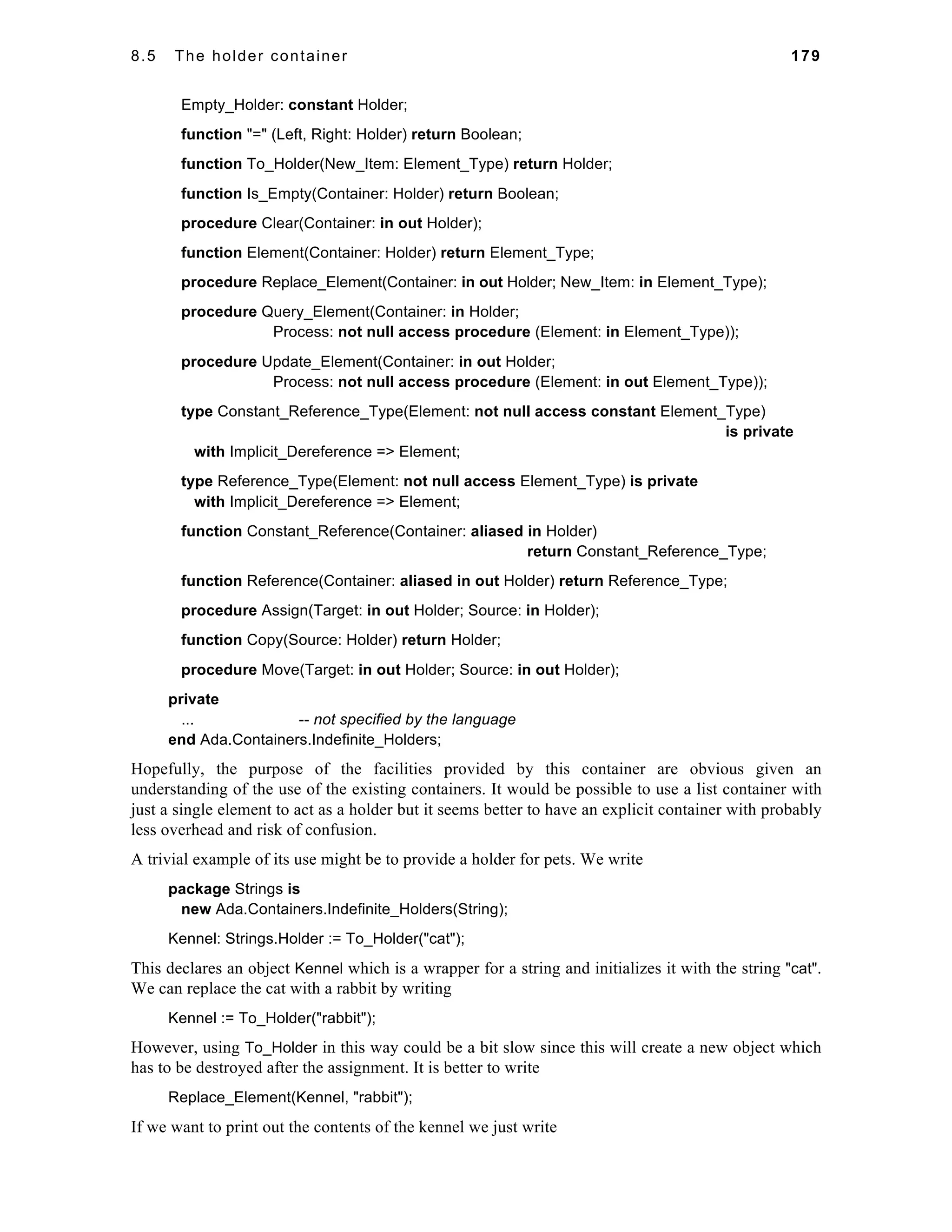
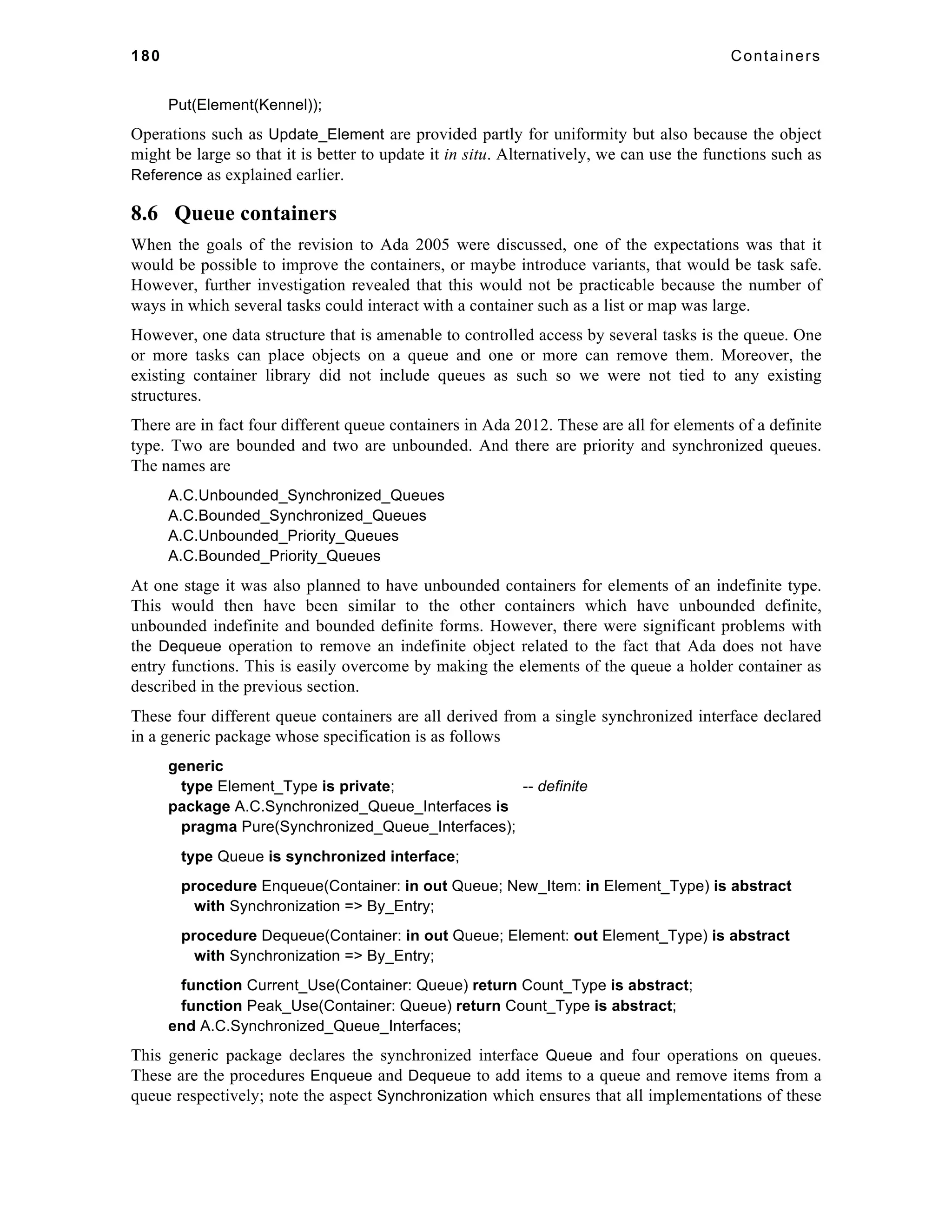
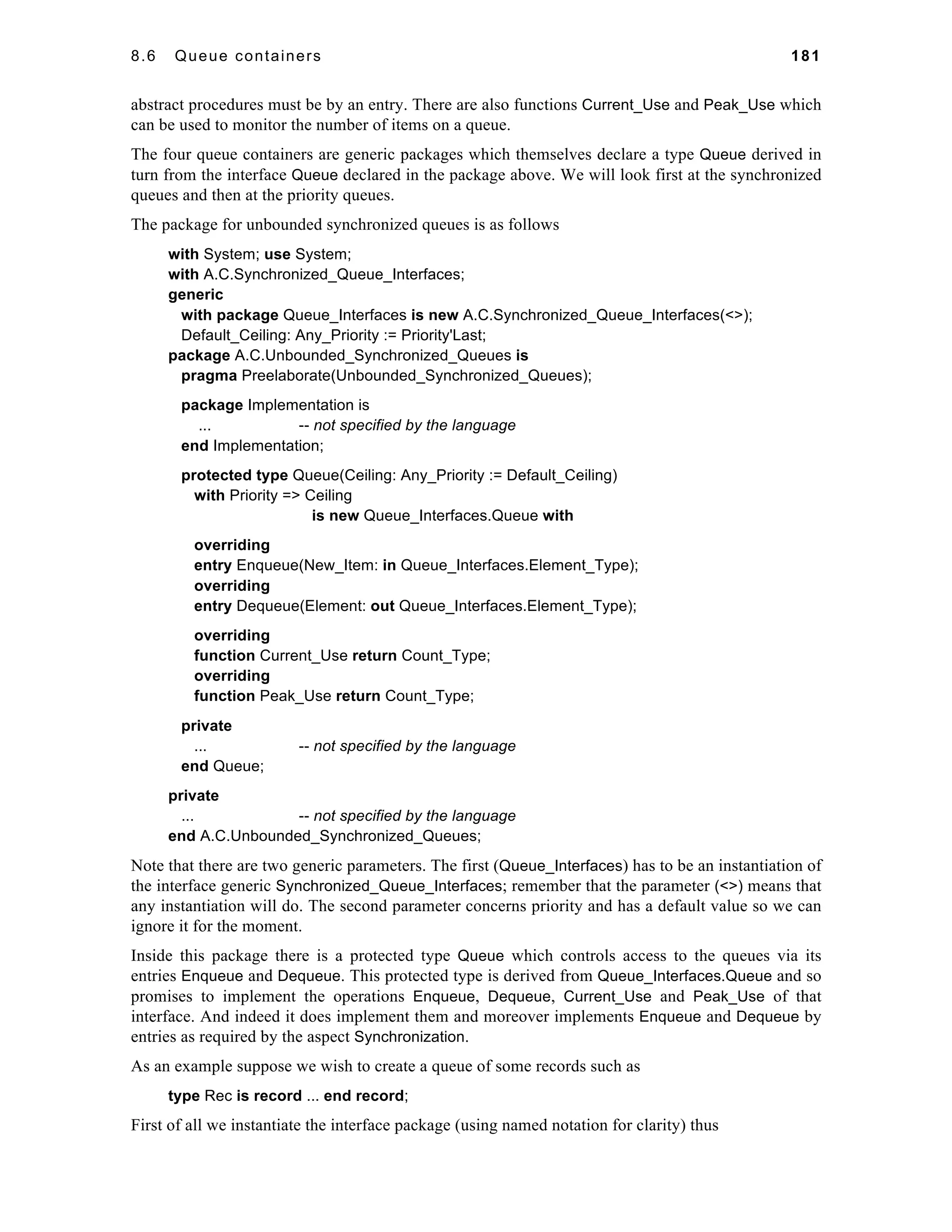
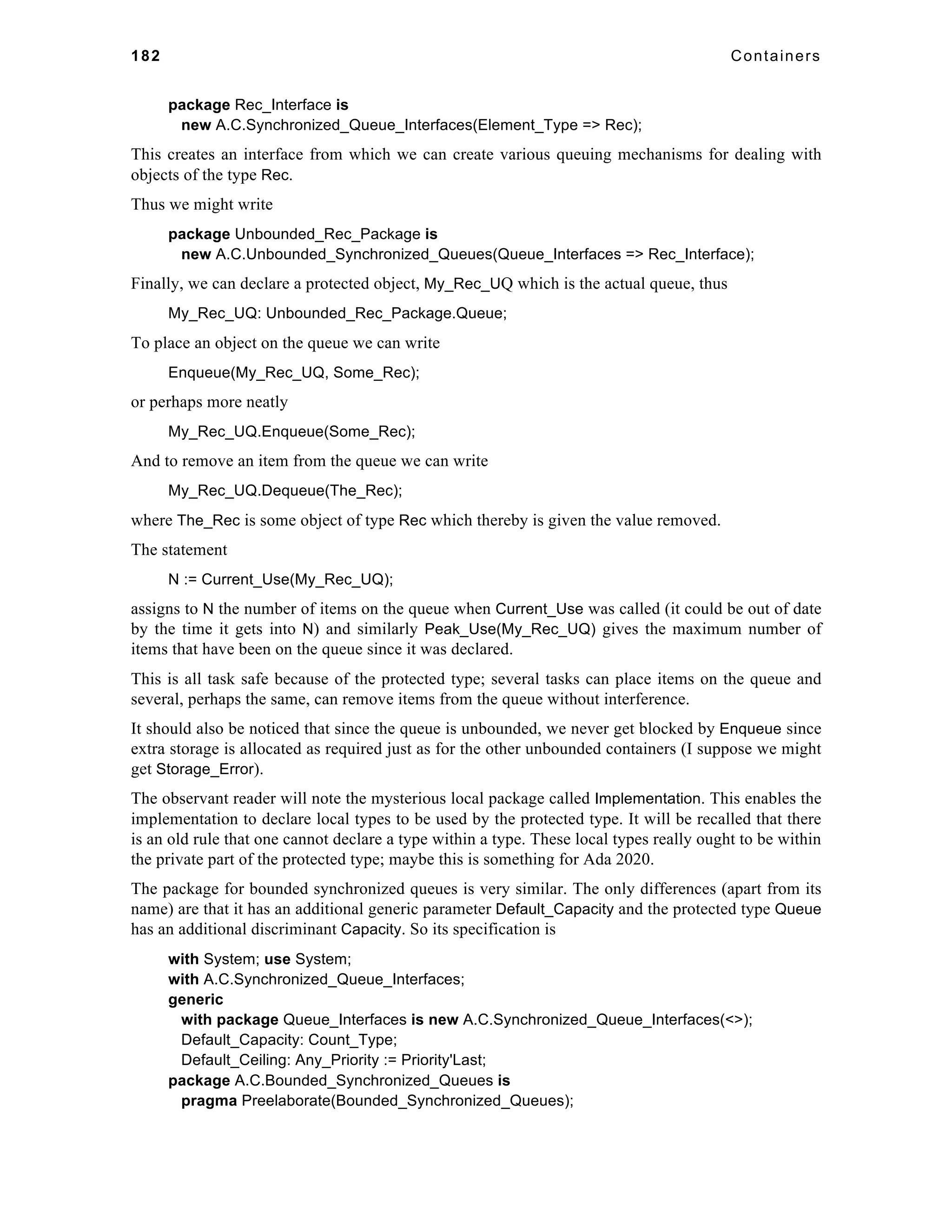
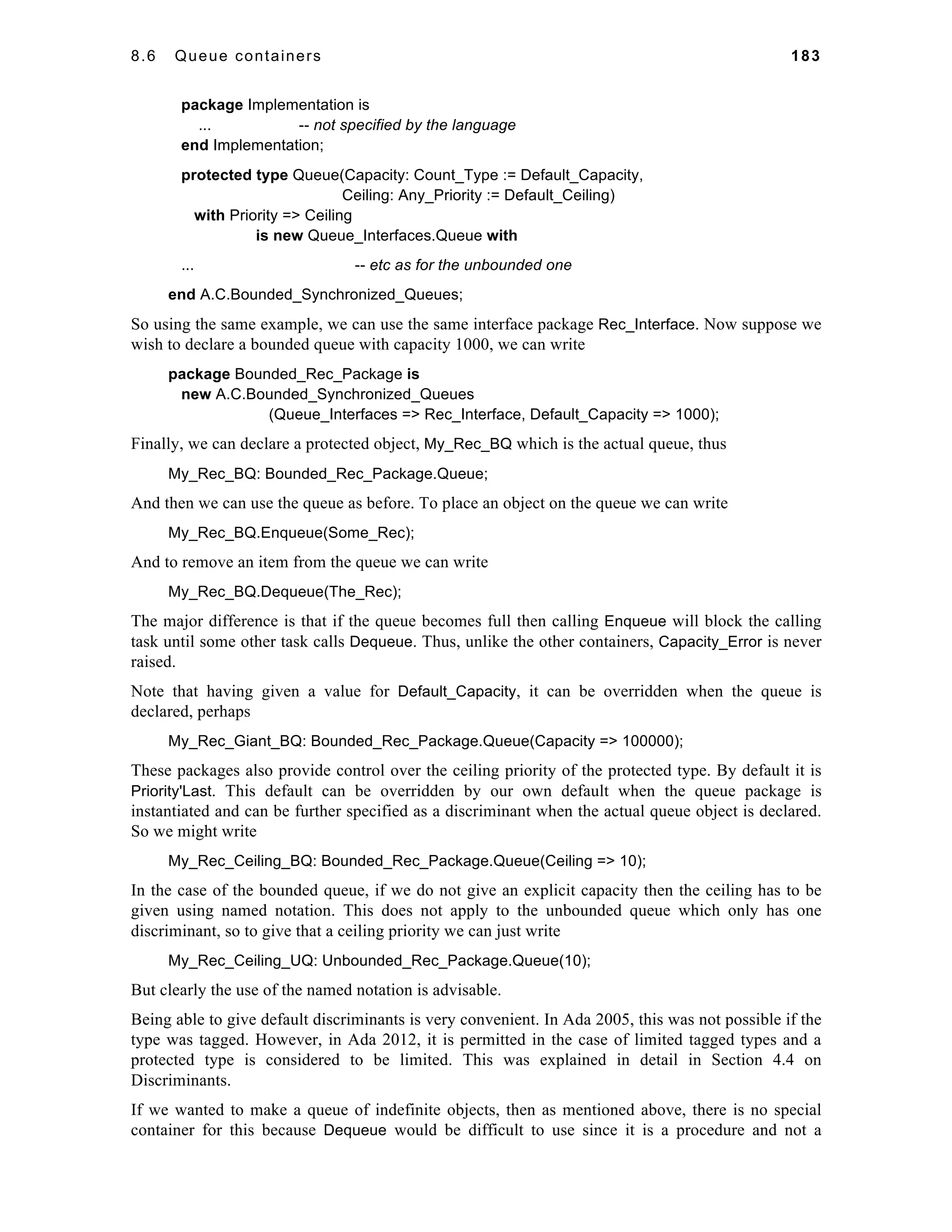
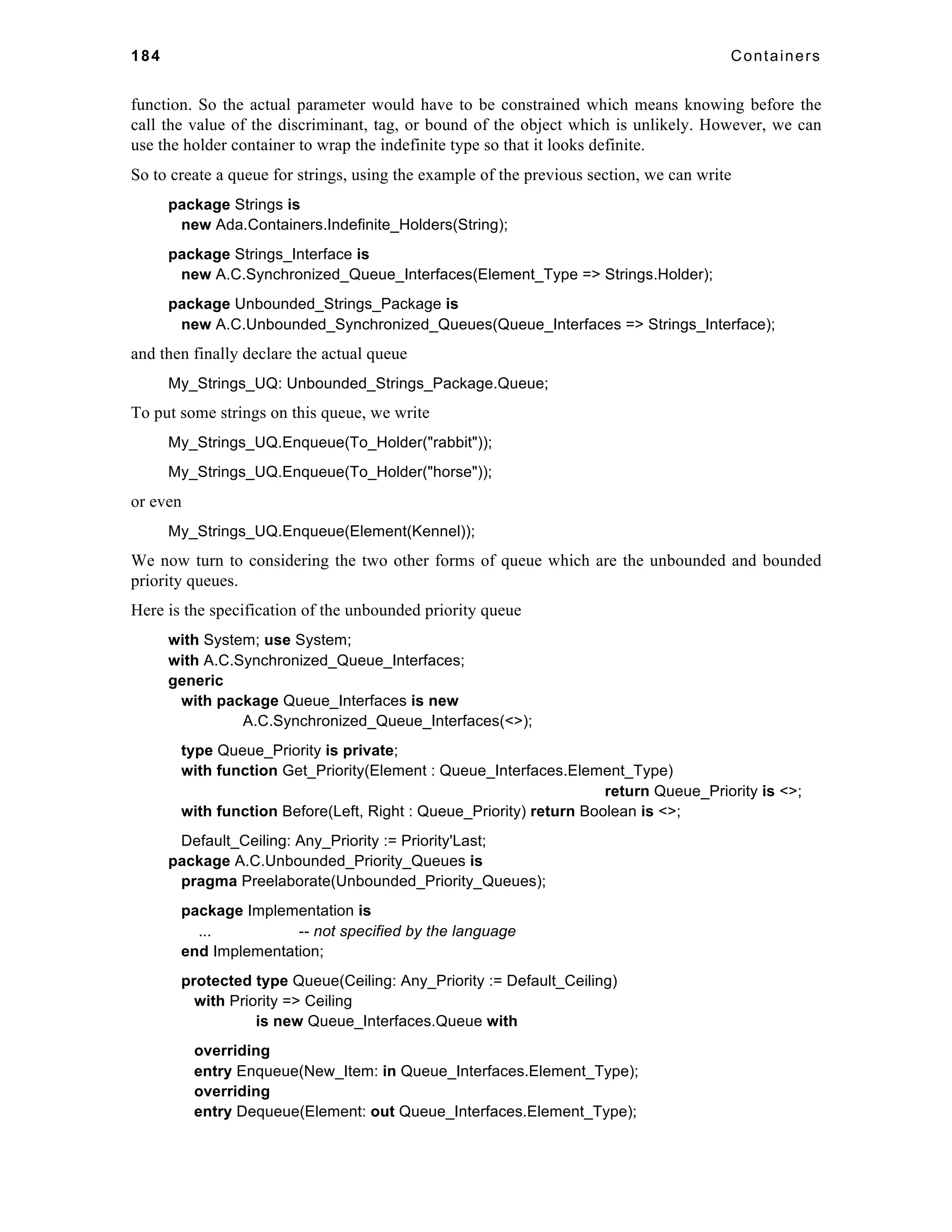
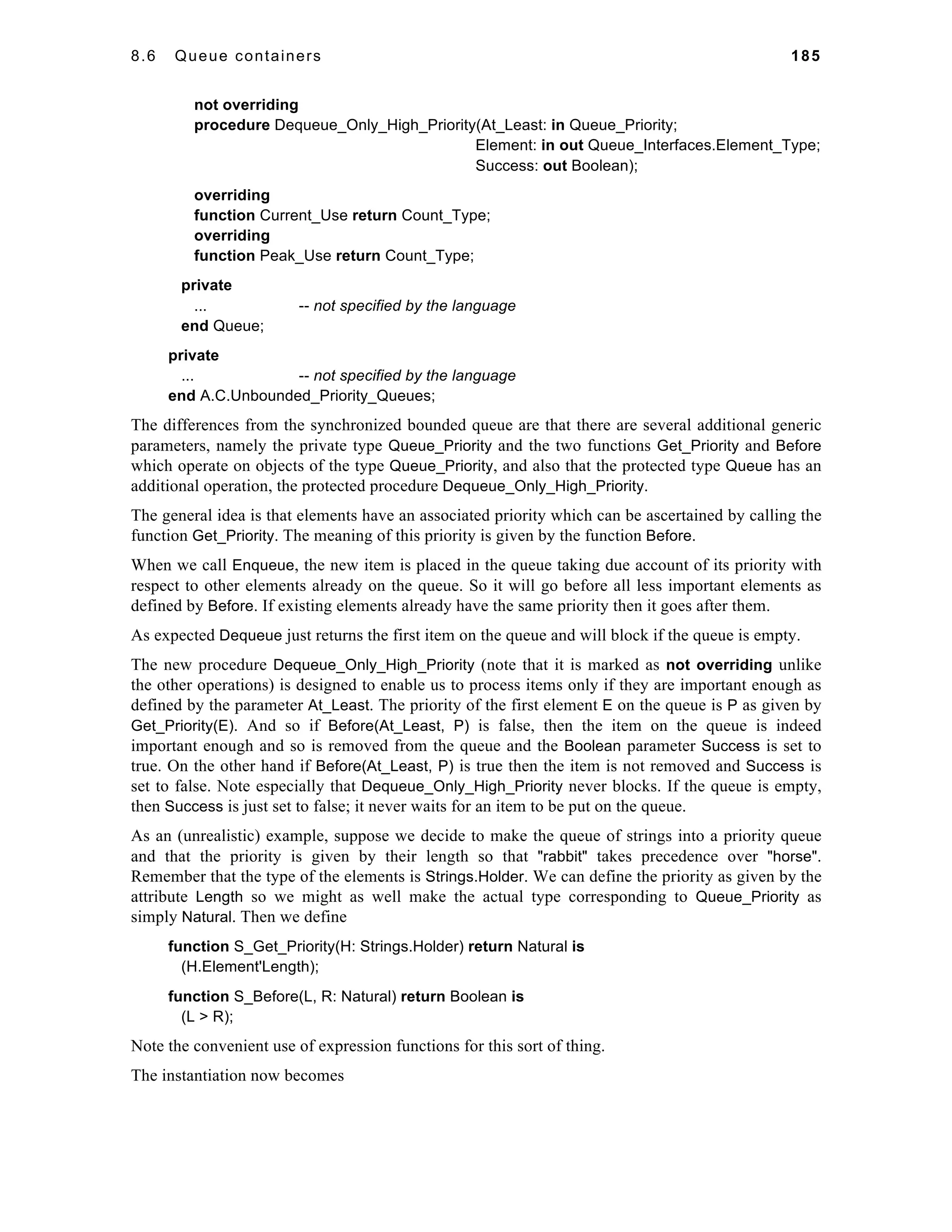
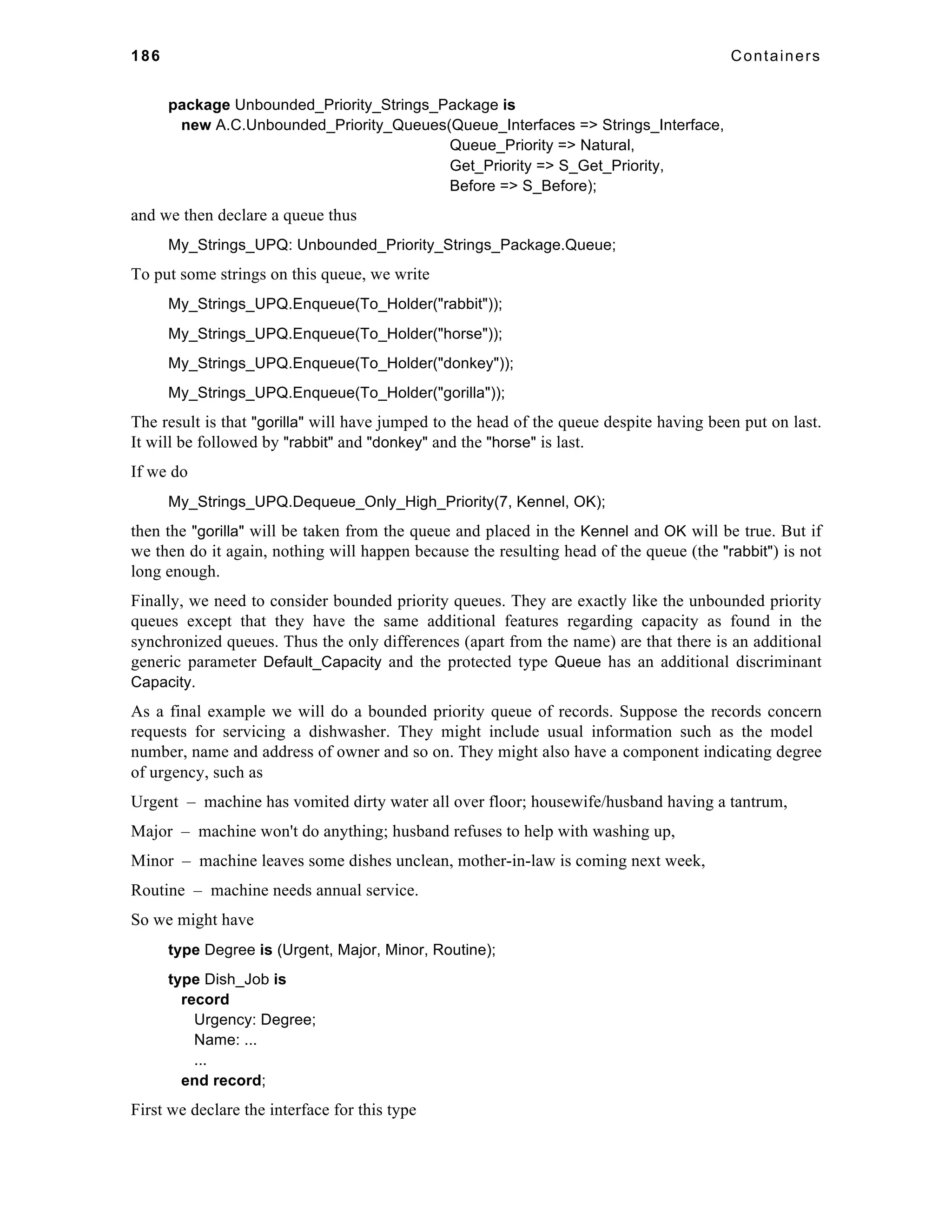

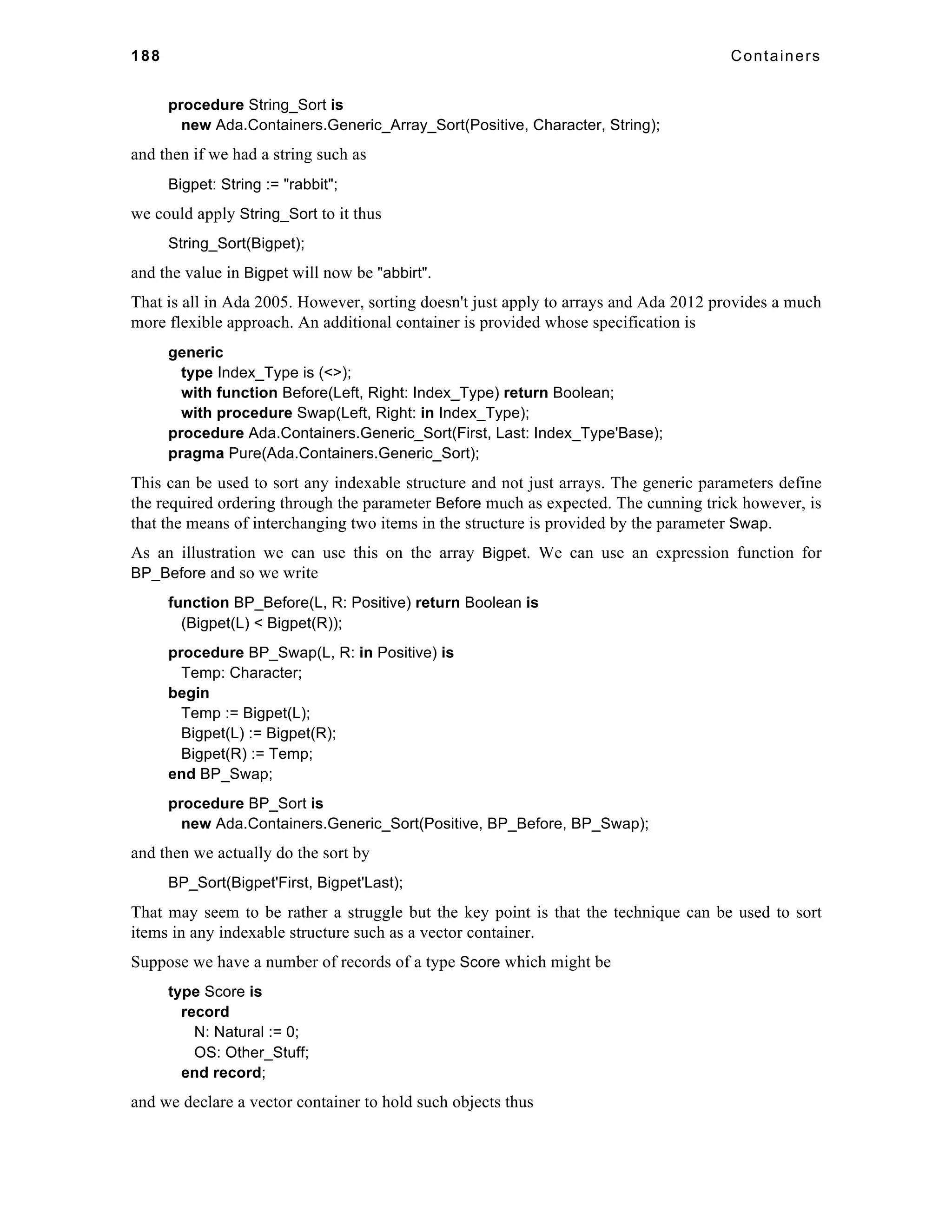


![191
9 Epilogue
This last chapter summarizes a small number of general issues of importance to the user
such as compatibility between Ada 2012 and Ada 2005. It also briefly revisits a number of
problems that were considered for Ada 2005 but rejected for various reasons; the important
ones have been solved in Ada 2012.
Finally, it discusses a small number of corrections that have been found necessary since the
standard was approved.
9.1 Compatibility
There are two main sorts of problems regarding compatibility. These are termed Incompatibilities
and Inconsistencies.
An incompatibility is a situation where a legal Ada 2005 program is illegal in Ada 2012. These can
be annoying but not a disaster since the compiler automatically detects such situations.
An inconsistency is where a legal Ada 2005 program is also a legal Ada 2012 program but might
have a different effect at execution time. These can in principle be really nasty but typically the
program is actually wrong anyway (in the sense that it does not do what the programmer intended)
or its behaviour depends upon the raising of a predefined exception (which is generally considered
poor style) or the situation is extremely unlikely to occur.
As mentioned below in Section 2, during the development of Ada 2012 a number of corrections
were made to Ada 2005 and these resulted in some incompatibilities and inconsistencies with the
original Ada 2005 standard. These are not considered to be incompatibilities or inconsistencies
between Ada 2005 and Ada 2012 and so are not covered in this section.
9.1.1 Incompatibilities with Ada 2005
Each incompatibility listed below gives the AI concerned and the paragraph in the AARM which in
some cases will give more information. Where relevant, the section in this rationale where the topic
is discussed is also given. Where appropriate the incompatibilities are grouped together.
Note that this list only covers those incompatibilities that might reasonably occur. There are a
number of others which are so unlikely that they do not seem worth mentioning.
1 – The word some is now reserved. Programs using it as an identifier will need to be changed.
(AI-176, 2.9)
Adding new reserved words is a very visible incompatibility. Six were added in Ada 95, three in
Ada 2005, and now just one in Ada 2012. Perhaps this is the end of the matter. The word some is
used in quantified expressions; it already was reserved in SPARK [13] where it is used in quantified
expressions in proof contexts.
2 – If a predefined package has additional entities then incompatibilities can arise. Thus suppose
the predefined package Ada.Stuff has an additional entity More added to it. Then if an Ada 2005
program has a package P containing an entity More then a program with a use clause for both
Ada.Stuff and P will become illegal in Ada 2012 because the reference to More will become
ambiguous. This also applies if further overloadings of an existing entity are added.
This can be overcome by adding child packages of course. However, adding lots of child packages
can be an inconvenience for the user and so in many cases extending a package seemed more
appropriate especially if the identifiers concerned are unlikely to have been used by programmers.
The following packages have been extended with additional entities as listed.](https://image.slidesharecdn.com/ada2012rationale-141002094233-phpapp01/75/Ada2012-Rationale-201-2048.jpg)
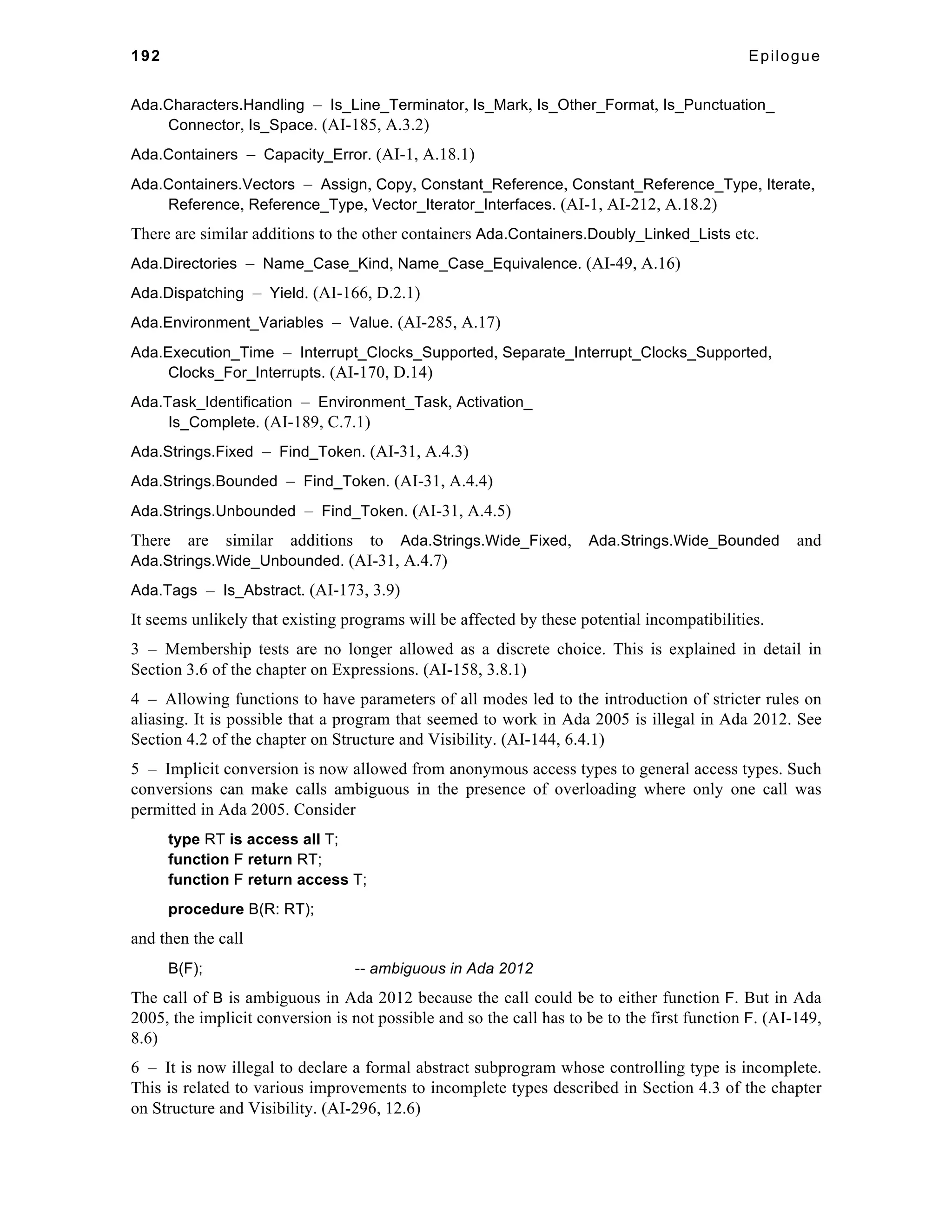
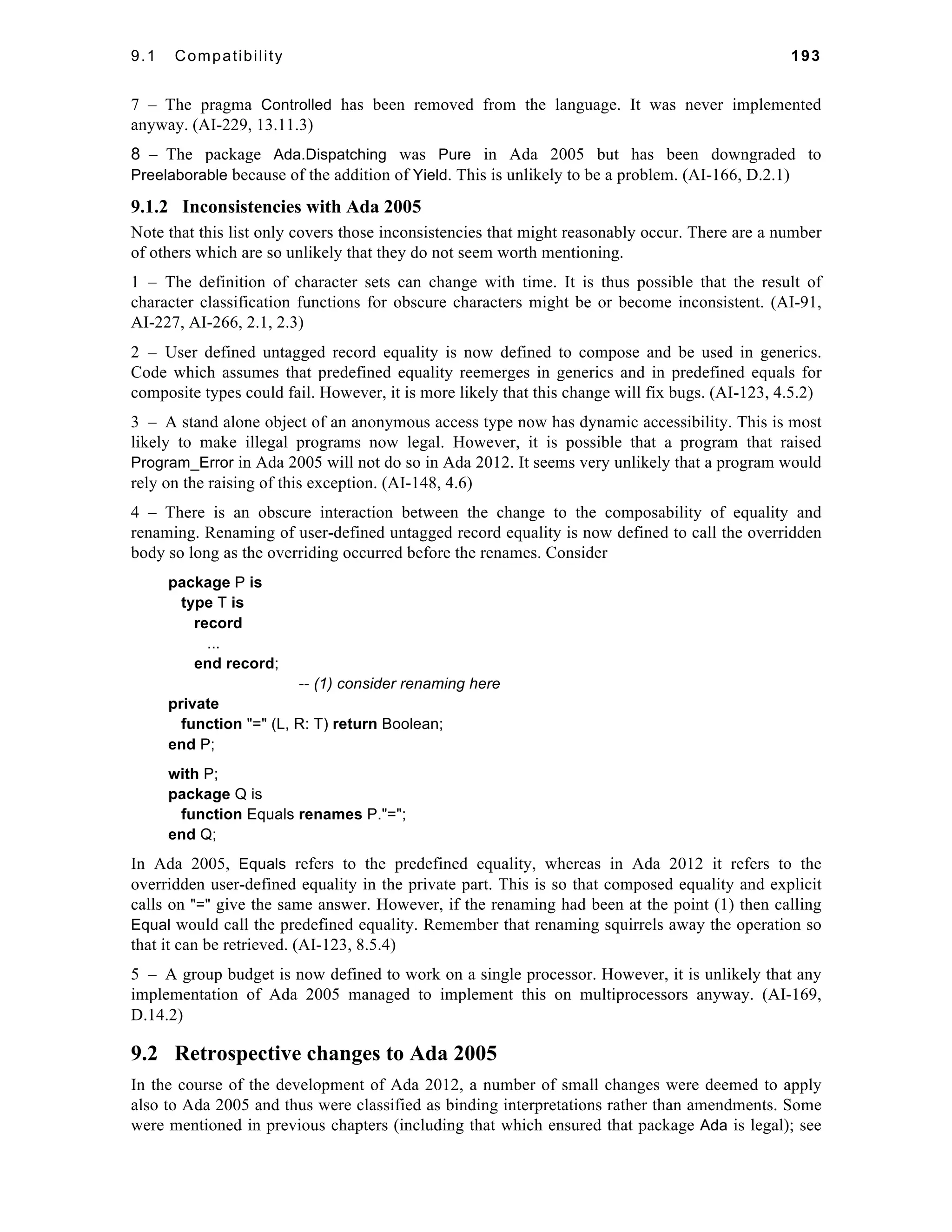
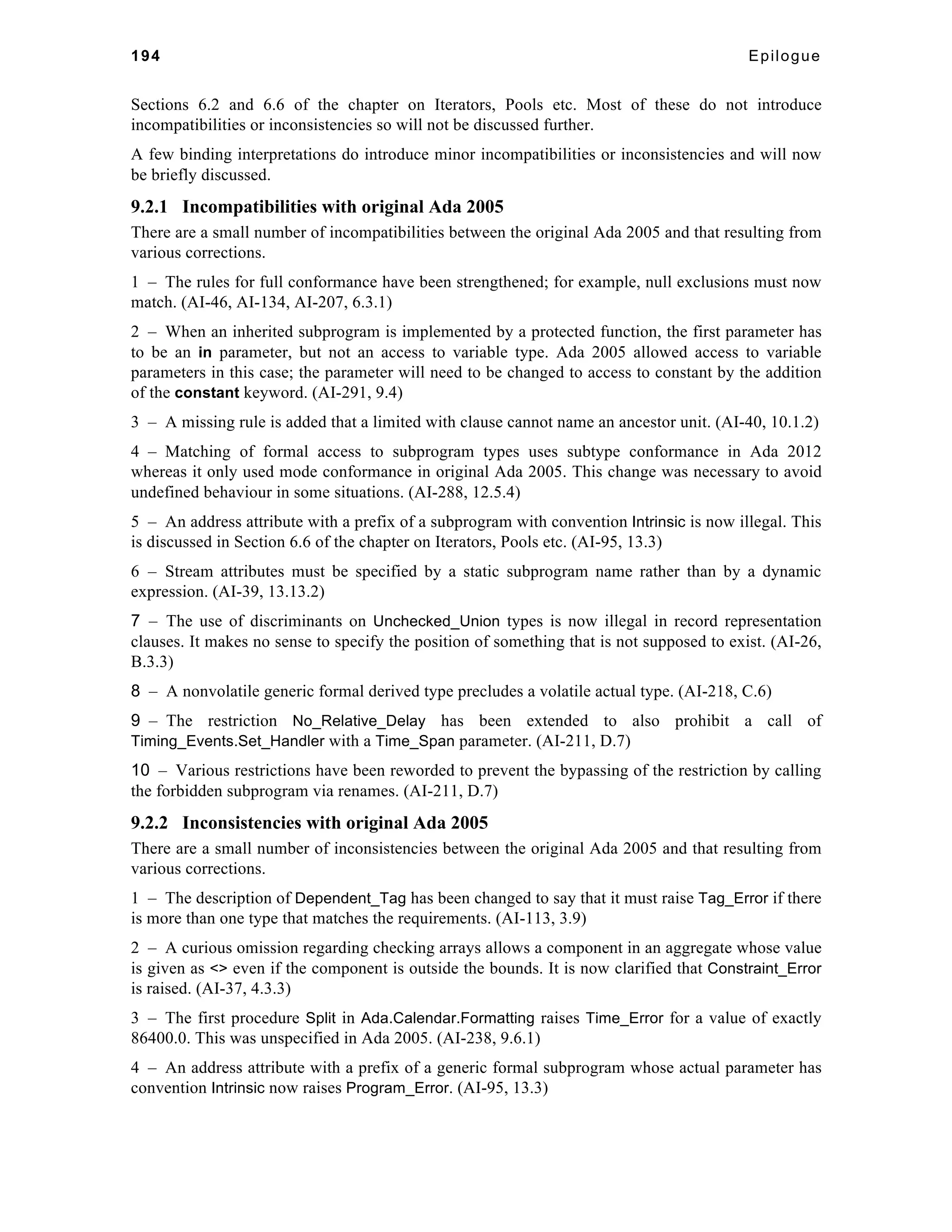
![9.2 Retrospective changes to Ada 2005 195
5 – User specified external tags that conflict with other external tags now raise Program_Error or
are illegal. (AI-113, 13.3)
6 – The definition of Set_Line is corrected. As originally defined in Ada 95 and Ada 2005,
Set_Line(1) could call New_Line(0) which would raise Constraint_Error which is unhelpful. This
was mentioned right at the end of the Postscript in the Rationale for Ada 2005 [15]. (AI-38, A.10.5)
7 – The definitions of Start_Search, Search, Delete_Directory, and Rename are clarified so that
they raise the correct exception if misused. (AI-231, A.16)
8 – If Count = 0 for a container Insert subprogram that has a Position parameter, the Position
parameter is set to the value of the Before parameter by the call. The original wording remained
silent on this. (AI-257, A.18.3)
9.3 Unfinished topics from Ada 2005
A number of topics which seemed to be good ideas initially were abandoned during the development
of Ada 2005 for various reasons. Usually the reason was simply that a good solution could not be
produced in the time available and the trouble with a bad solution is that it is hard to put it right
later. This section briefly reconsiders these topics which were discussed in the Rationale for Ada
2005 [15]; some have now been solved in Ada 2012; the others were considered unimportant.
9.3.1 Aggregates for private types
The <> notation was introduced in Ada 2005 for aggregates to mean the default value if any. A
curiosity is that we can write
type Secret is private;
type Visible is
record
A: Integer;
S: Secret;
end record;
X: Visible := (A => 77; S => <>);
but we cannot write
S: Secret := <>; -- illegal
The argument is that this would be of little use since the components take their default values
anyway.
For uniformity it was proposed that we might allow
S: Secret := (others => <>);
for private types and also for task and protected types. One advantage would be that we could then
write
S: constant Secret := (others => <>);
whereas it is not possible to declare a constant of a private type because we are unable to give an
initial value.
However, discussion of this issue led into a quagmire in Ada 2005 and so was abandoned. It remains
abandoned in Ada 2012!](https://image.slidesharecdn.com/ada2012rationale-141002094233-phpapp01/75/Ada2012-Rationale-205-2048.jpg)
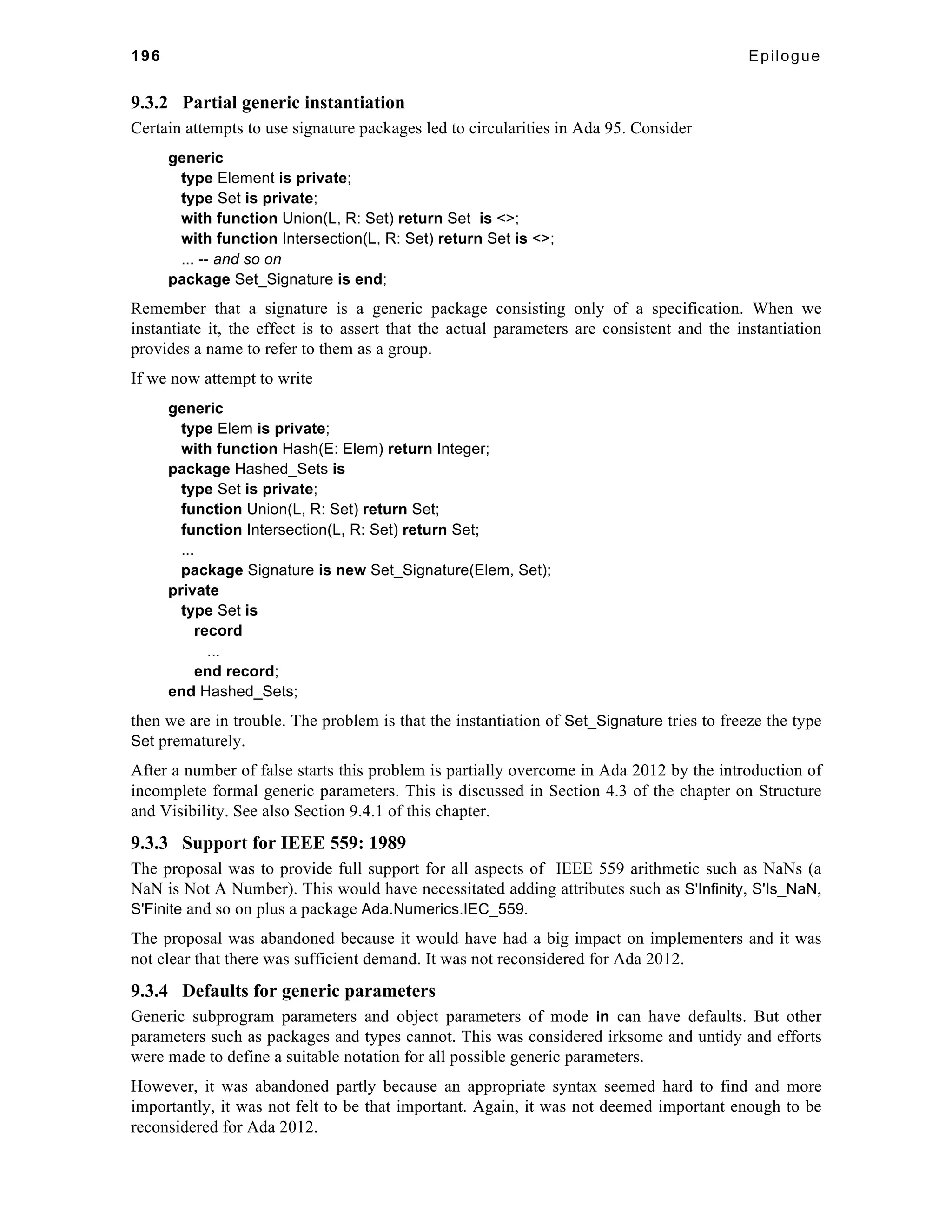
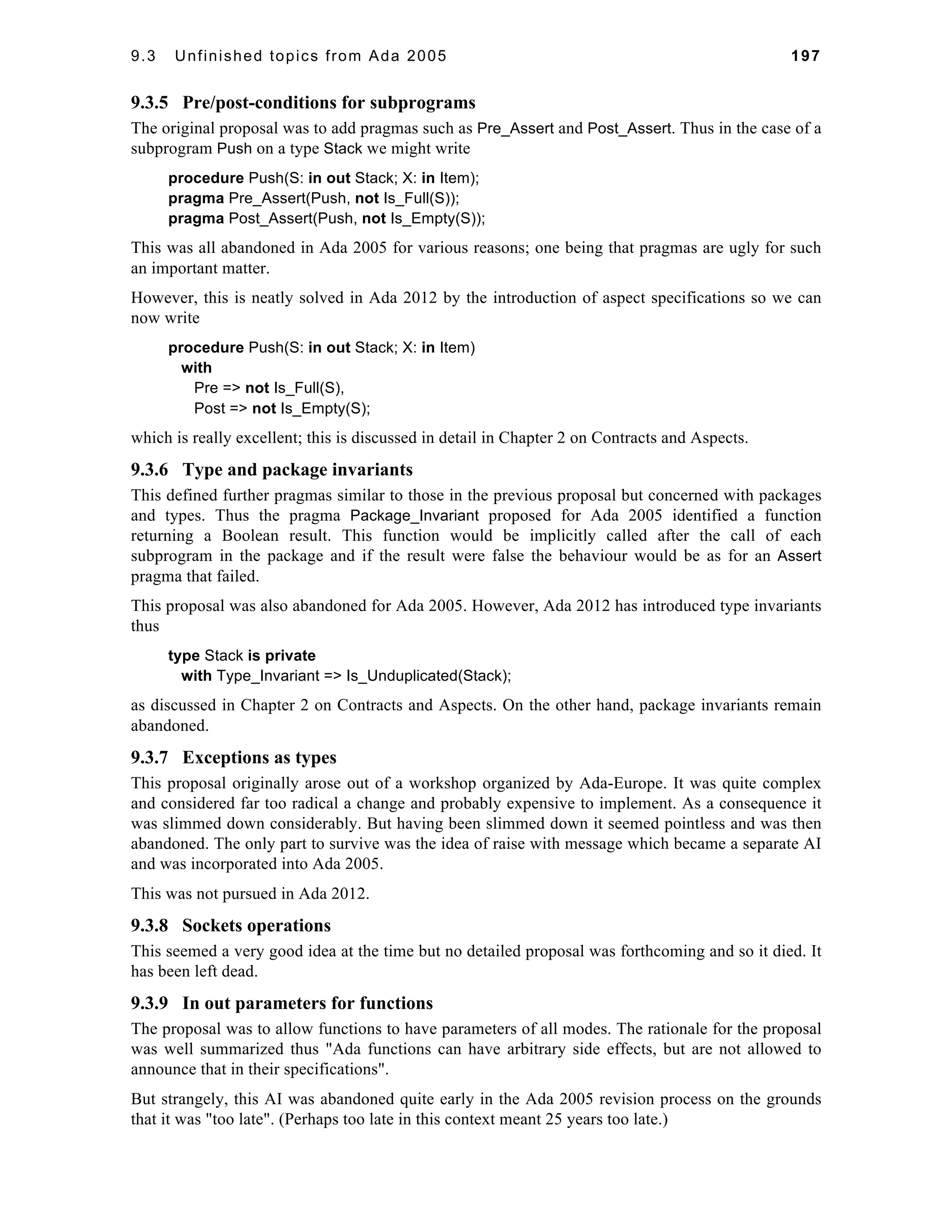
![198 Epilogue
However, in Ada 2012, the bullet has been bitten and functions can indeed now have parameters of
all modes. See the discussion in Section 4.2 of the chapter on Structure and Visibility.
9.3.10 Application defined scheduling
The International Real-Time Ada Workshops have been a source of suggestions for improvements
to Ada. The Workshop at Oporto suggested a number of further scheduling algorithms [24]. Most of
these such as Round Robin and EDF were included in Ada 2005. But that for application defined
scheduling was not.
No further action on this topic was taken in Ada 2012.
9.4 Unfinished topics for Ada 2012
A number of topics which seemed to be good ideas initially were abandoned during the development
of Ada 2012 for various reasons. It is interesting to note that there are far fewer of these loose ends
than there were in Ada 2005. The following deserve mention.
9.4.1 Integrated packages (AI-135)
Difficulties sometimes arise with nested packages. Consider for example a package that needs to
export a private type T and a container instantiated for that type. We cannot write
package P is
type T is private;
package T_Set is new Ordered_Sets(T);
private
...
end P;
because the type T is not frozen. We have to write something like
package P is
package Inner is
type T is private;
private
...
end Inner;
package T_Set is new Ordered_Sets(Inner.T);
end P;
What we now want is some way to say that the declarations in Inner are really at the level of P itself
after all. In other words we want to integrate the package Inner with the outer package P.
Various attempts were made to solve this by another kind of use clause or perhaps by putting Inner
in a <> box. But all attempts led to difficulties so this remains unresolved.
9.4.2 Cyclic fixed point (AI-175)
Measurements in the physical world of Euclid and Newton are either lengths or angles. Angles are
cyclic in nature and so can be mapped with a modular type. However, this leaves scaling in the
hands of the user and is machine dependent. Consideration was given to the possibility of a cyclic
form of fixed point. Sadly, there was much hidden complexity and so no solution was agreed.
One might have thought that it would be easy to use the natural wrap-around hardware. However,
with a binary machine, if 180 degrees is held exactly then 60 degrees is not which excludes an exact
representation of an equilateral triangle. The whole point about using fixed point is that it is precise
but it just doesn't work unless the hardware uses a base with divisibility by 60. The Babylonians](https://image.slidesharecdn.com/ada2012rationale-141002094233-phpapp01/75/Ada2012-Rationale-208-2048.jpg)
![9.4 Unfinished topics for Ada 2012 199
would have understood. The text of AI-175 includes a generic which might be useful for many
applications.
9.4.3 Global annotations (AI-186)
The idea here was that the specification of a subprogram should have annotations indicating the
global objects that it might manipulate. For example a function can have side effects on global
variables but this important matter is not mentioned in the specification. This topic has strong
synergy with the information given in contracts such as pre- and postconditions. However, it was
abandoned perhaps because of the complexity arising from the richness of the full Ada language. It
should be noted that such annotations have always featured in SPARK as comments and moreover, at
the time of writing, are being considered using the aspect notation in a new version of SPARK.
9.4.4 Shorthand for assignments (AI-187)
Consideration was given to having some short of shorthand for assignments where source and target
have commonality as in statements such as
A(I) := A(I) + 1;
But maybe the thought of C++ was too much. In any event no agreement that it was worthwhile was
reached and there was certainly no agreement on what syntax might be acceptable.
9.5 Postscript
It should also be noticed that a few corrections and improvements have been made since Ada 2012
was approved as a standard. The more important of these will now be discussed.
A new form of expression, the raise expression, is added (AI12-22). This means that by analogy
with
if X < Y then
Z := +1;
elsif X > Y then
Z := –1;
else
raise Error;
end if;
we can also write
Z := (if X<Y then 1 elsif X>Y then –1 else raise Error);
A raise expression is a new form of relation so the syntax for relation (see Section 3.6 of the chapter
on Expressions) is extended as follows
relation ::=
simple_expression [relational_operator simple_expression]
| simple_expression [not] in membership_choice_list
| raise_expression
raise_expression ::=
raise exception_name [with string_expression]
Since a raise expression is a relation it has the same precedence and so will need to be in parentheses
in some contexts. But as illustrated above it does not need parentheses when used in a conditional
expression which itself will have parentheses.
Raise expressions will be found useful with pre- and postconditions. Thus if we have](https://image.slidesharecdn.com/ada2012rationale-141002094233-phpapp01/75/Ada2012-Rationale-209-2048.jpg)
![200 Epilogue
procedure Push(S: in out Stack; X: in Item)
with
Pre => not Is_Full(S);
and the precondition is false then Assertion _Error is raised. But we can now alternatively write
procedure Push(S: in out Stack; X: in Item)
with
Pre => not Is_Full(S) or else raise Stack_Error;
and of course we can also add a message thus
Pre => not Is_Full(S) or else raise Stack_Error with "wretched stack is full";
On a closely related topic the new syntax for membership tests (also see Section 3.6 of the chapter
on Expressions) has been found to cause ambiguities (AI12-39).
Thus
A in B and C
could be interpreted as either of the following
(A in B) and C -- or
A in (B and C)
This is cured by changing the syntax for relation yet again to
relation ::=
simple_expression [relational_operator simple_expression]
| tested_simple_expression [not] in membership_choice_list
| raise_expression
and changing
membership_choice ::=
choice_expression | range | subtype_mark
to
membership_choice ::=
choice_simple_expression | range | subtype_mark
Thus a membership_choice no longer uses a choice_expression. However, the form
choice_expression is still used in discrete_choice.
A curious difficulty has been found in attempting to use the seemingly innocuous package
Ada.Locales described in Section 7.4 of the chapter on the Predefined Library.
The types Language_Code and Country_Code were originally declared as
type Language_Code is array (1 .. 3) of Character range 'a' .. 'z';
type Country_Code is array (1 .. 2) of Character range 'A' .. 'Z';
The problem is that a value of these types is not a string and cannot easily be converted into a string
because of the range constraints and so cannot be a simple parameter of a subprogram such as Put. If
LC is of type Language_Code then we have to write something tedious such as
Put(LC(1)); Put(LC(2)); Put(LC(3));](https://image.slidesharecdn.com/ada2012rationale-141002094233-phpapp01/75/Ada2012-Rationale-210-2048.jpg)
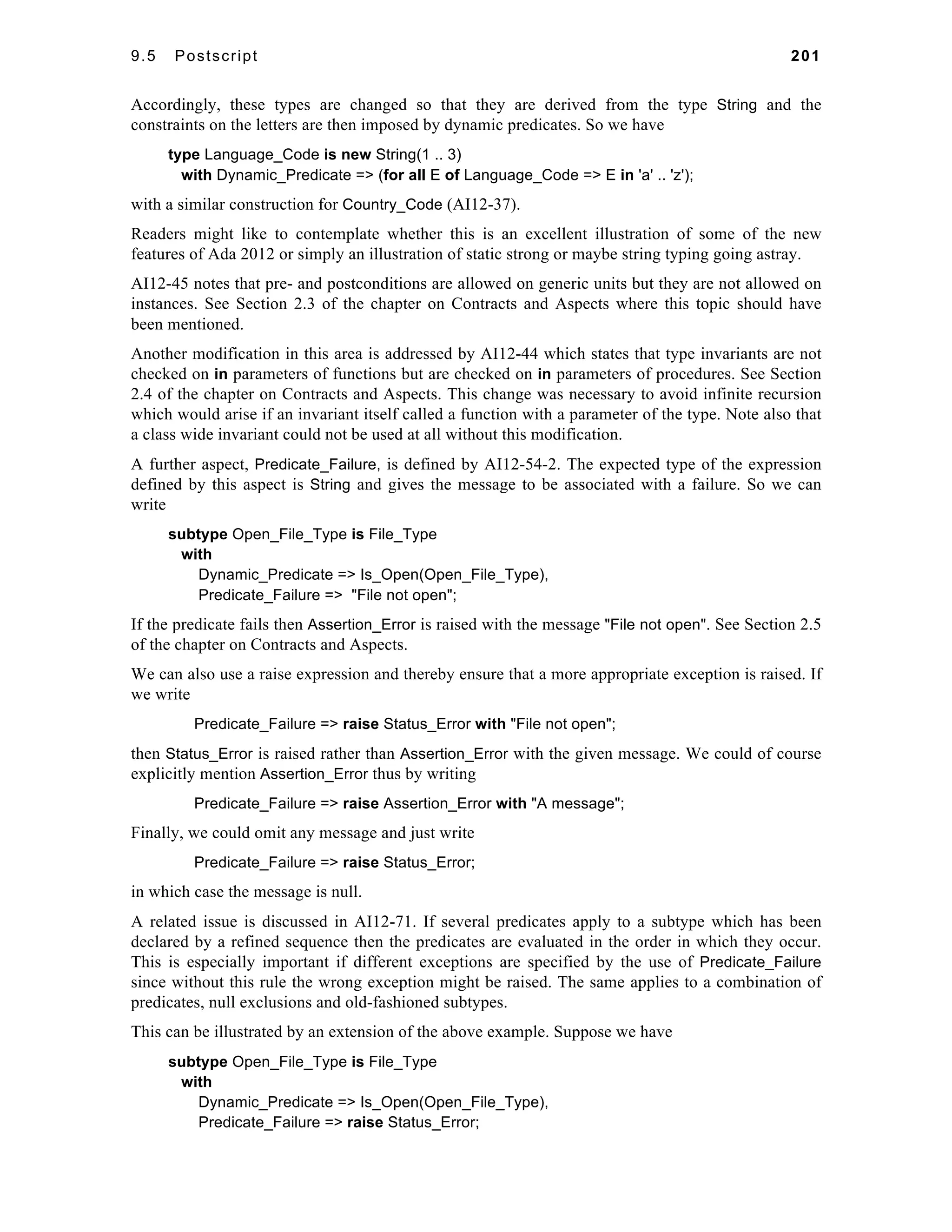
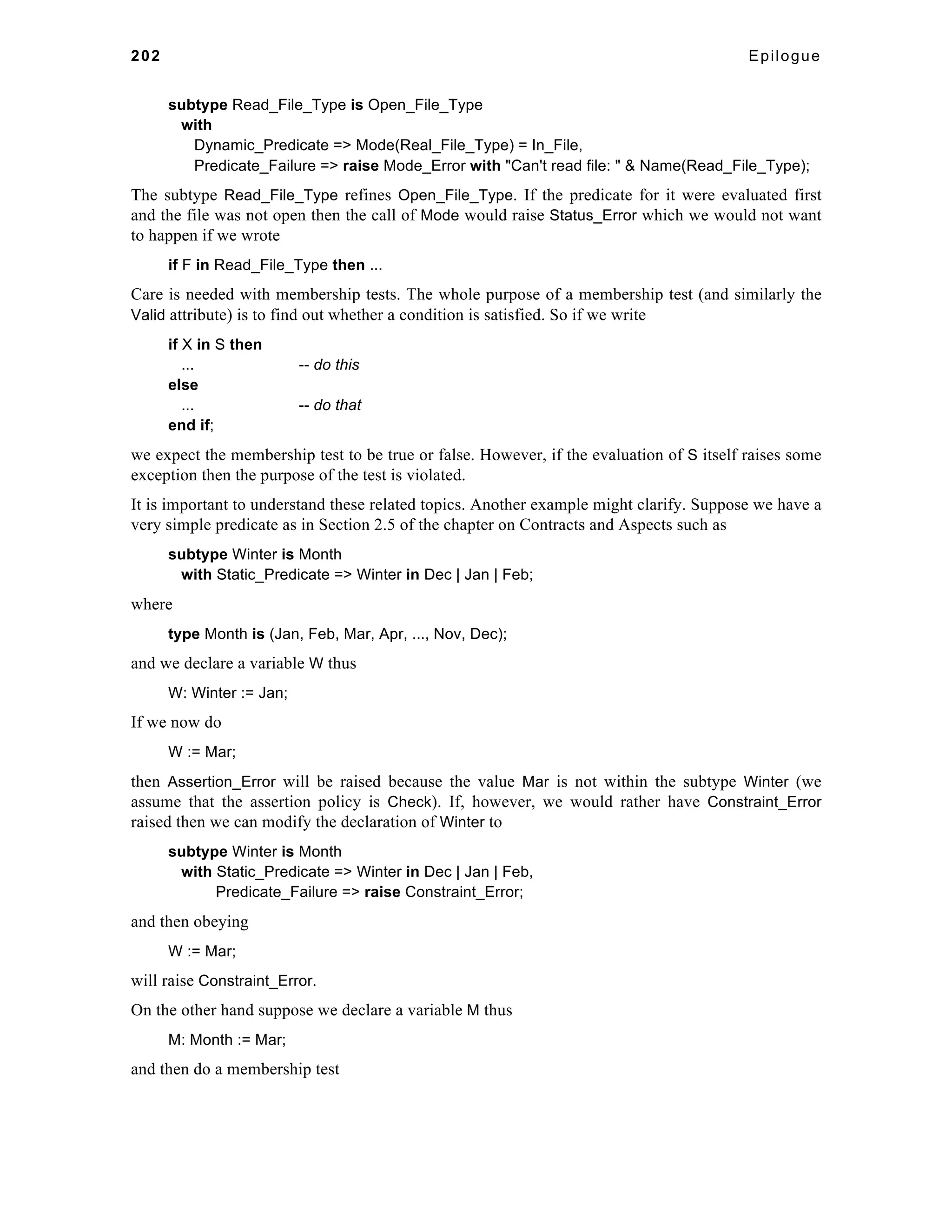
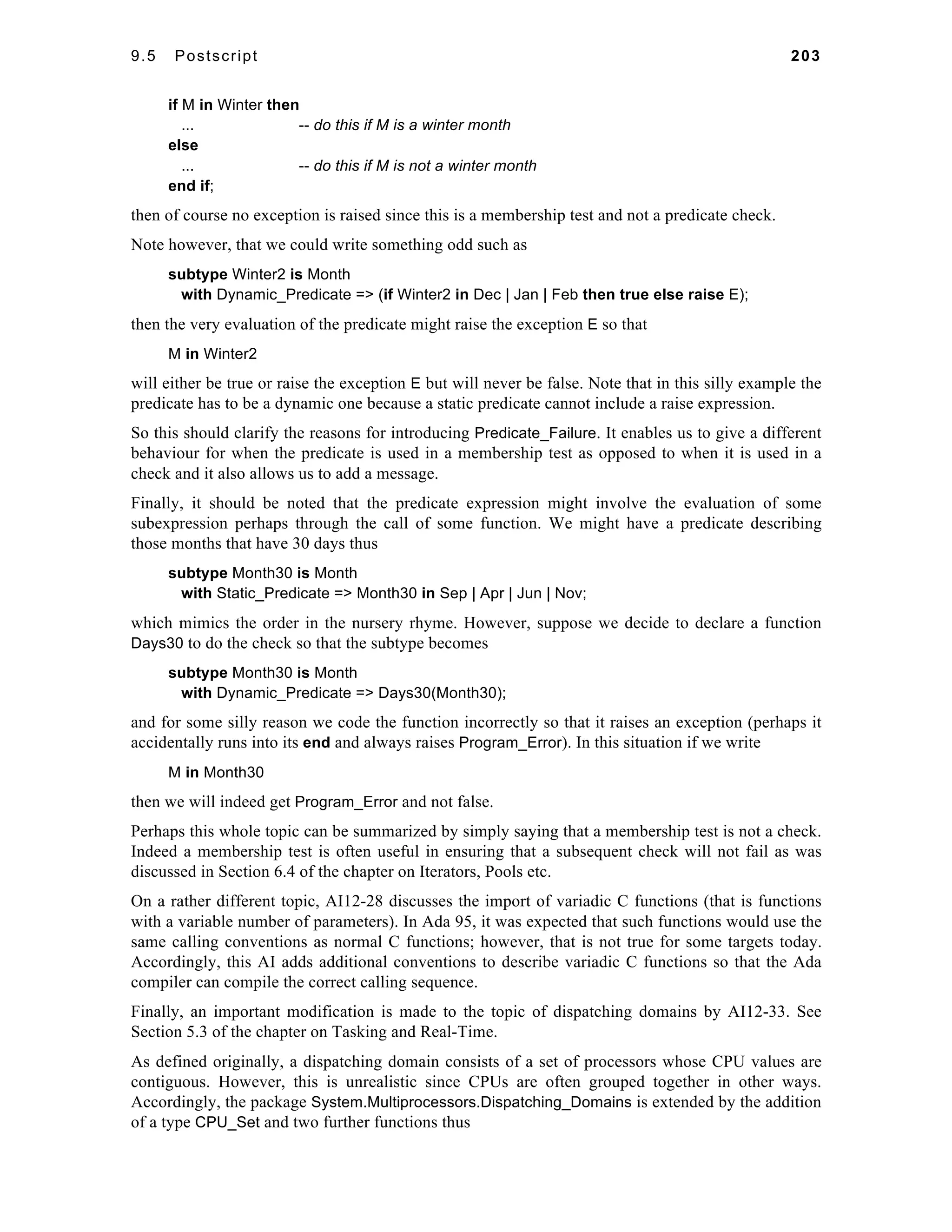
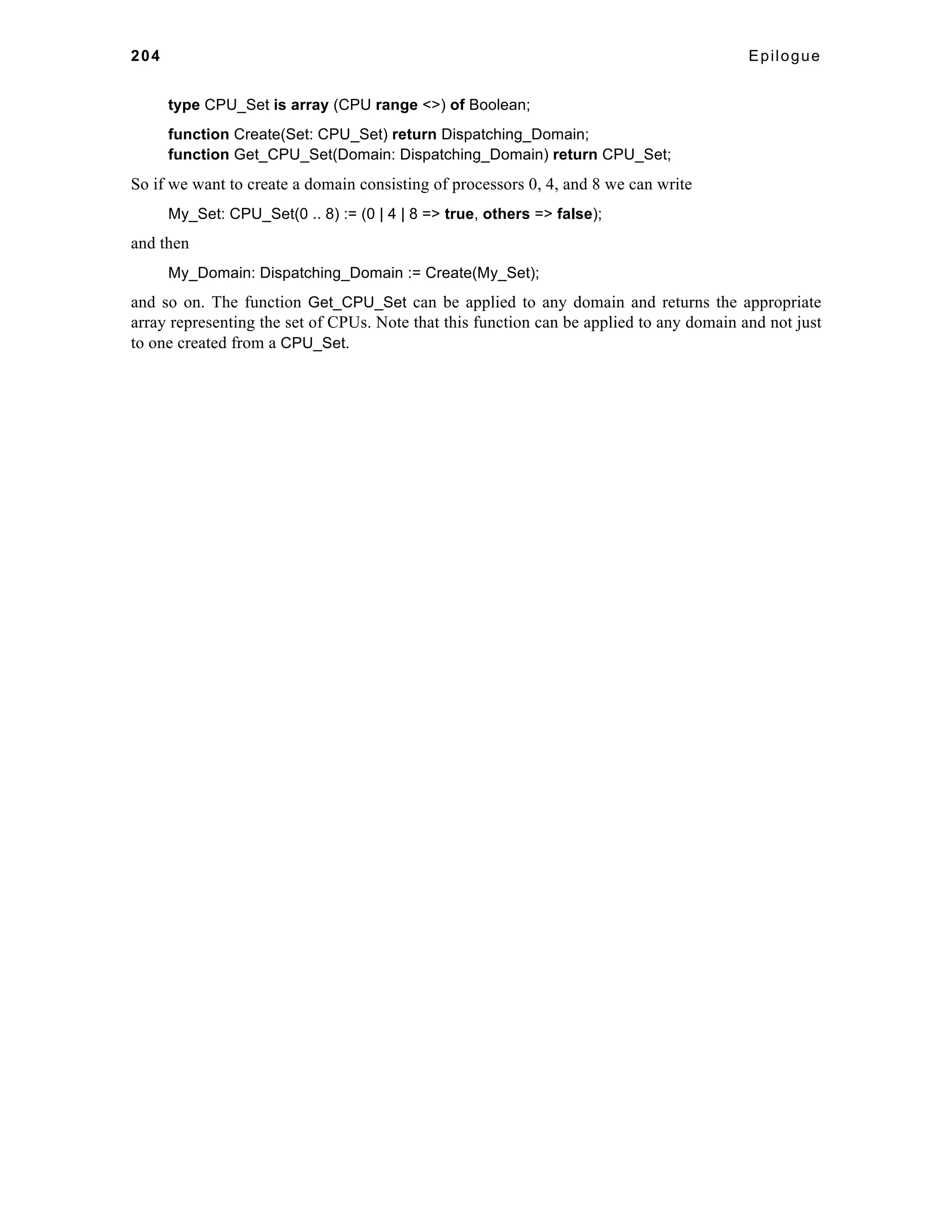
![205
References
[1] ISO/IEC JTC1/SC22/WG9 N498 (2009) Instructions to the Ada Rapporteur Group from
SC22/WG9 for Preparation of Amendment 2 to ISO/IEC 8652.
[2] ISO/IEC TR 24718:2004 Guide for the use of the Ada Ravenscar profile in high integrity
systems.
[3] ISO/IEC 8652:1995/COR 1:2001 Ada Reference Manual – Technical Corrigendum 1.
[4] ISO/IEC 8652:1995/AMD 1:2007 Ada Reference Manual – Amendment 1.
[5] S. T. Taft et al (eds) (2007) Ada 2005 Reference Manual, LNCS 4348, Springer-Verlag.
[6] Jean Ichbiah, John Barnes, Robert Firth, Mike Woodger (1986) Rationale for the Design of
the Ada Programming Language, Honeywell and Alsys.
[7] John Barnes (2006) Programming in Ada 2005, Addison-Wesley.
[8] P. Naur (ed.) Revised Report on the Algorithmic Language ALGOL 60 (1963)
Communications of the Association for Computing Machinery, Vol. 6, p. 1.
[9] D. W. Barron et al (1963) The main features of CPL, Computer Journal vol. 6, pp 134-143.
[10] A. van Wijngaarden et al (eds) (1973) Revised Report on the Algorithmic Language – ALGOL
68, Springer-Verlag.
[11] K. Jensen and N. Wirth (1975) Pascal User Manual and Report, Springer-Verlag.
[12] Defense Advanced Research Projects Agency (1978) Department of Defense Requirements
for High Order Computer Programming Languages – STEELMAN, USDoD.
[13] John Barnes (2012) SPARK – The proven approach to High Integrity Software, Altran Praxis.
[14] D. R. Hofstadter (1980) Gödel, Escher, Bach: an Eternal Golden Braid, Basic Books.
[15] John Barnes (2008) Ada 2005 Rationale, LNCS 5020, Springer-Verlag.
[16] David Fisher (1976) A Common Programming Language for the Department of Defense –
Background and Technical Requirements, Institute for Defense Analyses, Arlington, Virginia.
[17] Defense Advanced Research Projects Agency (1977) Department of Defense Requirements
for High Order Computer Programming Languages – Revised IRONMAN, USDoD.
[18] Jean Ichbiah et al (1978) Preliminary Reference Manual for the Green Programming
Language, Honeywell Inc.
[19] Jean Ichbiah et al (1979) Reference Manual for the Green Programming Language,
Honeywell Inc.
[20] ACM (1979) Preliminary Ada Reference Manual, Sigplan Notices, Vol 14, No 6.
[21] ANSI / Mil–Std 1815A (1983) Ada Reference Manual.
[22] B Higman (1963) What everybody should know about Algol, Computer Journal, vol 6, no 1,
pp 50-56.
[23] A. Burns and A. Wellings (2007) Integrating OOP and Tasking – the missing requeue,
Proceedings of the 13th International Real-Time Ada Workshop, Ada Letters, Vol 27, No 2.
[24] ACM (2003) Proceedings of the 12th International Real-Time Ada Workshop, Ada Letters,
Vol 23, No 4.](https://image.slidesharecdn.com/ada2012rationale-141002094233-phpapp01/75/Ada2012-Rationale-215-2048.jpg)

